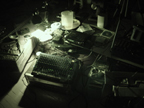July 05, 2007
Interferences
Interferences ... is an interactive installation created by Matteo Sisti Sette and Maribel Pozo which consists of a back projection screen showing an artificial life system which is sensitive to electromagnetic waves emitted by users mobile phones.
In its ‘natural’ state, image and sound are in constant evolution, moving and growing as if alive. Their growth and evolution is altered in the presence of electromagnetic waves.
This work tries to draw attention to a phenomenon whose physical and material relevance we tend to ignore. Little is known about the effect these radiations produce on human body. Maybe they are not dangerous. Many elements of our environment are not, yet they concern us because of their aspect or noise or odour. If we couls [sic] see, or hear the amount of energy which is carried by electromagnetic waves and which passes through our body, would we behave the same way as we do?
The installation is created with Pure Data and Processing. [posted by Garrett Lynch on Network Research]
Posted by jo at 07:19 PM | Comments (0)
June 29, 2007
Double Skin/Double Mind
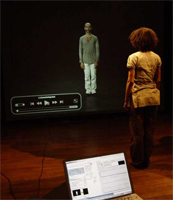
Experience a workshop, virtually
The interactive installation version of Double Skin/Double Mind will preview at Beeldmedia Studio, Amsterdam School of the Arts, Jodenbreestraat 3 on June 29 + 30 from 16:00-20:00.
Double Skin / Double Mind is a virtual version of the Double Skin / Double Mind workshop. This workshop, which has been taught by dance company Emio Greco | PC since 1996, represents the basis of the creative work of choreographers Emio Greco and Pieter C. Scholten. Participants in this workshop are challenged to discover new interpretations of their dancing body.
Throughout 2006 an interdisciplinary research group, consisting of dance notators Eliane Mirzabekiantz and Marion Bastien, motion capture researcher Fridiric Bevilacqua, cognitive neuroscientist Corinne Jola, media artist Chris Ziegler, cinematography Maite Bermudez, artistic research processes Scott de Lahunta and EG | PC researcher Bertha Bermudez, has been focusing on this specific workshop trying to analyse and document it.
The different data from each research area have been collected, and interactive graphic visualisation tools and motion capture were re-implemented to create this preview of the Interactive Installation Double Skin / Double Mind. The current installation offers participants the possibility of taking part in a virtual version of the workshop in real time, while receiving verbal, physical and peripheral information. By following a life size moving figure, the participants will recognize, compare and understand their actions and involvement in the practice of this workshop. They will travel through the Double Skin / Double Mind structure in a mental and physical way, experiencing what the different layers are.
Concept and realization: Chris Ziegler (ZKM Karlsruhe), Fridiric Bevilacqua (IRCAM, Paris), Bertha Bermudez (Emio Greco | PC)
Co-production with: Amsterdams School of the Arts, research group Art Practice and development, Marijke Hoogenboom
With thanks to: Maite Bermudez, Katharina Pohlmann, Eliane Mirzabekiantz, Marion Bastien, Corinne Jola, Nederlands Instituut voor Mediakunst / Montevideo, Scott deLahunta, Jeroen Fabius, Paul van der Ploeg, Cinedans and the EG | PC team
Project supported by: Prins Bernhard Cultuurfonds
Emio Greco | PC receives funding from: the Dutch Ministry of Education, Culture and Science and from the Dutch Fund for Amateur Art and Performing Arts.
contact: berthabermudez]at]egpc.nl
Chris Ziegler
mobile +49172 89 56 328
http://www.movingimages.de
Posted by jo at 11:05 AM | Comments (0)
June 27, 2007
Tina Gonsalves' "Feel_Insula"
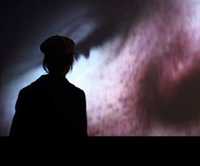
Stillness, Emotions and Hypnosis
Tina Gonsalves' Feel_Insula: An interactive Installation about Stillness, Emotions and Hypnosis :: At New Greenham Arts, The Corn Exchange, 113 Lindenmuth Way, New Greenham Park, Newbury, Berks, RG19 6HN UK :: Preview: Sunday 1 July 2007 12-2pm :: From June 28 - August 3 :: 10am-5pm; Thursday (10am-8pm; Saturdays by appointment).
Feel.Insula is an intimate and vulnerable responsive video installation driven by the stillness of the audience. In a darkened space, a video is projected on the wall. It is of the artist under hypnosis. Under hypnosis, the artist is asked to re-experience potent emotional memories of her life. As soon as the viewer enters the space, the artist wakes up from hypnosis. Only after the audience is completely still does the video fall back into weaving the stories re-lived under hypnosis. FEEL_INSULA emerges from a collaboration between neuroscientist Dr Hugo Critchley and artist Tina Gonsalves, and was created over her artist in residency at the Institute of Cognitive Neuroscience at UCL, London.
Emotion expression databases such as Karolinska and Ekman databases are commonly used with in affective neuroscientific experiments. The artist started to question the validity of these performed emotions as stimuli. In the search for more authentic emotiona; expressions, she began working with Dr. David Oakley, the Director of the Hypnosis Unit at UCL. She asked Oakley to hypnotise her in order to re-experience different potent emotional memories. Over 3 one-hour sessions, Oakley induced her into states of fearfulness, sadness, happiness and calmness. Each session was recorded using two 3 chip digital cameras focused on the artists face and also radio mic and ipod recorder. These video and audio recordings formed the basis to FEEL_INSULA.
Tina Gonsalves (AU) is currently honorary artist in residence at the Wellcome Department of Neurology at University College London. Combining diagnostic imaging, biometric sensors and mobile technologies, her installations, films for television, and software investigate emotional signatures both within the body and among interactive audiences. Since 1995 her work has shown internationally at venues including Banff Centre for the Arts (CA); Siggraph (US); International Society for the Electronic Arts 2004; European Media Arts Festival; Institute of Advanced Media Arts and Sciences (JP); Australian Centre For Photography, Sydney; Barbican (UK); Pompidou Centre (FR), Institute for Contemporary Art, London; and Australian Center for the Moving Image, Melbourne. Her music videos for Universal, BMG, EMI, and Festival Mushroom Records have been televised worldwide.
Posted by jo at 12:42 PM | Comments (0)
June 22, 2007
Canal Street Station

Participatory Public Pay Phone Who-Dunnit
31 Down's interactive telephone mystery Canal Street Station runs through October 31, 2007. To play, call this toll-free number from a pay phone inside the station: 1-877-OR-WHAT-31 (1-877-679-4283). Note: This mystery takes place on the N, Q, R, W, 6, and J, M, Z platforms, not the A, C, E, station.
Canal Street Station is a free public media art installation set in the Canal Street Subway Station in New York City. Participants are invited to make a toll-free call from any public payphone in the Canal Street station (inside of the turnstyles). Participants will then be guided on a pay phone mystery. The game takes approximately 45 minutes to complete.
Tajna Tanovic stars in this public pay phone who-dunnit set in the maze of tiles that make up the Canal Street Subway Station. This is an interactive piece that challenges participants to test their skills at listening and following directions. Players are put in the shoes of Mike Sharpie, private investigator, as he searches the depths of Canal Street Station for a young French woman that may have committed a murder, or may be a figment of Mike's wandering imagination.
"Canal Street Station" is co-produced by 31 Down radio theater and free103point9 and presented by free103point9 as part of the transmission arts non-profit's Tenth Anniversary celebration. Created by: Ryan Holsopple, Shannon Sindelar, Mirit Tal, and Tanja Tanovic.
Posted by newradio at 10:44 AM | Comments (0)
The Robot Zoo is Now Open!
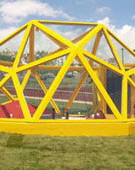
Robotarium X
Artist Leonel Moura advertised his latest project, the Robotarium X, with a grand announcement that 'The first zoo dedicated to artificial life is now open at Alverca, Portugal.' In a park in this small village near Lisbon, Moura has installed a large-scale steel glass construction inspired by the bilunabirotunda, one of the famous geometrical forms known as 'Johnson's solids.' Since June 12, forty-five different robots have lived within this structure--most powered by photovoltaic energy. All of them are original creatures specifically designed by Moura and his partners, Carlos Nogueira and the company IdMind, for the 'Robotarium X.' They represent fourteen species differentiated according to body morphology and behavioral patterns. Some resemble small vehicles similar to those currently used in space exploration; others are similar to small animals, insects, and plants; while others are distinct from anything found in Nature. Many are responsive to humans, and execute subsistence-related activities. Informed by the enlightenment movement's educational displays (like the aquarium) and mixing new technologies and his past experience as a user of robotics within an art context, Moura created an experimental, futuristic work that constitutes a step forward in the ongoing relation between humans and machines that marks the beginning of the twenty-first century. - Miguel Amado, Rhizome News.
Posted by jo at 09:04 AM | Comments (0)
June 19, 2007
Bill Shackelford
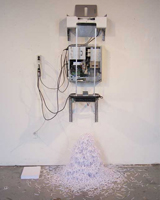
Spamtrap
Spamtrap, by Bill Shackelford, is an interactive installation that prints, shreds and blacklists spam email. It interacts with spammers by monitoring several email addresses he created specifically to lure in spam and an old unused personal email address he uses to lure in spam. Shackelford does not use these email addresses for any other communication. He posts these individual email addresses on websites and online bulletin boards that cause them to be harvested by spambots and then to start receiving spam.
Because he knows that all email sent to these email addresses are spam, he has set the installation to print and then shred each email as it arrives. Simultaneously the installation is feeding spam blacklists on the web with information gathered from all the received spam (a newly added feature). This in turn helps to feed spam filtering systems across the web that are working to reduce the amount of spam we all receive. Click here for more information about Spamtraps.
The installation uses a Pentium II computer connected to a wireless network, personal printer, personal shredder, aluminum rails, Spamtrap email addresses, automatic printing software, email client software, antivirus software, and a SpamCop user account. The paper is recycled after the spam email has been shredded. Video. Related. Via.
Posted by jo at 02:37 PM | Comments (0)
June 14, 2007
Netherlands Media Art Institute
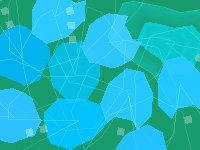
Pond
pond: Artists in Residence - Aymeric Mansoux and Marloes de Valk, Opening and presentation: June 15, 4:00 pm :: Exhibition from June 16 -July 14, 2007 :: Nederlands Instituut voor Mediakunst, Keizersgracht 264, 1016 EV
Amsterdam, Nederland :: Tel: 020 6237101 :: Email: info[at]montevideo.nl
Part of the 'Metabiosis' project, Marloes De Valk (NL) and Aymeric Mansoux (FR) investigate to what extent information can develop in a network of computers linked with each other and how it is possible for an audience to interact with it. The pond installation consists of three interconnected machines. Each machine runs a simple ecosystem model in which small strings of data are produced, processed and sent back and forth from computer to computer.
In reality the string contains a set of items that only make sense in the virtual machine / pond that interprets all this information. Because the model includes a two dimensional environment, visualized on screens, it is possible to follow the whole process as it is being computed on each machine. Even though the number crunching methods are abstract, with the aid of the visual output, one string of information can be tracked and referred to as a visible and animated 'creature'. When the machines are turned on, these 'creatures' remain in the computer memory and can jump to other computers/ecosystems.
They can reproduce (copy of information), evolve (update of information), and they can die (non recoverable loss of information). These self organized ecosystems produce patterns emerging from the initial rules set in the ecosystem model. At the same time, on a projection, the whole process and data exchange is visualised, bringing an even higher level metaphor and different point of view on how the information is flowing through the three machines.
It is possible for the audience to interact with each pond via a touchscreen, directly influencing and breaking the self organizing process. The input has immediate effect on the overall system and provides a way to bend or control the information flow.
pond is an experiment and a game for people who are curious about the possibilities of standalone processes, generative systems and artificial life.
During the residency, Mansoux and de Valk will investigate how the fragile transition regime between periodic and chaotic phases of a self organizing system can lead to complex behaviours with which an audience can interact with. The two visualisation models of the processed information raise the issue of the matryoshka effect through the relationship between interpretation and processed data.
Aymeric Mansoux is an artist and co-founder of GOTO10, an organization dedicated to create, produce, and support FLOSS+Art. He has taken part in many artistic experiments based on the internet and the emergence of networks, and considers any form of data to be a new clay that can be used to develop autonomous artistic processes. Currently part of the Digital Research Unit of the University of Huddersfield, his recent projects include the mysterious packets toolkit (with Tom Schouten and Marloes de Valk), the 0xA band (with Chun Lee), the digital artlife Metabiosis project (with Marloes de Valk), the pure:dyne GNU/Linux live distribution for media artists (with Chun Lee and Antonios Galanopoulos) and ongoing theoretical research into tools and digital autonomous processes. He is also part of the production and curatorial team of make art, an international FLOSS+Art festival in France.
Marloes de Valk is an audiovisual artist, part of digital art collective GOTO10. She was born in Holland, 1976, and is currently based in the UK. She studied Sound and Image at the Royal Conservatory in the Hague, specializing in abstract compositional computer games, HCI and crashing computers. Her work consists of audiovisual performances and installations, investigating machine theater and narratives of digital processes. She is part of the packets project, developing and documenting new tools for artistic creation, and is currently collaborating with French artist Aymeric Mansoux on Metabiosis, a project investigating the ups and downs of data packets living in a world of connected ecosystems. Marloes is part of the Digital Research Unit at the University of Huddersfield.
Posted by jo at 10:55 AM | Comments (0)
June 13, 2007
Lynette Wallworth
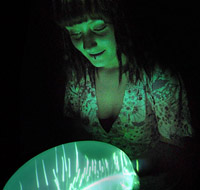
Hold: Vessel 2, 2007
Lynette Wallworth: Hold: Vessel 2, 2007 :: BFI Southbank, London SE1 :: 23 June - 2 September :: Artist's talk: Lynette Wallworth in Conversation with renowned scientist, writer and presenter Mark Lythgoe - July 3, 18:20 NFT2 :: FREE :: 020 7928 3232
Lynette Wallworth's London debut sees the BFI commissioning Hold: Vessel 2, 2007, enabling the artist to further develop her critically acclaimed piece Hold: Vessel 1, 2001. An interactive, large-scale installation that explores the intimacy and immensity of the natural world and our relationship to it, this work uses moving image and technology to reveal the hidden intricacies of human immersion in the wide, complex world.
The piece is activated by the viewer, the interaction being a metaphor for our connectedness within biological, social and ecological systems. Upon entering the exhibition space, the visitor is encouraged to 'catch' falling projected images of astronomical and underwater life in lens-shaped glass bowls. With intimate moments of synchronised light and sound, the installation celebrates minutiae - microscopic views of marine life forms and photographic imagery of deep space - leaving the visitor with a sense of communal participation within a complex system of which we are a part.
The images in Hold: Vessel 2 come from current visioning technologies such as X-ray Microtomography and remotely operated light sensitive cameras allowing us to see intricate detail inaccessible to the human eye. A reflection upon our own place in a complex and starkly beautiful world, the work helps us explore the complex interconnectivity between things that we do not always see or know.
Lynette Wallworth is the second of an ongoing series of art exhibitions at BFI Southbank exploring contemporary artists' use of the moving image.
Lynette Wallworth - Hold: Vessel 1, 2001
Courtesy of and commissioned by the Australian Centre for the Moving Image, Melbourne, Australia http://www.acmi.net.au
Lynette Wallworth - Hold: Vessel 2, 2007
Commissioned by the BFI, London, Produced by Forma Touring and Supported by Arts Council England
Posted by jo at 06:40 PM | Comments (0)
June 08, 2007
Faster than Sound 2007
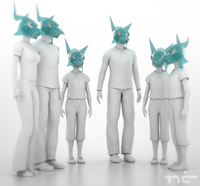
Becoming Animal: Story of the Kerberos
Minimaforms presents: Becoming Animal: Story of the Kerberos @ Faster Than Sound 2007 :: Design Team: Stephen Spyropoulos, Theodore Spyropoulos, and Ivan Safrin.
Becoming Animal is an interactive performance piece that develops the story of the mythical three headed beast Kerberos, guardian of the underworld. The objective is to create an environment of performance through the collective participation and conversation of Kerberos and participants in the event. Each participant’s presence will stimulate the three heads of the Kerberos triggering behavioral interactions and exchanges. Interactions will be expressed through sounds, facial expressions and general activity of the Kerberos. The continued dialogue between users and Kerberos will demonstrate emotions such as love, hate and anger. Participants will be given custom made masks to interact with the Kerberos and each other. This collective playfulness will construct interactions that evolve and become animal.
The project will be installed at the K9 building in Bentwaters Airbase in Suffolk, England. The K9 building will serve as the entrance to this years Faster than Sound Festival. The installation derives its concept from this threshold (entrance to festival), the K9 building and the sound event to create a piece that is context specific.
The Myth of Kerberos (Cerberus): Cerberus was the guardian of the Greek Underworld, and a faithful servant of Hades. He was represented as a grotesque dog that had three heads all of which snarled at those foolish enough to attempt to leave the Underworld; the dog also had the tail of a serpent. According to legend, Cerberus was the result of the union of Echidna and Typhon, two beings that are best described as somewhat monstrous themselves. Additionally, he was the brother to both the Hydra and the Chimera. Cerberus is featured in several mythological stories in his role as the watchdog of Hades. One famous story depicts the poet and singer Orpheus charming Cerberus by the power of his song, which emphasizes Orpheus's magical gifts of enchantment (Cerberus was notorious for not allowing mortals who were still alive to enter the Underworld).
Posted by jo at 02:35 PM | Comments (0)
May 29, 2007
LightHive
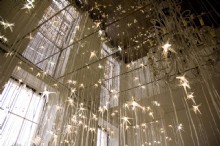
Renders Transparent What Was Once Concealed
LightHive, an installation by artist/architect Alex Haw :: Architectural Association :: until Saturday June 2, 2007.
LightHive occupies the entire main block - 5 addresses, 5 storeys and 160 rooms - of the institution's home in Bedford Square. A vast distributed network composed of various types of camera, infrared and wireless sensors relay back to a central exhibition space, where the communal activity of the school illuminates a scale model of its own light sources. Each light source is custom scripted and generated from the spatial and luminous parameters of its original source, and activated in real time by occupancy, contributing to an immersive form of spatial, 3-D surveillance. The installation renders transparent what was once concealed, compensating for the optical restrictions of the very object of the school's study: architecture.
Appearing as a spatial extension of the existing Front Members' Room's magnificent listed chandelier, its greater aim is as a self-documenting, self-recording architecture that is animated by people, resulting in a form of spatial video. It has several operational modes: predominantly realtime (which obediently varies between dynamic liveliness and patient placidity, with only intermittent signs of life), it is punctuated every half an hour by timelapse playback from its sensor database, followed by a series of fictional playbacks.
http://www.artshub.co.uk/view/ahrd.asp?Id=158989&ref=admin
http://www.kultureflash.net/current/#event4500
Posted by jo at 11:51 AM | Comments (0)
May 21, 2007
Rafael Lozano-Hemmer at La Biennale di Venezia
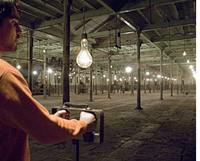
Pulse Room
Pulse Room, one hundred incandescent light bulbs controlled by the heartbeat of the public :: Mexican Pavilion at the 52nd International Art Exhibition – La Biennale di Venezia :: Press Preview: 7-9 June, 10 AM-8 PM :: Receptions: 7, 8 and 9 June, 8-10 PM :: Exhibition: 10 June–21 November, 2007 :: Palazzo Van Axel, beside the Chiesa dei Miracoli, Cannaregio 6099, Venice 30121 Italy :: +39-041-520-4807 .
Rafael Lozano-Hemmer represents Mexico at the 52nd Biennale di Venezia with the exhibition “Some Things Happen More Often Than All of the Time”, curated by Príamo Lozada and Bárbara Perea, a show which will mark Mexico’s first official participation in the Biennale. The exhibition will consist of 6 large-scale installations covering 1,000 square metres of the Palazzo Van Axel, a 15th-century gothic landmark bordering the Chiesa Santa Maria dei Miracoli, in the vicinity of the Rialto bridge.
Lozano-Hemmer (Mexico City, 1967) develops large-scale interactive installations combining the languages of architecture and performance art. His work uses technologies such as robotics, surveillance and telematic networks to create platforms for audience participation, creating "anti-monuments for alien agency". His large-scale light and shadow installations are inspired by animatronics, carnivals and phantasmagoria, situating the spectator as a fundamental component to “complete” the work.
“His work succeeds in giving the unchoreographed the power of a full orchestra..."-- CK Kuebel, NY Arts Magazine
Lozano-Hemmer’s work in kinetic sculpture, installation, video and photography has been shown in over thirty countries, including the Biennials of Sydney (Australia), Shanghai (China), Liverpool (United Kingdom), Istanbul (Turkey) and Havana (Cuba). His work is part of important private and public art collections such as those of the Museum of Modern Art in New York, La Colección Jumex in Mexico City, Fundación Cisneros Fontanals in Miami, the Daros Latin America Collection in Zürich and the Tate Collection in London.
The official participation of Mexico in Venice is the result of joint efforts by Secretaría de Relaciones Exteriores, Consejo Nacional para la Cultura y las Artes, Instituto Nacional de Bellas Artes, Consejo de Promoción Turística and the generous support of the Fundación/Colección Jumex and the Fundación BBVA Bancomer. The non-profit Patronato de Arte Contemporáneo, which has also contributed funding and resources, is in charge of the administration of the project. The receptions, starring DJ sets by Sonido Changorama, will feature sponsored drinks by Jumex, Tequila Cuervo and Cerveza Sol.
A bilingual catalogue will be published by Turner Libros, featuring essays by Manuel de Landa, José Luis Barrios, Barbara London, Cuauhtémoc Medina, Victor Stoichita and curators Príamo Lozada and Bárbara Perea.
Coinciding with the 52nd Biennale di Venezia, Lozano-Hemmer’s work will also be exhibited at Art Basel Unlimited, at the Luminato Festival in Toronto and in the exhibition “Automatic Update” at the Museum of Modern Art in New York.
Contact information:
Consejo Nacional para la Cultura y las Artes:
Plácido Pérez Cué, Director General de Comunicación Social
Tel. +52 555 662 1907
Fax +52 555 662 4314
pperzcue[at]correo.conaculta.gob.mx
Contact for Rafael Lozano-Hemmer:
Natalie Bouchard
Tel +1 514 597 0917
Fax +1 514 597 2092
natalie[at]antimodular.com
http://www.lozano-hemmer.com/
Contact for the curators:
Proyectos Hélix
Príamo Lozada and Bárbara Perea
+ 39 340 755 9584 in Venice
+ 52 555 207 6411 in Mexico
helix.curatorial[at]gmail.com
Rafael Lozano-Hemmer is represented by Galería OMR (Mexico City), bitforms gallery (New York) and Galerie Guy Bärtschi (Geneva).
Posted by jo at 03:28 PM | Comments (0)
project:rendition by JC2
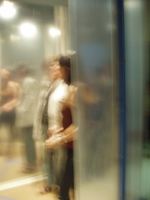
Installation and Performances at Momenta Art
project:rendition by JC2 :: momenta art :: May 25-June 25, 2007 :: Performance Schedule :: Reception: May 25, 7 - 9pm :: 359 Bedford Avenue, Brooklyn, NY 11211 :: 718.218.8058.
project:rendition examines the concept of rendering through an installation that incorporates elements of architecture, printed agitprop, audio, and performance in an interactive environment.
The project title refers to "extraordinary rendition," the Bush Administration's practice of clandestine kidnapping and extradition of suspected terrorists to countries where they can be interrogated and tortured beyond the reach of the US judicial system. While extraordinary rendition is an extreme form of political repression, state-induced fear and disenfranchisement are far more common means of rendering individuals and whole populations politically mute or existentially invisible.
The exhibition revolves around a five-sided structure built entirely of one-way mirror, which functions as an inverted Panopticon or surveillance tower. Visitors may either observe those inside the illuminated structure from the safety of the darkened gallery or reverse roles and become potential objects of scrutiny or fascination by entering it.
An excerpt from the famous 1630 sermon, "A Model of Christian Charity," written by the first Governor of the Massachusetts Bay Colony, John Winthrop, will be available as a free broadside to visitors. From Ronald Reagan's "Shining City on the Hill" to George Bush Sr.'s "Thousand Points of Light," Winthrop's Puritan text has served as the lynchpin for the philosophy of American Exceptionalism for the past 200 years.
Performances are scheduled to take place on site throughout the duration of the show. Please check the project:rendition website for performance schedule: www.projectrendition.info
project:rendition is a collaboration by JC2, a group composed of artists Joy Episalla, Joy Garnett, Carrie Moyer and Carrie Yamaoka. JC2 thanks Brian Webster for his invaluable technical expertise, without which this project would not have been realized.
DIRECTIONS: Momenta Art is located at 359 Bedford Avenue, ground floor, between S4th and S5th Sts. in Williamsburg, Brooklyn. By subway, take the L train to Bedford stop (the first stop in Brooklyn). Exit on the Bedford side. Walk south 12 blocks. By car, take the outside lane of the Williamsburg Bridge to the first exit. Make a sharp right onto Broadway. Drive 2 blocks to Bedford Avenue and make a right. We are located a half block on the right after you pass under the bridge.
Posted by jo at 11:50 AM | Comments (0)
May 19, 2007
404 FESTIVAL - ON TOUR / EUROPE 2007
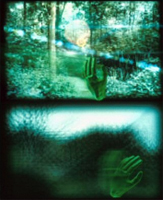
Einstein's Brain Project
[left: Alan Dunning, Paul Woodrow, The Einstein's Brain Project: The Errant Eye, 1997-2001. Virtual reality installation. The participant navigates around a recognizable visual environment, a forest whose outline faded into an abstract visual universe reflecting the variations in biological signals processed in real time by a computer module.]
Astas Romas & 404 Festival decided to launch a European Tour that begins on May 31, 2007. Directors and team of the "404 Festival" will be visiting cultural centers, public and alternative places performing live concerts, projections and conferences, also presenting "404 selected" artworks from international authors. Artists from different countries will join this tour, such as SadMb (Japan), Synchdub (Belgium), Sample Mousse (Finland), Guillermo Giampietro & Lara Baracetti (Italy), Einstein's Brain Project (Canada), Vladimir Manovski and Aleksandar Secerov (Serbia), Miha Ciglar (Slovenia), among others.
"...The cycle of installations in The Einstein's Brain Project (1995-2001) is a major technological detour for Dunning that, nonetheless, re-examines his past conceptual concerns. In this long-term project begun in 1995 with Paul Woodrow and a team of scientists from different fields, Dunning probes the new epistemological models that have developed thanks to technological advances in virtual reality.
The artificial worlds summoned up by the immersive universes often rekindle the presuppositions of a naturalistic project whose aim is to simulate familiar experiences. The interfaces created by Dunning and Woodrow propose a critical counterbalance to the withdrawal to the Cartesian universe. In the wake of recent research in cognitive science, the two men are interested in how biological and brain processes shape our perception of the world.
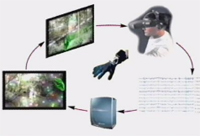
[Left: Diagram showing the way biological data gathered in real time on the participant's body is altering the display parameters of a three-dimensional virtual universe.] An initial series of installations completed between 1997 and 2001 explored popular culture's fascination with the human brain. Evidence of this fascination is found in Roland Barthes's essay on the fetishism of Einstein's brain, a reflection that serves as a critical point of reference for the installations in this body of work. By reactivating obsolete systems of representation (phrenology, eugenics, etc.), this series also underlines the impact of pseudo-scientific projections on our knowledge of the body and psyche.
In The Fall, The Furnace, The Flesh (1997), (7) participants underwent a sort of ritual as they crossed through a curtain made up of thin vinyl strips. These strips served as a screen for projecting an image of a blazing fire. Participants found themselves in a cubic space defined by four screens. In the middle of the space was an anatomically correct model of the human head covered with touch-sensitive pads (audio-digital). The location of the 55 pads replicated the brain map developed by the phrenologists Franz Joseph Gall and Johann Spurzheim. In the Victorian age, studying the skull's contours over these zones supposedly revealed a person's character traits and psychological predispositions. Dunning recycled the paradigm of phrenology as a means of accessing the installation's touch-sensitive interface. As participants pressed the pads, a series of video segments were projected on the wall. These segments, which came from various sources, showed irreconcilable objects and events that evoked the series of random associations produced by the brain as it assembles fragments of stored memory. Here, the unconscious content could not easily be distinguished from fragments of images from the media sphere. Images appeared erratically: a lunar eclipse, close-ups of the body, a political demonstration, a hall in a museum, a text flashing at a dizzying speed, barely perceptible abstract images. With the combination of images almost infinite, the screen constantly offered new sequences of juxtaposed images.
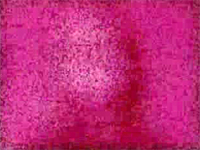
[Left: Alan Dunning, Paul Woodrow, The Einstein's Brain Project: The Furnace, 1997-1999. Video and sound installation with interactive components. Segments, from various sources, showing irreconcilable objects and events evoking the series of random associations produced by the brain as it assembles fragments of stored memory. Excerpt of the video documentary The Einstein's Brain Project, The Errant Eye, The Furnace, 1998-1999. Go here and click on the first segment under "Multimedia."]
The virtual environment installations The Errant Eye (1997-2001) and The Madhouse (2001) delved into Dunning and Woodrow's premise that the image captured on the retina doesn't always converge with brain activity. In The Errant Eye, the biological data gathered in real time on the participant's body altered the display parameters of a three-dimensional virtual universe. The participant donned a head-mounted display equipped with encephalogram electrodes that recorded the changing amplitude of brainwaves from the brain's right and left sides. The participant then navigated around a recognizable visual environment, a forest whose outline faded into an abstract visual universe reflecting the variations in biological signals processed in real time by a computer module. Once the feedback process reached the balance sought, the participant could recognize recurring motifs that corresponded to certain types of reactions and perceptions.
The Madhouse (2001), which was presented at the gallery Oboro (Montreal, Canada) in 2001, allowed participants to pool their individual perceptions as they experimented simultaneously with feedback. A luminous life-size cast of the human body lay in the centre of a room and was surrounded by participants in an immersive state. The participants touched the surface of the body, which stored and displayed their handprints and fingerprints as if which stored and displayed their handprints and fingerprints as if the body's material presence were providing them with a kind of anchorage in the physical world. Behind their displays, the participants were catapulted into a virtual world, while viewers on the periphery could observe their erratic gestures, which resembled the spasms of mental patients (hence the work's title). Through this sharing of the immersive experience, which is often deemed autarchic, Dunning and Woodrow's project created a more complex model of a virtual community that didn't exclude the body of the participants.
A series of installations in development will further explore technological and conceptual aspects begun within The Einstein's Brain Project. Under the working title (WIW), Worlds in Worlds, Dunning plans to put together an immersive environment whose boundaries will be defined by the real dimensions of the room the participant is in. Dunning is also interested in the Anatomically Lifelike Biological Interface, which operates via a model reproducing certain bio-anatomical functions. In this vein, he is pursing research on the properties of ferrofluids, liquid matter that can be altered by an electromagnetic field and modified by biological signals from the human body.
V.B. © 2002 Fondation Daniel Langlois
Posted by jo at 01:37 PM | Comments (0)
May 17, 2007
Men in the Wall

Men in the Wall by Liz Aggiss and Billy Cowie :: Opening Reception: Wednesday, June 20, 7 – 10 pm :: Artist Talk 7:30 p.m :: Installation runs June 20 – 30 :: 1639 18th Street, Santa Monica, CA 90404 :: FREE admission :: 310-453-3711.
Men in the Wall is a four-screen, 3-dimensional stereoscopic video dance installation. Special stereoscopic glasses will be provided to watch this 3D world of four men, who share their framed lives in a public quartet while retaining their private differences. The piece runs on a continuous 25-minute loop and will be projected from four different projectors onto the wall.
Billy Cowie and Liz Aggiss principally work together in the area of dance/theatre performance, screen dance and installation. They have made over thirty live performance pieces for their company Divas Dance Theatre, have toured Europe extensively and completed four major screen projects (two BBC Dance for Camera commissions and two ACE Capture projects).
They have created commissioned work for 'Extemporary Dance Theatre',' Mantis', 'Transitions', 'Intoto', 'Carousel' and 'Hi Spin'. Aggis and Cowie’s dance screen work has received numerous international awards including: Czech Crystal, Prague Golden Film Festival (2002); Special Jury Golden Award, Houston (2003); Best Female Film, Mediawaves Hungary (2003); and the Romanian National Office of Cinematography Award (2003). A book about their work entitled Anarchic Dance was published by Routledge in January 2006.
Billy Cowie has composed music performed by Marie McLaughlin, Nicola Hall, Gerard McChrystal, Daphne Scott-Sawyer, Juliet Russell, Rowan Godel, Pammjit Pammi and Naomi Itami. He has also composed music for three BBC Radio projects: 'The Tempest', Philip Pullman's 'Dark Materials Trilogy' (both dir by David Hunter) and Thinking Earth (dir Pam Marshall). He has also composed music for film directors Tony Palmer, Chris Rodley, Stephen Frears and Bob Bently. Billy Cowie is currently Principle Research Fellow at the University of Brighton.
Liz Aggiss is a performer/choreographer/film-maker and has received numerous awards including the Bonnie Bird Choreography Award (1994) and the Arts Council Dance Fellowship Award (2003). She has written for Dance Theatre Journal and animated and is currently Professor of Visual Performance at the University of Brighton.
Posted by jo at 06:53 PM | Comments (0)
May 11, 2007
Visual Voice Pro
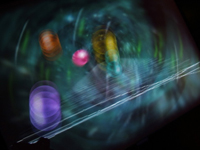
An Ultra-Responsive Environment
Visual Voice Pro creates an immersive, reactive digital playspace. The installation is comprised of a sensitive microphone, a computer with a data projector, and custom software written especially for the space. The microphone listens to all of the sounds in the room, from tiny footsteps to laughter to singing or even banging a drum. The computer instantly processes the sounds to create abstract, beautiful graphics. Action and re-action are clearly, vibrantly displayed. When the room is quiet, the scene falls still and dark. When there is noise there is activity. The louder the noise the bigger the effect.
"The entire experience has been designed based on requests from parents and care-givers of people with autism, cerebral palsy, and all sorts of behaviour disorders," says Adam Montandon, "So I am very keen to hear what anybody thinks."
Adam Montandon is the Director of HMC Interactive. You can contact him at Grosvenor House, Belgrave Lane, Plymouth, PL4 7DA, UK :: + 44 (0)845 20 11 462 :: Mob: + 44 (0)772 17 36 021.
Posted by jo at 09:46 AM | Comments (0)
May 10, 2007
Sinister
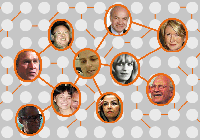
Social Networks Foster Conspiracy
Annina Rüst's Sinister "is a service based on research into software designed to identify and analyse suspicious behaviour through communication patterns rather than the content of conversations (data-surveillance). Visually, Sinister appears as a friendly social networking environment, but it suggests that social networking also fosters conspiracy. Online chat bots and automatised scoundrels (artificially intelligent characters) infiltrate chat networks and discuss seemingly common-place topics such as gardening, but occasionally include criminal harmful comments. You can telephone the bots and insert your own messages into their conversations also, using voice recognition software which looks for con-spirative content. The software then maps and interprets these online conversations, comparing diagrams to a database to determine the possible unfriendly uses people might have for the online social network. In the gallery-based installation, the seats represent the nodes in the social network – by moving the seats around as you join into conversation with your fellow visitors, the computer can then draft and analyse new diagrams based on the connections in the social network you create." Part of MY OWN PRIVATE REALITY: GROWING UP ONLINE IN THE 90S and 00S.
Posted by jo at 01:16 PM | Comments (0)
April 27, 2007
Alternate Perspectives
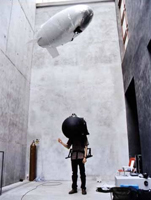
Floating Eye
[...] (photo by Saxinger) Floating Eye (2001), by Hiroo Iwata (VRlab), is an interactive installation that separates vision from the body. The participant can only see wide-angle image floating in the air. The image is captured by a wireless camera attached to an airship, pulled along by the user. The participants can see themselves from above, along with the surrounding area.
A large helmet provides the immersive experience. This helmet contains a convex mirror, with a projector mounted at the rear, so the image takes up the users whole field of view. The movie belows shows how this works. Movie (10mb mpeg) More images and video.
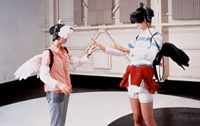
Inter Dis-Communication Machine
(photo:Kurokawa Mikio) The Inter Dis-Communication Machine (1993), by Hachiya Kazuhiko, lets two participants see things from the other persons perspective. The site states “the concept to make it possible to kiss or to make love with the partner while keeping the machines on”. [blogged by Chris on Pixelsumo]
Posted by jo at 05:43 PM | Comments (0)
EXPERIMENTAL ART FOUNDATION
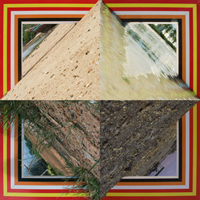
90 Degrees Equatorial Project
JAMES GEURTS' 90 Degrees Equatorial Project :: through May 19 :: EXPERIMENTAL ART FOUNDATION :: Lion Arts Centre North Terrace at Morphett Street, Adelaide, Australia 5000 :: eaf[at]eaf.asn.au.
90 Degrees Equatorial Project combines three aspects of Geurts' practice - photography, video and site-specific installations. The works are primarily abstract documentation generated by situated on-site performance. Geurts works with video by manipulating live feed to force errors in the recording process. Abstraction of real-time into video static opens the possibility of unexpected relationships between visual and aural elements.
"At four equal sites on the equator, a corner of a right angle plastic frame pierces the skin of the landscape to give the illusion of a frame that passes through the earth. I developed a portable sculpture in the form of a 90-degree frame, which was set up at the four sites and photographed. The frame is made from fabricated plastic and internally lit with fluorescent light." James Geurts
The project worked at four locations which are 900 apart :
1000 East - Pandang, Sumatra, Indonesia
100 East - Libreville, Gabon, Africa
800 West - Perneldes, Equador, South America
1700 East - Kirimatti Atoll, Pacific Ocean
Posted by jo at 12:51 PM | Comments (0)
April 23, 2007
205A Morning Lane
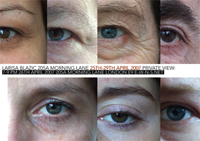
Temporary Urban Video Interventions, Architecture + Art
205A Morning Lane is a site-specific video installation using a building as a projection screen to explore possibilities of temporary urban video interventions, architecture and art. It marks the end of 205A Morning Lane studio building with two sets of visuals projected to the building's windows. First floor projection of 205A Morning Lane artists' eyes closing and second floor projection of artists' eyes opening - as eyes, window to the soul q the metaphor for cycles - endings and beginnings.
10 Video projectors are distributed in 10 artists' studios (5 on the first floor and 5 on the second) and projecting directly onto windows from inside - out thus creating two stripes of projections on the main facade. The projected material is changed on a nightly basis (five consecutive nights of projections) to play slower and slower motion so that at the end of projection all eyes close.
25TH - 29TH APRIL 2007 :: [PRIVATE VIEW: 26TH APRIL 2007 7-9PM] :: Morning Lane Studios :: 205A Morning Lane, London, E9 6LG. To get there: Hackney Central BR or busses 30, 48, 55, 106, 254; Map.
Posted by jo at 02:12 PM | Comments (0)
PAM] the Perpetual Art Machine

Three Events
[PAM] the Perpetual Art Machine Trifecta.
[PAM] TO BE FEATURED AT COACHELLA MUSIC AND ARTS FESTIVAL :: April 27 - 30, 2007 :: In its first appearance on the U.S. West Coast, Perpetual Art Machine [PAM] will be a featured multimedia installation at the Coachella Valley Music and Arts Festival, Indio, California, April 27-29.
This year, Coachella is presenting over 100 of the biggest names in music and art, including Bjork, The Red Hot Chili Peppers, Rage Against the Machine and Sonic Youth. [PAM] is putting into place its largest installation to date, at the Empire Polo Fields, a desert oasis just outside Palm Springs, for this three day outdoor 70,000 person sold out event.
Combining touch screen and projection technology, [PAM] gives its users an immersive 5 channel interactive video experience. Entering into the [PAM] installation, the user becomes the curator of some of the most cutting edge video work made this century. [PAM] democratizes the curatorial process by inviting both the artist and the viewer/user to participate on site and online at perpetualartmachine.com.
[PAM] was created in December 2005 as a collaboration between the artists Lee Wells, Raphaele Shirley, Chris Borkowski and Aaron Miller and has had installations and screenings worldwide including the United States, England, Austria, Russia, Brazil, Canada, France and Croatia.
At this year¹s Coachella festival, [PAM] will premiere its first ever compilation DVD titled "Perpetual Art Machine 2006-2007: Year one · Volume One" featuring 16 videos highlighting some (but not all) of the best work in the [PAM] archive.
For more information on Coachella go to http://www.coachella.com
For immediate assistance please call Lee Wells at 917 723 2524.
[PAM] TO BE FEATURED IN NEW MEDIA ART LOUNGE at artDC. :: April 27 - 30, 2007 :: Perpetual Art Machine [PAM] will be featured as a new media project at the inaugural Modern and Contemporary Art Fair, Washington DC - artDC. Modern, contemporary and high quality cutting edge work defines this newest art fair in America.
[PAM] will present a single channel interactive multimedia installation and will feature the artwork of Bill Dolson, Miroslaw Rogala and Raphaele Shirley. The New Media Lounge is organized by Rody Douzoglou and artDC takes place 27 30 April at Washington Convention Center, Hall E.
[PAM] co-founder, Raphaele Shirley also will be part of the New Media: Exploration and Innovations panel, which will explore the exciting area of new media, which is gaining more attention than any other medium in the current art market. The very distinguished panel of experts will discuss the topic.
Panelists include:
Peggy Parsons, Moderator,
Film Department Head of the National Gallery of Art, DC
Kerry Brougher,
Chief Curator of the Hirshhorn Museum and Sculpture Gardens, DC
Beth Turner,
Senior Curator of the Phillips Collection, DC
John Hanhardt,
Consulting Curator of Film and Media of the Smithsonian Museum, DC
Raphaele Shirley,
Artist and co-founder of Perpetual Art Machine, NYC
For more information on artDC, go to: http://www.dc-artfair.com.
For immediate assistance please call Raphaele Shirley at 917 805 6320.
[PAM] PROFILED IN VIDEO AS URBAN CONDITION PROJECT IN AUSTRIA AND BRAZIL :: Exhibition @ Lentos Kunstmsueum/Museum of Modern Art Linz, Austria :: April 19 May 27, 2007.
Screening: Fundação Clóvis Salgado/Palácio das Artes, Belo Horizonte, Brazil
April 28, 2007.
Compiled by UK artist, Anthony Auerbach, the Video as Urban Condition project explores how video shapes urban experience.
Video is a medium of mass production, mass participation and mass consumption. Video as Urban Condition recognizes the diversity of activity in the field and challenges the participant to reflect on how the relations of representation in society are mediated by video.
The project reflects on the mutability of video as it shifts between fact and fiction, entertainment and persuasion, urban fantasy and reality-TV, art and activism, surveillance and control - tracing the web of interactions between of media and architecture, subject and commodity, identity and desire, the city and its phantasmagoria.
Video as Urban Condition examines a medium whose most distinctive characteristics are multiplicity and diversity, a form, which is not contained by the norms and institutions of art nor by the exclusive domains of professionals.
[PAM] Video Pool contributing artists: Anonymous (Iraq), George Barber (UK), Luis Berrios-Negron (Puerto Rico), Chris Borkowski (US), Josephin Böttger (Germany), Wilson Brown (Brazil), DnasaB (US), G.H. Hovagimyan (US), Stephanie Lempert (US), Aaron Miller (US), Motomichi Nakimura (Japan), Pierre St. Jacques (US), Sanotes (Spain), Raphaele Shirley (US/France), Jeremy Slater (US), Endre Tveitan (Norway), Lee Wells (US)
For more information on Video as Urban Condition go to:
http://www.video-as.org
For immediate assistance please call Raphaele Shirley at 917 805 6320.
Posted by jo at 01:36 PM | Comments (0)
April 21, 2007
Turbulence Commission: Pulse Pool
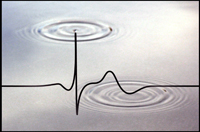
Connects Boston and Oklahoma City via Human Pulse
For the first time, two cities will be connected via the human pulse. From April 23 through April 29 during the Cambridge Science Festival and the Boston Cyberarts Festival, the Museum of Science and New Radio and Performing Arts, Inc., Boston present Pulse Pool, an interactive installation that uses internet and radio-frequency identification (RFID) technologies to allow people in two different cities to experience one another’s pulse. Pulse Pool bridges art and human biology via technology—as well as two capital cities: Boston and Oklahoma City.
Designed and engineered by the Symbiotic Media Group at the University of Oklahoma, Pulse Pool consists of two ten-foot, round pools of water—one located at the Museum of Science and the other at the University of Oklahoma. Visitors stand by the pool and wear computing devices that track their pulse. The pool detects the transmission from the wearable devices, and each individual's pulse is then represented in real time as a series of water drops released into the pool by a disk suspended directly above. By synchronizing the rhythms of the pulses and water droplets, the pool will enable visitors to detect the drips that correspond to their pulse. By watching the ripples from the droplets, visitors can see their “pulse” meet and interact with the “pulse” of others surrounding the pool. In addition, the two installations will relay information to one another, causing LED lights under the water in each location to flash corresponding to the pulses in the other city. Visitors will also be able to track the connections via a web interface from April 23 through April 30 on http://turbulence.org/Works/PulsePool/.
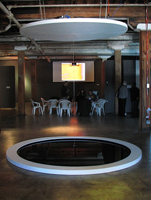
"Pulse Pool will offer Museum visitors a chance to experience a basic wonder of human biology: their own pulse and the pulse of others,” says Mike Alexander, director of public programs at the Museum of Science. “And through cutting-edge technology and the art of installation, participants will experience the pulse in a completely new way that is both visual and interactive."
"Imagine if you could see and experience another human's pulse just as intimately as you know your own. How would access to this otherwise unavailable information change the way you interact with one another?" asks Adam Brown, director of the Symbiotic Media Group. He adds, “Through cutting-edge technology, Pulse Pool explores these questions by connecting participants with each other through their pulses in real time.”
Pulse Pool is a 2006 commission of New Radio and Performing Arts, Inc. for its Turbulence web site made possible with funding from mediaThe Foundation. with funds from mediaThe Foundation. Additional funds from the Museum of Science, Boston; the National Endowment for the Arts; Rhizome.org; and the University of Oklahoma Symbiotic Media Center, Lester Wilkinson Chair, College of Engineering, School of Computer Science, Symbiotic Computing Laboratory, and School of Art.
Admission to Pulse Pool is included with regular Exhibit Halls admission: $16 for adults, $14 for seniors (60+), and $13 for children (3-11). For more information, the public can call 617/723-2500, (TTY) 617/589-0417, or visit mos.org. See Fred Jones Museum of Art for more information.
Posted by jo at 11:48 AM | Comments (0)
April 19, 2007
assume vivid astro focus

a very anxious feeling
assume vivid astro focus a very anxious feeling :: May 3rd - June 30th, 2007 :: John Connelly Presents (JCP) is pleased to announce a solo exhibition of new work by assume vivid astro focus (avaf). The exhibition will use the architecture of the gallery to create a dialogue between three distinct environments featuring an installation of 3-D wallpaper, a dark subterranean corridor of music and flashing neon sculptures, and a cordoned multi- disciplinary room that will feature an ongoing series of music-related performances.
In the main gallery an installation of text-based wallpaper consisting of grids of four-letter words - BUSH, IRAQ, SPIT, HOMO, DYKE, ANAL, IRAN, AMEN, PRAY, EVIL, LOVE, EDEN, HOPE.. - alludes to the iconic design of Robert Indiana's LOVE emblem from the 60's and General Idea's AIDS insignia from the late 80's. "Four-letter words" tend to have a special status in the English language and in most cases reflect the more crude, sexual subset of the lexicon. The virus-like dispersion of these terms throughout the walls of the gallery and their political tenor suggest how the public policies and decisions made by our governments indiscriminately contaminate and shape our private lives and futures. By inviting the viewer to don a special mask with custom 3-D glasses to view the wallpaper, the artists also encourage the viewer's participation in activating the work from a two- dimensional static experience into a three- dimensional event that is both sculptural and temporal.
The gallery's basement space, which is usually reserved for storage of artwork and tools, is transformed into a long dark corridor illuminated by a sequence of five animated abstract neon sculptures. The sculptures syncopate and flash along to a custom soundtrack featuring music by PolaroidHomoPhoto (an anonymous duo that looped a fragment of the song Zombi by French musician Sebastien Tellier). Furthering the multi-dimensional experience of the wallpaper installation upstairs, avaf's corridor of light and sound combines the aural and visual into a visceral occurrence meant to stimulate both the mind and the body. The space itself - marginal, dark and intimate- reflects upon avaf's interest in the multilayering of both structure and image and the generation of new platforms, vistas and vanishing points through architectural tools such as barricades and stairways.
In the JCP project room avaf has transplanted an installation from their 2006 solo show, absorb viral attack fantasy at Hiromi Yoshii, Tokyo comprised of wallpaper, sculptures, video, neons, and balloons. Here, the group continues to explore the fertile confluence between art, architecture, performance and entertainment by presenting an ongoing series of performances and events including Barr, Tobias Bernstrup, Julie Atlas Muz, Loconuts, Ann Magnuson, Japanther, Good Good and Frankie Martin (full schedule to be announced). However, the entrance to the project room has been sealed shut and the only given access to both the performances and installation is peering through portholes fitted with sheaths and wigs.
For the duration of the exhibition avaf has also invited UK artist Giles Round to take over the gallery's Tunnel Room (known for it's arched public display window that looks onto the former Tunnel nightclub). Round works in a variety of media including painting, sculpture, installation and video. He will present a new video installation addressing issues of public space, theatricality, reflection and formal/spatial orientation.
Image: assume vivid astro focus
Courtesy of John Connelly Presents, New York
Posted by jo at 03:33 PM | Comments (0)
April 10, 2007
Mladen Bizumic: How If – A Translation in III Acts
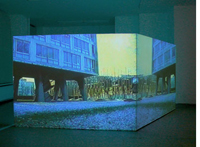
A 'Spatial Opera'
Mladen Bizumic: How If – A Translation in III Acts :: 29 March – 28 April 2007 :: Finissage April 27, 19.00 :: PROGRAM: initiative for art + architectural collaborations, Invalidenstrasse 115, D-10115 Berlin :: t: +49 (0)30 39509318 :: in collaboration with Künstlerhaus Bethanien.
PROGRAM – initiative for art + architectural collaborations presents ACT III of the exhibition How If – A Translation in III Acts by New Zealand artist Mladen Bizumic. Bizumic's first solo exhibition in Germany is structured as a ‘spatial opera’ in which he explores the facets of contemporary geopolitics in relation to representations of architecture. In each of the piece’s three acts, we find the contribution of other artists, musicians, theorists and in one instance, his mother. Act III is presented at PROGRAM, while ACT I & II form the installation at Künstlerhaus Bethanien.
Bizumic’s work is often based on the architecture, urban context and history of the space in which he is living. How If - A Translation in III Acts activates Berlin, his current abode, as the urban fabric comprising the space between Künstlerhaus Bethanien and PROGRAM.
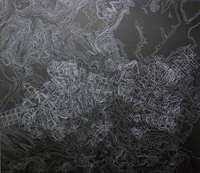
ACT III (at PROGRAM)
Since 2004 Bizumic has been working on a multi-channel video project called event.horizon.black.hole. An angled wall in the gallery acts as a screen for a pair of mirrored video projections. A video of the crumbling architecture of the UNESCO Headquarters in Paris is projected back-to-back with images of an avalanche on Mt. Cook, itself a UNESCO world heritage site in New Zealand. Mirrored along the bend in the wall, each pair of projections resembles an enormous, constantly morphing Rorschach blot. On this occasion, a multi-channel soundtrack has been added, bringing together ambient sounds taken from the Berlin Museum Island (also a world heritage site), with the flapping noises of flags outside the UN Headquarters in New York. The projections dematerialize the wall while the soundtrack organizes notions of nationality, geography, and the concept of a world heritage.
ACT I (at Künstlerhaus Bethanien)
Freud Museum (for her) 2006-2007 is a vitrine of fragments from buildings in Vienna. Two commissioned works accompany this: a piano piece composed by his Viennese girlfriend (a musician), and a ‘psychoanalytic poem’ written by his mother (a psychologist) which both articulate the personal dimensions embedded in the work. The material index of Vienna’s built environment becomes a self-consciously museological display – it’s materiality abstracted and questioned in turn by the music and poetry.
ACT II (at Künstlerhaus Bethanien)
Sister Cities of Berlin (Paris) 2007 is a video installation depicting streetlights seen through the glazed door of a building near the National Highway 7 in Paris. The distorted image through the glass is contextualized as a voice-over begins to tell a story of the Parisian suburb Le Kremlin-Bicetre, loosely based on an interview conducted by Bizumic with French artists Saadane Afif and Valerie Chartrain – themselves residents of the aforementioned building. The characters in the narrative are reduced in their description, but a counter point of complexity is provided by the collision of images, poetic verses and ambient sounds composed by MINIT.
Mladen Bizumic (born 1976, lives and works in Berlin) will present his work in the New Zealand Book at the Venice Biennale (2007). Notable exhibitions in the past include: Through the Picture at the 2nd Moscow Biennale (2007), Busan Biennale (2006), Hide-Tide, CAC, Vilnius and Zacheta National Art Museum, Warsaw (2006), Re: Modern, Künstlerhaus Vienna (2005), Fiji Biennale Pavilions, Govett-Brewster Art Gallery, New Plymouth (2003), Mladen Bizumic, ARTSPACE, Auckland (2002).
PROGRAM is a nonprofit project aimed at testing the disciplinary boundaries of architecture through collaborations with other fields. Initiated in 2006 by Carson Chan and Fotini Lazaridou-Hatzigoga, PROGRAM provides a discursive platform for artists, architects, critics and curators to explore ideas through exhibitions, performances, workshops, lectures, and residencies. PROGRAM intends to diversify the ways we understand and make architecture by engaging the discourse with emerging creative processes that activate the space between pure theoretical research, professional praxis and architecture's social role.
The exhibition is generously supported by Creative New Zealand and the New Zealand Embassy in Berlin.
opening hours:
Tuesday–Friday 14.00–19.00 hrs
Saturday 11.00–19:00 hrs
For further information please email info@programonline.de, or visit http://www.programonline.de
Posted by jo at 11:31 AM | Comments (0)
March 29, 2007
ZKM | Museum of Contemporary Art
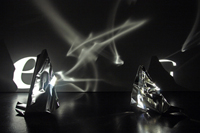
ReMix / Broca II (Letters / Numbers)
The multimedia installation ReMix / Broca II (Letters / Numbers) will open the international exhibition tour of the work of Mischa Kuball (*1959), a light and media artist from Düsseldorf, Germany, at the ZKM | Museum of Contemporary Art. The exhibition will be open from March 31-May 13, 2007.
Kuball has worked conceptually with light for more than twenty years, and in a unique way has linked light, which is otherwise largely considered an aesthetic medium, with social and political statements. Within his complex and multifarious work, the pieces that confront human communication form a specific concentration. "I am interested in language as a function of a code—that is, in the sense of coding and de-coding," says Kuball. Presented for the first time is the new, extensive multimedia installation ReMix / Broca II (Letters / Numbers), which is a further development of his earlier work, broca'sche areal. With both of these works, Kuball refers to the eponymous brain region, which forms language capability, and thereby the basic conditions for human communication.
Taking six different rotating projectors as a point of departure, in ReMix / Broca II (Letters / Numbers), letters and numbers are cast on the walls of a room. This leads to the chance overlapping of a multitude of connections of meaning from various semantic areas, which generates the need to construct meaning. In addition, sculptural elements in the room reflect the light of the projectors; these sculptural elements are the artist's digitized brain waves transferred to three dimensions. In this way, grasping, expressing, and representing thoughts are all connected on different levels as the preliminary stage of communication. "When language and light come together, the basic elements of knowledge are present" (Kuball).
Artist Talk On 31 March 2007 at 4pm in the ZKM_Lecture hall there will be a discussion on "Art and Science" with Mischa Kuball, Peter Weibel, and Gregor Jansen and the artists represented in the related exhibition My Gene, It has Five Corners...
Posted by jo at 02:18 PM | Comments (0)
March 23, 2007
MediaRuimte + LAb[au]

B.I.O. Project + EOD02
B.I.O. Project _ Gangpol und Mit [ wwilko / fr ] + mik.musik.! [ pl ] :: B.I.O. project is an original music & visuals project, kind of encounter between two groups of Polish and French artists across a trip in the city of Budapest. Catchy electro or crooner songs, colorfull cartoon or street shootings visuals, every original material you'll hear or see in this project comes from their work in this incredible city of Budapest: traditional anthems, radio sampling, video, slides or super8 shootings, short street happenings, local toys bending, scratches from hungarian second-hand records, vocals from hugarian learning method.
This special european encounter project started with workshop in Budapest (Hu), will continue with workshop in Poznan (Pl), then will be on tour both in France (february) and Poland (march), as a 30 minutes original creation adding to regular sonic and visual lives by Gangpol & Mit, Deuce & Marcin Zazeka, and Gilou DJ set. More info >>
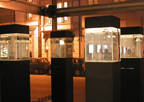
LAb[au] + Frederik De Wilde won the Prix Médiatine with EOD02! The 20 year-old Médiatine Prize rewards innovative contemporary art, no matter their thematic or artistic discipline. It is selected by a professional jury and is organized and hosted by the art center of Woluwe Saint-Lambert.
EOD02 is a new media installation founded on special species of fish that perceive, electro-sense, their environment and communicate with each other by emitting electric signals, either in pulses or waves. The project explores the normal communication mechanisms of electrical fish, including JAR (the means by which a fish avoids attempts by other fish to jam its frequency) and thus investigates communication and non-communication between individual fish as well as between fish and people.
The installation is based on four aquariums of taintless mirror, each presenting a specific composition of fish producing different electric signals. In each aquarium antennas allows capturing the fish signals which are directly related to four speakers transforming these signals into sound, what we hear is the fish's electric signals_ their communications. Further under each aquarium a light bulb is placed pulsing according to the intensity, rhythm, of the emitted signals of the blind fishes. In this manner the electrical impulses of the fishes drive sound and light, an entire audiovisual space.
EOD02 will be exhibited from 28.03 until 11.04 at La Médiatine.
Posted by jo at 01:46 PM | Comments (0)
March 08, 2007
Independent Robotic Community
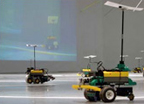
Social Network for Robots and Humans
"In a special edition of El Pais Digital reporting the Arco festival in 2001, the Spanish artist Ricardo Iglesias, one of the net art pioneers in his country, said that nothing or almost nothing ("only cliché") can be said about net art in five or six lines. However he mentioned a series of isolated topics that interconnected, related to each other, that'd really express net art: the network, the global and decentralized communication, interactivity, the virtual spaces, telepresence, the chaos theory, the active and interactive principle, the telematic interfaces, the post-biological culture, the hypertextual perspective, on line-chat, the rhizome image and the state of uncertainty.
His latest artwork, Independent Robotic Community, is a sum of all of the above. Developed with Gerald Kogler the project focuses on new forms of interaction between robots and humans on two levels.The first one features a community of 20 small robots divided in two groups. Each group has a primary level of socialization and a series of sounds conforming with a single vocabulary. Each robot's initial state consists of a very simple movement within a delimitated spatial environment. When it comes across other robots, it swaps data about its state with sounds and increases its degree of socialization and the complexity of its movements. On a second level humans can interact with robots using mobile phones and Internet, communicating with them in real time and further influencing the socialization process within the independent groups. The result is an original visual representation of a social network that includes both the subjective point of view of a spy camera and the graphic display of social statistics. As to confirm that net art is the art of networking." Valentina Culatti, Neural.
Posted by jo at 08:48 AM | Comments (0)
March 06, 2007
Art Interactive
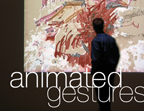
Camille Utterback's Animated Gestures
Animated Gestures: three recent interactive drawing installations by pioneering new media artist, Camille Utterback :: Curated by Lisa Dorin :: March 9 - May 13, 2007 :: Art Interactive, 130 Bishop Allen Drive, Cambridge, MA 02139 ::
The three installations in Animated Gestures are part of the artist’s ongoing External Measures series, which Utterback began in 2001. They consist of the single-channel projections, Untitled 5 (2004) and Untitled 6 (2005), and Alluvial (2007), a two-channel piece commissioned for a private collection and debuting publicly at Art Interactive. In each installation, a unique abstract composition is created through what Utterback refers to as an “aesthetic system that responds fluidly and intriguingly to physical movement in the exhibit space.”
When a viewer enters the designated area in front of the projection screen, her shape is captured by an overhead camera, which communicates the information to a computer program that translates her movement into one of a series of corresponding marks, erasures or animated actions in the projected composition. The palette of organic marks resembles a variety of traditional drawing media—thick oil pastel or felt pen smears, delicate watercolor spots, chalky conté-crayon scribbles, and subtle pen and ink dots and lines—that are reflective of the artist’s own hand. Utterback’s early oil paintings, from her pre-technology art-making days, such as Pink Galaxy (1995), display a comparable affinity for the abstract gestures, particular color combinations, and characteristic mark making that appear in the External Measures series.
Similarly, her interest in participatory artworks that draw attention to and make use of the body, also predates her involvement with new media technologies, as exemplified by Preserves (1992), an installation in which viewers were invited to pick up and investigate a set of sealed canning jars filled with combinations of food and female beauty products.
Camille Utterback is a pioneering artist and programmer in the field of interactive installation. Her extensive exhibit history includes The Valencia Institute of Modern Art, Spain (2007); The Itaú Cultural Center, São Paulo, Brazil (2006); The San Jose Museum of Art, California (2005); The New Museum of Contemporary Art, The American Museum of the Moving Image, New York (2003); The Taipei Museum of Contemporary Art (2001); The Seoul Metropolitan Museum of Art, and The Ars Electronica Center, Austria (2000). Awards include a Transmediale International Media Art Festival Award (2005), a Rockefeller Foundation New Media Fellowship (2002) and a Whitney Museum commission for their ArtPort website (2002). Her work is owned by Hewlett Packard, The Pittsburgh Children’s Museum, The La Caixa Foundation and others. Utterback holds a US patent for a video tracking system she developed as a researcher at New York University (2004).
Lisa Dorin is Assistant Curator of Contemporary Art at the Art Institute of Chicago, where she organizes focus, a series of one-person exhibitions by international contemporary artists, and is currently producing a catalogue of the museum’s film, video, and media collection.
Posted by jo at 12:30 PM | Comments (0)
February 28, 2007
MENDI + KEITH OBADIKE LAUNCH

Big House / Disclosure
BIG HOUSE / DISCLOSURE a 200-hour long house song with the voices of Chicago-area Citizens :: WHEN: March 1st- 8th :: WHERE: Northwestern Univ. Campus – Kresge Hall and online :: CONTACTS: office[at]blacknetart.com (blacknetart.com) & w-leopold[at]northwestern.edu, 847-491-4890 (Northwestern Office of University Relations)
Big House / Disclosure was constructed using audio interviews conducted by Northwestern University students with Chicago-area citizens about slavery and the city’s slavery era ordinance. Mixing these interviews with elements of Chicago house music, the artists created a multi-channel sound installation. The project includes 200 video clips of live art and musical performances viewable from the website. Musical events in the sound installation are triggered by custom-designed software tracking the real-time rise and fall stock prices of several corporations that have admitted to profiting from slavery.
Keith Obadike received a BA in Visual Art from North Carolina Central University and an MFA in Sound Design from Yale University. Mendi Obadike received a BA in English from Spelman College and a Ph.D. in Literature from Duke University. They have received a Rockefeller New Media Art Fellowship and commissions from the Whitney Museum of American Art, Whitechapel Gallery of London, Electronic Arts Intermix, and The New York African Film Festival. Their Internet opera, The Sour Thunder, was commissioned by Yale University, broadcast in its’ entirety in (104.5 fm) Berlin, and released by Bridge Records in 2004. In 2005 they launched Four Electric Ghosts, an opera produced by Toni Morrison’s Atelier at Princeton University, and in 2006 they performed a live sound art transmission from the Amory Art Show in New York commissioned by the Franklin Furnace. Big House / Disclosure has been generously supported by a Pick-Laudati Award from Northwestern University.
Posted by jo at 08:47 AM | Comments (0)
February 27, 2007
Sound Garden
![]()
Telematic Environment for Musical Becoming
Sound Garden: asynchronous improvisation by Norbert Herber + others :: telematic environment for musical becoming & interaction :: Web stream (using iTunes, Real Player, WinAmp, or Windows Media Player) :: Installation: Radio-TV Center (WTIU, WFIU, Department of Telecommunications) IU Bloomington campus.
Sound Garden is the second work in a series of musical installations that explore the relationship of people, location, and audio relative to technology. Listeners use the online interface to tend their sonic environment and take an active role in its composition and care. Using a web browser to select from a menu, participants can contribute their own digital audio files (musical material, voice and environmental recordings, etc.) and become gardeners that help to form the overall sonic landscape of Sound Garden.
Help cultivate the garden with your own short recordings, samples, soundscapes, and found sonic objects. Visit www.x-tet.com/soundgarden and access the web interface to "plant" MP3 files you would like to hear, or "prune" the garden and uproot files planted by others.
Posted by jo at 09:13 AM | Comments (0)
February 21, 2007
Pamphlet
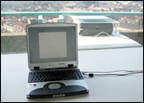
Instant Public Print
The need for physical print could be said to be 'instinctual'. In fact how paper can still trigger our inner instinct to read is at the core of the 'Pamphlet' installation by Helmut Smits. It consists of a laptop, software and a printer placed on the edge of a building window. People can type a message on the laptop. By pressing the "˜send' button a pamphlet is printed and dropped from the 10th floor by the printer. The falling down paper and the resulting 'pamphlet' on the street symbolizes the relatively short distance from the personal production to the public enjoyment of a printed product, and how the traditional product parameters has been disrupted. The fascination of take-away paper is the same at the base of newspapers that are starting to stretch their role and nature with downloadable and printable last minute editions. These are highly customized on one key factor: the updating time. They are meant to be read offline, so enjoyed with a relative calm, but with the most stretched and feverish time of production. This is part of a larger need: to put the virtually and real-time produced content out of the screen to affect real life or be enjoyed in it." - Neural.
Posted by jo at 12:22 PM | Comments (0)
February 19, 2007
Monika Sosnowska

Loop
Monika Sosnowska's Loop :: February 16 – May 6, 2007; Tu – Su 10am – 5pm; Th 10am – 8.00pm :: Opening, February 15, 2007, 6.00pm :: Curator: Adam Budak :: Kunstmuseum Liechtenstein, Städtle 32, FL-9490 Vaduz :: Tel: + 423 235 03 00 :: mail[at]kunstmuseum.li
The Kunstmuseum Liechtenstein in Vaduz is pleased to announce the opening of a first large-scale museum exhibition of Monika Sosnowska, entitled “Loop”. In her installations that echo the formal language of constructivist avant-garde, minimal and conceptual tendencies of the 60s and the 70s as well as a heritage of modernist architecture, Monika Sosnowska constructs a physical and conceptual labyrinth, a post-narrative, inner world of spatiality, staged in a sequence of interventions that emphasize space’s virtualities and potentials. Here, in this complex and powerful investigation of a spatial perception, a particular surgery is being applied to a body of space and its cultural articulation, architecture.
The space and its parameters: size, dimensions, scale, plans, topology are being altered, shifted and possibly confused and manipulated in order to generate a very unique, unusual experience of spatial habitat and to sharpen our perception of it, outside of a common reality and its habits. With her intimate geometry, Sosnowska experiments with our senses and emotions, making us aware of psychosomatic, hidden qualities of s pace which in her highly performative installations are personified and animated. Between Kafkaesque oppression and a desire to liberate space, there is a sublime and uncanny spatial environment, rendered – sometimes very playfully - on the edge of dream-like imagery and an everyday familiar experience.
Sosnowska’s monumental architectural intervention, Loop, developed especially for the Kunstmuseum Liechtenstein in a collaboration with one of the architects of the museum building, Christian Kerez - as a flexible but controlled space with its deconstructive drive and the rare processings of memory - is an attempt to confront modernist universalised patterns and to escape dimensions in a radical act of constructing a subjective space, a sensual, partly oneiric, mental shell of contemplation and desire. Welcome to a seance of a phenomenological spatio-therapy.
Monika Sosnowska was born in 1972 in Ryki, Poland. She studied at the Academy of Fine Arts in Poznan and the Rijksakademie in Amsterdam, and currently she lives and works in Warsaw. Her recent exhibitions include shows at MoMA, New York, Galerie Gisela Capitain, Freud Museum Vienna, Serpentine Gallery London, De Appel in Amsterdam. Sosnowska participated in Manifesta 4 (Frankfurt), 8th Istanbul Biennale, Venice Biennale 2003. Monika Sosnowska will represent Poland at the forthcoming Biennale in Venice.
The catalogue, published on the occasion of the exhibition, contains text contributions by Will Bradley, Christian Kerez, Friedemann Malsch, Anthony Vidler, Jan Verwoert and Adam Budak as well as a rich visual material, including installation shots from the Kunstmuseum Liechtenstein exhibition.
Monika Sosnowska’s “Loop” is accompanied by the programme of the following events:
Thursday, March 8, 2007, 6.00pm
“About Monika Sosnowska’s Loop”
Christian Kerez, architect, professor of architecture, ETH Zürich
Conversation
Thursday, March 15, 2007, 6.00pm
“Experiencing Architectural Spaces”
Konrad Wiesendanger, architect, Luzern
Lecture
Thursday, March 22, 2007, 6.00pm
“Last Year in Marienbad”, 1961, dir. Alain Resnais
Screening
Thursday, March 29, 2007, 6.00pm
“Spaces, Cinema, Feelings. About the Work of Monika Sosnowska”
Jan Verwoert, art critic and writer
Thursday, April 26, 2007, 6.00pm
“Loop”
Monika Sosnowska in conversation with Adam Budak, exhibition curator
Posted by jo at 01:06 PM | Comments (0)
February 09, 2007
Giant Painting Machine
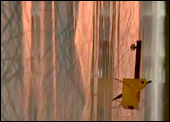
Generative Sound/Painting
Giant Painting Machine (Milano) :: mylar, ink, motors, wood, mounting hardware, electronics (2006)
Giant Painting Machine is a simple electro-mechanical system built largely from found parts and scrap materials. It paints complex and dynamic abstract images on four transparent walls by tracing continuous, cycling paths across large sheets of clear mylar. Because GPM is a wiggly mechanical device, the nature of its brush strokes is constantly changing, and its conceptually smooth, arcing lines are full of smudges, drips, and wobbles.
Simple switches and a DC motor controller guide the paintbrush across the canvas. The path of the brush is determined by the relationship of the dimensions of the canvas to the speeds of the motors. The speeds of the motors constantly ramp up and down, resulting in curved, rather than straight, lines. The brushes are filled with acrylic inks in various colors. Mixing decisions are made on the fly, with each wall focused on a certain color.
GPM was first commissioned for a large jewelry fair. We installed four hand-shaped metal detectors that could be used to influence the paths of the paint brushes. When metal jewelry was placed on one of the hands, the corresponding brush changed direction. The generative sound for GPM was created with a customized, self-modifying version of Larry Polansky's Anna's Music Box software.
Giant Painting Machine (Milano) was commissioned by MUR and the MORE Jewelry Fair in Milan, Italy. It ran eight hours a day for four days during Fashion Week 2006. [via Neural]
Posted by jo at 09:34 AM | Comments (0)
February 07, 2007
Visualizing Memory in Architecture
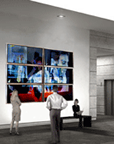
Collision of Memory
Chicago-based artist Lincoln Schatz has been drawing attention with his large-scale generative art installations that visualize memory. The artist has recently been commissioned by Dallas developer Billingsley Company to create one of the largest new media works ever installed in a public space. Due to open on March 29, Schatz's Collision of Memory will be a permanent installation that flanks each side of the entrance to the elevator area of One Arts Plaza, a $125 million multiuse structure, the first of four residential and office buildings on over 10 acres at the eastern edge of the Dallas Arts District. From that moment onwards, two high definition cameras will record the edifice's lobby activity, on a daily basis, during a minimum of 8 years. Selected according to specific chance operations, segments of the footage will be displayed on two 9 x 9 foot video walls in four overlapping layers: one from the last two minutes and three from a distant time period. While standing between the two screens, viewers will see themselves along with visual memories of that place. Continuously washing over one another in painterly portraits of individuals and the surrounding environment, these images relate past and present in uncanny ways, creating a non-linear impression of history. - Miguel Amado, Rhizome News.
Posted by jo at 11:37 AM | Comments (0)
February 02, 2007
SummerBranch
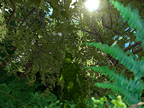
Truth and Artifice in Nature
Summerbranch is a new commission by igloo that explores movement and stillness in nature. Using camouflage and other disguises, a person or a computer character can blend into a ‘natural’ environment captured and treated through the moving image. This installation uses the tools of the military-entertainment complex, computer gaming, motion capture, 3D environments and special effects to question what is truth and what is artifice in our attempts to reproduce nature. Through the creation of a computer generated virtual world, Summerbranch seeks to address this by the use of disguise in dance and movement. IGLOO not only investigates the role of the ‘real’ in virtual environments but also that of the reproduction of nature in the history of art and particularly landscape work.
Summerbranch is the result of a 2 month residency at ArtSway in the New Forest. The exhibition is created for 3 gallery spaces. A series of intermedia works which can stand alone as individual installations or together as a site specific install comprising 3 parts: Virtual environment, Video installation, a set of Lenticular Prints & Wallpaper. [via Rhizome]
Posted by jo at 02:39 PM | Comments (0)
February 01, 2007
JANET CARDIFF & GEORGE BURES MILLER
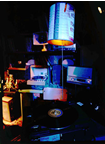
The Killing Machine and other Stories
The Killing Machine and other Stories :: JANET CARDIFF & GEORGE BURES MILLER :: Opening: Thursday, February 1, 2007, 7.30 p.m. :: Exhibition dates: from 2 February to 1 May 2007 :: Coproduced by: Museu d’Art Contemporani de Barcelona (MACBA) and Institut Mathildenhöhe Darmstadt :: Curated by: Bartomeu Marí (Chief Curator of MACBA) :: MACBA, Museu d’Art Contemporani de Barcelona, Plaça dels Angels, 1, 08001 Barcelona, Spain.
Since the early nineties Janet Cardiff (Brussels, Ontario, Canada, 1957) and George Bures Miller (Vegreville, Canada, 1960) have been working together on works in which they use sound and voice as raw material and main subject. Through techniques of edition and reproduction of binaural sound and the use of earphones and loudspeaker systems these works can be characterised as authentic sound sculptures.
These installations become temporal units of experience, in narrations that combine fictional stories and sound effects and question the visitor’s sensory experience, opposing the sense of hearing with the sense of sight. The sculptural space is therefore transformed into a phantasmagorical or hallucinatory one where apparently contradictory cultural traditions coincide at a specific place and time. The spectator is looking at works that are difficult to classify, since they propose a collage that brings together forms of high culture such as opera, art films or literature with popular culture, B-movies, rock’n’roll or radio broadcasts.
This exhibition contains a total of ten installations that weave a fabric of independent but complementary experiences. Each work imposes a time and a rhythm of its own, and like a play is linked to the imaginative capacity of each individual, which gives rise to a host of readings. This very high reading visuality brings Cardiff and Miller’s work close to literature by generating a script which can be read or interpreted according to the eye or ear of each reader-spectator. This produces stories that live side by side in time and transport the visitor to superimposed fictions: of the museum and of the works.
Among the Solo Exhibitions of Janet Cardiff and George Bures Miller in recent years are: the Lousiana Museum and the Art Gallery of Hamilton in 2006; the Hirshhorn Museum (Washington) and the Kunsthaus Bregenz, in 2005; the Vancouver Art Gallery and the Thyssen-Bornemisza Art Contemporary in 2004; the Whitechapel Art Gallery de Londres and the Museum of Modern Art of Oslo, in 2003; The National Gallery of Canada (Ottawa), the L.Augustine Gallery of New York and the Hamburger Bahnhof (Berlin) in 2002; the Canadian Pavillion in the 49 Biennale Venice, the Ps.1 Contemporary Art Center (New York), the Musée d’Art Contemporain de Montréal and the Castello di Rivoli (Torino) in
2001. [Related 1, 2]
Posted by jo at 09:01 AM | Comments (0)
January 30, 2007
The Burning Question
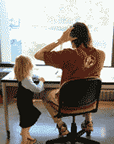
Gallery as Radio Station
The Burning Question, by Abinadi Meza, is a participatory installation and internet radio broadcast. This project consists of customized computers, large color posters, and pamphlets examining Intellectual Property and copyright. Multiple computers are loaded with hundreds of works contributed by composers, musicians, and sound artists from around the world. Visitors are offered blank CD's and invited to freely burn copyleft music; as they make playlists, they collectively generate an Internet radio broadcast that streams 24 hours a day from the gallery for the duration of the exhibit. The gallery becomes an impromptu radio station and visitors become DJ's. [via Rhizome]
Posted by jo at 02:39 PM | Comments (0)
January 24, 2007
Joe Winter
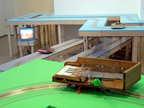
Fantasie no. 1 for Mobile Pianos
Fantasie no. 1 for Mobile Pianos is a kinetic sound and video installation. Five modified toy pianos circulate the gallery on five elevated wooden tracks. Each piano is equipped with small speakers to play amplified sounds picked up from conductive tape on the tracks. Each piano also contains small motors which intermittently spin to strike the toy pianos' tone bars, adding acoustic elements to the overall soundtrack of the work.
The installation also features five video monitors, which display images of five different real landscapes to compliment the abstract landscape of the wooden tracks. As the pianos begin to move around the gallery, these video landscapes become populated by a seemingly infinite stream of mobile pianos.

Distributed Performance
Distributed Performance takes place in multiple sites throughout a single building. Each site, or 'node,' is comprised of installed speakers, wire, various amplifiers, microphones, and a computer. All nodes are interlinked, both by audio cable and via ethernet. Each computer features the same display: an abstracted map of the space and the nodes within it, through which audio materials flow. When visual representations of audio flow within the spatial boundaries of a particular node, it is sonified there. The performer's presense at a particular node will serve to attract audio material to that location and to slowly organize it into rhythmic structures. Simultaneously, the programming may usurp the performer's control and direct the flow of materials elsewhere. The display may then serve as a map--both to the performer and the audience--to direct the flow of the performance from node to node. More >>
Posted by jo at 03:57 PM | Comments (0)
January 19, 2007
V2_ Institute for the Unstable Media
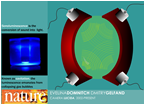
Camera Lucida: Sonochemical Observatory
V2_ Institute for the Unstable Media presents Camera Lucida: Sonochemical Observatory by Evelina Domnitch and Dmitry Gelfand :: Thursday 25 January until Saturday 3 February, 2007.
Camera Lucida is an immersive spatial art work creating a fleeting ephemeral materiality by intersecting ultrasound with hyperlight - in essence creating an unstable sonic aurora. Developed in collaboration with numerous physics research labs the 'observatory', a transparent gas-filled chamber, converts sound waves into visible light by employing a phenomenon known as sonoluminescence. Here, gaseous micro-bubbles injected within a fluid medium are blasted with ultrasound causing them to implode, at which point they become as hot as the sun and release light energy in the form of sound waves. By modulating, or 'playing' the ultrasonic transducers attached to the glass chamber an ever-changing sonochemical environment, visible only within a sheath of extreme darkness, emerges.
Belarussian/American artist duo Evelina Domnitch and Dmitry Gelfand's practice creates cross-disciplinary art works that integrates physics, chemistry and computer science with philosophical practice. With the /Camera Lucida/ they work to harness wave phenomena, both as sound and light in order to examine intrinsic questions of spatial perception and perpetuality. Having dismissed all forms of fixative and recording media, Domnitch and Gelfand's installations exist as unstable, ever-transforming phenomena offered for observation. http://www.portablepalace.com
Daily: 11:00 hrs - 18.00 hrs :: Admission: free :: V2_ Institute for the Unstable Media. Eendrachtstraat 10 3012 XL, Rotterdam :: Phone: +31 (10) 206 72 72
/Camera Lucida: Sonochemical Observatory/ will continue from 7 February until 3 March. Opening hours: Wednesday - Friday: 11:00 hrs - 17:00 hrs :: Extra opening Museumnacht, 3 March 2007 : 20:00 hrs - 02:00 hrs
Posted by jo at 10:57 AM | Comments (0)
January 18, 2007
Schwelle
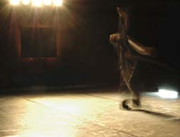
@ Tesla/Transmediale 2007
Schwelle is a new media and performance project using cutting edge acoustic and interactive technologies to explore the extreme threshold states of consciousness that constitute human experience. The multi-part project uses High Definition image and multi-channel sound, interactive installation and live performance to create states of consciousness in the spectator akin to the thresholds states that one experiences at the edge of trance, sleep and death. For transmediale '07, Tesla presents parts 1 and 2.
Part 1 is a turbulent exploration told by way of image and sound of the experience undergone at the time of the dissolution of the body and of consciousness. Part 2 is a live performance in which the audience confronts a lone single performer Michael Schumacher, master improviser and long time dancer by William Forsythe’s Frankfurt Ballet, experiencing the traumatic transition period between death and rebirth. Utilizing wireless sensor networks in the room and on the dancer’s body, Part 2 creates a stage environment where light, sound and objects take on their own choreography, performing with Schumacher, breathing, and behaving alongside him. Where does the body end and the room begin? What happens in the threshold where body and room merge, mutually influencing and transforming each other?
Schwelle is a co-production between artists and researchers from cultural and scientific institutions in Canada, China, Germany, Holland, China, and the USA. Schwelle, Part 2 was partially developed during a project residency at Tesla in Summer 2006 and will receive its world premiere at "tesla zur transmediale".
Part I
Concept/Direction/HD Video/Sound: Chris Salter
Collaboration Sound: Daniel Moody-Grigsby and Philip Viel
Part II
Premiere: Tesla/Transmediale 2007, Berlin, February 2007
Concept/Direction: Chris Salter, in collaboration with Michael Schumacher
Dramaturgy: Heidi Gilpin
Lighting Design: Lea Xiao
Sound Design and Programming: Marije Baalman, Daniel Moody- Grigsby, Chris
Salter, Philip Viel
Interaction Design/Sensing Systems: Marije Baalman
Objects: Thomas Spier, Flora Luna
Production Stage Manager/Technical Director: Daniel Plewe
Production Assistents: Daniel Wessolek, Alexander Wilson, Brett Bergmann
Tesla: Medien-Kunst-Labor, Klosterstrasse 68, Berlin
Thursday-Saturday, February 1-3, 2007. 20:30
For tickets/more information, please visit http://kasse@tesla-berlin.de
Christopher L. Salter, Ph.D.
Asst. Professor of Computation Arts
Faculty of Fine Arts
Concordia University
Researcher_Interactive Performance and Sound Hexagram
Posted by jo at 03:00 PM | Comments (0)
January 10, 2007
Sleeping Beauty

In Which the Object of our Gaze Subjects us to Hers
Sleeping Beauty is an interactive installation by Claudia Hart and Michael Ferraro (2005) offering an alternate approach to virtual, sexual corporeality. From the artists: Sleeping Beauty is an interactive odalisque, using a projected 3D animation that responds to a viewer's presence. Portraying the compressed time and space of painting, Sleeping Beauty shows a dreaming character whose slow, drowsy movements articulate all of the minutia of a single moment. This “painting” is life-sized in scale, constructing a representation that is more personae, penetrating a viewer's space whose actions may awaken her. When awakened, Beauty opens her eyes to gaze at the viewer, in a moment of transformation, allowing the object of our gaze to subject us to hers.
Based loosely on works such as Titian's Venus and paintings by the Baroque artist Peter Paul Rubens, Sleeping Beauty is meant to introduce direct sensuality into the virtual realm, but employing an idea of beauty defined by a woman rather than men in which the subject does not express conventional canons of body and facial type. In so doing Sleeping Beauty inverts the typical 3D character-based animations of interactive gaming, not just through its visual language buy by also rejecting their violence and aggressive speed. By implicating viewers through involving them in the interactive process, Sleeping Beauty rejects the voyeurism of the historical odalisque and is sensual rather than pornographic. The agenda of Sleeping Beauty therefore, is to intentionally redefine the cliché, misogynist representations such as commercial gaming characters like Blood Rayne and Lara Croft. [blogged by rebecca on selectparks]
Posted by jo at 09:28 AM | Comments (0)
January 07, 2007
High Noon
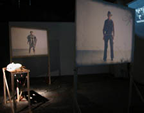
Mobile Phone Duels
High Noon is an installation that links an analogue machine to the cyber world of cell phones. "The game is simply a duel," explains David Pfluger who created the work together with the other members of mobileskino. "Two cowboys are projected facing each other onto two screens. They are waiting to duel. The projections are Super8 loops.
There are two playing modes: 1. Two players come and attach their cell phones to the machine. Then onto a signal teach player has to use an old telephone with the classic turning dial to call himself as fast as possible. The first cell phone to react to the incoming call will make one of the cowboys shoot the other one. The funny thing about this duel is that many people today have actually never used a classic turning dial. Also many do not know their own cell phone number by heart!
2. During one hour between noon and 1 pm the second playing mode is active. Anyone can register for a duel by sending an SMS to a certain number. A computer administrates the incoming messages and chooses two players from the list for a duel. The players receive an SMS with a code word which they have to send back written backwards. The one who is first will win. This mode makes it posible to play the game also with people who are not present at the exibition of the installation. The cowboys can also start a duel without anyone being present and playing at all because they are driven by two players who are somewhere else.
An old printer attached to the computer will always print the nicknames of the actual duellists and show who won and who lost." [blogged by Emily on textually.org]
Posted by jo at 06:01 PM | Comments (0)
January 04, 2007
Mogens Jacobsen:
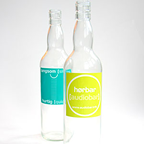
Hørbar/Audiobar
Hørbar/Audiobar is a responsive environment for natural and playful exploration of huge collection of audio art. You can interact with the sounds using a tangible interface based on RFID-tagged bottles. The environment consists of two rooms: A bar-room for shared interaction and a study lounge for more in deep explorations.
Hørbar/Audiobar will be premiered at the Museum for Contemporary Art in Roskilde, Denmark. This museum has a huge collection of international audio art which will be accessible at the bar. The installation is part of the exhibition Social_Action - The Audience and the New Media Landscape.
The exhibition opens on January 12th 2007 at 17:00 - 20:00 :: Address: Museet for Samtidskunst :: Stændertorvet 3D, DK-4000 Roskilde, Denmark. The project is supported by Kulturnet Denmark and Sound Forum Øresund.
Posted by jo at 06:12 PM | Comments (0)
January 02, 2007
Daniel Joseph Martinez
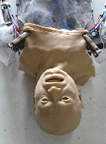
Android Provocateur
Drawing on the conventions of Blade Runner-style science fiction, Daniel Joseph Martinez uses tropes from the genre--particularly the language of dystopian futurism, android aesthetics, and replicated consciousness--to make social, political, and philosophical provocations. The artist's strongest work borrows strategies from performance art but substitutes an automaton for the human body. His recent installation, The Fully Enlightened Earth Radiates Disaster Triumphant (2006), is a life-size animitronic doppelganger of the artist clad in sanitarium-white cloth. Lying on the floor, the figure lashes and writhes as if the semi-conscious android was attempting, but failing, to function as a human. Inspiring an uneasy mix of empathy and detached curiosity, Martinez uses the viewer's relationship to the work to draw out the social and political problems that arise from the digitalization of cognizance. Like most of his work, the installation is purely a spectacle of failure, offering no conclusion to the chaos that it proposes. Taking on a more explicit political dimension, Martinez's project will represent the United States, through January 31, at the 10th Cairo International Biennial, where the installation is likely to draw comparisons to the instability caused by American attempts to 'rewire' the political workings of the Middle East. - Bill Hanley, Rhizome News.
Posted by jo at 10:21 AM | Comments (0)
December 26, 2006
Ballonnenveld
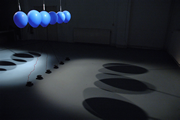
Sounding Balloons
Ballonnenveld, an installation by Martijn Tellinga, displays a sounding and vibrating body of helium-filled balloons. The balloons function as resonance-chambers for a trimmed spectrum of sine-waves that are fed through strings, connecting the balloons with double-coned carspeaker-elements. Each balloon holds its own resonance-frequency that changes over time as a result of varying temperature in the space, amount of helium in the balloon (decreasing over time) and length of the string. Hitting the resonance-frequency the balloons start to get bumpy, as well as the connecting strings, clearly showing the waveshape of the soundsignal going through. This of course causes an acoustical process, perceiveable in the space. Carefully balancing the level between direct sound from the carspeaker-elements and the acoustical-qualities produced by the balloons, creates a musical mechanism that bridges between instrumental and electronic sonoroties and, gently directing the balloons, between acousmatic music and instrumental playing.
The balloons are also a switch in a feedback-loop and, because of their movement, affect the amount of pick-up from the microphones placed above. Each feedback-circle knows a number of breakouts to balloons solely functioning as resonance-chambers. Through pitchshifting, these balloons show slightly different colouring in sound and add to a slowly shifting and modulating body of tones and subtle timbral distortions that arise from the field of balloons. Ballonnenveld explores and visualizes the physicality of electronic sound, though succeeds very well to hold on to its magic and serenity through the particular acoustical behaviour of the installation, hopefully capturing the poetry of the physical process that is behind.
Ballonnenveld was developed in collaboration with Radboud Mens and Danny de Graan and with the support of STEIM and FAPK. [via]
Posted by jo at 10:34 AM | Comments (0)
December 21, 2006
Turbulence Commission:
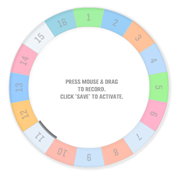
WhoWhatWhenAir
Turbulence Commission: WhoWhatWhenAir by John Snavely :: WhoWhatWhenAir is an interactive, pneumatic sculpture that users can communicate with via a web-based interface. Each user makes a series of choices to determine the order in which the 16 hoses inflate and to what degree. Once the sequence is saved, the hoses or "muscles" perform it. Clicking on the "play" button brings the sculpture to life. It exhales deeply before moving on to the next sequence in the queue. Coordinated efforts between online users can produce unexpected choreographies. In physical space, interaction is proximate, learned, and social. On exhibit at Art Interactive, Cambridge, Massachusetts, until January 14, 2007; open weekends from 12-6 pm.
"WhoWhatWhenAir" is a 2006 commission of New Radio and Performing Arts, Inc., (aka Ether-Ore) for its Turbulence web site. It was made possible with funding from the LEF Foundation.
BIOGRAPHY: John Snavely is a Masters of Architecture Candidate in the Department of Architecture at MIT. He holds dual degrees in Computer Science and Sculpture from Dartmouth College.
Posted by jo at 09:19 AM | Comments (0)
December 13, 2006
Digestive Table
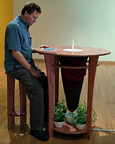
A Waste Processing System
Digestive Table by Amy Youngs: A living ecosystem of worms, sowbugs and bacteria are invited to this table. They are a part of the digestive system that starts with a person discarding food leftovers and shredded paper into the portal at the top. The bacteria and sowbugs begin breaking down the waste and the worms soon join in to further digest it into a rich compost that sprinkles out of the bottom of the fabric bag that hangs beneath the table. This compost is used as a fertilizer for plants, such as those at the base of the table.
The human plays an important part at the table by eating, feeding the food waste to the worms, feeding the resulting fertilizer to the plants, or by simply sitting and appreciating the living ecosystem she/he is a part of. A cross-section of the activity inside the top 9 inches of the compost is made visible using an infrared security camera connected to an LCD screen built into the table. On the screen, viewers can see the live movements of the worms and sowbugs inside. [via]
Posted by jo at 08:26 AM | Comments (0)
November 17, 2006
Priceless
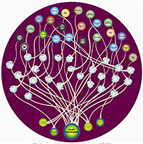
Underground Station Social Network Art
"We have created priceless, a multi-layered artwork in which the voices of individuals and institutions merge in surprising and unexpected ways. Objects of great value have been chosen by each institution to inspire an imaginative journey. People's unique stories and memories are showcased through audiovisual portraits, mobile exhibitions, installations and large-scale projections."
At London’s Huntington Station, a series of portraits and maps along the floor and walls reveal the Underground’s staff networks. The project is called Priceless. A sample of the images by motiroti is shown above.
London Underground staff have worked at the station for 138 years at the hub of a unique community of traders, museum workers, loiterers and licensed buskers who create the background atmosphere of this rich and complex environment.
motiroti has worked with LU staff to explore their personal connections and social networks. The participants were recorded in sound, video and writing by motiroti artists, who translated this information into an extraordinary series of graphic portraits and maps.
Along the length of the tunnel, 17 wall graphics and 26 individual floor constellations reveal the staff’s “hidden maps” of connections, and their personal worlds. Staff at South Kensington are connected with 66 national cities, 41 international cities, and with their friends speaking a total of 33 languages. Via Information Aesthetics [blogged by Judy Breck on Smart Mobs]
Posted by jo at 05:09 PM | Comments (0)
November 10, 2006
Interface and Society
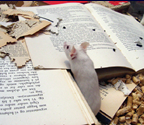
AbA Logic + Superconsumer
AbA Logic by Art by Accident (Kalle Grude, Jan Løchstøer) :: Six Muses of Randomness: Six white mice reside among books on logic subjects inside a laboratory cabinet. What are they doing there? Well, obviously they are nibbling on the books. Apparently they are nesting, as in quiet moments they cuddle up in a ball beneath snippets of logic. As they wander among the books they trigger a databank of words connected to electronic boards. The boards make up two sentences of three words each (so-called AbA-logic statements). Each time a mouse triggers a sensor, a new statement appears. The words (adjectives, adverbs and nouns) are common in logic terminology. The statements that appear are less common. This is why they are of interest to us.
In order to materialize this constant stream of statements, they are printed as they appear. On AbA’s desk piles of sketches and notes from the process accumulates. In addition to participate in a digital process, the mice -through their nibbling- are creating sculptural rephrasing of the books, and produce new combinations of the texts and illustrations from the pages of the books.
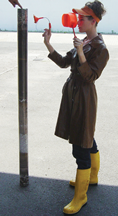
Superconsumer by Franz Alken and Karl Rueskaefer :: What happens when a computer programme starts buying and selling stuff on Internet auctions like ebay autonomously? That is the key question of superconsumers. The stuff the Bot has bought is exhibited for a short time. Thus digital values are translated into tangible goods. And vice versa, since the Bot sells them again after a while to buy new ones. In this way, commonplace products are temporarily translated into works of art.
The basic principle of superconsumers, is to make an amount of money available to a software (a so called “bot”). The software uses this money to buy goods autonomously at the online-auction-platform ebay, transfers these goods to an art-space, exhibits them and sells them again via ebay. The exhibition-module consists of a computer-interface displaying the softwares actions at ebay, 7 pedestals that show the current goods and a watchmann who executes the software’s instructions and arranges the goods on the pedestals. There are mainly 4 points that form a fascintation for this project: The relationship between humans and machines - the bot replaces exemplarily the role of humans in the ebay environment.
The ready-made principle: While transferring ordinary objects from the mass-market to an art space, the bot enhances the objects to pieces of art. This enhancement is temporarily, the bot takes away the “art aura” by selling these pieces again via ebay.
The installation gives a constantly updated overview on the mass-market. The programming of the process makes the items the bot will buy unpredictable - a search on the topic “football” can respond items like fan-articles, computer games, books or sportswear. Interaction is an important point on art-projects dealing with the internet. The interaction at superconsumers is quite hidden: Everyone dealing with the bot at ebay is arranging the exhibition without knowing it.
More about Interface and Society [PDF]
Posted by jo at 04:57 PM | Comments (0)
November 06, 2006
Mario's Furniture 2

Players Actualized in Real and Virtual Space
Mario's Furniture 2 is an installation and interactive game created by Hillary Mushkin and S.E. Barnet. Instead of sitting on the couch, players have to move the couch, and the whole living room too!
In this wireless environment, viewers become players, physically moving objects of conflicting human and miniature scales, while racing against the camera's ceaseless panning. The opponents' goal is to maintain the illusion of perspective and the integrity of the mise-en-scene within the gaming space. Time and space become mutable in correlation to virtual gaming apparatuses.
The body of the player is actualized in real and virtual space simultaneously. Playing Mario’s Furniture involves strenuous physicality, parodying conventional video games in which avatars are put in peril while players sit on a couch. Mario’s emphasizes how camera and screen effect the construction of social relationships. Players see themselves (and not a stand in) under the camera’s scrutiny, humorously mirroring the absurdity of living within the frame.
Video. See it at TELIC, Los Angeles, until December 2, 2006. Related: the Nintendo Amusement Park aims to build a life-sized game of Super Mario Brothers that you jump through in real space; xBlocks is a mixed-reality video game that you can play on a sculpture and Shigureden: the Nintendo-powered Museum. [blogged by Regine on we-make-money-not-art]
Posted by jo at 09:55 AM | Comments (0)
November 03, 2006
Déplacements
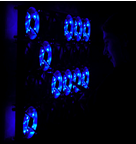
The game of life
Déplacements, by Manuel Braun, consists of 24 computer case fans forming a rectangle. Each fan is a “pixel”, its number of revolutions and the intensity of the light of its LED varies according to the level of gray corresponding to the pixel of reference. This screen of fans is controlled by a computer simulating a cellular automata entitled “The game of life” (created by John Horton Conway in 1970). It is a mathematical model where each fans is a cell. "Displacement" is a hijack of this object, a component of the computer becoming image. It is not a question of a physical “displacement” but of a movement, a flow. [via] [More >>]
Posted by jo at 10:33 AM | Comments (0)
October 31, 2006
Synthecology
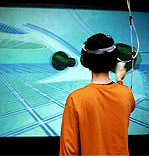
A Tele-Immersive Collaboration
Synthecology combines the possibilities of tele-immersive collaboration with a new architecture for virtual reality sound immersion to create a environment where musicians from all locations can interactively perform and create sonic environments.
Compose, sculpt, and improvise with other musicians and artists in an ephemeral garden of sonic lifeforms. Synthecology invites visitors in this digitally fertile space to create a musical sculpture of sythesized tones and sound samples provided by web inhabitants. Upon entering the garden, each participant can pluck contributed sounds from the air and plant them, wander the garden playing their own improvisation or collaborate with other participants to create/author a new composition.
As each new 'seed' is planted and grown, sculpted and played, this garden becomes both a musical instrument and a composition to be shared with the rest of the network. Every inhabitant creates, not just as an individual composer shaping their own themes, but as a collaborator in real time who is able to improvise new soundscapes in the garden by cooperating with other avatars from diverse geographical locations.
Virtual participants are fully immersed in the garden landscape through the use of passive stereoscopic technology and spatialized audio to create a networked tele-immersive environment where all inhabitants can collaborate, socialize and play. Guests from across the globe are similarly embodied as avatars through out this environment, each experiencing the audio and visual presence of the others.

Participants from the WWW use a browser interface to contribute sound elements to the garden environment for use as compositional items. All the while, this real-time composition is streamed through web broadcast of the virtual environment to illustrate the audio-visual transformation of the garden. Broadcast throughout the entirety of the festival, Synthecology will celebrate the possibilities of collaboration, improvisation, and distributed authorship that exist on the horizon of an increasingly interconnected world.
As current advances in networking become commonplace, the creation of collaborative environments connecting remote individuals will become less involved. By augmenting the possibilities for users to share sensory presence through tele-immersive interfaces, Applied Interactives intends to combine the possibilities of real-time collaboration and socialization with the dynamics of digital creation and manipulation. Synthecology is a speculative glance at how the technology of today may be utilized to create new autonomous zones for sampling & re-mixing culture.
COLLABORATORS
Synthecology is being created as a collaboration of students and faculty from the Electronic Visualization Laboratory at the University of Illinois at Chicago, The School of the Art Institute of Chicago, and Columbia College Chicago, and art(n) through the Applied Interactives organization.
ABOUT APPLIED INTERACTIVES
The purpose of Applied Interactives, NFP is to educate the art and science community about the medium of Virtual Reality as an interactive, computer-generated, immersive computer graphics environment. Applied Interactives, NFP plans to advance the medium through research and experimentation as well as provide a bridge to bring the technology out of institutional labs and into more publicly accessible arenas. Applied Interactives, NFP intends to propagate the medium by providing support and direct access to the resources necessary for artists and scientists to exhibit and develop works in the medium.
Posted by jo at 03:44 PM | Comments (0)
October 24, 2006
Paul Chan at

PORTIKUS
Paul Chan :: Opening: October 27, 2006, 8 p.m. :: Exhibition: Oct 28 – Dec 3, 2006 :: Press Talk: Oct 27, 2006, 11 a.m. :: PORTIKUS :: Alte Brücke 2 Maininsel, 60594 Frankfurt am Main, Germany :: Telephone +49 69 962 44 54-0 Fax +49 69 962 44 54-24.
The Portikus in Frankfurt am Main proudly presents Paul Chan’s first exhibition in Germany. Born in Hong Kong in 1973 and educated in the US, he has established himself as an important international artist. In the wake of 9/11 and the war in Iraq, Chan has become a key figure both in the American art world and in the world of political activism. He is also an artist who emphasizes what is specific of these two spheres.
Like fleeting shadows on the ground, we see objects defying gravity. Sunglasses, cars, people—everything is falling against a backdrop in shifting colours. But what appears to be simple shadows are digital animations projected on the floor—a recurring feature in Chan’s ongoing series The 7 Lights. Portikus presents 3rd Light, the first part to also involve a sculptural element: a 3-dimensional replica of the table in Leonardo da Vinci’s Last Supper. This ingredient emphasizes the theological quality already strongly felt in the previous chapters, and the first falling object to appear is an apple, followed by chairs and dogs. In spite of the calm and meditative atmosphere, this seems to be a work about a world falling apart. Here the world seems to end in silence.
Paul Chan creates films, animations and works with references to Goya as well as to Japanese pornography, to the Bible as well as to the Samuel Beckett. Previously this year he participated in the Whitney Biennial. Other recent exhibitions include a solo show at the ICA in Boston (2005), ‘Uncertain States of America,’ at Astrup Fearnley Museum of Modern Art in Oslo (2005), the Lyon Biennial (2005), and the ‘Greater New York’ at PS 1 in New York (2005).
This exhibition is accompanied by a catalogue produced together with Magasin 3 Stockholm Konsthall, where the artist currently presents other key works. Portikus’ and Magasin 3’s joint venture is the artist’s first institutional solo presentation in Europe.
Posted by jo at 02:01 PM | Comments (0)
October 20, 2006
Ah-ha: Narrative Structures in Reactive and Interactive Video Art

Connecting the Physical and the Digital
[Image left: "Guillotine" by Steve Shoffner) "Performance is so many things: the synchronized sounds of a symphony; actions with words in a play; steps and turns in a dance; words from a pulpit. Performance art, too, is variable, perhaps too multifarious to define, even with semicolons. At traditional performances with traditional support materials, from symphonies with program notes to theatre productions with playbills, performance acts as replay, a repeat of an event, a memorization of a string of notes or a set of lines, a reformulation of a tested formula. Then there are those performances that vary, that respond to the moment, that unfold through the implementation of chance or improvisation or, more and more, digitization. With the insertion of new technologies into performance, the question arises – do actions result from numbers? What indeed is the connection between the physical and the digital? Does the digital component determine the performance, or do actions generate a numeric pattern, which then underlies the piece's structure?
The aesthetic and conceptual import of digital performance pieces is linked to the ordering of a piece's technological components. Random sequencing is one form of structuring immersive environments or data-triggered scenes. Fixed sequencing of scenes, with a predetermined index of performed actions and triggered events, follows a preset score. Alternately, sensory responsive improvisation is flexible and often produces variations in structure. In each case, the piece's content is the result of a digital system: programming or computer responses to external stimuli determine how the performance plays out. Even interactive improvisation, in which a human action triggers a computerized event, is a digital system, albeit one that emphasizes the human element, or input, in that system. The content of an interactive piece is closely related to its structure – the interaction between trigger, whether generated by the viewer or performer, and event. Interesting variations in content emerge when the structure becomes the art.
Below, by electronic interview, four new media artists describe their modes of working with interactive technologies and probe the relationship between order and content in their work. Johannes Birringer makes telematic connections in performance, installation, and video. Mark Coniglio co-directs the interactive dance company, Troika Ranch, with Dawn Stoppiello; he both designed and implements the interactive software, Isadora. Cat Jones' alternate persona catgURL interacts with viewers while performing live on and off the screen. Steve Shoffner instigates interactions with viewers while performing simultaneously on video and within his installations." From Ah-ha: Narrative Structures in Reactive and Interactive Video Art by L. Hermes Griesbach, VJ Theory: ART, 12/10/06.
Posted by jo at 02:29 PM | Comments (0)
October 19, 2006
Culture Catcher
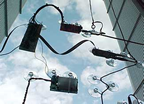
Lost in Translation
While driving through Africa, Michael Sheridan and his film crew met two men crouching in the sand and listening to handheld shortwave radios. The sounds from their radios reconnected the artist with the world after days of isolation and disorientation.
This experience inspired the sound installation Culture Catcher. Shortwave radios, digital recorders and players, motion detectors, micro computers, antennae... all the equipment required to search for and broadcast multiple shortwave radio signals is hung by suction-cups on a giant transparent wall.
The movement of visitors in the gallery triggers sounds from around the world which fill the environment. Simultaneously one might hear, for example, Persian music, Christian proselytizing and news reports in Korean, all affected by the interferences in the atmosphere. Via neural. [blogged by Regine on we-make-money-not-art]
Posted by jo at 08:28 AM | Comments (0)
October 17, 2006
Second Natures
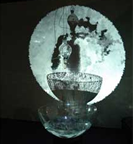
Victoria Vesna's Water Bowls
The four Water Bowls, by Victoria Vesna, use of some of the latest scientific observations to revisit common metaphorical associations of water -- such as the reflection of the moon, a drop of water, the sound of water, and oil and water. The interactivity is activated when the water is touched in the physical space (Moon and Sound) or influenced via the internet by dropping water and money remotely (Drop and Oil).
When visitors touch the water in the Moon bowl, sounds are created, picked up by an underwater microphone and amplified. An animation of water molecules cycling from a heavily polluted state to clearing and back is then projected onto the water.
Sound is equally activated by touch, which generates a disturbance of the water reflection and allows the person to feel the vibration of sounds based on underwater pollution (such as sonar frequencies, explosions and submarines) as well as whale sounds and cell vibrations.
In Drop, a drop of water released into the bowl triggers images derived from maps of waterbodies that ripple away. At the project website, visitors can remotely release this water drop from a dispenser suspended above the bowl in the exhibition space. Online visitors are asked to identify themselves with the Nile, Ganges, Danube, Atlantic Ocean, or any other water body of their choice. The interface then pulls up a topographical map of the chosen location. The location of participants is mapped by tracking the IP address of their computer and pairing it on the map with the body of water with which they identify. They can then add a water drop to the bowl. The topographical map and the visitor's position on it are also projected onto the bowl in the exhibition space.
The Oil bowl contains both water and oil, which appear as clearly separated substances. At the project website, visitors can make a wish (by typing it in) and remotely release a copper coin into the bowl from the dispenser above it. The wish is projected onto the oil and visible on the wall behind the bowl as a visualization of dissolving particles.
Video presentation; other movies.
The installation is part of Second Natures, an exhibtion curated by Christiane Paul. Second Natures runs until October 26, 2006, at Eli and Edythe Broad Art Center, UCLA, Los Angeles.
More water-based works: Water gongs; Music from the pools; Musical droplets; the Blur building; Mocean, a musical environment that invites people to touch, stir and play with water in a tank<; Touch-sensitive water lights; Drink Water exhibition by Orta; Eavesdripping, Water as physical display; The bathroom as a biotop; Herz Fassen (Take Heart); Sound Flakes; Communication through tears; Breeding Space and Erez Kikin-Gil's Water Play. [blogged by Regine on we-make-money-not-art]
Posted by jo at 11:42 AM | Comments (0)
October 15, 2006
Turbulence Commission:
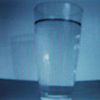
"Nothing Happens - a performance in three acts"
Turbulence Commission: Nothing Happens by Nurit Bar-Shai, Zachary Lieberman and Rich Miller :: Nothing Happens is a networked online performance in which the viewers work together to make a series of objects tip over. The performance consists of three acts, which are centered on staged environments – a high shelf, a cluttered tabletop, and a deserted corner. Each scene contains a central protagonist, respectively: a cardboard box, a clear pint glass full of water, and a wooden chair. In all three acts, web-enabled physical devices controlled by the viewer’s clicks will make these objects tip over.
The three acts will be presented on October 15th, 22nd and 29th at 3rd Ward gallery Brooklyn. Please join the artists for an opening reception Sunday, October 15, 2006 6-8 p.m.
"Nothing Happens" is a 2005 commission of New Radio and Performing Arts, Inc., (aka Ether-Ore) for its Turbulence web site. It was made possible with funding from The Greenwall Foundation. Additional support from 3rd Ward Gallery.
BIOGRAPHIES
NURIT BAR-SHAI'S main interest lies in exploring tensions between the mundane and the uncanny in everyday life. Emanating from her creative roots in fine arts, Bar-Shai employs video and new technologies to explore fundamental questions of presentation and representation, to reframe the familiar and turn audiences into foreigners in their own ontological domains.
ZACHARY LIEBERMAN'S work uses technology in a playful and enigmatic way to explore the nature of communication and the delicate boundary between the visible and the invisible. He creates performances, installations, and on-line works that investigate gestural input, augmentation of the body, and kinetic response.
RICH MILLER is a sculptor and a recent graduate of the Interactive Telecommunications Program at NYU. His creative energies are focused on making electro-mechanical pieces that humor him, as well as designing and fabricating innovative and dynamic children’s museum interactives and furniture. He lives and works in Astoria, NY.
Posted by jo at 02:15 PM | Comments (0)
October 13, 2006
Ombea
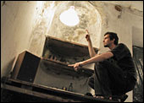
A Paradoxical Physical Interaction
'These people so scared by silence' Chuck Palaniuk writes in Lullaby, 'these sound-oholics are my neighbors'. To resist the siege of noise, some students from FAMU (Film Academy of Prague) has created OMBEA, an interactive installation, placed in a world populated by quiet-phobic people. The work reacts to visitor's movement according to a paradoxical equation. Four speakers, four light sources and two cameras are places within a space that is isolated from outdoor light and sound. Outside the interactive space there's the computer that controls Ombea reactions. These are: spectator physical movement equals darkness and noise, while his calm and immobility equals light and silence. The visitor is not provided with any instruction before entering the installation and he is forced to spend there eight minutes, the span of time necessary to perceive the space and the sensation of each movement. The lesson is similar to what people learn when they grope while they are fear drowning: quiet is necessary in order to float. Everything becomes clearer after all, when you think quietly. And this is the level of consciousness that the authors want visitors to reach through this controlled mediation that manifests the physical presence in a paradoxical style." -- Valentina Culatti, NEURAL.
Posted by jo at 10:37 AM | Comments (0)
September 25, 2006
MR.xpo14 electroscape

What happens if ...
MediaRuimte is happy to invite you to MR.xpo14 electroscape - fabric | ch taking place from 29.09 until 14.10, Tuesday - Saturday 18h00 - 23h00.
What happens if two A.I. / chat bots talk together? electroscape 004 sets up a auto-logical and self reflexive environment (A.I. to A.I., PS2 to XBOX, self-spaces) where the user observes two game consoles interacting and playing with each other, and listens to their endless chat that held within this nearly auto-constructed space.
In addition, due to camera-tracking users enter the realm of the dicussion, which can be followed from distant location as well (call +4179-2893000 to listen). Their space is therefore not only static and material, located, but does exist in the 935MHz communication wave length where the bots will consider you as entering their space as well.
It seems that one has to understand technological property to understand the nature of contemporary spaces. Whom does this space belong?
Posted by jo at 04:05 PM | Comments (0)
No2Pho/notovo research project
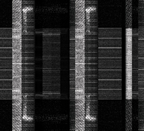
Happy New Ears (festival for New Music), Kortrijk (be)
notovo at Happy New Ears (festival for New Music), Kortrijk (be) :: The No2Pho/notovo research project: investigates the behaviour of language in its many appearances: textual, sonic and visual, as well as gestural or body language. How do these disparate elements relate to each other and how do they organize within a system which includes human and computer as a sender and a receiver [and vice versa].
The notovo-installation [article (PDF)]: as a generative sound installation NoToVo (noise to voice) plays with a connected set of elements. It is composed of dissonant synthetic voices, changing in real time from speech to sound. A physical network and a virtual network. People and voices. Wireless headphones and spatialized soundsources. People walk their traject through space. Their localisation and orientation is tracked. These data modulate the behaviour of realtime generated synthetic voices. As such, a conversation can be physically crossed and experienced according to the visitors' own position. Voices are layered and mixed by movements and trajects through space: the visitor becomes the performer.
No2Pho/notovo is developed by so-on (a collaboration between sukandar kartadinata, johannes taelman, edo paulus, billy bultheel and annemie maes). With the support of the VAF (Vlaams Audiovisueel Fonds).
http://so-on.be
http://okno.be/?id=954
http://happynewears.be
location: Happy New Ears festival, september 23rd --> oktober 8th
meetingpoint: busdascoop - kapucijnenstraat 10 - 8500 kortrijk
opening: saturday september 23rd from 2pm till 8.30pm
open: every monday, wednesday, friday and saturday from 2pm -> 8.30pm; sundays from 2pm -> 6pm
Posted by jo at 11:50 AM | Comments (0)
September 22, 2006
Heart Beats Dust by Jean Dupuy
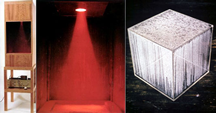
An E.A.T. Experiment
A colleague discussing research with me on friday told me of an early electronic / electrical work which clearly indicates the direction art would start to pursue over the next thirty years and fits nicely into my area of research. The work, mentioned in the publication Digital Currents by Margot Lovejoy, entitled Heart Beats Dust (above left and centre) by Jean Dupuy is a work I had never seen by an artist I had never heard of and strangely seems to be omitted from any other history of media art I am aware of (or the few conceptual art histories I have covered so far). It makes you wonder about who writes these histories and how they decide to include some works and not others.
Heart Beats Dust consists of:
a black rectangular box, a window at eye level opens onto a 24′ cube which houses the sculpture. The form is created by thrusting dust up into a cone of light. The dust is Lithol Rubine, a brilliant red pigment chosen for its ability to remain suspended in air for long periods. The thrust is achieved by amplified heart-beats from an attached stethoscope or a continuous loop tape recording of heartbeats played on a speaker mounted directly under a tightly stretched rubber membrane upon which the dust sits. (medienkunstnetz.de)
There is work reminiscent of Hearts Beats Dust particularly conceptual work such as Hans Haacke’s Condensation Cube (1963-65, above right) in that it too uses a basic medium (water) to show processes in action (condensation cycles) however nothing which cleverly brings technology and art, electronics and visualisation of the invisible together as cleverly.
Heart Beats Dust was the winning entry in a competition for collaborations between artists and engineers entitled E.A.T. (Experiments in Art and Technology) which also anticipated major initiates by organisations such as Xerox with their PAIR program and HP Labs with their Creative Residencies. [blogged by Garrett Lynch on Network Research]
Posted by jo at 05:04 PM | Comments (0)
September 18, 2006
Connecting Worlds

Creative Possibilities of the Networking Age
09.15-11.26.06 :: Connecting Worlds, the first exhibition after the renewal of NTT InterCommunication Center[ICC] focus on the "communication", with contributions exploring the creative possibilities that emerged out of the new environments of the networking age.
'As the first exhibition since the reopening of ICC, this show raises-from the horizons of art and programming-practical alternative possibilities of various phases of communication that we currently see around us. This exhibition features artwork and projects that take a unique step into contemporary networks, politics, economies, physiology, or urban environments by manipulating sound, games, the Internet, or other media as well as foreseeing artwork created in the past.' Yukiko Shikata, curator
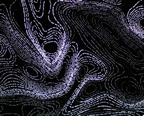
cyclone.soc by Gavin BAILY + Tom CORBY, UK 2005 :: CYCLONE.SOC brings together two contemporary phenomena: (1) severe weather, the project uses weather data that charts the emergence and progress of hurricanes; (2) the polarized nature of debate that occurs in certain online newsgroup forums. The project maps textual conversation taken from the political and religious newsgroups to the isobars of a dynamic, interactive weather visualization of hurricanes - whose complex structures are used to visualize the conversational churn and eddies of the newsgroup conversations.
In staging these interactions as a process of meteorological precipitation, newsgroup conversations "condense" in the works environment as a temporal ambient patterning - a structuring that acts not only as a metonym of difference, but of ideological tensions which mirror the dynamics of social space. CYCLONE.SOC is a navigable environment that gives the user the ability to zoom in or out and skate across and through the cyclonic weather formations in order to read or be immersed in the newsgroup text.
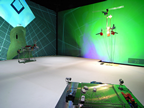
OBJECT B by exonemo, Japan 2006 :: OBJECT B 2006 Yamaguchi Center for Arts and Media (YCAM) YCAM InterLab Installation presenting a modified first-person 3-D shooting game with kinetic objects and a virtual-reality setting. Installed inside the three-dimensional environment created through projections onto all four walls of the exhibition space, are three objects made of keyboards, mice, and other computer parts and electric tools, and a control terminal for players. The robots' (programmed) frequent violent actions trigger automatic commands, according to which the game develops.
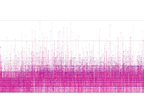
MaSS (Market as Speed Spectra) by MaSS Dev., Japan 2006 :: In e-trade, there are cases in which up to 1,000 "ticks" (contracts made when seller and buyer agree on a price are being counted per second?DThis work extracts log data of daytrade, where instantaneous decisions are being made based on numbers displayed on the computer monitor?Cand transforms the speed and rhythm of such transactions into sound and light. "MaSS" likens the steady high-speed exchange of data in e-banking to a worldwide network of reflex nerves.
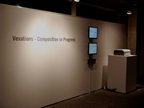
Vexations-c.i.p. (Composition in Progress) by MOHRI Yuko + MIHARA Soichiro, Japan 2005 :: "Vexations - c.i.p.(Composition in Progress)" 2006 transmediale 06, Berlin This work presents "Vexations", an odd piano piece of a single phrase repeated 840 times, originally composed by Erik Satie in the late 19th century, interpreted through an automatic, computer-controlled looping system. While incorporating modifications caused by data of environmental noises recorded with microphones at the venue, the software automatically generates new scores, based on which the piece gradually changes as the performance continues.
Artists include: ambientTV.NET (AT/IN/UK) / Wayne CLEMENTS (UK) / Robert DAVIS + Usman HAQUE (UK) / exonemo (JP) / Peter FISCHLI & David WEISS (CH) / Muntadas (UK/SP) / MaSS Dev. (JP) / MOHRI Yuko + MIHARA Soichirou (JP) / Newtype Technology Lab. (JP) / Dennis OPPENHEIM (UK) / Manuel SAIZ (UK/SP) / TANO Taiga (JP).
Posted by jo at 04:18 PM | Comments (0)
September 15, 2006
From dust till dawn
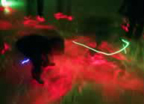
"robs the term tangible media of its intangibility"
Dust behaves unpredictably and is difficult to control. Besides that it is not especially popular, being regarded as "dirt" in our culture. As elusive as time seems to us it nevertheless leaves physical traces in the form of dust. The installation "From dust till dawn" made by Markus Decker and Dietmar Offenhuber kicks up a lot of dust and produces noise in the form of acoustic traces. The dust and atmosphere in the empty room form the installation’s interactive medium. Dust is identified by a surface laser and a photographic identification system and becomes a highly unusual means of interaction.
A grid of line lasers installed just above the floor produces a homogeneous carpet of light which is at first invisible. Objects and particles that pierce this carpet, such as dust, cigarette smoke or larger objects, become visible in the laser beams as a silhouette or an outline. The outlines and dust patterns are recorded and their two-dimensional movements converted to sound on an xy raster synthesizer. Every step the visitor makes, indeed his or her mere presence, sets the air moving and causes dust to swirl up. Its deals with a fragile interactive medium which is barely controllable and robs the term tangible media of its intangibility. [blogged by Ruairi on Interactive Architecture dot org]
Posted by jo at 01:10 PM | Comments (0)
September 14, 2006
Move by Andrew Hieronymi
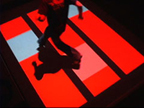
Performing Verbs
Move by Andrew Hieronymi is an interactive installation divided into six distinct modules. Each module offers single-user interaction based on a verb corresponding to the action the participant is invited to perform. JUMP, AVOID, CHASE, THROW, HIDE and COLLECT comprise the six modules.
The participant interacts with abstract shapes such as circles and rectangles. In the game of AVOID, the participant has to avoid getting his or her circle hit by a red particle. Whereas in the game of JUMP, the participant has to jump from platform to platform before they fade away.
Check out the videos of each of the six modules. Move was presented at this years Ars Electronica Festival. [blogged by Lene Mailund on Digital Experience]
Posted by jo at 09:16 AM | Comments (0)
Bridge, by Michael Cross

Walk on Water
“Bridge is a spectacular new site-specific design commission for Dilston Grove, London (Cafe Gallery Projects) by Michael Cross. Housed in a former church, (one of the earliest examples of poured concrete construction and a Grade II listed building), the piece comprises submerging two thirds of the inside of the church in water, and producing a series of steps which rise out of the apparently empty man-made ‘lake’ as you walk across them. Each step emerges one step in front of you and disappears back underneath behind you as you go. This ‘bridge’ is purely mechanical, the weight of the person on it depresses each step a little, this force activates a submerged mechanism which raises the next step.
The public are invited to walk out on it as if walking on water, eventually reaching the middle of the lake, thirty steps and twelve meters from the shore. There they will stand alone and detached, stranded in the middle of a plane of water until they choose to return the way they came. For some people this experience of being cut off and surrounded by water will be peaceful, for others terrifying. For some walking across the water will be pure childish joy, whilst others will be too scared to try”. (full text)
Fantastic! I am really looking forward to seeing this work and standing in the middle of water. I’ll post some photos and more detailed observations next week.
I saw products from Michael at the RCA show in 2004 (link), so its no surprise that this event is part of the London Design Festival, although the first time Cafe Gallery Projects have shown the work of a designer in the church. 20th Sep - 29th Oct at Dilston Grove, Southwark Park, London (location map). Opening preview this Sunday.
Bridge was commissioned and curated by Andrée Cooke. [blogged by Chris O' Shea on Pixelsumo]
Posted by jo at 09:02 AM | Comments (0)
September 11, 2006
LAb[au] + Frederik De Wilde
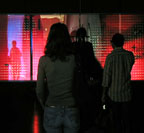
EOD02 + 12m4s
LAb[au] is pleased to invite you to the designers week exhibition presenting two installations: EOD02, a new-media installation in collaboration with Frederik De Wilde and 12m4s, an interactive audiovisual installation taking place at the auction-hall of the Palace of Fine Arts ( ...> ) in Brussels [ BE ] in the context of the exhibition Belgian designers of the 21st century, complied by Dirk Meylaerts and Marie Pok.
The exhibition includes works by: Alain Berteau, Bram Boo, Christophe Bourg, Damien Bihr, Benot Deneufbourg, Nathalie Dewez, Herman Wittockx, Hoet design, Dirk Meylaerts, Gauthier Poulain, Lucile Souflet, Sylvain Willenz , Tov Design, LAb[au] and [UR]Design.
12m4s :: The installation '12m4s' is an interactive audiovisual installation representing human flows by generating out of visitors' main parameters (position, orientation and speed) a visual (3d particles) and sonic (granular synthesis) dynamic scape in real-time. To achieve this result, the installation uses two different tracking techniques: firstly, image recognition is used to create spatial sounds (diffused through 8 speakers disposed along the 12m installation) and secondly, ultra-sound sensors are used to create visual echograms of the space (projected as background image along the 12m screen). These different tracked data influence a graphical vector-field
projected on the entire surface of the screen (foreground), where each of its vectors reacts to a visitor's movements while taking his/her orientation. Furthermore, graphical and sonic objects emerge at the point (location) where movement is recognized. Once created, these sonic and graphical elements start to move through the vector field, while trying to find their path.
For example: a visitor is passing by the installation, s/he is followed by a visual and sonic trace, but as soon as s/he changes direction or produces any other movements, s/he creates turbulences. According to this principle, the visitor can even more actively paint with his/her movements a sonic and visual space on the 12m surface, as it open ups to collective interaction.
The result, this 'particle synthesis' is projected on a 'Mylar' screen fusing projection and reflection while building a common space in between the digital and the body space.
EOD02 :: EOD 02 is a collaboration in between Frederik De Wilde and LAb[au]. The project is a new media installation founded on special species of fish that perceive, electro-sense, their environment and communicate with each other by emitting electric signals, either in pulses or waves. The project explores the normal communication mechanisms of electrical fish, including JAR (the means by which a fish avoids attempts by other fish to jam its frequency) and thus investigates communication and non-communication between individual fish as well as between fish and people.
The installation is based on four aquariums of taintless mirror, each presenting a specific composition of fish producing different electric signals. In each aquarium antennas allows capturing the fish signals which are directly related to four speakers transforming these signals into sound, what we hear is the fishs electric signals_ their communications. Further under each aquarium a light bulb is placed pulsing according to the intensity, rhythm, of the emitted signals of the blind fishes. In this manner the electrical impulses of the fishes drive sound and light, an entire audiovisual space.
Posted by jo at 03:43 PM | Comments (0)
REMOTE

You Bring the Secret Location to Life
REMOTE--by Chris Vecchio :: 9 September – 21 October 2006* :: Gallery Joe Bird Park
3rd and Arch Streets :: Philadelphia, PA :: * viewable 24-7 * best experienced at night * (but no sound after 10PM) :: INSTRUCTIONS: 1) Get up off of the couch 2) (but bring the remote control with you) 3) Go to the south west corner of 3rd and Arch 4) Use your remote to activate the park.
REMOTE is an interactive environmental installation containing a range of sound and visual effects. Installed in an outdoor space, the installation is activated, controlled, and navigated using a common household remote control which may be supplied by the viewer. The piece takes the form of an intervention in an outdoor space, along a street or in a small park. There’s an “insider” element to the installation since, when not activated, its location may not be immediately apparent to a passerby. Additionally, the viewer needs to know to bring a remote to the location to bring the secret to life.
At the installation site, pressing buttons on any (TV, DVD, VCR, audio, etc…) remote control triggers a myriad of responses ranging from subtle (bird calls or soft sounds emanating from hidden speakers, changes in the ambient lighting) to bombastic (more dramatic sound effects, explosions, strobe lights, or projected images). Each key press generates a unique combination of effects. Viewers may bring any remote control from home to activate the installation.
Central to my work is an interest in the expressive potential of electronic devices and in the potential for user interfaces to generate new modes of interaction. A set of social precedents now exists for interaction with electrical technology. When these precedents are followed but subverted or there is no clear immediate “functional” objective, a viewer’s expectations are challenged and an opportunity for reflection or commentary on the human-technology relationship is created. This project makes use of such ambiguity – juxtaposing the familiar with the unexpected – to encourage people to question their assumptions about technology and reflect upon their interaction with it.
The piece has a strong element of accessibility. People who may be intimidated by interactive work or by technology in general may be engaged because an everyday object is the agent of action. The experience of the installation is reminiscent of a coin-op arcade shooting gallery. Play and experimentation are encouraged as part of the experience. Participants can keep trying different units from their everyday collection because each remote interacts differently with the piece. This highlights the number and variety of remotes we use for everyday tasks, from the mundane to the complex.
Sound samples in this installation have been gathered from a wide range of sources including sound effect libraries, police scanners, popular music, short wave and CB radio, and by using peer-to-peer networks to search the internet for randomly (inadvertently?) shared audio files. The broad range of sources references the instrumental use of sound samples in music as well as common (mundane) technological interactions such as channel surfing or tuning across a radio band.
Finally, the installation presents the man-technology interface ironically. The couch potato is asked to get off of the sofa and experience art first hand, but still holding the ever-present remote. Issues related to the effects of technological mediation and the degree to which technology is an atrophying rather than an empowering force are raised.
Posted by jo at 01:38 PM | Comments (0)
September 08, 2006
DANCEPOD 2006

A Sculpture Composed of Simultaneous, Web-Connected Dance Parties
DANCEPOD 2006: On September 9th at 11pm in Portland, 12 am in Guadalajara, 2am in New York City, 3am in Mexico City and 7am in Berlin, dancepod will present an entirely new kind of sculpture. A sculpture composed of simultaneous, web-connected dance parties. The parties, coordinated and developed in conjunction with artists and presenters from each city, will utilize identical dancepod installations. The installations will become the core of a shared physical and virtual experience, supporting streaming video and music as well as live DJ’s, VJ’s, and surprising guest artists. Moving bodies of dancing participants will complete the sculpture.
As part of the Portland Institute of Contemporary Art's (PICA) Time-Based Art (TBA) Festival, in conjunction with PS122, Scene Downtown (Earl Dax), Harkness A/V (Nick Hallett), and technical directors Kraft + Purver, these 4 DANCEPOD sites will be linked by live video starting at 2:00 AM Eastern Standard Time.
NYC DANCEPOD features an eclectic array of New York artists. Join DJs Kevin Graves (Brite Bar) and Van Scott (Patricia Field's Party at element) and dance to visuals artists assembled by Nick Hallett and Harkness A/V, including Chika and Boris. Live performances by John Moran and Saori Tsukada, Sxip Shirey, and Glenn Marla.
Chez Bushwick will be hosting "The Changing of the Garde" starting at 8:00 PM on Saturday. Come early for DANCEPOD and enjoy performances by:
Wanjiru Kamuyu – Spiral
Jim Staley – Solo Trombone
Bruce Nauman - “Abstracting A Shoe (1966)” – Video Art
David Vaughan, Michael Cole, Jonah Bokaer – A John Cage Birthday Reading
Elke Rindfleisch - Untitled
Also... TECHNOPIA Interviews Carla Peterson, Newly-Appointed Artistic Director of DTW.
All this for $5. Come to both the Chez Bushwick and DANCEPOD events for just $10! That's like seeing the early show for FREE! (Regular DANCEPOD admission is $10).
Hosted By
3rd Ward Brooklyn
195 Morgan Ave.
Bushwick, Brooklyn, NY 11206
718.715.4961
www.3rdwardbrooklyn.org
Posted by jo at 05:46 PM | Comments (0)
September 06, 2006
Icelandic Rift, 2006 by Sabrina Raaf
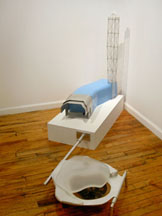
Agriculture in a Zero-G Environment
I was in part inspired to create this work by the landscapes that I explored in Iceland. There, I saw breathtakingly monumental glaciers which seemed to float atop fields smooth black lava rock. In other parts of the country, there were endless stains of acid green sulfur on the earth as well as steaming blue pools of heat-loving algae which defied one’s sense of “the natural”. The landscape in Iceland is famous for its lunar feel but its elements seemed to trump gravity and logic in ways that were utterly unexpected. I am also drawing inspiration for this work from the multi-tiered design of staged, hillside agricultural systems such as those seen in Asian rice terraces. Last, I am drawing inspiration from the soft design forms found in domed space observatories, water droplets, and BioSpheres.
Icelandic Rift is a series of structures assembled from industrial materials, stark yet organic forms, and automated systems. These sculptures come together in each work to form a modular system of organic architecture which plays on the viewer's senses of scale and gravity. The Icelandic Rift sculptures are electronically powered works that include mechanical systems which function to automate lights and fluids within the sculpture body. Materials in the series include aluminum, cast acrylic, eurothene, ferrofluid, and custom kinetics and electronics.
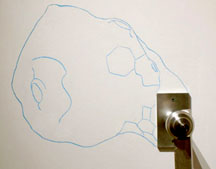
In all, the structures in the Icelandic Rift series represent a future vision of agriculture and growth in a zero-g environment. It is a composition of artificial islands supported and connected by steel and aluminum struts so that they can be assembled as part of a greater mechanical system that hovers above the floor. Together the architecture formed by these structures is designed to be perceived as both vaguely familiar and also austerely alien.
On the larger aluminum islands in the series sit smaller island forms cut from cast acrylic and/or aluminum. The island centers are hollowed out to function as reservoirs to hold Ferrofluid – a type of liquid magnet. This is a dense black liquid which spikes up when an earth magnet is placed in its proximity. Under some of these islands I have automated hard magnets and electromagnets that, in turn, automate the standing ferrofluid liquid in the reservoirs so that the liquid is made to spin, rise, twitch, or travel. These symbolize the energy sources for the systems. [Related posts 1, 2, 3]
Posted by jo at 06:42 PM | Comments (0)
August 28, 2006
Wifi Camera Obscura
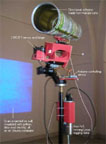
Photos of wifi Space
Today, we are increasingly creating and responding (sometimes in a very painful way) to non-visual electromagnetic fields: those emanating from our devices and environments. What might a camera obscura for our age look like? How might it reveal the relationship we have to our data environments?
Wifi Camera Obscura reveals the electromagnetic space of our devices and the shadows that we create within such spaces, in particular our wifi networks which are increasingly found throughout cities of the developed world. The data are scanned, analysed and translated into a luminous composition projected, line after line, on a wall. Different SSIDs are assigend different colors.
A collaboration between Usman Haque, Bengt Sjölén and Adam Somlai-Fischer. The work is currently exhibited at Waves in Riga until Sept 17, than a second version of it will be shown at Perimeters, Boundaries and Borders, Folly, in Lancaster, UK from Sept 29 to October 21. [blogged by Regine on WMMNA]
Posted by jo at 07:22 PM | Comments (0)
August 25, 2006
Dislocation

Environment of Deception and Uncertainty
Dislocation, by Alex Davies, attempts to create a mixed reality environment in which the virtual world inhabits the viewers' physical reality. The exhibition room is empty, apart from four small inset screens. Concealed from the visitors, a camera is embedded in the rear wall, and an array of eight speakers is mounted within the walls around the floor of the room.
Visitors need to approach the monitors closely to see what they are showing. After a moment they realise that what they see is their own back (recorded by the hidden camera), and those of the neighbours peering at the adjacent monitors. After a while, the screen flickers slightly, as if there is a minor disruption in transmission, and people -- pre-recorded and superimposed onto the live image -- enter the gallery, one can even hear their movements within the room. It is easy to mistake to pre-recorded images as people in the room with you at the same time.

Apparently, a significant proportion of gallery visitors do a "double take" at this moment, looking in the screens, turning around to clarify their reference of reality and then returning their gaze to the portals to verify what they think they perceived.
Other work by Alex Davies: drift, a sightseeing telescope allowing the viewer to elastically manipulate time and space. [blogged by Regine on we make money not art]
Posted by jo at 09:08 AM | Comments (0)
August 21, 2006
PLAY.Orchestra
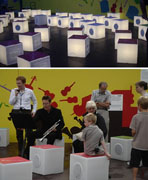
Sit and Play
If you go down to the South Bank in London this summer, outside the Royal Festival Hall is a wonderful installation titled PLAY.Orchestra. 56 plastic cubes and 3 Hotspots are laid out on a full size orchestra stage, each cube containing a light and speaker. Sit down on the cube or stand in the hotspot to turn on that instrument and bring 58 friends to hear the full piece. People with Bluetooth phones will be able to receive a ringtone of the piece created, as well as upload their own sound samples in September.
The production blog gives an interesting insight into the installing process & the complexity of the project. PLAY.orchestra is the result of a collaboration between Central Saint Martins College of Art & Design MA Creative Practice for Narrative Environments, South Bank Centre Education and the Philharmonia Orchestra.
Daniel Harris at Central Saint Martins was involved in the project from the beginning, details from his site:
"I was then responsible for the various human, computer and physical interfaces used in the build. 2 miles of cable are used to connect the 60 seats with the control system, which runs on a midi based Max MSP system.
The Objective was to get non-traditional audiences to experience an orchestra from new angles, and to involve themselves in activity of the philharmonia orchestra. For this purpose, a bluetooth system was set up, where members of the public can submit their own samples for composers to put together into a piece that will be played in the last few weeks of the installation."
IamtheMightyJungulator were also involved in the software side.
Photos stolen from Dan Harris Flickr Set.
(thanks for the tip Leslie, via BBC News) [posted by chris on Pixelsumo]
Posted by jo at 05:12 PM | Comments (0)
August 17, 2006
LOCUS SONUS
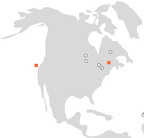
DUPLEX PERFORMANCE
THE THING invites your face and body and voice to 11 Harrison Street, ground floor storefront gallery, RIVERFAWN, for the Manhattan interface of THE THING.residency: LOCUS SONUS DUPLEX PERFORMANCE. This is a special performance that will be live from the Roebling Bridge on the Delaware River and from the RIVERFAWN Gallery in New York City. You will be part of the performance! :: 6pm –10pm Thursday August 24th :: 11 Harrison Street, ground floor* :: New York City.
Locus Sonus has constructed for this performance 2 IP webcams/parabolic microphones with which they can hunt for sounds in and around the venue streaming them simultaneously to the remote location. In each location laptop performers capture and remix the audio from the mic and video projectors show what the mobile microphones are capturing. Both mixes are played in both locations, the musicians responding to their remote counterparts. The Roebling Bridge will be set up on both sides of the river (the audience will be on the bridge). The idea being that we can use the local distance to reflect the remote distance. On the Manhattan side, the performance will take place in the RIVERFAWN Gallery where they will also use the wire/stream interface as an instrument to mix and control during the presentation. Live sounds from around the world (from the locusonus open web mics project) will also be used as raw material for the concerts.
Locus Sonus will be in residence between the 15th and the 29th of August in the USA with two installations and a duplex performance between them. The two locations will be at the DIGIT Festival, Delaware Valley Arts Alliance & Roebling Bridge Environmental Arts and at the RIVERFAWN Gallery in New York City.
DATES: The Installation at the Delaware Valley Arts Alliance opens on Saturday, August 19th and runs until August 25th. The performance Duplex Roebling Bridge/Manhattan will take place Thursday, August 24th at RIVERFAWN Gallery, 11 Harrison Street in New York City. There will also be a physical installation/interface on view from August 22nd to the 27th, 12-6pm at RIVERFAWN Gallery.
For more information: http://nujus.net/~locusonus/site/index_e.html
Audio streams: http://nujus.net/~locusonus/site/documentation/allstreams/index_e.html
ABOUT LOCUS SONUS
Locus Sonus is a research group specialized in audio art (École Supérieure d'Art d'Aix-en-Provence, École Nationale Supérieure d'Art de Nice Villa Arson). Our objective is to experiment and evaluate the innovative and transdisciplinary nature of audio art forms in a lab-type context. We are are also concerned with the communal, collective or multi-user aspects inherent to many emerging audio practices and which necessitate working as a group. Two main thematics define this research - audio in it's relation to space and networked audio systems. The "Lab" proposes a process combining practical artistic experimentation and critical evaluation in a group context. The Locus Sonus Lab is currently focusing on a process which revolves around the use of multiple audio streams. The streams which are basically open-mic continually upload chosen soundscapes or sound environments, as playable material. The way in which we work with other people to set up and maintain the streams is part of the methodology, indeed the technology provides the basis to construct a human network.
*Directions: by subway take 1 train to Franklin Street. Walk one block west on Franklin to Hudson and cross the street. Walk 1 block south to Harrison and turn right. 11 Harrison street is in the middle of the block on the south side of the street, By car: From uptown Take West Street to Vestry. Make a left on Vestry. Go two blocks make a right on Greenwich Street. Go two traffic lights , make a left on Harrison street. From downtown take West Street to Harrison street. Make a right on Harrison and go 1 block.
Posted by jo at 09:25 AM | Comments (0)
August 15, 2006
DataNature

Cohabitation Artifact
DataNature is a mult-site electronic artwork by Ben Hooker and Shona Kitchen who state: As artists we are inspired by people's (local residents', frequent travelers', airport employees'--and our own) love-hate relationship with airports, and with technology in general. DataNature is an attempt to capture and visually articulate this tumultuous relationship ... our emotional zigzagging between nostalgia for a simple life and cyberpunk fantasy for being connected to everything everywhere...
I encountered the nondescript kiosk in the Cesar Chavez Park at night and like the small crowd gathered, watched others for signs of what to do. We each pressed the button and received our dispensed boarding pass ticket, discussed how to best illuminate and position for the chest-height camera, once it was discovered that a passport-type photo was being taken and printed on the boarding pass. One woman pressed the button while setting off her camera flash, another held her key-chain flashlight close to the face of the next in line. We all compared our tickets as they contained different pictures and text, though all the passport photos came out black in the night light.
The dot matrix type printing proved too difficult to read in the low light of evening and other events nearby drew recipients away after they received their “souvenir”, as the artists called the passes.
The artists’ state on the reverse of the ticket: By presenting a remix of live data and archived information collected from the many people we have met during our time as artist-in-residence at SJC, we hope Datanature captures the spirit of the eclectic, yet deeply connected place that is this airport.
Now that the festival activities have subsided I’ve read the narrative of the artists’ experience included on the back of the ticket and puzzled together the disparate data fields on the front. I hope that others will do so as well because it provides insight into the artists process of discovery and synthesis so often invisible to the public which may take the art experience as a mere artifact or souvenir without reflecting on the creative process or deeper meanings.
Given the security alerts that rippled through airports as a result of the uncovered (supposed) terrorist plot last week in the UK, ISEA/ZeroOne attendees will no doubt be affected on their return flights. While they wait in the inspection lines they can read the details of their DataNature souvenir boarding pass and perhaps have a humanistic reminder of the many folks required to keep the airport operational, even if such operations include the seemingly misguided data-driven response actions in the name of terror. Hopefully there will be another DataNature souvenir holder with whom to compare passes, as the stories therein and the ensuing discussions with others are the strength of this piece.
Posted by michelle at 12:47 AM | Comments (0)
August 10, 2006
Silverfish Stream
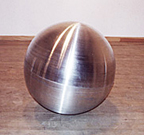
Awkward Pas de Deux
FILE FESTIVAL 2006 :: Venue: Galeria de Arte do SESI - Av. Paulista, 1313 :: Date: August 15 - September 3.
Silverfish Stream--by Constanza Silva--is a sensual, poetic exploration of the potentials of human-machine interaction. Communicating robotic spheres move through the gallery space, adjusting their behaviours in relation to each other; the result is an awkward "pas de deux" that both absorbs and excludes the viewer. Within this field of metal and fleshy bodies that adjust and readjust to each other, a complex sound environment emerges. Sonic vibrations from the machines are transformed and modulated by the movements of bodies within the multi-centric system. Viewers become part of the system in ways they can sense but not fully understand. This invites experimentation and reflection on the ways we relate to seemingly "intelligent" systems.
Constanza Silva was born in Bogotá, Colombia; she was raised in Canada and currently lives and works in Montréal, Quebec. Silva creates complex sound and robotic environments by setting minimal forms into motion within networked interactive systems. Evoking natural, technological and political ecologies, her work challenges the viewer’s sense of human-centredness and, at the same time, can elicit the most human of responses. Silva holds an MFA from Concordia University, Montreal.
Posted by jo at 07:04 PM | Comments (0)
Public Mood Ring

Collective Public Mood
Public Mood Ring by Will Pappenheimer :: ISEA2006 ZeroOne San Jose: A Global Festival of Art on the Edge & the Thirteenth International Symposium of Electronic Art :: AUGUST 7-13, 2006.
Public Mood Ring is an installation / network artwork--integrated into C4F3 Interactive Cafe at San Jose Museum of Art--designed by Milan-based design firm Syneo.is inspired by the common wearable "mood ring," which displays the emotional condition as color hue. At the request of remote and installation viewers, this project utilizes varying cultural color models, a search engine and data processing to find the color mood of a current public issue represented by Internet news. The color is then transferred to bays of colored ceiling lights. Viewers are immersed in “mood” lighting that is both a gift and representation of current public conditions.
The project is produced with the collaborative efforts of Oz Michaeli, computer Science Student at Pace University and Lighting Designer, Thom Huchinson. The website requires Adobe Flash Player 9.
Posted by jo at 05:13 PM | Comments (0)
August 07, 2006
The Travels of Mariko Horo

Being Mariko Horo
The Travels of Mariko Horo by Tamiko Thiel: Sometime between the 12th and the 22nd centuries Mariko HMrM, Mariko the Wanderer, journeys westward from Japan in search of the Buddhist Paradise floating in the Western Seas. She does find Paradise, but finds also a chilling, darker side to the West, an island where lost souls are held in an eternal Limbo. She encapsulates her impressions of the places she visits in a series of 3D virtual worlds and invites you to see the West through her eyes.
The Travels of Mariko is an interactive 3D virtual reality installation. The image is generated in real time on a fast gaming PC and projected on a large 9 x 12 screen to produce an immersive experience. Users move their viewpoint through the virtual environment with a joystick or similar navigational input device. Mariko is a fictitious character Thiel invented to incorporate the viewpoint for the project - users will never actually see Mariko, except perhaps in a mirror. In essence they will be Mariko, seeing the exotic and mysterious Occident through her eyes and experiences.
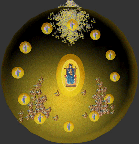
The virtual environment is sensitive to their presence, changing around them as a result of their movements and actions: An empty church fills with saints who vanish into the heavens. A basilica transports the user directly into the Western Cosmos, where angels sing the praises of the Goddess of Compassion. A pavilion takes users deep into the underwater realm of the Heavenly King. A plain wooden chapel leads into a Limbo of constant torment.
Music for Mariko Horo is embedded in the piece itself, localized to specific places within the 3D world. The composer Ping Jin, Professor of Music at SUNY/New Paltz, studied music both in his native China and in the USA. Ping describes the music as "creating a sonic dimension for Mariko's meditation on the mythic West. Created from both sampled and computer generated sounds, there are fusions and juxtapositions of Eastern and Western sounds to enhance the scene and mood of each section."
World premiere:
July 29 - November 26, 2006 :: "Edge Conditions" show, part of the Pacific Rim Theme of ISEA2006 Symposium/ZeroOne San Jose Festival at the San Jose Museum of Art, USA.
European premiere:
As the 2006 winner of the "Young Art/New Media" prize of the City of Munich, curated by Bettina Wagner-Bergelt and Dr. Stefan Urbaschek, "The Travels of Mariko Horo" will form an interactive 3D stage set for a specially commissioned Butoh dance performance by Shinichi Iova-Koga (www.inkboat.com) and Ishide Takuya during the Dance2006 Festival in Munich.
November 10-12, 2006 :: Dance2006 Festival of Contemporary Dance at i-camp / Neues Theater, Munich, Germany.
See also Mariko Horo's Logbook: This is a "preview" or "trailer" that Thamiko did as a brief narrative commentary on the much larger, non-linear VR installation. It was published in the June edition of the online art journal mark(s).
Posted by jo at 05:05 PM | Comments (0)
August 01, 2006
E-volver
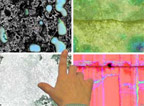
image-breeding-machine
E-volver is a software that invites an "image-breeding-machine" and a human "gardener" to collaborate together. While the machine has no notion of the aesthetic qualities of the evolved images, the human can barely understand what internal processes are taking place. It all begins with a an incoherent tangle of moving lines and points and colored planes, and on the basis of the user’s personal preferences, this gradually evolves into a more coherent image.
The software generates artificial ‘organisms’ measuring one pixel. Each ‘organism’ is made up of genes that determine how the organism will ‘behave’ on the monitor. The genes read the properties of the surrounding pixels and, based on what they find, tell the organism what to do and where to move next.
Each image is like a garden in which newly-cultivated plants are left to their own devices. The way images look is not only a result of the collective behavior of the organisms, but also the result of the users. By touching the screen, visitors can influence the visual patterns displayed on the monitors. They can deactivate one of the four pixel gardens. Voting out the least exciting images devalues those particular genes and upgrades the genes of the three surviving pixel gardens. In other words a group of organisms evolves that contains properties that generate the most pleasing collective image. That is, until the computer “resets’’, which happens when a predetermined number of votes has been cast. And then the whole process begins again.
E-volver monitors have been installed at the Leiden University Medical Center (NL). The work echoes the research that takes place in the LUMC. Whereas the scientists are mainly focused on biochemistry, genetics and the evolution of biological life, the installation shows how autonomous processes such as growth and evolution, which can maybe be understood theoretically but which are never directly perceptible in daily life, can be perceptible on a sensory level.
A work by Erwin Driessens & Maria Verstappen, of Tickle Salon the fame.
Via re-qualia. [blogged by Régine on we-make-money-not-art]
Posted by jo at 08:50 AM | Comments (0)
July 31, 2006
Oribotics
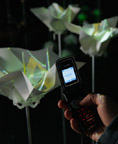
Folding and Unfolding on Command
Oribotics--by Matthew Gardiner--is the fusion of origami and technology, specifically 'bot' technology, such as robots, or intelligent computer agents known as bots. The system was designed to create an intimate connection between the audience and the bots; a cross between gardening, messaging a friend, and commanding a robot. It was developed during an Australian Network for Artists and Technology (ANAT) artists lab; achieved with Processing as an authoring tool, and connected a mobile phone via a USB cable.
"Ori-botics is a joining of two complex fields of study. Ori comes from the Japanese verb Oru literally meaning 'to fold'. Origami the Japanese word for paper folding, comes from the same root. Oribotics is origami that is controlled by robot technology; paper that will fold and unfold on command.
An Oribot by definition is a folding bot. By this definition, anything that uses robotics/botics and folding together is an oribot. This includes some industrial applications already in existance, such as Miura's folds taken to space, and also includes my two latest works. Orimattic, and Oribotics." [via textually.org]
Posted by jo at 06:10 PM | Comments (0)
July 26, 2006
Dark Source
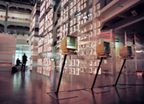
Exposing Democracy Owners
One of the most senseless use of technology is electronic voting. With no advantages except from the speed (real time) county of votes, this 'innovation' is simply an enormous swindle. In fact the votes are stored as files, so infinitely more falsifiable than the one written on the traditional paper, and the worst is that the whole process is managed by proprietary software, so with unstable and unintelligible methods. Part of the Weibel-Latour ZKM's Making Things Public exhibition, Dark Source by Ben Rubin makes this paradox even more evident. It consists of a representation of the Diebold AccuVote-TS touch-screen voting terminals, recently adopted in many U.S. states. It's a printout of some of the 49,609 lines of C++ source code (other pages are available through some microfiche terminals), with all the same code blacked out, because of the trade secret the company claimed as a property on its intellectual product.
This is a stunning representation of an absurdity: the act of gifting the employees of a trade secret defending company the right to manage and frame the most important democratic process. Then the question is: there's any election procedure that can be kept secret or privately owned? Not really. But unfortunately this is an ongoing experiment going on in many countries, perhaps a testbed to take over the paper/pencil scheme sometime in the future. Technology is not for everything, and this kind of techno-positivism dreams can generate scaring nightmares. [posted on Neural]
Posted by jo at 09:20 AM | Comments (0)
July 25, 2006
BioHome: The Chromosome Knitting Project
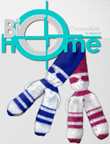
Blurring the Lines Between Home and Laboratory
BioHome: The Chromosome Knitting Project :: A performance/installation featuring live biotechnologies :: Performance by Catherine Fargher, with live sound mix by Terumi Narushima.
BioHome presents a new form of hybrid performance, incorporating live biotechnology in an interactive installation. It also features video, interactive sound using DNA sonification, live DNA knitting and live performance and text. The live 'wet biology' practices, namely knitting DNA and displaying live cell cultures on stage, will be used to explore reproductive futures and bio-technologies.
Opening: August 16, 2006 5.00 p.m. by Natasha Mitchell, ABC Radio National Science Unit. Performance: 5.30 p.m. August 17th, 2006: Performance 5.30 p.m. Installation hours: August 16 - 25, 9-5 p.m. The artist/performer will be in attendance to maintain live cells at select times during the duration the installation. 'we assume all products are hazardous'.
FCA Gallery, Room 112, Building 25, Faculty of Creative Arts, University of Wollongong, Northfields Avenue, North Wollongong. Light refreshments available.
Credits:
:: Writer, performer, devisor - Catherine Fargher
:: Direction and corporeal dramaturgy: Nikki Heywood,
:: Textual dramaturgy, Noelle Janascewska, Nikki Haywood, Merlinda Bobis.
:: Visual dramaturgy: Brogan Bunt, Virginia Hilyard.
:: Knitted elements: Pamela Drysdale,
:: Plasma Screen performers: Terumi Narushima, Catherine Fargher, Denise Cepeda.
:: Interactive sound creation: Terumi Narushima.
Catherine Fargher
writer/editor/doctoral candidate University of Wollongong
PO Box 178
St Pauls NSW 2031
ph/fax: (02) 93145121
mob: 0415 442 209
email:iristorm[at]ozemail.com.au
Posted by jo at 09:45 AM | Comments (0)
July 19, 2006
Intimacy and In.yer.face
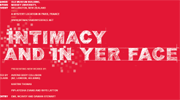
Blurring Online and Physical Performative Space
Intimacy and In.yer.face (July 20th, 8 p.m. (NZ time)) is a live performance / installation event and remix project, featuring an interdisciplinary selection of local and international artists, operating in the nexus between art and technology. Our conception of site is fragmented when agents participate from spatially dispersed locations, and when the boundaries between online and physical performative space are blurred. Intimacy and In.yer.face explores this fragmentation, the endless and cyclical encoding and decoding of information that occurs in the interface between humans and machines.
Curated by Daniel Agnihotri-Clark, Intimacy and In.yer.face commences with a one-night event featuring simultaneous live performances and interactive installations, linked by real-time streaming of audio and video signals which will be broadcast over the internet. The event will feature new works by the globally dispersed cyberformance troupe Avatar Body Collision (New Zealand, London, Helsinki), the interdisciplinary artist Kartini Thomas (Wellington), aerialists / actors Pipi-Ayesha Evans and Rhys Latton (Wellington), and audio / video artists Emil McAvoy and Damian Stewart (Wellington).
The performance/installation event will take place on July 20th in the former Dominion Museum Building, Wellington (8 p.m. NZ time), at a mystery location in Paris (10 a.m. FR time), and everywhere else via http://www.intimacyandinyerface.net. Intimacy and In.yer.face is truly a simultaneously local and global event, pushing the understandings of site and indeterminate modes of performance practice in the interface with technology. Intimacy and In.Yer.Face follows last year's Indeterminacy and Interface - the first of performance event curated by Daniel. These projects form a significant component of his on-going doctoral research at the Massey University School of Fine Arts.
Following the performance / installation event, an open call for remix will expand the role of the audience, facilitating active participation and dialogue. Audio and video files will be available for download from the website. This remixed material will then be collated into a limited edition DVD release.
For full information about the project and the artists involved please see
http://www.intimacyandinyerface.net
Intimacy and In.yer.face
July 20th, 8 p.m. (NZ time)
Old Museum Building, Buckle St, Wellington, New Zealand
and Mystery Location, Paris
and http://www.intimacyandinyerface.net
Online Soiree
http://www.intimacyandinyerface.net
10 a.m. - 12 noon NZ time/ 10 p.m. - 12 a.m. FR time
Artist/Curator talk
School of Fine Arts seminar room, Block 2, Level C, via Gate C, Wallace St.
12.15 p.m.
For further information, images or to arrange an interview with the participants please contact: Louise Menzies, on tel: 04 801 2794 x6197, email: L.C.Menzies[at]massey.ac.nz. or Aaron Kreilser on tel: 04 8012794 x6341, email: A.P.Kreisler[at]massey.ac.nz.
Posted by jo at 02:33 PM | Comments (0)
July 10, 2006
Chasing Pools and Sampling Ghats

HIDRAZONE ISSUE 002 X 2
Chasing the Pools is an immersive performance/installation working with integra-ting the live presence of dancers into the landscape of a multi-channel live-mix video installation. Often the two present very different viewing circumstances that remain independent of one another.
Through live-feed cameras the movement of dancers was mixed into the alpha channel of 3 video mixes. Their lit bodies became one moving image, dematerializing or re-materializing the body, while the background remained another. The dancers were able to monitor how they were affecting the composited image, essentially dancing with the image.
These channels were projected onto numerous scrims in a large tree grove. Twelve channels of sound by live musicians were mixed and spatialized throughout the site. The architecture of a tree grove naturally imposed a de-centralized structure upon the viewer where one’s experience was shaped by the act of meandering through, never being allowed a view of the whole.

Samples of the Ghats is a responsive installation that invites the audience to explore the ghats of Haridwar, India by composing themselves its audio-visual atmosphere.
A 5 metre long structure featuring a panorama of the ancient and holy city of Haridwar framed with technology is a stimulus to curiosity, an appeal to exploration. Cruising along the panel visitors soon discover that they can "play it." With the simple move of his hands he launches media sequences. They are audio and visual samples, pieces of Haridwar, collected and edited in a way to generate an atmospheric feel of the ghats.
In a collective experience, the panorama comes to life and the adventure begins.
More Hidrazone Issue 002: Performativity
Posted by jo at 07:26 PM | Comments (0)
July 07, 2006
INTIMATE TRANSACTIONS

Sensing Place Through a Complex Web of Relations
Presented by the Brisbane Festival 2006, and Centre Of Contemporary Art, Cairns and conceived and developed by Transmute Collective, Intimate Transactions is a new type of interactive installation that allows two people, located in geographically separate spaces, to interact simultaneously using only their bodies. As this highly immersive experience evolves through digital image, sound and tactile feedback, each person begins to sense their place in a complex web of relations that connects them and everything else within the work.
VENUES: The Block, QUT Creative Industries Precinct, Musk Ave, kelvin Grove & Centre of Contemporary Arts Cairns. DATE & TIME: Sat 15 - Sat 22 Jul; 11am - 2pm & 3pm - 6pm daily; Individual sessions every half hour. DURATION: 30 minutes per session. TICKETS: FREE event. BOOKINGS: Brisbane: 07 3864 5495; Cairns: 07 4050 9493.
Intimate Transactions has been shown extensively in Europe and Australia. It was awarded an Honorary Mention in the Prix Ars Electronica Interactive Arts category, 2005.
Transmute Collective are Keith Armstrong (Director), Lisa O’Neill and Guy Webster, and numerous key collaborators.
Posted by jo at 01:15 PM | Comments (0)
July 05, 2006
RainDance + A Light Rain
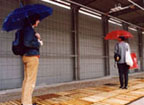
Water Music
RainDance is an interactive sound installation by electronic media artist Paul DeMarinis. The installation uses water to create non-water sounds. Jets of water modulated with audio signals carry sound vibrations that are inaudible to the human ear. The sounds cannot be heard until the water jet is intercepted by a large umbrella. The sound is then decoded and resonated from the surface of the umbrella. The umbrella thereby turns into a new and different kind of loudspeaker.
Diverse electronic and acoustic material is modulated onto the streams so that people strolling along under the water jets can listen to, mix, modify and sequence a variety of sonic material, ranging from musical standards to rhythmic and electronic music.
The installation was exhibited at the Ars Electronica festival in 2001.

Also check out the related work by Paul DeMarinis, A Light Rain, in collaboration with Rebecca Cummins. In A Light Rain participants carry the umbrella into a rainbow created by streams of water. Music can then be heard as the umbrella meets these streams of water.
Check out the video of RainDance. [blogged by Lene Mailund on Digital Experience]
Posted by jo at 08:47 AM | Comments (0)
July 03, 2006
Digital Art Weeks 2006
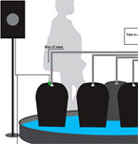
Symposium + Installations
Digital Art Weeks :: Symposium :: Artworks including:
The Waterbell Project--by Etsuko Maesaki--is a sound installation based on the Japanese 'Suikinkutsu'. Suikinkutsu ("Water Harp") is a unique feature of Japanese gardens. It consists of a large earthen jar with a hole in the bottom. This jar is buried upside down into the ground next to a water basin. When the waterdrops seep from above into the jar, they make a sound somewhat similar to what you would hear in an underground cave. The Waterbell Project consists of five vessels standing in a basin. A tube directs drops of water to the top of each of these vessels. When they drip into the water inside the vessels a sound can be heard. The frequency of the drops and the amount of water in the basin is controlled by a computer. At the same time this computer gathers realtime data from the internet: The price of oil in Japan and the temperature of the ocean. The frequency of the waterdrops dripping into the vessels corresponds with the temperature of the ocean, the water in the basin raises and drops with the price of oil, hence changing the quality of the sound made by the drops.
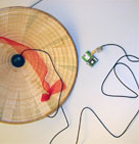
CHINA GATES by Art Clay, Dennis Majoe, & The China Gates Workshop-Ensemble: The early experiments of Charles Ives's father with marching bands crossing at intersections and his son's adoption of it, proves that interest in exploring mobility has fascinated even before electronic devices. As with Ive's marching band polytonality, we also have the opportunity using modern technologies from the Walkman to the Wearable not only interact with local surroundings like Ives, but for the first time also on a world wide level. Global networking systems such as GPS amoungst others have created a ubiquitous environments in which we can now make art in. China Gates is a work for GPS Wrist conductors and tuned gongs for an ensemble. The work addresses the concept of audience in public space through the possibilities of the GPS Wrist Conductor and an acoustic concept of music making in public space. Anyone interested in joining the workshop is welcome. It is open free of charge to those interested. The performance will be held regardless of whether conditions at Platzspitz and will be performed by a group of artists and musicians who took part in the DAW06 Mobile Music Workshop.
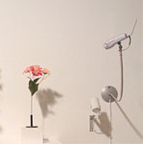
Motion Still Life 1--by Will Pappenheimer--extends the artistic tradition of the picturesque and spatial object arrangement into the domain of the Internet. A live Web camera frames a physical still life scene with vase, flowers and still life objects. Through its counterpart website, aesthetic controls allow internet viewers from anywhere to adjust the composition telematically in the distant space of the gallery. The Internet user is the surrogate artist. The time and space of the scene is ever-changing and accessible for the moment that becomes the still life. Exhibition visitors are able to see virtual participants configuring the still life through object movement, blinking LEDs connected with online activity, and multi-colored lighting for night time or alternative illumination. The mechanism is constructed from a self-contained network pan and tilt surveillance camera which has been disassembled and reconfigured for a more friendly gesture.
Posted by jo at 04:53 PM | Comments (0)
The Invisible Hand Machine
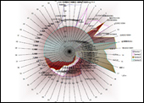
Free Market Harmony Through Excel
According to the Adam Smith free market theory, self-interests and economic processes find a harmonization, as if an invisibile hand guided them, beyond any specific intentions. Selfishness and competition are the motors of the individuals that, although they just pursue their profit, catch up the unexpected goal of common welfare. The project The Invisibile Hand Machine, presented at the Readme100, by Renate Weiser and Julian Rohrhuber re-explores in an ironic way the smithian theory, through a software that takes advantage of the Excel graphical instruments, in order to visualize the resulting economic equilibrium harmony.
Taking the data from the calculation sheet, the software models a 'market' with a circular shape, generating at the same time music and producing therefore an easy association between the circle perfection and the musical harmony. The individuals correspond to sounds, while personal interest and competition constitute the effort to reach a note that, according to the historical period, represents the market equilibrium. The winners who can reach this note distinguish themselves as lead singers in a choir, while those incapable of a similar amplitude adapt themselves to frequencies constituting the music background. But the various notes all together compose a charming tune, metaphor of 'the excellence of balance'.
Ironically the authors end their theoretical paper stating that maybe after having outlived this mental model, we can get rid of it. In fact the theory behind the project asserts that the economic models influence the processes and not the opposite. The schemes through which people read the world and the harmony of the systems, remind Dante Alighieri and the sound of the celestial spheres, as well as the human desire of perfection. But who has not yet dismissed the Dantesque model? -- Valentina Culatti, NEURAL.
Posted by jo at 01:04 PM | Comments (0)
June 30, 2006
Suite Soil Digital Media

Two New Commissioned Audio Works
Concert, June 30, 2006, 8:00 p.m.: A live stream of the June 30th concert is available at this link under SPIKED.
Guy van Belle (Bratislava): "slashtops": The concert program "slashtops" consists of real time manipulations with sound transforming light to sound and sound to light in three parts to investigate the relationship between sound and image, audio art and the visual, a persistent tension in the arts for generations. The first part of the program is a trilogy of arrangements between synthetic and real sounds the source material and inspiration based on recordings made in Quebec based on the movement of the artbots that comprise 'thoughts go by air'. A second source of audio content comes from Munich based on sounds from the city environment and a third from Bratislava, around Zlaty Piesky (an industrial - recreational - commercial area). The second component of the program is based on a translation of light into sound using the computer as an instrument. The third part of the program is a concert version of the installation TICS, which is a translation of light into sound and back to light, with a score based on the novel 'istanbul' by the Turkish writer Orhan Pamuk (2006).
Biography: Guy Van Belle (working and living on the road and in Bratislava) has been prominently involved in the use and development of media for artistic purposes since 1990. Since 2000 xgz has been working under the name of the collective digital band mxHz.org (machine cent'red humanz), creating collaborative performances, concerts, workshops, exhibitions and unexpected experimental/abstract art projects. MxHz.org is co-organizer of the umbrella organisation okno, a non-profit technological art organisation situated in Brussels.
MxHz.org are currently developing 2 sets of autonomously communicating heliumbots. The title of the project is "thoughts go by air". Performances were set up in Brussels, Den Hague, and New York. The current new generation is being developed in Brussels (http://okno.be) and Berlin. A special focus for mxHz.org is on Balkan/Central/Eastern Europa to work towards a new sustainable kind of collaborative projects. A recent ongoing work - 2WR or two-way-radios - is a net-remake of John Cage's Imaginary Landscapes #4 (for 12 radios and 24 performers) based on some historical texts by innovative radio artists. The project started in Prague during the FM@dia conference 2004 and was recently set up as a networked installation at Skolska Prague. With Akihiro Kubota he started the Society of Algorithm in 2001, working on netbased music performances. They participate in festivals and connected concerts. Since 2005 open workshops were added and a residency exchange between Europe and Japan to expand the concept. Recently, they contributed to the Berlin Sonambiente Exhibition.
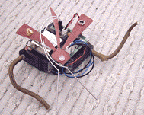
June 30 - July 29, 2006 - Installation: Peter Courtemanche's (Vancouver): "Preying Insect Robots", Opening reception Friday, June 30. Work created for the commission series, "Living with artificial beings" for Soil Digital Media Suite. Preying Insect Robots c. 2006 by Absolute Value of Noise.
Preying Insect Robots is a set of autonomous creatures that move about and communicate using a wireless Internet connection. These robots are modeled after an imaginary jade-green preying mantis - a mechanical creature that is described in the "Martian Chronicles" (by Ray Bradbury). The robots are adaptable to both indoor and outdoor environments - galleries, sidewalks, parks, and performance spaces. They engage in solo and choreographed group activities. The sound of their motors, motion and engagement creates an eerie soundtrack. The piece has a number of manifestations including an installation, a public intervention (performance), a web-presence, and an audio CD based on the sounds of the robots. As the robots wander, they transmit poetry to the Internet - creating montages of found text from a number of science fiction stories, including Feersum Endjinn (1994) and Excession (1996) by Iain M. Banks; The Martian Chronicles (1946 - 1958) by Ray Bradbury; Autofac (1955), Do Androids Dream of Electric Sheep (1968), and The Electric Ant by Philip K. Dick; Mortal Engines (1972 - 1976) by Stanislaw Lem; and For a Breath I Tarry (1966) by Roger Zelazny.
To hear the poetry created by the preying insect bots, go to this link;
http://www.soilmedia.org/preying/
Biography: Peter Courtemanche is a contemporary sound and installation artist from Vancouver. He is the Director and Curator of the Western Front's Media Arts Program - which supports the production and dissemination of experimental audio and electronic art. He has worked extensively in radio-art and electronic/interactive interventions. His art works often have a literary basis - inspired by narrative texts and the history of specific installation sites. As a curator, collaborator and producer he has worked with many established and emerging artists in the production and installation of video, audio, and computer/electronic based art.
Events take place at Neutral Ground
1856 Scarth Street, Regina, Saskatchewan
Curated by Brenda Cleniuk
For funding support, we thank the Canada Council for the Arts, the Saskatchewan Arts Board, Sask Lotteries Trust, the City of Regina and the Department of Canadian Heritage
Posted by jo at 04:42 PM | Comments (0)
June 29, 2006
art.ficial emotion 3.0
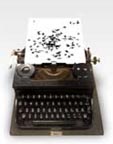
Life Writer
Life Writer, by Christa Sommerer and Laurent Mignonneau, consits of an old-style type writer that evokes the area of analogue text processing. A normal piece of paper is used as projection screen and the position of the projection is always matched with the position of the type writer roll. When users type text, the resulting letters appear as projected characters on the normal paper. When they push the carriage return, the letters on screen turn into small black and white artificial life creatures that appear to float on the paper of the type writer itself.
The creatures are based on genetic algorithms -- developed for Life Spacies [2] -- where text is used as the genetic code that determines the behaviour and movements of the creatures.
The artificial creatures can be faster or slower depending on their genetic code and body shape. The creatures need to eat text in order to stay alive and when users type a new text they try to snap up these characters from the paper in order to get energy. Once they have eaten enough text they can also reproduce and have off-spring so eventually the screen can become full.
The user can also push the creatures around when using the scroll of the typing machines cylinder: pushing the creatures back into the machine which will crush them or scroll the creatures off the screen alltogether, making new place for new creatures.
By connecting the act of typing to the act of creation of life, Life Writer deals with the idea of creating an open-ended artwork where user-creature and creature-creature interaction become essential to the creation of digital life and where an emergent systems of life-like art emerges on the boundaries between analog and digital worlds.
Life Writer is part of art.ficial emotion 3.0 ... [blogged by Régine on we-make-money-not-art]
Posted by jo at 02:00 PM | Comments (0)
June 28, 2006
TRG [Transreality Generators]
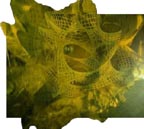
The 'Irreal' in New Media Art
TRG [Transreality Generators]--by FoAM--is a project that builds upon the two previous immersive installations / responsive environments: TGarden and txOom. All three projects are concerned with the 'irreal' in new media art. By 'irreal' we mean artworks that provoke a tension or imbalance between tangible reality and the imaginary worlds. With responsive environments, the line between the real and the imaginary can be very thin, allowing for the experience to become 'irreal' - where the participants fade in and out of physical reality, uncertain of their position in this 'reality continuum'. TGarden was designed to allow human gestures to use video and audio as calligraphic media, to 'write and draw' the immersive environment on the fly. txOom extended the concept and became an 'irreal ecology' where media would grow based on their interaction with the participants. TRG changes scale once more, to infinitely large and infinitely small 'irreal universes', whose existence is highly unstable and unpredictable, where minuscule local interactions can conjure up the lives massive worlds.
The conceptual framework within which the artists develop their concepts and designs is 'simulation of physics and physicality of simulation'. In order to be able to 'mix' the physical and the virtual reality in interesting ways, the artists explore the basic principles that constitute our universe (gravity, electromagnetism, nuclear forces) and create media worlds as new universes, where physical laws become amplified, distorted, enlarged etc. To the audience immersed in the MR environment, these worlds should 'feel' as familiar and intuitive, but upon closer inspection their strange and magical properties can become apparent. The TRG team creates rich media worlds consisting of materials, objects, interfaces and architectures that allow a seamless transition between the physical reality and the computational worlds. By correlating some of the more interesting properties in the physical systems (such as fundamental physical forces, string theory and membrane physics, tensegrity principles, etc.), and abstracting them, there is the potential to create new (coherent) laws within the media-worlds.
The project focuses on Mixed Reality (environments containing significant virtual and physical interaction possibilities, strongly intertwined) and exploring its implications in the cultural sphere. Mixed Reality (MR) enables the public to be immersed in multisensory, responsive media environments capable of reacting and evolving, influenced by human activity and interaction. The participants leave the role of the observers and become creators of a temporary autonomous reality. In TRG, an international team of artists and technologists explore the frontiers of this unique form of creative expression through the integration of self-contained systems of media, materials and structures, perceived as a distinct field of reality, embedded in the physical objects and architecture. This project examines the potential to extend their artistic practice into the field of situational experience design, in which the art-works become all-encompassing art-worlds. [Related]
Posted by jo at 06:28 PM | Comments (0)
June 27, 2006
Installations at Eyebeam
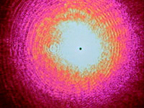
Modern Orthodox + EarthSpeaker
June 29 through July 15 Eyebeam is pleased to present three new installations developed in our studios exploring innovative uses of sound and light, both visible and undetectable, to fix and define spatial environments.
Elliott Malkin's Modern Orthodox is a working demonstration of a next-generation eruv installed on 21st Street in front of Eyebeam in New York City. An eruv (pronounced ey-roov [related]) is a symbolic boundary erected around religious Jewish communities throughout the world. While an eruv is typically constructed with poles and wires, Modern Orthodox employs a combination of low-power lasers, wifi surveillance cameras and graffiti, as a way of designating sacred volumes of space in urban areas.
The eruv is an ancient architectural construct that stems from the observation of the Sabbath, the sacred day of rest that includes a prohibition against certain kinds of work, including the carrying of objects outside of one's home, or private domain.
The presence of an eruv allows some carrying on the Sabbath by symbolically converting the shared public space within its boundaries into the shared private space of a community. In this way, observant Jews can carry objects such as keys or prayer books while acting in accordance with sacred Talmudic principles.
Because the physical integrity of an eruv is essential to its symbolic function, a breach in any portion of it renders it useless, which is why the entire circumference of an eruv, usually miles in length, is customarily inspected prior to every Sabbath. Malkin's laser eruv, however, which relies on a continuous stream of photons rather than cords and wires, is not as susceptible to permanent breakage. A branch of a tree, for example, may impede the flow of photons but will not permanently damage the eruv apparatus. In this way, the laser eruv is self-healing. Malkin also uses surveillance cameras to monitor the laser eruv connections from a remote location, allowing eruv managers to identify obstructions more efficiently. The content of these video transmissions are displayed at Eyebeam as part of the installation of this work.
Elliott Malkin is a new media artist whose work explores the use of everyday objects invested with the power to "sanctify" space. His most recent work, Modern Orthodox, focuses on the eruv, a symbolic boundary used as part of the observation of the Jewish Sabbath. Elliott's other work includes eRuv, a virtual reconstruction of an eruv that once existed on the Lower East Side of Manhattan – and Crucifix NG, a next-generation crucifix that broadcasts a radio frequency version of The Lord's Prayer. Elliott is also investigating the way religion and technology combine to inform the construction of memorial sites. Elliott is originally from Chicago and lives in New York City. He also works as an Information Architect.
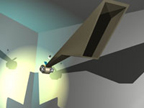
Jeff Feddersen's EarthSpeaker is series of large-scale autonomous, solar-powered sculptures. Drawing their inspiration from dusk-active creatures like crickets, bullfrogs and fireflies, they are designed to absorb and store solar energy during the day and retransmit the energy as acoustic sound for a brief period at dusk. As the sun sets, the system will create a short, distributed chorus of sound until the energy stored for the day is consumed. EarthSpeaker was commissioned as a permanent installation at free103point9's Wave Farm in Acra, NY where it will be transported to after exhibiting at Eyebeam. The challenge of creating a long-term installation, in a harsh environment, using available ambient energy pushed Fedderson's exploration of energy storage, alternative speaker functions and artistic design.
Jeff Feddersen is an artist, musician, and engineer interested in new musical instruments and sustainable energy. He has developed several new means of musical expression, including robotic sonic sculptures, real-time composition software, multi-modal digital input devices, and amplified acoustic instruments. He has exhibited and performed at the Chelsea Art Museum, the Apple Soho Store, and UC Irvine's Beall Media Arts Center, and the Lincoln Center. He has taught electronics, sustainable energy, and digital audio at NYU’s Interactive Telecommunications Program, where he was also a Resident Researcher, and has worked for the Technology Development group of Honeybee Robotics.
Posted by jo at 10:49 AM | Comments (0)
BEIJING ACCELERATOR 2006
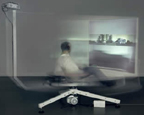
Physical Effects of a Tempo-Driven Society
Beijing Accelerator--by MARNIX DE NIJS--was created after being inspired by a recent visit to Beijing, and the realization of how quickly the dynamics of a city could transform into such apparent modernism. Although similar to an earlier prototype, Panoramic Accelerator, in that it also explores the effects of a tempo-driven society on the individual, this new version has an enhanced cinematographic experience as well as a superior interface.
The basic working principle is naturally akin to the original model; the participant takes position in a racing-chair on a motorized structure equipped with a joystick. This time however, a 160x120 cm screen is positioned in front of the user and while they control both the direction and speed of the chair, rotating panoramic images are projected on the screen before them. The aim is to synchronize the moving image with the rotation of the chair. Once this is achieved, the participant is able to view the images properly and the disorientation associated with the uncoordinated spinning is blocked.
Specific to the Beijing Accelerator, the target square in the top panoramic image needs to be matched with the same position shown on the magnified image below. As soon as this is achieved the images “snap into place” and consequently rotate in sync with the participants movement. After a short period of time however, a new rotating-panorama appears with a higher preset speed. This is determined as the next level and is more difficult to obtain the aforementioned balance in order to cohesively recognize the picture. In total, about 6 levels need to be accomplished for completion of the experience. Movie [via WMMNA]
Posted by jo at 10:12 AM | Comments (0)
June 24, 2006
Nathaniel Stern: Creative Commons Artist in Residence
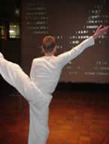
Shares [odys]elicit Under CC/GPL
Friday 23 June 2006, live from the iCommons iSummit:
[odys] elicit - a full-body, interactive art installation circa 2001 - is now available under a Creative Commons By Attribution Non-Commercial Share-Alike license, and the source code is available under GPL. It works with almost any standard webcam (requiring a few drivers on PC)!
[odys]elicit is a large scale, interactive installation where every movement of the viewer, small or sweeping, births stuttering text onscreen. The viewer’s motion elicits, character by character, passages from odys’ text. The piece responds to small movements, writing the text onscreen slowly for the viewer to read, or to rapid passersby, whose full bodies birth hundreds of flying characters, impossible to decode.
In odys’ work, viewers are forced to look at the spaces between language and meaning, the luxuries of stuttering and silence as communication, and the effects of accelerated and decelerated time. [odys]elicit physically places viewers at the center of co-invented noise, forced to perform - willingly or not. odys’ text has been reduced down to where it no longer has meaning and is re-birthed, with possibly infinite meanings, or none at all.
Click here to see videos of the piece in action.
Downloading:
Please first check out the read_me file - the PC application requires some extra (free) installs, and you can very easily change video settings or sources, input new text, toggle between birthing letters or full words, adjust the motion tracking tolerance levels given different lighting, or change the direction the text will go on the fly! Send me error messages if you encounter any bugs, or have much success! I am yet to fully test the OS 9 or PC versions. Oh, and about any parties or exhibitions that this thing is a hit at, too ;)
read_me.rtf
OS X Application
OS 9 Application
PC Application (still testing)
Source Code (in Director/Lingo + TTC-Pro; demo versions of these will work)
@ Rio iSummit [posted by nathaniel on nathanielstern.com]
Posted by jo at 10:38 AM | Comments (0)
June 13, 2006
Home Entertainment

where old technologies go to die
The network is great, but if you're in Paris, June, 12-17, you get ice cream!
Home Entertainment is an installation proposed by Fabrica, constructed out of industrial storage shelving and stacks of obsolete technologies from the 1980s – dial telephones, VHS tapes and old school ghetto blasters, recreated in perfect detail in flawless white ceramic. The effect is that of a mausoleum of defunct consumer electronics from the recent past, the place where old technologies go to die.
Right in the center of all this frozen obsolescence flickers an electronic screen, the only sign of life within the installation space. This screen too is made of white ceramic, but the electronic display shows a moving image sequence of hundreds and hundreds of ghostly faces, peering intently out of the window and trapped in a never ending video loop. These are the faces of passers by in the street who, by touching a special sensor set into the store window, have triggered a video camera to record a short sequence – 24 frames or one second of moving image – of themselves to add to the exhibition. Each day the exhibition grows as more and more passers by add themselves to the artwork.
Home Entertainment is both a work of interactive art and a design piece. It raises questions about the relationships between technology, innovation, nostalgia and the uncanny. At the same time it articulates an approach to interactive art which stresses a transactional or relational form of audience engagement whereby passers by in the street are invited to take an active part in the ongoing construction of the show. This approach derives equally from video game culture and the critical art theory of relational aesthetics.
As design is not always tangible and necessarily related to real products, on June 9th from 6pm – 9pm, the young Thai Fabrica designer Prima Chakrabandhu will present a unique design performance. An unusual way to experience and taste ice–cream which will be proposed to colette visitors in a wide range of unknown flavours, original decorations and new colours.
Posted by michelle at 04:09 PM | Comments (0)
Phillipe Rahm: Architect

Corporeal Space, Transmitting Bodies
REVERSE is a project dealing with a specialist inversion: the loss of information instead of receiving it. Its objective is to create spaces where data is lost where information diminishes, inverting the present-day system where data is distributed through electromagnetic projections in the cinema, on television and public announcements. In each case, the objective is not to receive information but to lose it, changing our state as receivers of information into that of transmitters of information. We estimate that the amount of information that we receive from our environment through our senses as being 10 bits to the power of 9.
REVERSE is an architectural and urban project that aims to produce negative information and a negative information environment--at least 10 raised to the power of -9. The field of action is the same: electromagnetic space, now however, the direction is reversed. Our bodies change from being to receivers to transmitters.
The infra-red beam directed to the cinema screen becomes cold and black. All bodies emit energy in the form of electromagnetic radiation. Our skin, at a temperature of between 33º and 36ºC emits infra-red radiation. If an object in our environment is colder than our skin, the heat our bodies lose in the form of radiation will be directed towards this colder object. Our body, placed before the screen becomes literally a projector of invisible information. This is the inverse state that we seek: changing from a passive to an active state, we become transmitters in a suddenly receptive environment.

Expo 01: A certain quantity of energy: our proposal for the Neuchâtel Arteplage [artbeach] at the 2001 Swiss National Exposition is designed to act solely on the quality of the air, as an architectural act performed on the raw material of architecture, which is space. Thus, there is no longer any recourse to shape, image, volume or surface. The aim is to work on the air itself, to alter its chemical characteristics and bring about a change in the physiological relationships between the human body and the environment.
Thus, architecture ceases to be a composition or opposition of heterogeneous elements such as figure and background, shape and surface, filled space and void, but becomes an internal change in what constitutes space, i.e., air as a physical medium. Space, improperly described as a vacuum, is recognized in its corporeality. The result is a reconquest of space as a quantity of air and air as matter, with its weight, density and physical and chemical characteristics, in which the human body is immersed.
Philippe Rahm (1967) studies at the Polytechnic school of Lausanne and Zurich. He obtained his architectural diploma in 1993. He was associated until 2004 with Jean-Gilles Décosterd into the Architects Office "Décosterd & Rahm, associés". He works currently in Lausanne ( Switzerland ) and in Paris ( France ). In 2002, he was chosen to represent Switzerland at the 8th Biennial of Architecture in Venice. He has participating in a number of exhibitions worldwide (Archilab 2000, SF-MoMA 2001, Museum of Modern Art of the City of Paris 2001, Tirana Biennial 2001, Valencia Biennial 2003; Lisbon Biennial 2003, Graz Biennial 2003; CCA Kitakyushu 2004, Mori art museum 2005, Frac centre, Orléans, Centre Pompidou, Beaubourg 2003-2005) Philippe Rahm stayed at the Villa Medici in Rome (2000. He is Master of the Diploma Unit 13 at the AA School in London, professor at ECAL Lausanne, visiting professor at the Ecole Nationale Supérieure de Beaux-Arts of Paris in 2003, Mendrisio Academy of Architecture in Switzerland in 2005. He is currently working on several private and public projects like a house for artist Fabrice Hybert (France), a new restaurant for the ENSBA in Paris, an urban planning for the Vassivière area in France, and a Park in Austria.
Posted by jo at 11:26 AM | Comments (0)
June 12, 2006
Sun.Dial

Web-Cam Display Clock
Texas based artist, Max Kazemzadeh’s Sun.Dial project is a "an internet-based installation project that fosters a sense of shared global space and time. The principle system consists of twelve LCD displays suspended from an overhead apparatus in an outward-facing ring. This circular display is the hub of a world-wide input system. Each screen displays the information from one of twelve webcams located at intervals around the world. Each camera faces upward, capturing only the sky in each location. This creates a light gradient ring that displays the current state of the sky’s light at points around the globe. When it is dawn in one screen, it is noon a few steps over, and nightfall a few steps down from that. A connection is created between the hosting site, where sun.dial is located, and the locations capturing the light of the sun. The piece is in a way a digital incarnation of the astrolabes and orreries that were the beginnings of technology’s global perspective." [blogged by Jonah on Coin Operated]
Posted by jo at 01:12 PM | Comments (0)
June 09, 2006
Simulacrum Populi (a.k.a. "MultiCultureMolecular Humans")

PAYSAGES PARALLELES
Simulacrum Populi (a.k.a. "MultiCultureMolecular Humans") by Jaanis Garancs at Festival Bandits Mages, Bourges: The term 'multiculturemolecular virus' is used as a (slightly ironic) metaphor for human physical and mental interaction – through genes, memes and code. This interaction could be also described as sharing, exchange, competition and conflict among various nations, ideologies and cultures.
Forces of human natural life cycles, human passion, the will and spirit move the 'multiculturemolecules'. It can be a striving for balance, dominance or survival from individual – to state or whole ethnos scale. Either living in symbiosis with others, adjusting or changing themselves or taking somebody else's place – in various parallel power levels.
Diplomats, tourists, spies, PR agents, guest workers, mixed family children, soldiers, refugees, etc., spread 'viruses' or 'anti-viruses' that bring both 'illnesses' as well as 'cures' to them.
What is more important in the today's globalisation context and mediated reality, culture clashes, economical competition and personal privacy challenges? Is it the mass of combined number of inhabitants, nations gross domestic product, income-per-capita, age-structure? Or – it is the organisation level, cultural vitality or 'spiritual strength' of an individual? This artwork does not give the answer, but tries to show the possible bridges (interferences) between mental and physical social ambiences. Lightly humorous comments on some 'popular phobias', 'nostalgias' and 'conspiracy theories' are combined with a somewhat dark future vision on mixed digital and organic realities.
Realisation: (premiere at the Ars Electronica Festival 2002) SEE VIDEO (RealMedia) | snapshots (JPG)
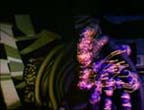
Interactive installation, 3D stereo projection with 3D (8-channel, XYZ) sound. Visitors can observe dynamic scenes made of letters, signs and symbols. These 'molecules' contain fragments of language (i.e. Latin-, Arabic-, Asian- etc. words and characters) and symbols of cultural identity: country flags, landscape, trademark and other imagery. On visitor activity the global map 'morphs' and zooms into landscapes, city streets and human figures that also are made of the signs. During user inactivity period the scene influxes back into a world map made up of pulsating characters, e.g. from languages typical to the according world part.
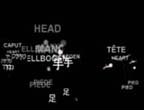
Users can change navigate scenes with several joysticks by changing the viewpoints and density of scenes. Approaching the human figures, their bodies appear to be made also from names of the body parts in various languages. By zooming into the figures and the body parts, the 'resolution' increases: e.g. 1) 'head', 2) 'hair+face', 3) 'lips'+'cheek’, 4) 'upper lip' + 'lower lip', etc.
The density and activity of avatars in specific area makes influence on the surrounding area and avatars (following the rules similar to the Game-of-Life). The avatar presence in various scene parts and mutual 'collisions' induce 'firework' and 'fusion'-like effects on their 'molecules'. When one avatar leaves some area, some other avatar entering that space partially 'repaints' that environment with its own 'molecule traces' or 'catch' and get 'infected' by surrounding 'foreign molecules'. The stereoscopic projection and quadraphonic sound creates an audiovisual illusion of ghost-like presence in the room (projected images – 'walk in and out' of the screen). The remaining traces also create an impression of ever changing landscape or fluid city.
Posted by jo at 10:11 AM | Comments (0)
June 07, 2006
ambient_light
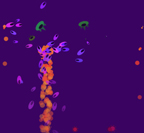
Virtual Ecosystem
ambient_light--by Annie Spinster and Carl Collins--consists of a virtual ecosystem containing a number of classes of organism. The creatures form a complex food web with interactions between individuals leading to emergent properties such as flocking and population cycles. This environment is linked to that of the gallery via a system of pressure sensors which send information to the program through a microcontroller. The system is fed information about which of six chairs is occupied at any time, and certain patterns of chair occupation cause various species to be unleashed. The overall balance of chair occupation also leads to a reactive drift of organisms across the environment.
The installation will be on private view on 13 June 6-8pm at the Summer Show, Sir John Cass Department of Art, Media and Design, Central House, 59 Whitechapel High Street, London E1 7PF (nearest tube: Aldgate East). The exhibition continues 14-16 June 10am – 8pm, 17 June 10am – 5pm, 18 June 10am– 4pm.
At the heart of the project is a store of virtual energy points which flow through the food web, affecting many of the creatures' local variables, and so their appearance and behaviour. The energy points are eventually returned to the virtual environment through death and metabolism. The energy points behave as a catalyst to facilitate interactions and reactions between individuals.
The work is called ambient_light because of the way the light reacts to everything that happens within the environment. These reactions are not really emergent properties as such - they are more like visual clues to emergent properties within the system such as population cycles and the overall flow of energy.
The ambient_light installation consists of a laptop running the Processing software, connected to a large LCD display. Pressure sensors attached to six seating units collect data and send it to Processing via a Wiring microcontroller board.
ambient_light - web version
Posted by jo at 11:39 AM | Comments (0)
The Museum of Television & Radio
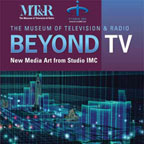
Beyond TV: New Media Art from Studio IMC
The Museum of Television & Radio Presents Beyond TV: New Media Art from Studio IMC An Interactive Gallery Exhibit in the Spielberg Gallery, 6/2 - 8/31, 2006. Visitors are offered the opportunity to experience technologies used in video games, the Internet, social software, and cell phones.
Comprised of five separate pieces--CINE 2.0, Swarm, freeSTYLE, Zig Zag Muzig Block, and LifeForce--this exhibit of interactive art offers visitors the opportunity to experience technologies used in video games, the Internet, social software, and cell phones—all of which will ultimately have an impact on television as we know it today.
CINE 2.0 (Collaborative Immersive Networked Environment, pronounced "sign") by Artists: James Tunick, Miro Kirov, and Houston Riley with Tony Rizzaro and Braden Weeks Earp: CINE 2.0 is a mixed-media environment inspired by Star Trek: The Next Generation’s Holodeck. Multiple users fly through an urban datascape in an immersive environment by using body gestures. Participants in the environment can also collaborate to compose music and, in addition, people out in the city itself can send photographs from their cell phones to be incorporated into the datascape environment.
CINE takes the computer screen out of the box and reconfigures it as a life-size environment. Control of visuals and sound takes place through full-body gestures rather than just mouse-clicks. As the traditional computer screen and mouse-keyboard interface transforms to fill the room, future entertainment platforms like CINE will enhance collaboration among multiple users, opening up whole new worlds of learning, art, creativity, and play. CINE is powered by a network of servers and computers that includes Studio IMC's BlackBox and IMCvote mobile technology.
Swarm by Daniel Shiffman: Swarm paints a digital portrait of the viewer. Stationary viewers will see their portrait, while moving ones will produce an image more like an abstract painting.
Swarm is an interactive video installation that implements the pattern of flocking birds (using Craig Reynold’s “Boids” model) as a constantly moving brush stroke. Taking inspiration from Jackson Pollack’s “drip and splash” technique of pouring a continuous stream of paint onto a canvas, Swarm smears colors captured from a live video input of the person looking at the screen, producing an organic painterly effect in real time. The person viewing the screen becomes part of the art.
freeSTYLE by Dana Karwas: freeSTYLE is a music video created entirely from cell phones. Video clips and text messages are sent in by cell phone, which are then sequenced at random and mixed with music to create a living, abstract music video. Participants can send a video or text message to 1[at]dk22.com.
Cell phones offer an extension of one's identity. Users can send messages to freeSTYLE and, in return, they will hear and see their messages free-styled back to them with an added beat. Guided by a hip-hop beat of choice, the user can hear and see their mobile presence in the form of a living music video.
Zig Zag Muzig Block (ZZMB) by Inhye Lee : Going beyond the tradition of the children's mix-and-match toy, ZZMB allows the viewer to create new characters from four existing singing characters by rotating or sliding each block. Playing with ZZMB's blocks also creates new musical compositions.
Each top, middle, and bottom block plays a different character's voice, harmony (chord), and rhythm (beat) of music, which are written as parts of complete scores. Users can make variations of the sound by applying different voices, chords, or rhythms from other blocks. When blocks are matched to compose one of the original, matching characters, users can hear the full original score. Slide the blocks to the side to make more musical variations.
LifeForce by James Tunick: LifeForce transforms the cell phone into a digital paint brush and musical instrument. The work comes alive only when the viewer participates, waving a cell phone to "paint" with light and sound. Multiple users can control the pulsing visuals as well as push sounds across the space.
Powered by Studio IMC's BlackBox media player and custom software, the installation invites viewers to collaborate utilizing a flatscreen, stereo sound, and cell phones. The work is a commentary on the need for more participatory art forms in contemporary museums, and strives to validate the mobile device as a tool for creative expression. LifeForce envisions a future in which such artistic tools are common to public spaces like city sidewalks and sides of buildings.
Studio IMC (Interactive Multimedia Culture)—a New York City-based new media agency comprised of an international team of artists and software engineers—envisions the future of group entertainment and collaboration and imagines what's waiting for us beyond the relatively passive, "hands-off" experience of watching TV. Studio IMC fuses old and new media concepts and technologies to create a brave new world of participatory—at times even immersive—media consumption. There are no "Do Not Touch" signs here—instead, you're encouraged to touch everything and actually become part of the artwork yourselves.
Posted by jo at 08:38 AM | Comments (0)
June 06, 2006
Mikon Hall of Worlds
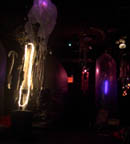
A Living Cabinet of Curiosities
Mikon Hall of Worlds is a monthly exhibition (next event: Sunday July 9, Noon to 6PM] of computer controlled exo-oceanic life created out of found objects, fans, motors, pantyhose, and horseshoe crab shells.
Mikon--created by IFAM--is a micro-museum of computer and voice driven kinetic sculpture, sound, and a viewer-manipulated virtual zooarium of imaginary life forms. Inspired by the Wunderkammern of the 18th century, Mikon is a super-condensed macrocosm, a storefront cabinet of curiosities. Mikon seeks to instill the wonder of speculative biology in its viewers, who have both the opportunity to animate aspects of the exhibition and to observe the unpredictable behavior of its components. In creating an otherworldly ecology, Mikon promotes the appreciation of the real ecologies that it emulates.
A computer has been programmed to simulate a small system of living things, which cycle through quiescence and activity. Attendees can affect this system through triggering sensors and uttering voice commands. Mikon is a growing thing, becoming more nuanced with every show, expressing itself through new visual, sonic, and sculptural elements.
Date and Time: Sunday July 9, Noon to 6PM
Location: Collective: Unconscious, 279 Church St., just south of White. Take the 123456ACEWRNQ to Canal Street, Franklin St., or Chambers St.
Price: $5
Contact:
Phone: 347.245.7078
Email: Daniel Green, hebdemnobad[at]yahoo.com
Posted by jo at 08:45 AM | Comments (0)
June 05, 2006
Shilpa Gupta
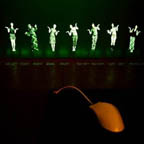
The Dwindling Power of Individual Reason
Bose Pacia presents recent work by Shilpa Gupta from May 17th through June 24th. Shilpa Gupta creates artwork using interactive websites, video, gallery environments and public performances to probe and examine subversively such themes as consumer culture, exploitation of labor, militarism and human rights abuse. In her debut solo exhibition in New York, Gupta presents an interactive video installation as well as other multimedia works and photography.
Her Untitled, 2004-2005 (interactive video) is an interactive new media installation in which the viewer is invited to manipulate a large wall projection. The projection features several figures in fashionable camouflage clothing engaged in various poses. The absurdity of their gestures and costumes recall both the mimicry games of childhood and the unforgiving rigor and conformity of military drills. In enabling the viewer as a participant, the work comments upon the dwindling power of individual reason in the face of 'mindless violence' borne out of fundamentalism and imperialism.
Her Untitled, 2005-2006 (touch screens) initially appears benign in content. One screen presents a bucolic landscape, another, the laughing faces of children, a third, a misty window. As the viewer touches each screen to initiate activity, darker truths emerge. The lush countryside of Kashmir is dotted with military guards and the smiling children are innocently posing alongside the remains of a bomb blast. From the misty window, a finger follows that of the viewer to spell out a militaristic alphabet: A for army, B for bomb, C for curfew. Gupta guides her audience to reveal the fear and uncertainty that pervade everyday life in this contested terrain and more broadly, demonstrates how truth is a fragile construction utterly dependant on the direction and intensity of one?s gaze.
Shilpa Gupta was born in Mumbai, India in 1976 and studied sculpture at the Sir J. J. School of Art there. She has exhibited widely and recent shows include the Havana Biennial (2006), ICC Tokyo (2005), Edge of Desire (New York, 2005) and Century City at the Tate Modern (2001, London). She was also commissioned to create Blessed Bandwidth.net, a net art project for Tate Online. In 2005 she was a runner-up for the Leonardo Global Crossings Award, Leonardo Magazine, MIT Press and in 2004, she was awarded the prestigious Transmediale Award in Berlin. Upcoming projects include the 2006 Sydney Biennial, the 2006 Liverpool Biennial and a two-person exhibition at Daimler Chrysler Contemporary in Berlin. Gupta currently lives and works in Mumbai.
Bose Pacia is located at 508 West 26th Street on the 11th Floor, in the Chelsea district of New York City. Gallery hours are Tuesday through Saturday from 12 to 6 pm and by appointment.
Posted by jo at 11:39 AM | Comments (0)
June 02, 2006
Experimenta @ FACT
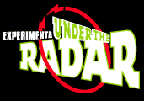
Under the Radar
Kill your television! Get ready for a totally wicked exhibition. Experimenta Under the Radar invites UK audiences to experience and interact with the high voltage works of Australia’s best and most innovative media artists: 16 June - 28 August, 2006.
FACT, the Foundation for Art & Creative Technology is the UK’s leading organisation for commissioning and presentation of film, video and new media art forms. FACT exists to inspire and promote the artistic significance of film, video and new and emerging media.
Includes:
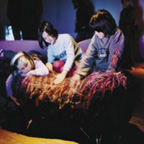
ZiZi the Afffectionate Couch (2003) :: Stephen Barrass, Linda Davy & Kerry Richens: An invention inspired in equal parts by a shaved poodle, a fluffy Persian cat, and an exotic alien sea slug, ZiZi growls when sat on, purrs when touched, and emits soft groans of delight if you stroke her long fur. If left alone, ZiZi mews for attention. ZiZi is an affectionate ottoman couch that asks for emotional support while offering physical comfort. The responses are triggered by touch-sensitive cables, which are sewn into the fluffy upholstery of the couch. While Barrass claims that ZiZi’s personality is based on his pet Dalmatian Ziggy, we can safely assume that the artist does not sit on his dog.
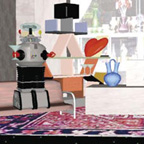
Op Shop (1999-2002) :: Stephen Barass: Cluttered from floor to ceiling with bric-a-brac, Op Shop is a virtual environment that is transformed by sound. Unlike most interactive interfaces where communication occurs by means of a stylus, mouse or other device, Op Shop encourages collaborative interaction. By singing into the microphone a visitor can disturb the virtual objects; a high-pitched wail can shatter glass. By singing and sustaining a low note, they can smash a table. An ever-changing choral score emerges as multiple participants explore the effects of their vocal range. This cacophony of hums, croons, shrieks, claps and whistles, punctuated by percussive shattering and laughter, propels the visitor towards an unexpected finale.
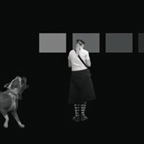
Dislocation (2005) :: Alex Davies: What happens when we can’t trust what we see with our own eyes? As visitors peer into the portals of Dislocation, they become auto-voyeurs seeing and hearing unnerving scenarios play out behind them only to discover the room is empty when they turn around. Ingeniously programmed by Davies to overlay pre-recorded sequences with realtime footage, the simultaneous presence and absence of these phantoms defies rational thought and experience, and creates a haunting atmosphere. The work creates an environment of deception and uncertainty whose subtlety and cunning displaces our reliance upon, and trust of, our own distinct emotional responses to the presence of others.
Posted by jo at 09:51 AM | Comments (0)
June 01, 2006
ELIZABETH LEISTER
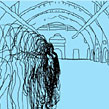
EVERY BODY IS EVERYWHERE AND NOWHERE
Every Body is Everywhere and Nowhere combines performance and technology in an immersive video installation. This new project continues Elizabeth Leister's themes of transformation and control in relation to the body. Leister's performative investigation is informed by a history of body-based performance art, including, Ana Mendieta's "Silhueta Series", "Push Ups", by Vito Acconci and "Up To and Including Her Limits" by Carolee Schneemann. Like the aforementioned, Leister uses video images of body imprints and line drawings, actual and animated, to study the physical and virtual body in space.
What occurs when the body is transformed through our use of technology? The amalgamation of video, performance and drawing in Leister's project links the traditional to the technological and emphasizes the physical impact of our bodies on the world we live in with one another. Our body language, sense of touch, corporeal presence and physical movement through space become invisible as we interact via machines. What is lost? What is gained?
Leister will perform a drawing to define her own physical borders within a specific moment in time and space. This drawing will be made each day for the duration of the exhibit in Leister's Los Angeles studio and transmitted through live-feed via web-cam, into The Morris Gallery in Philadelphia. The traditionally intimate space of performance will expand as the body of the artist is projected across space and time. Made up of shifting light and pixels traveling through cyberspace, the body becomes expansive and limitless.
A second video shows a collage of the imprints left behind by Leister's family and friends: a snow angel, footprints in the sand, a sweater tossed to the ground. A third projection of an animated drawing outlines, frame by frame, a body moving through space. Like the drawing created in the performance, lines are built up to define a path of movement, then reverse and erase.
A computerized voice expresses a desire to be everywhere and nowhere, everyone and no one while a second audio track, taken from Leister's writings, is an overlay of a human voice whispering as if she were light and breath in an unnamed space.
Finally, the video projections will be installed in relation to a set of mirrors to create a kaleidoscope of images that will reflect the body of the viewer. Through live-feed performance, drawing and video the project will juxtapose the physical body and the immateriality of the virtual body.
The exhibition in the Morris Gallery at the Pennsylvania Academy of Fine Arts opens on June 10th and runs through August 20th. The installation, which will open with a free reception June 9 from 6 to 8 p.m., is curated by Alex Baker, the Academy's Curator of Contemporary Art.
Museum hours are Tuesday through Saturday, 10 a.m. to 5 p.m., and Sunday, 11 a.m. to 5 p.m. The Academy is located at 118-128 N. Broad Street in Philadelphia, two blocks north of City Hall. Regular admission is $7 adults, $6 seniors and students with ID, $5 children / youth ages 5-18, free for members and children under age 5.
Elizabeth Leister received an M.F.A. in sculpture from the Milton Avery Graduate School of the Arts at Bard College and a B.F.A. from the Tyler School of Art. In Philadelphia, her work has been exhibited at the Philadelphia Museum of Art and Nexus Foundation for Today's Art. Her work has also been shown at the Delaware Museum of Art, the North Dakota Museum of Art, Art in General and P.S. 122 in New York, and the Kellogg Art Gallery at California State Polytechnic University, Pomona, among others. She has received awards from the Pennsylvania Council on the Arts and the Leeway Foundation.
Posted by jo at 11:06 AM | Comments (0)
May 30, 2006
Waves
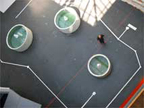
Wading Compositions
Waves is a sound installation that uses buoys to connect wading pools in two different locations and create sound compositions generated by the energy of waves in a wading pool.
An accelerometer in each buoy measures the magnitude of waves through x- and y-axis position changes caused by the rocking back and forth of the buoy on the water's surface. The accelerometer's readings are converted into sound waves by a microcontroller connected to a SPEAKjet sound synthesizer IC. The SPEAKjet's output is then amplified and sent to a speaker integrated into the buoy. Each buoy plays a electronically generated minimalistic tone that reflects the participant's movements in the wading pool.
Each group of waders create their own audio composition as they influence the magnitude and frequency of waves in the pool with their splashing and playing. When no waders are in the pool, the buoys reflect their environment by responding to the waves created by wind blowing through the park, or silence when both air and water are still.
By Shannon McMullen and Fabian Winkler. Images courtesy of the Fabian Winkler. Other work by this artist: Dielectric. [blogged by Régine on we-make-money-not-art]
Posted by jo at 02:10 PM | Comments (0)
May 26, 2006
HTTP Gallery
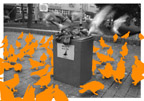
Urban Eyes
HTTP Gallery is pleased to present Urban Eyes, an intermedia project by Marcus Kirsch and Jussi Angesleva. Private View: 1st June 2006 7-9pm; Exhibition: 1st June - 9th July 2006, Friday- Sunday: 12 noon-5 pm; Unit A2, Arena Business Centre, 71 Ashfield Rd, London N4 1NY; tel: + 44 (0)20 8802 2827; info[at]http.uk.net
Urban Eyes uses wireless technology, birdseeds and city pigeons to reconnect urban dwellers with their surroundings. The Urban Eyes feeding-platform stands in one of London's public spaces. By landing on the platform, pigeons tagged with RFID chips send aerial photographs of their locality to surrounding Bluetooth-enabled devices. In this work pigeons become maverick messengers in the information super-highway, fusing feral and digital networks. HTTP Gallery provides an interface to the project, mixing live and documentary footage and offering visitors an opportunity to experiment with Bluetooth.
Being one of the last remaining signs of nature in a metropolis such as London, the urban pigeon population represents a network of ever-changing patterns more complex than anything ever produced by a machine. However pigeons' movements are based on a one-mile radius around their nest. Any pigeon you see everyday shares the same turf as you. Urban Eyes crosses and expands human mobility patterns offering to reconnect you with your neighbourhood.
In the 1960s, situationists Debord and Jorn composed psycho-geographic diagrams of Paris, which described navigational systems based on their drift through the city. For this, they used Blondel la Rougery's Plan de Paris a vol d'oiseau, a bird-eyes map of Paris. Inspired by this methodology, Urban Eyes enlists our feathered neighbours to establish a connection between the bird-eyes view of the city as now distributed by Google Earth and our terrestrial experience. [Related]
About Marcus Kirsch and Jussi Angesleva
Marcus Kirsch holds an MA in Interaction Design from Royal College of Art. He was invited to the 2004 Seoul Biennale and as exhibiting artist and to last year's Rotterdam International Film Festival and DEAF Festival. He was awarded a silver Art Directors Club NY and a fusedspace.com award in collaboration with Jussi for 'Urban Eyes'.
Jussi Angesleva holds MA in Audio Visual Media Culture from the University of Lapland in Finland, and MA in Interaction Design from the Royal College of Art and has shown at the Tokyo Metropolitan Museum of Photography, Siggraph, ZKM and Science Museum London. He has received awards from Royal Society of Arts, NESTA, from D&AD (together with Ross Cooper), Prix Ars Electronica and the Art Directors Club of Europe. He is currently working at ART+COM in Berlin, Germany and is a co-founder of new media agency Prosopon.
For more information and images, please contact Stephanie Delcroix
This project is supported by Arts Council England (London), V2 lab (Rotterdam, Netherlands) and Furtherfield.org.
Posted by jo at 05:36 PM | Comments (0)
Poker Club, Scotland
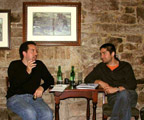
Haque + Bleecker
The Poker Club at the Beehive Inn in Edinburgh featured Usman Haque (artist / architect) and Julian Bleecker (technologist / artist / think tank leader) to discuss the "internet of things" and "open source architecture". Hosted by New Media Scotland.
Both presenters took us through a short run down of their work and then there was a lively exchange between everyone present. Hopefully there will be a podcast from New Media Scotland in the near future.
Haque's presentation was broken into three categories: Invisible Stuff, Collaborative Stuff (produced by non experts - or vernacular creativity) and Social Space. He talked about Architecture as an operating system for the collaborative production of space. He stressed the importance of the necessity of the system (whether an augmented object or space) to have the capacity to build 'its' own perceptual categories. Several examples of previous and current work were shown.
Bleecker started with the question 'Is life hackable?' He characterised the upsurge of activity as a renewed or second order humanism. The term 'change agents' was used and it was pointed out that these are no longer well positioned parties such as New York Times reporters. Several projects were shown which showed how digital networks can shape physical activities in a sort of network practice - social practice continuum. It was stressed that we're not just talking about data transactions.
Some interesting points that came up in the discussion:
:: We are surrounded by invisible information, how do we make this visible or legible?
:: Technology extends the zone of our perception/agency.
::Is the web of objects the end of subjectivity or a new beginning for subjectivity?
:: The role of human beings as filters.
The issues emerging for me are what do we mean by 'understanding' in relation to all the information we have access to and how do we have agency within it? One thing that came up over and over was the spatial or prepositional nature of our relationship to the digital networked public. As Bleeker points out in Why Things Matter are we 'on' or 'in' the network?
[posted by John Marshall on Designed Objects]
Posted by jo at 12:22 PM | Comments (0)
May 25, 2006
IN[ ]EX
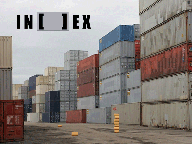
Container Culture
Panel Discussion: RHYTHMS OF URBANITY: MAPPING THE PUBLIC SPHERE THROUGH SOCIO-POLITICAL FORCES--Thursday, May 25 at 7 pm; Room 403, Vancouver Art Gallery.
This public discussion among artists Kate Armstrong, Bobbi Kozinuk, M. Simon Levin, Laurie Long, Leonard Paul, Manuel Piña, Jean Routhier, and curator Alice Ming Wai Jim will speak to “container culture” and the idea that the public sphere is rapidly being privatized and now reflects more on the movement of goods and capital than on the expression of individual rights. in[ ]ex, their interactive, city-wide media art project, will first be exhibited in connection with Centre A and the World Urban Forum in Vancouver, Canada in June 2006, and then in San Jose, California in connection with the Container Culture exhibition at ISEA in August.
In[ ]ex is an audio sculpture which creates a mesh network by releasing thousands of embedded wooden blocks into the world. The mesh network collects and processes data to form a sound environment in the space of a shipping container. This project takes place in the context of shipping and distribution of goods and the movement of people in the two port cities of Vancouver, British Columbia, and San Jose, California. In[ ]ex engages both the subject of things and the mechanisms by which things are distributed in the global economy.
Posted by jo at 10:12 AM | Comments (0)
May 23, 2006
Paul DeMarinis

The Messenger Delivers a Golden Nica
The Messenger (1998) by Paul DeMarinis has been awarded the Golden Nica for Interactive Art by Prix Ars Electronica 2006. In The Messenger, email messages received over the internet are displayed letter by letter on three alphabetic telegraph receivers: a large array of 26 talking washbasins, each intoning a letter of the alphabet in Spanish; a chorus line of 26 dancing skeletons and a series of 26 electrolytic jars with metal electrodes in the form of the letters A to Z that oscillate and bubble when electricity is passed through them. Movie.
"The Messenger is an internet-driven installation based on early proposals for the electrical telegraph, in particular those made by the Catalan scientist Francisco Salvá. As in many of my works I examine the metaphors encoded within technology, especially lost or orphaned technologies and try to trace their origins, speculating on the way that mechanisms are the repositories of larger unspoken conceptions and dreams. In The Messenger I take the telegraph as a point of departure from which to examine the relationship between electricity and democracy, and how electrical telecommunication technologies have participated in our solidarity and in our isolation, in our equality and our oppression, in the richness of our experience and the uncertainty of our lives." -- Paul DeMarinis
Paul DeMarinis has been working as an electronic media artist since 1971 and has created numerous performance works, sound and computer installations and interactive electronic inventions. He has performed internationally, at The Kitchen, Festival d'Automne a Paris, Het Apollohuis in Holland and at Ars Electronica in Linz and created music for Merce Cunningham Dance Co. His interactive audio artworks have been shown at the I.C.C. in Tokyo, Bravin Post Lee Gallery in New York and The Museum of Modern Art in San Francisco. He has been an Artist-in-Residence at The Exploratorium and at Xerox PARC and has received major awards and fellowships in both Visual Arts and Music from The National Endowment for the Arts, N.Y.F.A., N.Y.S.C.A., the John Simon Guggenheim Foundation, the Rockefeller Foundation New Media Award and the D.A.A.D. Berlin Artist Fellowship.
Much of his work involves speech processed and synthesized by computers, available on the Lovely Music Ltd. compact disc "Music as a Second Language", and the Apollohuis CD "A Listener's Companion" Major installation works include "The Edison Effect" that uses optics and computers to make new sounds by scanning ancient phonograph records with lasers, "Gray Matter" that uses the interaction of body and electricity to make music, and "The Messenger" and "Firebirds" that examine the myths of electrical communication. Public artworks include large scale interactive installations at Park Tower Hall in Tokyo, at the 1996 Olympics in Atlanta and Expo 1998 in Lisbon and an interactive audio environment at the Ft. Lauderdale International Airport in 2003.
Posted by jo at 01:36 PM | Comments (0)
May 22, 2006
SoniColumn

Monumental Music Box
SoniColumn is a high column-like cylinder that can be played by touch. Grids of LEDs installed inside the column light themselves on by the users’ touch and emit unique sounds. When a user cranks the handle, the column slowly rotates itself and plays the light patterns of the user’s touch.
By Jin-Yo Mok who also designed the Light Bead Curtain and is working on a portable version of his Music Box.
SoniColumn is currently exhibited at the bitforms Gallery in Seoul, Korea. [blogged by Regine on we-make-money-not-art]
Posted by jo at 11:16 AM | Comments (0)
May 19, 2006
SOLAR RADIO STATION

Sounds of the Universe
SOLAR RADIO STATION, a project by RIXC, Center for New Media Culture, Riga (LV) and r a d i o q u a l i a (NZ / AUS / GB / NL); PHOENIX Halle Dortmund; May 20 - July 16, 2006; Opening: Friday, May 20, 2006, 18:00.
In this (live) installation one can listen to the sounds of the universe originating from various sources. They have been collected by the artists' group r a d i o q u a l i a (Honor Harger, Adam Hyde) in cooperation with RIXC, Center for New Media Culture, Riga. The recordings are coming from various radio telescopes. Additionally, during two days, there will be live feeds from the VIRAC radio astronomy telescope in Irbene (Latvia) which will be acoustically re-worked and interpreted live by the experimental musicians Clausthome (Latvia). VIRAC is the largest radio telescope worldwide (with a dish diameter of 32 meters) accessible for civilian use - thanks to RIXC's continued efforts. During the cold war the KGB used the radio telescope for tapping into NATO's and other military networks.
The installation “Solar Radio Station" consists of three parts. r a d i o q u a l i a's computer and sound installation “solar listening_station" is the first part. It contains recordings and live streams of radio waves from space, especially from the sun. The second part “Spectrosphere" also contains signals originating from the VIRAC radio telescope, this time modulated via electronic instruments and interpreted visually. Here, Clausthome and VJ Ratniks present the results of their live performance from May 20 + 21 at PHOENIX Halle until July 16, 2006. The third part consists of a comprehensive video documentation of the VIRAC telescope by RIXC. Additionally, on a large scale poster the existing frequency spectrum is visualized and its current use is explained.
LIVE INSTALLATION: Sat + Sun, May 20 + 21, 2006, 19:00 - 21:00; The Riga based group Clausthome and VJ Martins Ratniks (F5/RIXC) will perform live in the Solar Radio Station. The live audio stream from the VIRAC radio telescope in Irbene, carrying data from the sun and from space, will be electronically enhanced by Clausthome and interpreted visually by VJ Martins Ratniks.
LINKS
www.museumamostwall.dortmund.de
www.hmkv.de
www.rixc.lv
www.radio-astronomy.net
www.virac.lv
A project by RIXC, Center for New Media Culture, Riga (LV) and r a d i o q u a l i a (NZ / AUS / GB / NL).
RIXC (LV) - Raitis Smits, Rasa Smite, Martins Ratniks, Davis Bojars r a d i o q u a l i a (NZ/AUS/NL/GB) - Adam Hyde, Honor Harger Clausthome (LV) - Lauris Vorslavs, Girts Radzins
In the framework of the exhibition "mit allem rechnen. Medienkunst aus Estland, Lettland und Litauen / face the unexpected. Media art from Estonia, Latvia and Lithuania" - a cooperation between Hartware MedienKunstVerein and Museum am Ostwall, Dortmund/Germany.
SUPPORTED BY: Kulturbuero Stadt Dortmund, 38. internationale kulturtage der stadt dortmund / scene: estland lettland litauen in nrw, Kunststiftung NRW, Der Ministerpraesident des Landes Nordrhein-Westfalen, Kultusministerium der Republik Estland, Kultusministerium der Republik Lettland, Kultusministerium der Republik Litauen, Botschaft der Republik Litauen in der Bundesrepublik Deutschland, Lietuvos Institutas, dortmund-project, LEG, PHOENIX, Medion, Coolibri (Medienpartner).
VENUE: Hartware MedienKunstVerein at PHOENIX Halle Dortmund, Rombergstr. / Ecke Hochofenstr. (no postal address!) Dortmund-Hoerde, Germany.
ADMISSION: PHOENIX Halle: 4 Euro, reduced 2 Euro (incl. admission to the exhibition "Glamour and Globalization") Kombiticket Museum am Ostwall and PHOENIX Halle: 6 Euro, reduced 3 Euro (incl. admission to the exhibition "Glamour and Globalization")
HOW TO GET THERE http://www.hmkv.de/dyn/e_contact_roaddescription/
CONTACT
Hartware MedienKunstVerein
Guentherstraße 65
D - 44143 Dortmund
Germany
Tel: ++49 - 231 - 823 106
www.hmkv.de
Posted by jo at 10:51 AM | Comments (0)
May 18, 2006
Inside Out
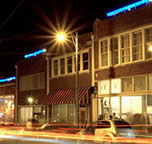
Urban Ambient Display
[Inside Out is a] set of aesthetic lighting displays on top of 9 buildings that visually samples the real-time activity levels from the inside of the buildings. The installation measures the movement & energy within buildings & makes them ambiently visible outside, so as people walk around the South Main gallery district of Memphis, they are able to see each building node & it's activity before they enter them. The rooftop ambient light system consisted of a microcontroller to intepret the data sent to it from below & solid state relays to control 16 bulbs diffused by blue plexi in a minimally designed display. [jamesclar.com|via we-make-money-not-art.com] [blogged on information aesthetics]
Posted by jo at 12:30 PM | Comments (0)
Régine Debatty's Interview with Marc Bohlen

"Machines are their own species"
Marc Bohlen's website has provided me with some amazing stories ever since i started blogging: from the Open Biometrics Project that i posted back in 2004, to the Universal Whistling Machine, first prize at Vida 7.0, and the cursing Amy and Klara.
Marc is trained in Stone Masonry (sic), Art History and Electrical Engineering and Robotics. He has been an invited speaker at Cornell University, Harvard University, The Ludwig-Maximilians-Universität München, the Banff New Media Institute and the Royal Institute of Technology in Stockholm, etc. Marc is currently directing the MediaRobotics Lab at the University of Buffalo (Department of Media Study).
Shoeveillance sounds like "souveillance." Is there a hint of activism behind the project?
Certainly! My approach overlaps to a strong degree with that of art-activisism. It is also different. If you leave the development of technology to market forces alone, the solutions leave out too many market-irrelevant, but important, interesting and pleasurable factors. Realtechsupport tries to cast engineering problems in a light that includes their social/cultural context, and tries to make this a design parameter that needs to be 'solved'(addressed, discussed, solved) with the same diligence as the isolated technical problem.
Shoeveillence is a good example of this approach. Shoeveillence is capable of monitoring the passage of people in to and out of a room (and by extension a building). It acknowledges the fact that, in this world, this might be necessary [There is a fire in a 100 story building – is there anyone on the 91^st floor?]. At the same time, it counters data-creep and prevents data that is not "needed" from being collected. [The camera sees only feet and legs up to knee height; the machine algorithm finds directionality of motion and objects that look like shoes only].
In this regard shoeveillence is related to previous work in biometrics. The Open Biometrics Project included the design of a fingerprint analysis system that made its probabilistic results apparent so one could watch the machine in action. Having complex machines make binary decisions about us is really a problem.
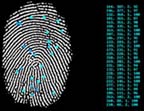
A friend of mine told me about an interaction designer who had devised a way for people living in a not very posh neighborhood of London to pass through the streets of their area and yet avoid the gaze of the CCTV network. But it turned out that people were not happy with the idea, they actually liked to be on surveillance camera. Do you think a system like Shoeveillance could make everyone happy: maximum data collection and minimum invasion?
Yes. Let's make everyone happy! Shoeveillence plays with the desire to be seen to some degree. Parading your shoes is a special kind of pleasure, an accepted form of exhibitionism. It is one I would like machines we share the world with to be fluent in. We will have to wait for compliments, though, the appreciation of good shoes is beyond AI today. In HCI (Human Computer Interaction) community, some people speak of 'shy sensors', sensors with low-bandwidth input (such as a button) from which you derive information based on the sensor's location. If you want to know if someone is sitting in a chair without watching them on a camera, for example, you put a button in the chair. Shoeveillence, however, takes in high-bandwidth data (streaming video). It is tamed physically (by its position on the ground and its lens system), disciplined programmatically (by its algorithm) not to notice anything but shoes and incapable of being invasive but geared to be persistently and maximally shoe centric. This is a new kind of problem solving, I think.
Shoeveillance has found a first application in 8-bit Architecture. Can you tell us something about that project? how does shoeveillance fit in 8-bit A?
8-bit Architecture is a concept for a new joint between lived spaces and synthetic systems in the widest sense. To date, our new technologies are add-ons to the buildings in which we live and they enforce a master-slave relationship. The "smart home" got it all wrong. We don't need more convenience in our lives.
8-bit A wants to find out if there can be new ways of bringing the separate entities of synthetic and controlling systems together with lived spaces. Think about Cory Arcangel's Mario Brother game hack where he removed from the game engine everything but the scrolling clouds to create a 'game' the technical staff never imagined. 8-bit Architecture will try to find solutions like that (but different) for built and lived systems. Home automation has got to deliver more than garage-door openers that can be activated from the armchair and lights that dim on command.

I like one of your older project: Advanced Perception. Are you still investigating the field of "animal machine interaction design"?
Yes! That project really set the path for my work. The Universal Whistling Machine project continues the thrust with the question of communication beyond species boundaries. And the Glass Bottom Boat will move from land to sea creatures. I think we should replace HCI (Human Computer Interaction) with HAMI (Human Animal Machine Interaction). Animal activism meets robotics. The new world must have space for all of us.
How affected were the chicken by the presence of the robot?
At first indifferent. Once the robot moved, they were very frightened. But having the robot 'announce' its motion prior to actually moving (by activating the motors for a fraction of a second as to make a noise) made the chickens accept the machine much more readily. The robot was then instructed to avoid the feeding corner, so the chickens had their reserved territory. That seemed to help as well.
The results of these robot-chicken experiments were presented to both the scientific as well as the art communities. did they react in a different manner?
I had a famous chef (Rudi Stanish) cook omelets from the eggs of the chickens. In the gallery we had a taste-the-interaction session. People enjoyed the omelets and, hopefully, thought about a future world where animals, humans and robots roam freely.
I presented parts of the work in two scientific venues. There the interest was on "robots in adverse environments" (you can't sell omelets to the scientists). They were keen in hearing about how to deal with the messy side of things (dirt, chicken droppings, reliability over time, control mechanisms). But, in the end, the discussion also went to the 'high end' topics of shared spaces for different species. But the technical diversion was necessary to get to that point.

You seem to mingle with the artisitc as well as with the scientific communities. What's your crowd? How open is the scientific community to art projects?
(left: Advanced Perception gourmet performance) My crowd: Mixed. I think people who are trying to (experimentally) find ways of living with the fallout from automation technologies respond to my work. I am not a visual artist. The science community is selectively appreciative of the work. I do solve problems and deal with the same kind of messy and complicated information processing issues the engineering sciences do. The criticism I get from the sciences is that I am weak on evaluating my "results". But I am really not into handing out questionnaires and doing factorial designs experiments. I understand the critique, and understand where it comes from, but limit myself in accepting it in order not to loose the thrust of the work.
On the other hand, one does have to really understand the questions the sciences are concerned about. You can not speak the dialect of art (and expect to be understood) when you play the science game. Else you are delegated to a beautifier (and your voice is not taken seriously beyond that task). This was an important insight into really getting discussions going across disciplines: you have to be in the disciplines. This is a huge problem with much of the current "art meets science" endeavors. It really takes more than talk to move between different domains of knowing.

(Left) Amy and Klara and The Universal Whistling Machine) Other recent projects on your website deal with the replication of human features in artificial systems as well. Do you feel that the quest for the machine that will look and sound exactly like we do is senseless?
Yes, the quest for the synthetic system that looks, feels, acts and sounds like us is a dead end, in my view. Synthetic systems designers (from literature, cybernetics, robotics, and AI) have always been attracted to the mimesis of human features. Mostly because humans see humans as the pinnacle of evolution. If you are going to make synthetic life, why not work off the 'best' example you can find, the human, so the argument goes. But there is a different argument I am more attracted to. What the machine affords (in the sense of what is is capable/incapable of) is fundamentally different from how we are.
Machines are their own species, they are aliens, in a way. Sensors can see and hear things outside of our human perceptual boundaries. We have no access to microseconds as a computer does. Entities that can access this kind of 'stuff' are different, in a similar way as a dog that can hear sounds I can not hear, is different from me because of that.
Thanks Marc!
More on the projects discussed here at Realtechsupport. [blogged by Regine on we-make-money-not-art]
Posted by jo at 10:11 AM | Comments (0)
May 15, 2006
[MediaRuimte]'s MR.xpo 12
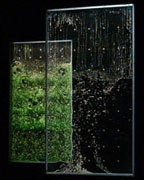
Stream Space by Peter Maschke
During his residency at MediaRuimte (MR.tmp06), Peter Maschke is developing in collaboration with LAb[au] (electronics+programming), Geert Feyton from Noise Maker's Fifes (analog sound) and Frederik de Wilde (digital sound) an interactive audiovisual installation under the title Stream Space. The result of his residency will be presented in the exhibition MR.xpo 12, taking place at MediaRuimte from 25.05 - 03.06.2006. For the opening, Thursday 25.05.2006 at 22:00, Stream Space will be performed live.
Stream Space is an audiovisual installation, which takes the properties of water as its starting point. Water has always had a strong and meditative force of attraction on mankind, be it the stillness of the sea or the sound of streaming water. The installation is an attempt to translate the ever being fascination for the element water into an audio-visual concept, that invites the auditor to create his personal visual sound score.
Four acrylic glass windows measuring 210 x 110 x 2 are suspended in a space, each filled with water, dyed in a different colour. A system of air tubes arrives at the bottom of the windows and is connected to a compressor. Air can be injected, that will rise as bubbles in the water.
The idea is to capture the sound of the burbling water, to modulate it and to emphasize its quality. This will result in a specific sound-colour for each window. The project foresees a combination of passive and active elements. The passive part of the interaction, consisting of sonar boxes (or web cams), will scan the surroundings of the installation within a specific range. When a movement is captured, it will be translated into an electrical signal that will operate the valves of the air supply. In the active part, a console with four joysticks on independent circuits can be operated. Through the console, the visitor can control the amount of air injected into each of the windows, thus manipulating sound and visual contents of the installation. By this means, an interaction takes place between the visitor, the visual object and the randomised modulated tone.
PETER MASCHKE
Born in Germany, Peter Maschke has been living in Brussels since 1991. He started his career as a dancer in 1984 when, after studying dance at the London School of Contemporary Dance (UK), the Folkwang School in Essen (De), and the CNDO in Arnhem (Nl), he joins the company Plan K in Brussels. He dances in Icare and later participates in the creation of Titanic. He then participates in a series of choreographic and theatrical creations through which his interests start to be more and more directed towards set-design.
Meanwhile, he has created the sets for various dance and theatre company’s, more in particular for Rideau de Bruxelles (Les Indifférents, Prometheus), Compagnie José Besprosvany (Lara, Dos y Dos), Théâtre Le Public (L’Invisible, Belle à mourir), Pé Vermeersch (The Story of Salomé and Yokanan), Avi Kaiser (Lieber R), Juliette Bougard (The Sorry Piece), Leporello (Onkel Vania) and Compagnie Thor (l'Âme au diable).
As scenographer and/or assistant director he has collaborated with the music theatre company Tirasila, creating sets for numerous creations: Roi Ubu, K-Bel, Het Laatste Verlangen, Krsk and Slachtwerk. In 2004, he participated as assistant director in the creation of Theater Stap’s theatre piece Frankenstein, directed by Vital Schraenen.
He regularly works with the choreographer Fernando Martin's company Fuepalbar, for whom he designed sets for the choreographies Mismorigen, Ten Sueño and Mordre à travers. For these last two creations he also participated as assistant choreographer.
Currently, he is working with the artist Alexandra Dementieva on an installation, which is foreseen for Spring 2006.
LAb[au]
LAb[au], laboratory for architecture and urbanism examines possible textual, graphical and spatial forms of transcription of inFORMation processes, transmission, computation and editing through theoretic works, research / writings and production /c onception. The core of Lab[au]'s theoretical research is the impact of new information technologies on the spatial and semantic mutations through projects implicating a reflection on the perception and conception of space. The contents of Labau's work is to find a definition of architecture as a set of codes or a language drawn from concepts of communication and information sciences, by opening up the fields considered by today's architectural concept with those considered in communication and new media. Here, 'Metadesign' can be understood as a technology determinism that constitutes the main vector/thought in the concerns of networked, information-based societies with the goal to build up connectivity and effectiveness.
Posted by jo at 03:28 PM | Comments (0)
May 12, 2006
Poetry Machine 1.0 + Electrophile
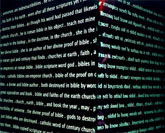
Welcome to the World of Spooky Keyboards
David Link's Poetry Machine 1.0 is a word processor that generates texts through a combination of user input and autonomous web bots. Its sources of information are the gigantic pools of information on the Internet. In a room, a text that is written by nobody runs on a projection screen. The keys of the keyboard move swiftly as if by a ghost's hand and a mechanical voice reads out the generated text, sentence by sentence.
But when visitors approach, the text generator staggers, hesitates, at times grows completely silent. If a visitor strikes the keys himself, the text appears on the screen as well. If the user's input contains words that are unknown to Poetry Machine, the program sends "bots" into the internet to get appropriate informations. Their search process (visited sites, their valuation and the documents found) can be followed on a second screen.
In this interaction of machine words and human text, «Poetry Machine» creates a new écriture automatique, where language is no longer the exclusive domain of human thought but also that of the internal logic of computers. Video.
The work is part of the Beijing International New Media Arts Exhibition and Symposium, June 30 - July 10 2006, China Millennium Museum, Beijing. Images.

Writing about uncanny keyboard, gives me a great opportunity to mention Crispin Jones's Electrophile, a keyboard designed for celebrity fans who have limited means for communicating the fandom through email messages. The keys on this tool for adding a sense of devotion to email messages are fitted with tiny metal contacts that deliver an electric shock to users. The shock becomes progressively stronger as more characters are entered. You've got to be a real fan of the celebrity to finish your letter to him/her. The shocks are controlled by a circuit based on one which was designed for a muscle toning device ("Gym Relax"). [blogged by Regine on we-make-money-not-art]
Posted by jo at 01:07 PM | Comments (0)
May 11, 2006
Julius Popp
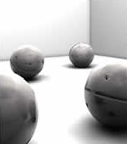
Micro.Spheres
Micro.Spheres by Julius Popp takes place in a room, containing around 16 autonomously acting robots, which visitors are allowed to enter and experience. The robots act according to a dogmatic command that drives them to perpetually place themselves in the spatial centre of their immediate environment.
What results is a chain reaction which seems highly complex but can be easily explained as it is simply a result of each robot having an effect on its neighbour, all the way to the borders of the room. This process necessarily has to affect all elements of the system. The system remains active as long as the visitors continue to move. When the visitor remains still the system is able to find a new stable pattern. When there is more than one visitor within the system, the complexity of the shapes and processes increases. Micro.spheres reflects on the complex interrelations that exist between ‘living’ bodies and their environment. In particular, it addresses the changing social structures of our present day and age. [blogged by Ruairi on Interactive Architecture dot org]
Posted by jo at 08:21 AM | Comments (0)
May 08, 2006
Aperture + Contemplace
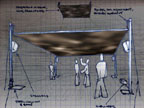
Spatial Experience
Aperture--by transmote.com-- focuses on the ways sound and light affect spatial perception. Spatial experience comprises several related elements. Some of these are ephemeral and difficult to isolate, such as time, context alongside adjacent spaces, and human presence or absence. However, some elements more directly affect spatial experience; in particular, sensory data such as visual changes, aural motion, and tactile input have profound impacts on the way we perceive space.
Multi-channel sonic textures, generated from recordings of existing spaces, encircle the space of the installation. A rear-projected ceiling is used as a display and light source, describing arcs of motion, intensity, and color. Transitions between audiovisual textures echo transitional places in architecture, places that deal with changes in scale, use, material, and motion. By contextualizing these changes of sound and light in physical space, Aperture enables visitors to gain a greater awareness of the composition of their individual perceptions of space.
Aperture is on display as part of Eyebeam's Circuit program from Tuesday, May 9th, through Saturday, May 20th. Eyebeam’s hours are Tuesday - Saturday, 10am-6pm.
Eric will be on hand to discuss the piece during the following times:
Tuesday, May 9th, 4-6pm
Wednesday, May 10th, 6-8pm
Aperture was developed during a fellowship in Eyebeam's Production Studio and is an extension of Contemplace.
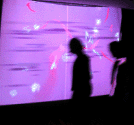
Contemplace is a spatial personality that redesigns itself dynamically according to its conversations with its visitors. Sometimes welcoming, sometimes shy, and sometimes hostile, Contemplace's mood is apparent through a display of projected graphics, spatial sound, and physical motion. contemplace is an environment in which inhabitation becomes a two-way dialogue.
Contemplace is an exploration of possible interactions between people and the spaces they inhabit. Typically, built spaces are passive shells that rely on their inhabitants to provide them with character. What would our spaces be like if they could receive their visitors like a human host?
Contemplace's visual displays and overall structure are built with processing, a java-based programming platform. Contemplace's sounds are generated by max/msp, a graphical programming environment for manipulating sound. processing and max/msp communicate via flosc, a java server designed by Ben Chun to allow communication between OSC/XML-compatible programs over IP. Visitor presence and motion is detected by a webcam and pressure sensors. The same electronic circuit that monitors the pressure sensors also drives a motor that raises and lowers the ceiling with contemplace's mood swings.
Posted by jo at 05:03 PM | Comments (0)
May 03, 2006
Andy Gracie + Brian Lee Yung Rowe
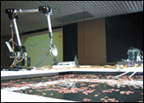
Autoinducer_Ph (Cross Cultural Chemistry)
"The idea of making art with living system is not new; you might ever consider a garden to be biological art. What is new is the degree of control over the biological systems and materials that contemporary art offers us. The aim of some net.art projects, like Telegarden, has always been to articulate a link between natural processes and communication networks in symbolic and mechanical terms. British artist Andy Gracie follows this stream working with events at the intersection of the technological and the biological.
With the collaboration of the American scientist Brian Lee Yung Rowe he has created Autoinducer_Ph (Cross Cultural Chemistry), an installation created for the AV06, Newcastle International Audio Video Festival. The project exploits a traditional rice cultivation technique from Asia based on the symbiotic association between the Anabena, a microscopic filamentous alga, and the water fern Azolla. The installation, which includes an assemblage of pond-like structures, electronics, laboratory and hydroponic equipment, uses the Generalized Cellular Signaling system, a platform for exploring emergent behavior and intelligence, to interfere with the symbiotic relation. The GCS bacteria signals, sometimes translated in sound and lights, are converted into inputs to control various actuators that regulate the environment in which the bacteria are being cultured. The sum effect is a bio-artificial ecosystem, which takes the form of a water garden which sustains living bacteria, robotic systems and artificial lifeforms, pushing our notions of life, intelligence and being into new territories." -- Valentina Culatti, NEURAL.
Posted by jo at 05:38 PM | Comments (0)
May 02, 2006
Mathieu Briand
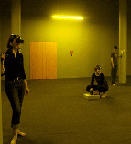
Telepathy Playground
Marseilles-based artist Mathieu Briand makes installations that use light, video, sound, and other media to let viewers destabilize and manipulate their own perceptions. His stylish works adopt the sleek, cold, and ambiguously menacing look of '2001: A Space Odyssey' and other dystopian science fiction fables of that era. Briand's first U.S. solo show recently opened at Los Angeles' Redcat gallery, and its title, Ubiq: A Mental Odyssey references both the Kubrick film and 'Ubik,' the Philip K. Dick classic about telepathy, unstable realities, and an elusive cure-all product. On view through June 18, the exhibition includes a standout work consisting of four retro-futuristic helmets outfitted with cameras and monitors, which allow wearers to swap perspectives and steal each other's points of view as they explore the exhibition. The piece highlights an important difference between Briand's work and the bleak science fiction tradition that he references: his work makes a hallucinatory future of failed technological utopias seem like fun. In these playful installations, a Phillip K. Dick-style confusion between reality and fractured perceptions becomes the perfect context for anarchic play. - Bill Hanley, Rhizome News.
Posted by jo at 08:31 AM | Comments (0)
May 01, 2006
Fatso
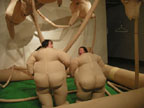
Participation Promotes Growth
Beijing-based, US artist, Rania Ho’s Fatso project “is an interactive installation consisting of inflatable fat suits and a wrestling ring controlled by motion sensors. Made of rip-stop nylon, powerful leaf blowers and motion detectors, audience members are encouraged to don the fat suits, enter the ring and wrestle each other. Any action in the vicinity of the installation initiates the inflation of the suits and the wrestling ring. If there is no one in the ring, the blowers stop and the installation slowly deflates. Each of the suits are linked to the blowers through and intricate umbilical cord-like system.” The project will be set up this summer at ISEA 2006 in San Jose, California. Should be pretty fun to check out! Go Rania! [blogged by Jonah on Coin Operated]
Posted by jo at 04:12 PM | Comments (0)
April 26, 2006
Deep Wounds

Healing and Reconciliation
Built between 1870 and 1878, Memorial Hall honors the Harvard graduates who died in the Civil War while fighting for the Union. Each of these men’s year of graduation, name, date of death and battle of death are permanently inscribed in the marble walls of the transept that serves as the main entrance to the hall. Deep Wounds uses this space to explore unfinished healing and reconciliation.
Entering the transept, we see the Union men's names, dates and battles on the walls; we see the beautiful stained glass windows and cathedral ceilings; and we see that the white marble floor has become luminous in certain central areas with hints of inscribed text. As we walk across these floor areas, the luminous skin blisters and opens to reveal descriptions of Harvard graduates who died while fighting for the Confederacy.

Each man's year of graduation, state, date of death and battle of death are projected onto the floor. Instead of a name, however, we see a relationship such as ‘father’ or ‘classmate’ that describes a family relationship each man had or a relationship he had to schoolmates on the wall. After the uncovering, the skin mends itself, covering the names once again.
The Confederate men are arranged on the floor facing or close to Union men from the same Harvard graduation year. The Union words are etched in red and the Confederate words are written in blue.
DEEP WOUNDS, a temporary site-specific art installation by Brian Knep (website | blog), was commissioned as part of a residency co-sponsored by Harvard’s Medical School (Department of Systems Biology) and Office for the Arts. It's on view through April 30, 2006: Monday – Thursday, 9 am to 7 pm; Friday, 9 am to 4 pm; Saturday, 2 to 5 pm; Sunday, 3 to 5 pm, Memorial Hall, 45 Quincy Street, Cambridge, MA.
Posted by jo at 02:59 PM | Comments (0)
polymorphic [d(eoxyribo)n(ucleic) a(cid)]:
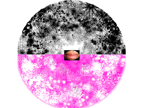
DNA in Love
polymorphic [d(eoxyribo)n(ucleic) a(cid)]: a love story--by Marta Lwin--is an installation of a DNA driven conversation between two people in love. Featuring actual personal DNA sequences mapped to generative language revealing the inner secrets of genetic compatibility. It is on exhibit at the ITP Spring Show 2006, Tuesday, May 9 from 5 to 9pm and to Wednesday, May 10 from 6 to 9pm.
The DNA sequenced are derived from an collaboration between Lwin and scientists at NYU Medical Center, Study of Human Genomics, and the American Museum of Natural History, Center for Comparative Genomics. The are visualized by using two video monitors (with audio), and computers running custom software written in Java. A synergistic interaction exists between the DNA sequence and the custom software to trigger video. The video depicts lips speaking the DNA sequence a mapped to the Roman alphabet. The disembodied lips take turns speaking the code to one another, at times interrupting at other times remaining silent.
The DNA, while invisible is encased in visible plates which are laser etched with contemporary scientific iconography, creating a decorative surface polymorphic [d(eoxyribo)n(ucleic) a(cid)]: a love story looks at the contemporary methodology for encoding DNA, and it's application and ethical ambiguities. The web based documented process of creating the installation comprises the theoretical investigation of turning material DNA into binary information, with special attention to lab process.
Lwin is looking at the current scientific lab practice of extracting DNA, and treatment of human materiality as it moves into binary representation. With special attention to Norbert Wiener's cybernetic theory, Lily Kay's analysis of the inherent informatic bias in DNA science, and theoretical writings by Marx, Deleuze + Guattari, and contemporary thinkers such as Thacker, Massumi, and Agamben.
Posted by jo at 09:52 AM | Comments (0)
April 21, 2006
Willy Le Maitre

Edia and Context Gardens
Saturday, April 22nd, 7pm at The Workman Theatre, 1001 Queen Street West, Toronto: Images 06 will be premiering Edia and Context Gardens, two new works by Toronto based media artist Willy Le Maitre. Both are performed cinema presentations that utilize stereographic video projection. The image is comprised of real time manipulations of volumetric scenes in conjunction with prepared segments of stereo-video. The navigable form of the projected audio and video provide a unique iteration of the work at each viewing.
Edia presents a dynamic psychological space. Resembling a hybrid diagram of molecular structures and astropataphysic theory; the visualization continuously reconfigures itself through the discrete interactions of its¹ constituent parts. Myriads of particles that swarm, hover, interpenetrate are coated in video texture. Through them we glimpse into images of distinct and diverse subject spaces. The spaces segue, meshing one place into another. Where Edia evokes a biological dimension to image; it does so in its¹ depiction of multifaceted matter being foremost a carrier of energy that characterizes reality as being primarily; a play of forces.
Context Gardens is a stereographic visualization of being between cosmos and the quanta. At the center of Context Gardens; the audience converges to board a craft, understood as time. Context Gardens configures an image space in an ecliptic of emergent archetypal influences that exert a tidal power over craft. Charged with event radiation; sonic gas permeates the scene while tiny vesicles form a battery of chemical messengers; conjuring memory¹s image channel. Time is shown volumetrically and revealed to be circular, its¹ present vectored to every past.
Willy Le Maitre has created media art works since 1988. He has been oriented to video as a live form that has served as a pivot point in collaborations between him, musicians, writers and other visual artists. Currently based in Toronto he enjoyed a creative dialogue for over 10 years with New York based composer Eric Rosenzveig. Located in different cities their collaborative system was incubated over the network. Notably with The Appearance Machine; an autonomous system that generated media assets and content streams from the reanimation of consumer refuse and distributed its live results to logged galleries. More recent efforts involved the development of Playlist, a collaborative authoring application and its compliment; disPlaylist a 3d visualization of the multi-threaded media work created collectively by a number of media artists using Playlist. His work has been presented, among other places, at The New Museum, the Kitchen, FIMA in Victoriaville Qc., ICMC in Banff Canada and ISEA. The work has received numerous grants and awards including LIFE 3.0 competition for artificial life artworks and The Telefilm Canada prize at Images Festival of Independent Film, 2000, Toronto.
Posted by jo at 11:10 AM | Comments (0)
April 20, 2006
Petko Dourmana
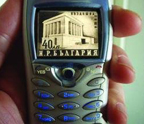
BT_GRAFFITI | Mausoleum_3
The interactive work--by Petko Dourmana--proposes to virtually rebuild the lost physical space of the Mausoleum of Georgi Dimitrov, that used to be the most remarkable public symbol during the Communistic period in Bulgaria, inside the visual and physical space of the entrance at 15 Nassau, New York.
Using Bluetooth technology, visitors are automatically invited to activate it and will receive a series of visual and audio fragments which recreate the space of the former Mausoleum. This newly common-used technology is highly open for communication and in this sense it can be likened to graffiti.
As graffiti in public space confronts passers-by with intentional messages, this work addresses notions of presentation space vs. private space and representations of time and space visually and virtually. [blogged by Emily on Textually]
BT_graffiti project is sponsored by CEC ArtsLink. Produced by InterSpace in association with the Harvestworks Benders and Coders concert series and the 2006 Bent Festival. Presented at 15 Nassau Street in New York City, a venue of the Lower Manhattan Cultural Council. Space donated by Silverstein properties.
Posted by jo at 08:00 AM | Comments (0)
April 19, 2006
Attention Please!
![]()
An Attention Seeking Video Installation
Artist Sara Smith and technology partner Kisky Netmedia are creating Attention Please! An Experiment - attention seeking video designed to measure attention.
Is it possible to measure our impact on space and on art? The attention Please! experiment attempts to answer this question using RFID (Radio Frequency Identification) technology. Audience members, visitors, participants, and collaborators pay attention with their an Attention Card to a piece of video. If you pay more attention, does it work harder to keep it? Other videos may feel neglected and try to attract your attention away; your attention is valuable after all.
Its focus is on manipulating the relationships between art, technology and audience, within and outside of a gallery environment. The concept centres on Sara's aim to explore the notion of presence, aura, and attention and uses emerging and everyday technologies to reveal some of these subliminal and emotional notions.
We live in a world where many services, products and people are continually competing for our attention. Each day our attention is attracted and divided; what to wear, where to eat lunch, where and how to party the night away. We are faced with images, stories, emotions all around us, on billboards, radios, and TV screens. Can our attention be turned within a gallery? What happens if we pay attention to some art more than other art? Will it know? Does it matter? It does now!
The experiment asks nothing more than for you, the audience to give your attention. Pay attention at The Box, FACT, 88 Wood Street, Liverpool, L1 4DQ. 03 & 04 May 2pm - 6pm.
Attention Please! An Experiment is a research project supported through ITEM, the Foundation for Art and Creative Technology¹s research and development programme for new media tools. ITEM is supported by NESTA and Arts Council England.
Posted by jo at 10:24 AM | Comments (0)
March 17, 2006
Acclair

Bio-Data Turned into Financial and Social Status
Acclair, by Luther Thie and Eyal Fried, is a security and neuromarketing service that points to Acclairism, a new form of discrimination based on the individual’s bio-data and membership in an "acclaired" elite.
The project creates a "social fiction" to explore a situation wherein people willingly accept a highly invasive, highly authoritative manipulation in return for tangible rewards and social status. Acclair is a fictional company providing brain-testing services as part of an accelerated security clearance for air-travelers with its use of Brain Fingerprinting technology (BFP).
Before departure, the Acclair member goes through a one-minute brain test in a relaxing environment. His/her brain output is used for security clearance, and then sold to marketing entities interested in his consumerist personality. According to his brain's market value, the Acclair member is rewarded with Capitality credit points that enable meaningful capital benefits and "Amnesty" credit points that provide legal pardons for applicable past offenses.
Acclairism is an attempt to bring to light some of the conflicts and questions brought about by biometric technologies: What defines us as unique individuals? What defines us as trusted members of society? How much personal information will we willingly give away and under which circumstances?
Part of ISEA 2006, San José, this summer. [blogged by Regine on we-make-money-not-art]
Posted by jo at 04:46 PM | Comments (0)
March 13, 2006
Tavofono
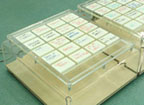
Device for the Definition of Self
If the telephonic conversation is one of the frames of interaction where, according to Ervin Goffman, people play their identity, then the 'definition of the self' and the 'performance' are the founding concepts of Tavofono, the table/telephone created by Crispin Jones, with the help of Sara Manazza, for a children interactive workshop at the Telecom Italia Future Center. The tavofono is an installation whose user can record audio into one of the buttons that make up the table surface and then write on it the name of what he has recorded. He can make a telephone call without speaking directly with the person he is calling, but using the audio that others have created. Over time the table becomes an archive of calls. Telephonic conversation is one of the first social frames that kids play imitating adults. The frame of the performance is the game, where participants play the role of interlocutors following the rules of the prototypical phone call. The Tavofono amplifies the ludic attitude of this symbolic interaction changing its rules: the physical presence of the speaker is not necessary to activate the conversation; what one of the two participants says is a mash up of portions of registered speech, and the outcome of the exchange is surreal. Thus the Tavofono seems to be a 'Smile Machine' for the definition of the self." -Valentina Culatti, NEURAL.
Posted by jo at 12:30 PM | Comments (0)
March 03, 2006
Ben Rubin
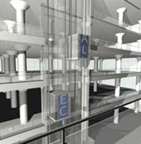
Word Up
Minneapolis’s new central library, designed by Pelli Clarke Pelli Architects and opening in late 2006, will include an electronic light sculpture provisionally named Word Up by multimedia artist Ben Rubin. The project uses a matrix of LED tubes on the outer surfaces of each of two elevator cabs.
As the elevators move between floors, the LED displays will reveal, letter by letter, titles of books. Drawn from the library's database, the ever-changing text may reflect the titles of books that have recently been checked out, reshelved, or searched in the online catalog. The system is being developed with David Small Design so that the elevator position sensors can communicate with the LED displays and tell them when to display the titles. In the context of the building's glass atrium with elevated walkways, the climbing and descending book titles seem to evoke the idea that library patrons have become part of a giant reading machine: the LED signs will, says Rubin, "scan as if they were text hanging in the air."
The project also emphasizes the more current model of a library as a node in a network of information flows. Animation. Related: The Source, Making Visible the Invisible. More about architecture as interface. [blogged by Regine on we-make-money-not-art]
Posted by jo at 02:27 PM | Comments (0)
February 23, 2006
Brooke A. Knight

Every Environment is Text-Rich: Framingham
Every Environment is Text-Rich: Framingham, by Brooke A. Knight, is one of a growing series of artworks that concern themselves with the interaction between the landscape and our reading of it. I believe that every place carries with it a history -- either social, political, natural, or geologic -- and that the history becomes a "text" that is inscribed onto the landscape.
The piece uses a remote robotic camera that is trained on downtown Framingham. While the image is of a typical Massachusetts downtown square, the camera moves to spell out letters that write a text onto the scene. That text is the grant that gave Danforth (after whom the museum is named) two-thirds of current day Framingham. In essence, EEITR:F is writing the history of the town directly onto the town. It is a kind of ephemeral grafitti, making the historical current, and tying the past to the place.
At the Danforth Museum, Framingham, Massachusetts; February 22-April 19, 2006. Reception and Artist Talk on February 26, 1:00 p.m.
Posted by jo at 05:54 PM | Comments (0)
Human Avatars
![]()
The Guilt Eye
Human Avatars, a multimedia installation created by Andrea Zapp with the Vini Reilly's music, plays on two classic levels: the real and the virtual. The visitors have to walk through the installation's space, discovering a small wood cabin, which they are asked to enter. Once inside, the bodies are shot and projected into a scaled down model of the same cabin. Peeking through a small window the visitors can look at the movements of their own projections and at others made by other persons. The crossed game of shooting and projecting pushes everybody to have a visual contact with a different 'self', that could equally be a real person or his own avatar, assuming the role of a spy and, unconsciously, of a person kept under surveillance. Despite the architectures and the scenario are friendly and accessible, the interactive experience immediacy remains pending and ambiguous. Probably one of the inhibiting elements is the same interactive fulcrum. The eye and its artificial replacement often carry uneasiness, because they are connected to the surveillance and control feeling. Furthermore, in this case, the holistic lyricism, made by the consciousness raising of one's own being in the world is suffocated by the voyer's sense of guilt. This role is evidently assumed by the observer, enhanced because it's not a hidden spying activity, but an a vile act, made for all the world to see." Francesca Tomassini, Neural.
Posted by jo at 10:17 AM | Comments (0)
February 22, 2006
Nancy Nisbet

Pop! Goes the Weasel
"From closed circuit TV and video monitoring, email snooping software such as Carnivore, tracking through credit card usage and location mapping via GPS enabled cell phones; surveillance is omnipresent. It may not be the act of surveillance but rather the collection, storage and use of our ‘data identities’ in a centralized database that presents the greatest threat. Who will have access to the database? How will the data be used? How will people be protected from data profiling and marginalization? Widespread concern for public security is generating significant support for surveillance, authentication and information gathering systems. The possibility of the convergence of databases of collected surveillance and other information presents serious threats to personal privacy and freedom.
Pop! Goes the Weasel, an interactive art installation exhibited in Nagoya, Japan in 2002, explores resistance to the use of Radio Frequency Identification (RFID) as a human tracking system. Identities are blurred as RFID tags are shared. The significance of the collected data is shifted as visitors repeatedly interfere in the system. A video projection containing the implantation of an RFID microchip into the artist’s hand and a visible real-time reflection of visitors being tracked accentuates uneasiness.
This installation aims to remind participants of the ubiquity of surveillance structures and to encourage visceral responses to implanted RFID tags as a potential future mode of surveillance. Although the installation appears to require visitors to follow certain ‘rules’, the observance of these rules stems from participant’s own respect or lack of respect for these rules. The system is really quite leaky and allows motivated visitors to avoid surveillance and develop other ways for engaging the work without accurately being tracked. This art installation presents visitors with opportunities for experimenting within an RFID system by allowing them to avoid it, to subvert it and to intervene in it as possible strategies of resistance.
Pushing beyond the spectacle of implanting two RFID microchips into my body, I make a bold and playful entrance into resistance of sanctioned surveillance. I challenge the authentication systems assumptions regarding identity. Is a person’s identity singular? Is it constant? What is its connection to the body? Is identity positively ascertainable? In the installation identities are distributed as visitors share their ID badges; one badge is no longer connected to a single person but some anonymous group of users. In the case of my own ‘identity’ the implantation of two unique microchips allows for a multiple identity; which ID number is the authentic one? By provoking questions concerning authentication systems I aim to encourage resistance and challenge both developers and governments to ensure the protection of personal privacy and freedom." Nancy Nisbet, Risky Surveillance: Distributed and Multiple Identity(ies) as Resistance, Subtle Technologies Conference, 2003. [Related 1, 2, 3]
Posted by jo at 07:15 PM | Comments (0)
February 21, 2006
aperture

New Channel for Communication
Aperture is a facade installation with interactive and narrative displaying modes. Consisting of an iris diaphragm matrix, the facade's surface with its apertures' variable opening diameters is enriched by a dynamic translucency, that creates new imagery as well as a new channel for communication between inside and outside.
Working on the topic "intelligent surface/sensitive skin" for the Digital Media Class at the University of the Arts Berlin, concept and prototype were conceived by Frédéric Eyl and Gunnar Green. Support by Professor Joachim Sauter and Jussi Ängeslevä [via CULTURETV]
Posted by jo at 11:59 AM | Comments (0)
Giselle Beiguelman
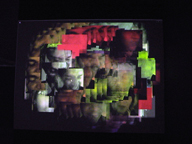
Sometimes Always/Sometimes Never
Sometimes Always/Sometimes Never are a set of two wireless interactive installations by Brazillian artist Giselle Beiguelman, presented at Life Goes Mobile, São Paulo, 2005 (Sometimes Always) and Festival Internacional de Linguagem Eletrônica, São Paulo, 2005 (Sometimes Never).
Sometimes Always discusses the visual horizons of nomadic culture and its entropic and saturated environments. Its point of departure is that nowadays life is seen through windows and screens and each moment seems a movie frame that consumes and erases itself as soon as it is processed. The project consists of an interactive projection, based on generative systems, which allow the audience to shot images with cell phones with video cameras and send them via Bluetooth to big screens. On mouse over, the videos fragments in frames can be reorganized by the interactors, following the movements and draws they do with the mouse. When they interrupt the action, the videos restart without erasing the mosaic of images that was built by their activities on the screen. An intriguing image of difference and repletion emerges there. Always.
Sometimes Never is a (de)generative video which is decomposed through the inputs of its interactors. Videographic images, shot with mobile phones in the exhibition space, can be manipulated by keyboards and mouse and the audience edits, in real time, the order of its original frames, their position on the screen as well as introduce colored filters on the new images. When someone leaves the mouse, the original film restarts over the layers built by the interactors. The result is an imagetic and dynamic palimpsest, that consumes itself following and entropic logic where saturation produces erasing and fluid memories. The project dialogues with the series Sometimes Always, where the audience also shots images with mobile phones to be deconstructed by the same algorithmic process used here. In spite of their methodological and technical equivalences, Sometimes Always and Sometimes Never, are very different in their results and cognitive processes. In Sometimes Never the manipulation of images do not produce an entropic mosaic, but instable saturated palimpsests where it is impossible to repeat an action. Never.
(project descriptions by Giselle Beiguelman)
Giselle Beiguelman
Sometimes Always, 2005
Sometimes Never, 2005
Posted by luis at 09:40 AM | Comments (0)
February 08, 2006
Keith Armstrong, Charlotte Vincent, Guy Webster

Shifting Intimacies
Shifting Intimacies is an interactive/media artwork by Keith Armstrong, Charlotte Vincent and Guy Webster that invites the participant to meditate upon and witness the human body disintegrating and transforming whilst in motion.
Each participant enters a large, dark space (20m x 8m) alone. They see two circles of projected film imagery, one on a floating disc of white sand and the other on a circle of white dust. Sounds sweep up and down the space through surround sound, whilst participants’ movements direct and affect the filmic image and audio experience. Throughout the work a layer of dust (an artificial life form) slowly eats away and infuses itself deep into the imagery. This immersive work invites differing states of meditation, exploration, stillness and play and moves through states of eternally shifting balance in ways that produces a heightened awareness of the body.
The work uses a range of technologies including interactive video (Very Nervous System), body heat sensors, custom built electronics, image databases, real time computational synthesis software (Opcode Max), networking software, real time audio digital signal processing (Max MSP) and real time show control protocols. Controllable actuators also move physical material through the air.
Historic Project Blog: http://www.embodiedmedia.com/SI/si.html
Event: Shifting Intimacies, Capture 4 Award, 2006
Venue: The Institute of Contemporary Art (ICA), The Mall, London
Times: 16 February (noon) until 21 February (7.30pm)
Contact: ICA Box Office
Phone: +44 20 7930 3647
Vincent Dance Theatre: http://www.vincentdt.com/curshifting.htm
C4 Home: http://www.portlandgreen.com/capture4/
Posted by jo at 02:37 PM | Comments (0)
GFPixel
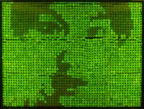
Living Portrait
GFPixel is a "painting" made of genetically transformed bacteria. The organisms are cultivated in about 4000 Petri-dishes that are arranged as a portrait. Like on digital screens part of the bacteria produce the green light – the Green Fluorescent Protein-gene is switched ON and in the other part the GFP-gene is switched OFF.
The works plays with the border between living world and the digital world, the portrait seems to be digital but it lives and dies during the exhibition. A work by Austrian media artist Gerfried Stocker and molecular biologist Reinhard Nestelbacher. More images (click "Gallerie und Details").
GPF Pixel can be seen at Medialab Madrid until April 2, as part of an exhibition of the most outstanding projects of digital culture which have won prizes in recent years at Ars Electronica in Linz, Austria. [blogged by Regine on we-make-money-not-art]
Posted by jo at 11:57 AM | Comments (0)
February 02, 2006
UBERMORGEN.COM
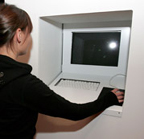
G3 – Bureaucrazy
What does the term "authenticity" amount to in the age of digital replication? In their installation G3-Bureaucrazy the Austrian artists group UBERMORGEN.COM investigates this question. The suggestion of bureaucratic lunacy is meant to be taken completely seriously. With the help of four software generators, including an injunction generator and a bank statement generator, digital documents like bank statements, identity papers and court judgments are produced in personalised form and can be printed out on the spot. By characterising these documents as being no more than ink on paper, UBERMORGEN.COM call into question the arbitrary authority of every bureaucratic system. The installation forms part of the polemical series [F]originals – forged original documents. At Transmediale 06.
Posted by jo at 03:58 PM | Comments (0)
Jean Pierre Gauthier at Transmediale 06
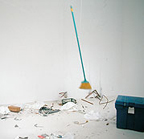
Household Objects Revolt!
Jean-Pierre Gauthier's mobile sound installations express the delights of disorder. He takes daily objects out of their context, rearranges them and sets them going in autonomous movement sequences. Most of the works of Gauthier consist of objects which can be identified, but which do not trigger any emotional or cultural associations. A characteristic feature of his installations is the use of household articles and cleaning products, which may be read as a kind of commentary on prevailing social circumstances. The things make themselves independent, declare revolt and bear a symbolic reference, as a closed microsystem, to aspects of commercial exploitation and economic cycles. In his installation Remue-ménage the artist also succeeds in involving the residual waste of the exhibition's architecture. The analog animation movements of the gadgets lend the installation a faintly antiquated character – an altogether unusual, but deliberately chosen form in contrast to the technological development. At Transmediale 06.
Posted by jo at 03:43 PM | Comments (0)
Transmediale 06: Maurice Benayoun
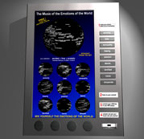
Emotion Vending Machine 2006
Also at Transmediale 06: Maurice Benayoun's Emotion Vending Machine--The mechanics of the world’s emotions evolve in the zone where economics and politics converge, in the world of product placement. Through its concept of artistic merchandizing, the Emotion Vending Machine deals with the production of emotions in an ironic way. The Machine takes Internet data as a global pool of emotions. Users can select up to three emotions from a list of nine emotional states, including hate, desire, or despair. The emotions are represented by 3D-maps of word clusters, extracted from the web and generated in realtime.
These maps show the emotions of the world as they are present on the web at that moment, mapped onto the actual position of major cities on the globe, a mix which can also be read like a music score. The musical interpretation deciphers the cities and their emotional polarity to produce a specific musical result by adapting rhythm, coloration and evolution to the selection of the emotional states made by the user. After listening to the personal result through the integrated speakers, users can plug in their USB stick or MP3 player to load their emotional sound remix.
Music: Jean-Baptiste Barrière; Software: Birgit Lichtenegger, Artem Baguinsky, Marloes de Valk (V2); Production: CITU, Paris.
Posted by jo at 03:32 PM | Comments (0)
February 01, 2006
CONFESS.OR
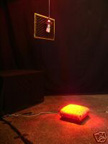
Religion for Rent on eBay
CONFESS.OR is one of the first pieces of Gerhard Schwoiger's ReReligion, a series of works that reflect on the place of religion in everyday life and investigate its Zeitgeist and adaptability.
Upon entering the room the visitor becomes part of an open confessional situation. Once s/he approaches one of the candles or places an ear on it, a single voice can be distinguished from the muddle of voices which forms a wall of noise at a moderate volume. The lattice of the confessional – the single element that is left in its original form – floats over the floor with a microphone in the back part of the room.
Kneeling upon the cushion, summons a female's voice, inviting one to confess. This enables those who avow to make an anonymous confession to the public. Upon leaving the cushion, the confession is automatically over. A confession that manages without the power apparatus of the church, without obligations. Once the confession has been made, it will be meshed with the sounds of previous confessions and omitted out of a few candles in the room. Judgment over the sins of others is placed in the hands of the individual.
Current confessions are available as podcasts (for example for your way to work). You can rent or buy the system on eBay. Acution runs for the next 10 days. Related: Pray as you go, mobile confessions, etc. [blogged by Regine on we-make-money-not-art]
Posted by jo at 11:34 AM | Comments (0)
January 27, 2006
SweetPad
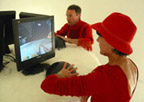
paradoxical videogame interface
Do you remember Quake 3 Arena et similia? The so-called shoot-em-ups, where you fight against anybody else and where the only goal is to score the highest number of frags? That one that cause a cramp in your hand because of the nervous joystick grip and of the hyper-kinetic movements of the thumb for shooting as much gunshots as possible? Stick in mind the goal and forget the rest. SweetPad is an installation by France Cadet, a french artist that works with the behavioral relationships of the individual, related to the artificialness of life. Here the players, in a multiplayer environment, have to kill the highest number of enemies without being aggressive or impulsive. So far the only way to play is the stay calm and gently caress the pads that will mildly obey, shooting mortal gunshots everywhere. It's not acceptable to lose control of the situation and let oneself go to upset gestures, otherwise one is banned to go on with the action. With this mechanism made out of a few simple rules, Cadet primes a real cognitive revolution, investigating the individual ability to manage a so paradoxical situation as that of quietly killing an enemy - even if a virtual one - making a gesture - the caress - that is socially interpreted and received only as a love expression. [Francesca Tomassini, neural]
Posted by jo at 02:20 PM | Comments (0)
January 26, 2006
BE[AM]

Us versus Them
BE[AM]--by Marie Sester--is a spatially interactive installation which displays visuals from a database of American pop culture and offers the visitors control of familiar iconic characters within our increasingly treacherous media environment. BE[AM] seeks to point out the political intoxication and "us versus them" mentality that is gaining prevalence as the lines between entertainment and portrayal of military combat quickly vanish. Charlie Chaplin, Wile E. Coyote, and Super Mario appear in contrast to projections of the American pop landscape: Hollywood productions, TV broadcasts, and video war games. The viewer's interaction with the superimposed icons creates a critical distance from popular media, providing a space for rethinking of large-scale, long-term cultural forces in reference to the daily lives of individuals.
BE[AM] projects video imagery throughout a public space using a robotic projector and employs video game controllers via Max/MSP, Jitter, and OpenGL. [via Jonah on Coin Operated]
Posted by jo at 10:43 AM | Comments (0)
[Stop]Kontakt
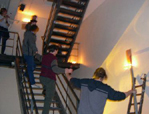
Conductors > Circuits > Chains
Kontakt and Stopkontakt are two similar installations, based on the same principles, but aiming for a different audience. They both are interactive installations that focus on making contact with others, resulting in a variety of physical and/or auditive outputs. Its purpose is to close several electronical circuits, using your body as a conductor between different touch/conductivity sensitive points. Depending on the location of presentation, we have changed the interface accordingly. Walls, staircases and sinks become part of the installation as they are turned into touchpoints, resulting in a very spatial experience. This piece celebrates collaboration and cooperation, as a singular visitor can't close all the possible circuits alone.
'Stopkontakt' is focussed on children and generates more physical outputs compared to 'Kontakt', which is more sound based and less direct responsive as it is build for an older audience. Related links: Karmen and Making Things. [via Regine on we-make-money-not-art]
Posted by jo at 09:35 AM | Comments (0)
January 23, 2006
Fyra ofoner
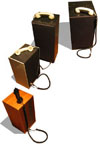
Invitation and Unwritten Score
Fyra Ofoner (Four Ophones)--by Erik Sandelin and Magnus Torstensson--is an invitation and an unwritten score for a composition that lasts as long as the exhibition does. You and other visitors take part as audience, musicians, and co-composers. No one knows what will happen or how it will sound. Be prepared for everything from subtle interference etudes, to collaborative chanting and big, bad rhythm orgies.
An ofon is a loudspeaker with an attached telephone headset. When a visitor has recorded a sound into an ofon, it is repeated infinitely until another sound is recorded into the same ofon. When all four ofons are used, no one can predict what will happen or how it will sound. Videos on the website. [blogged by Regine on we-make-money-not-art]
Posted by jo at 02:58 PM | Comments (0)
Thomson & Craighead
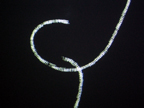
Audio and Visual Machines
January 26 – March 3, 2006 at Mejan Labs: Akademigränd 3, SE-111 52 Stockholm, Tel: +46(0)8-796 60 30; info[at]mejanlabs.se Open: Tue-Fri 11-17, SAT-SUN 12-16, closed Mondays.
At Mejan Labs Thomson & Craighead present two installations; Decorative Newsfeeds and Unprepared Piano. Decorative Newsfeeds could be described as a digital automatic drawing -a sort of contemporary update of Jean Tinguely’s drawing machines perhaps, but in this case with readable authentic up to the minute news headlines gathered in real-time from the web. The headlines are updated continuously and projected in evolving trajectories that weave and intersect each other according to a simple set of rules.
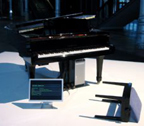
In Unprepared Piano, a Yamaha Disklavier grand piano is connected to a database of music MIDI files appropriated and compiled from all over the web. This library of found data is then “performed” automatically in the gallery with the full authority one associates with a concert grand piano. Each MIDI file contains an electronic score for a whole piece of music with different tracks for different instruments. When the piano plays one of these scores, it switches between the tracks randomly, which means it will sometimes play a piano part correctly but may also render drum parts, string sections and marimbas etc. in awkward configurations and combinations. On a monitor it is possible to see real-time information about what is being played.
The title Unprepared Piano specifically references the composer John Cage and his method of preparing a piano by fastening nails, coins and so on directly onto the strings inside the instrument, and in doing so to change the sound of it when played. But the title also refers to the piano being unprepared for the information it accesses and with no human performer and no way of knowing exactly what might be performed, Unprepared Piano becomes an endless generative mechanism for the performance of unique musical improvisations.
Thomson & Craighead: British artists Jon Thomson and Alison Craighead have been working together since the early 1990's. They are considered to be among the leading artists on the British new media art scene. Much of their work to date has paralleled the development of Internet technology by way of more traditional media such as video, sound and gallery installation, and they began working with electronic networks and communications systems when the world wide web first appeared in the mainstream around 1995. As this technology has improved and internet connections have become faster, they have begun to re-combine internet technology with their gallery work exploring the consequential possibilities of linking the internet to these kinds of physical spaces.
Thomson & Craighead often use the web as a gigantic database, procuring and reconfiguring existing material in real-time to offer new meanings and perspectives on the way in which we all might perceive the world around us. This kind of approach is in keeping with many methods used across the whole canon of contemporary art: real-time and generative processes, randomness, the recycling and misuse of information and technology and a process based flow that goes from one stadium to another.
Posted by jo at 10:13 AM | Comments (0)
January 19, 2006
Computational Poetics at Upgrade Vancouver
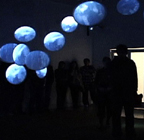
One River (running)
Join us Thursday, January 26th at 8pm for a discussion with Kenneth Newby, Martin Gotfrit, Aleksandra Dulic and Dinka Pignon, who will show us One River (running) and talk about their work with the Computational Poetics Research Group. As always, we will adjourn after the talk to the Whip Gallery [209 east 6th avenue] for a drink and some chatter.
One River (running) is an interactive, immersive audio environment designed to create both a visual and audio experience of rivers using a complex system of moving sound, moving images, and a physical structure also designed to echo the river¹s undulating geographic form. The artwork¹s images originate from digital photographs of people¹s mouths whom the team interviewed. These still images were then algorithmically programmed. The mouths recognize the voices, and move as though they are speaking the words they hear. The artists created a voice recognition software program to do this synchronization. The video is listening and responding to the audio. The piece was recently exhibited at the Surrey Art Gallery.
Kenneth Newby, Martin Gotfrit and Aleksandra Dulic are part of the Computational Poetics Research Group, a research project that works at the intersections of art, culture and computation and aims to articulate some of the features of an emergent poetics of digital art performance while developing a tool-set to enable artists working in the computational medium to create, present and document their work. A key objective of their work is to share the compositional process and the issues that arise in the work of interdisciplinary computational media performance. Contemporary computational techniques enable creative and performing artists to enter into new collaborative relationships with encoded systems.
Upgrade! Vancouver
When: Thursday, January 26 at 8pm
Where: Western Front, 303 East 8th Avenue, Vancouver, Canada FREE! Everyone welcome.
Posted by jo at 09:39 AM | Comments (0)
January 17, 2006
Constanza Silva
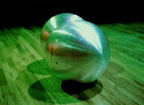
Silverfish Stream, Relational Sound Spheres
Constanza Silva is a new media artist who creates complex interactive environments where sound and robotic are the essential elements of a connected network. Silverfish Stream is her most recent artwork and, according to the author, 'it is a sensual, poetic, exploration of the potential of human-machine interaction'. Two aluminum spheres equipped with sensors occupy the physical space of a gallery, ready to react to inputs. The presence of the viewer modifies their initial state of immobility and becomes the input for the movement that seems to be autonomous. The two spheres roll on the floor interacting together like in a pas de deux choreography, but with a certain level of unpredictability caused by their slight unevenness and ridges. The viewer seems to be excluded from the movement, while he is the source of energy and an active part of the scene. The sound generated by the friction of the metallic robots against the floor, like that created by the contact between man and machine, is registered, altered and played in real time by the spheres, each with its own tonality, and amplified in the room. What is generated is a stream of multisensory information (visual, auditive, tactile), natural environment for mechanic creatures. Being the robots non-anthropomorphic clarifies the aim of Silva that is focusing the direction towards which the technological innovation is oriented within the human-machine interaction that is not a reproduction of human beings relations but a new kind of interaction. [Valentina Culatti, neural]
Constanza Silva is a new media artist who creates complex, sound and robotic environments by setting minimal forms in motion within networked, interactive systems. Since 1995, she has integrated performance, video, sound, and electro-mechanical elements to explore embodied experience and agency within natural, technological and political ecologies. The environments she creates are dynamic fields in which the concrete and the incorporeal—metal forms, fleshy bodies, information and sensation—pass into and transform each other.
Silva holds an MFA from Concordia University, Montréal and a BFA from the Emily Carr Institute of Art and Design in Vancouver. Her works have been exhibited in Vancouver, Toronto and Montréal. Over the last decade she has participated in numerous projects, exhibitions and performances, some of which include: Iguana/Iguana Confirmed (2004) Techno experimentations in gallery, DARE-DARE, Montréal; Sin ruido, en memoria (2002), Transito, Marché Bonsecours, Montréal; and Flagrante Delicto (2001), Planet In Focus, the Toronto International Environmental Film and Video Festival. She has received awards from private foundations, the B.C. Arts Council, le Centre interuniversitaire des arts médiatiques, and the Canada Council for the Arts. Silva was born in Colombia and raised in Canada. She is currently working and residing in Montréal.
Posted by jo at 09:55 AM | Comments (0)
January 10, 2006
Gun Control
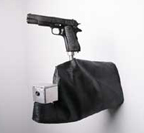
Panoptic Insecurity
Gun Control, by Scott Kildall, explores issues of both security and surveillance. Each of the four units incorporates a police-issue revolver and a video camera. As people move into the installation space, the cameras track the movement and the guns follow.
However, the system does not always function properly. The revolvers point at different targets. They sometimes twirl about playfully. The armatures shake and rattle. Visitors are directly in the line of fire. This piece raises questions about our security-surveillance apparatus by prompting a visceral reaction. (videos)
Can't help but mention an installation I saw recently at the ZKM in Karlsruhe (Germany.) When Swedish artist Jonas Dahlberg moved to a new apartment in 1995 he discovered that from his windows he had an unimpeded view into his neighbour's house on the other side of the street. The wall in there was decorated with an arsenal of weaponry. This threatening image in his existence prompted the artist to furnish his own apartment only as far as the zones that the other man in turn could not see.

His experience inspired Safe zones, no. 7 (The toilets at ZKM). Monitors placed next to the door of the public bathroom make visitors imagine that the toilet space is being monitored by a camera. Once inside, people notice that what was being monitored is in fact a detailed model of a toilet, placed in the same space. (more)
Related: the (in)security camera, Apple's Place and the insecurity guard. [blogged by Regine on we-make-money-not-art]
Posted by jo at 08:52 AM | Comments (0)
January 09, 2006
The Palace at 4 AM
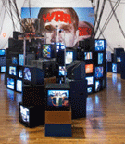
Wartime Voyeurism
New York artist Jon Kessler's recent video installations have focused on contemporary politics, representations of war, and the pleasures and problems of surveillance. His most immersive work to date, The Palace at 4 AM, is a room-sized anthill of flashing monitors, spider webs of cable, and an arsenal of rotating video cameras installed at P.S.1. Contemporary Art Center. The cameras are trained on free-standing images taken from footage of the war and political events. Like Hollywood miniatures, each briefly creates a false reality before the camera jerks away to focus on a different scene. Kessler also perforates the images, allowing flashes of the real gallery to penetrate his virtual war. Through the holes, people watching the monitors catch glimpses of other visitors between the dizzying presentations of politicians and explosions. This produces the giddy paranoia of watching and being watched, but the surveillance doesn't end in Kessler's closed-circuit. Until the show closes on February 6th, two of the cameras are streaming live to the internet. Tune in during P.S.1 gallery hours to watch bewildered visitors explore the installation--while they revel in being watched. - Bill Hanley, Net Art News, Rhizome.
Posted by jo at 10:46 AM | Comments (0)
December 15, 2005
The Rules are no Game
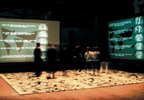
The Dance of Dripping: Auto-Generating Text
The Rules are no Game [MAOD] by Markus Huemer: The ZKM/Center of Art and Mediatechnologie will house a networked installation based upon Jackson Pollock’s image »No.32«. The floor of the area is covered with a reproduction of Pollock’s said picture as a reference to »The Dance of Dripping« and to »All Over«. Two text projections with auto-generating sentences are randomly projected on two screens. The visitors are both receptors and producers of the projected texts. In order to read the text, the audience will move to and fro, triggering an Internet-mechanism through the sheer act of walking on Pollock’s picture. It is this mechanism that generates the text, and each visitor’s movement will lead to the generation of a new line of text. Additionally, when the visitors approach one of the projections in order to read the texts, the sentences will be generated on the second projection. Thus the two projections communicate with each other and the visitors, paraphrasing the relative positions of the visitors within the exhibition space from a point-of-view that is situated on the Net, i.e., outside the exhibition.
All generated texts will use the subjunctive mode (conjunctivus irrealis and potentialis) and the texts are accessible on the Net via any Internet gateway. What results is an inversion of the »classical« exhibition situation–here, Art watches the audience and reacts to their actions with a continuous transformation of its self. By their movement in the space, the visitors will revive the »Dance of Dripping« on the »prefabricated« Action Painting by Pollock, their actions being monitored and »interpreted« by the Net generating the textual response. Through this immersion into the »virtual outside« the visitors will lose their status as subjects and become the objects of a description by the Net. [via Regine on we-make-money-not-art] [Related]
Posted by jo at 04:46 PM | Comments (0)
DriftNet
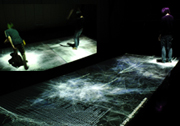
Surfing Data Waves
When I think about the word "NetSurfing", I found that we are net surfer(s) who can't swim. In a different word, we are never free on the net without browser ready-made surf board.
In the DriftNet installation, users interact with a data-wave by using their body like they would on a real beach. "DriftNet" connects to the World Wide Web. The first website DriftNet accesses is chosen depending on the location of the exhibition site. The data is displayed in hexadecimal format [on the floor] without encoding. The screen shot of the website covers the surface of the wave, is decomposed into an abstract color element and generates unlimited variations of wave appearances. Movements of the audience are analyzed and conveyed to the wave as the vector of the plural forces with location, direction and integer value.
When the wave is moved fast, the link from the URL which generated the wave comes to the surface. After some time, the wave of the first link fades out and "DriftNet" chooses the next URL (the one which is nearest from center of floor.) At this time, the audience can't control the behavior of "DriftNet". It is decided by the condition of the wave as the result of accumulation of audience action. And "DriftNet" accesses the web site and downloads the data. And data-wave surges to the audience again...More Photos. Movie. Also by Hirakawa Norimichi: Global Bearing. [blogged by Regine on we-make-money-not-art]
Posted by jo at 09:10 AM | Comments (0)
December 14, 2005
Found Connections
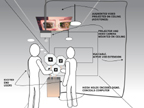
Found Through 'Lost'
Found Connections--by Michael Ang, David Bamford, Joshua Dickens and Karl Channell--allows you to re-experience the narrative of Lost by interacting with other individuals in the physical space and discover your hidden connections through augmented reality. Hold up your fan (with a 4x4" tracker marker printed on it) in front of our installation. Live video is augmented with graphics which reveal a virtual character from the TV show Lost. When more than one character is on the screen, the connections between those characters are visualized between them on the screen. Reverse the fan to find out more details about your connections.
Found Connections is an interactive exploration of social interaction and connections between people using the characters and storylines of the television show Lost as the content. The show Lost is rich with mystery, and hidden meanings; everything from the multiple sides of different characters to the paranormal activity on the island. We want to create the same type of mystery within the Winter Show by giving visitors a simple fan that has hidden content within it that's revealed in front of our installation.
Through augmented reality software these connections are made visible on a plasma screen (or possibly projection) display. The tag on the user's fan turns into a graphic of a character from the TV show and once other users stand in front of the same screen, lines are drawn connecting them as audio, text bubbles and video content from the show are triggered based on which characters are interacting.
This interest viewers based on the interesting content of Lost by really allowing them to take on the role of their character form the show. On another level it also spurs real life interactions with whoever the viewer happens to have a connections with. It reveals hidden connections through augmented reality using lost and also connections that person may happen to have with someone around them.
Part of the ITP Winter 2005 Show.
Posted by jo at 11:53 AM | Comments (0)
December 12, 2005
Ruark Lewis and Rainer Linz
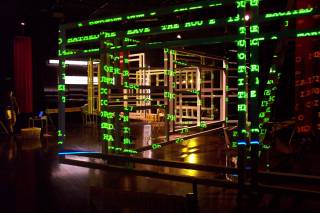
Banalities for the Perfect House
Banalities for the Perfect House--by Ruark Lewis and Rainer Linz--is a collaborative installation & performance work premiered at Sydney's Performance Space theatre on Sept 9 2005. The work proposes the house as a condition through which we perceive the world - the city an extension of grid-like structures viewed through the "frame" of an open window.
Performance texts are distilled from everyday sources including newspapers, cookery books, and snippets of overheard conversation. They consist of seven Banalities: Banalities for the Perfect House, Banalities for Napoleon, Banalities for the Modern Kitchen, Banalities for Solid Mandala, Banalities for Newspapers, Banalities for the Times and Misreading Barricades.
The texts are inscribed on all architectural surfaces, and take the form of performance scripts as well. These include cards, looseleaf and bound pages, and word sequences printed on ticker tape.
The sound is performed on five computer terminals and distributed through a 4-loudspeaker sound system. It is performed using real-time computer processing of original vocal samples, in turn derived from the written texts. The computer sound-generating software was purpose-written for the piece.
The performance space is arranged with wooden frames, boards and barriers resembling, in abstract form, a housing construction site. Each surface is rendered with text creating an immersive environment that can literally be read, and heard as speech.
The work is built around a series of duet and solo performances. Each is based on an individual text, which is the common basis for both the computer and vocal renditions.
The Perfect House is a construction site for ideas, with performers and audiences traversing it as if through rooms made from words whose meanings, too, are still under construction.
Posted by jo at 12:36 PM | Comments (0)
December 05, 2005
Carnevale 3.0

A Database of Lived Experience
In Carnevale 3.0--by Reva Stone--a life-sized, double aluminum cutout surrogate of the artist as a young girl moves through the gallery space on a robotic platform. Sandwiched between two identical cutouts are a small video camera and a small video projector. As visitors enter the gallery space, the figure interacts with them by turning and moving toward them. At random intervals, their image and movement is video captured. These images are combined and overlaid with previously stored images and projected outward from its metal body through the small video projector. Carnevale 3.0 carries images from each of its venues to the next, building a database of lived experience in which the captured video images become memories of the original event. As a mediator of experience this robotic entity has the ability to manifest human behavior by generating responsive movements, processing information, and accessing long term or short term memory. Recollection, physicality and sentience become mutable entities. [via Rhizome]
Biography
Reva Stone is a Canadian artist who creates computer-assisted installations that have engaged with a variety of forms of emerging technologies—interactive installation, robotics and most recently responsive 3D environments. She explores issues surrounding technology’s augmentation and alteration of the human body by creating works that seem to mutate, evolve, and respond with a life of their own.
Stone’s work has been exhibited at the Walter Phillips Gallery at the Banff Centre for the Arts, Banff, Alberta: Musée d’art contemporain in Montréal, Québec: the Canadian Museum of Contemporary Photography, Ottawa, Ontario: La Chambre Blanche, Québec City, Québec: The Winnipeg Art Gallery, Winnipeg, Manitoba: Gallery 44, Toronto, Ontario: the Mackenzie Art Gallery, Regina, Saskatchewan: the Dunlop Art Gallery, Regina, Saskatchewan and the Musée Régional de Rimouski, Rimouski, Québec. In 2001, Stone co-edited an anthology titled The Multiple and Mutable Subject published by the St. Norbert Arts Centre, St. Norbert, Manitoba. In 2002, her robotic work, Carnevale 3.0 received an honourable mention from Life 5.0, Art & Artificial Life International Competition, Fundación Telefónica, Madrid, Spain.
Posted by jo at 11:45 AM | Comments (0)
November 29, 2005
Don Ritter Performances
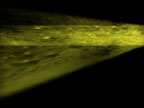
Digestion and Badlands
Don Ritter Performances in Budapest, December 4, 2005; Intro Festival Millinenáris Park, Budapest, Hungary.
Digestion:
Influenced by early 20th Century experimental animation, Digestion presents organic imagery--originating as boiling water--that is interactively transformed into a series of mechanical movements with synchronized sound emanating from the imagery. Using a pair of networked computers, viewers are presented with a hypnotic experience of multi-channel imagery that is controlled by sound. The seemingly unpredictable nature of the work provides an internal interactivity which can be observed by an audience, but not controlled.
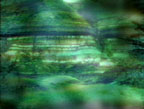
Badlands: Processed imagery of the Canadian Badlands are controlled and manipulated by live music. One or two networked computers use a musical analysis of live music to control clip selection, tempo and cinematic features of the video.
Since 1988, Don Ritter's interactive performances have been presented at festivals, museums, and galleries in North America and Europe, including the Art Institute if Chicago, New Music America (New York), Montreal Museum of Contemporary Art, and Steim (Amsterdam). [Related]
Posted by jo at 12:13 PM | Comments (0)
November 28, 2005
DISTANCE
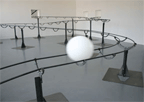
Introducing Disturbing Elements into Neutral Art Venues
Configured as a rollercoaster, Distance, created in 2004, explores Jeppe Hein’s interest in art as a game. Consisting of a set of rails roughly 1,000 feet in length, Distance dips and rolls, continually switching back on itself in loops. As the viewer enters the exhibition space, he/she activates a sensor that shoots a large white ball along the rails along which it will roll through twists and turns in the gallery space. The viewer is able to follow the ball’s course by foot, tracing its movement across the gallery and at the same time, becoming an active participant in the installation. Hein revels in exploiting the deceptive potential of his work. His installations can best be described as interventions since they introduce disturbing elements into neutral art venues or public spaces that destabilize the art viewing habits of the gallery visitor.
The pared-down geometrical objects in these installations obey the formal principles of minimal or c onceptual art, but in keeping with Duchampian tradition, they become real works of art when the viewer innocently activates them. Hein’s objective is to establish an incongruous dialogue between the art and the viewer and to use humor to broaden the limits of conceptual art. This project was originally created for the Ludwig Forum, Aachen, Germany, and later it was presented at Dunkers Kulturhus in Helsingborg, Sweden. The Moore Space version is the largest presentation of this work so far and it is the first solo exhibition of the artist’s work in the United States.
Born in 1974 in Copenhagen, Jeppe Hein studied at the Royal Academy of Arts of Copenhagen and in the Hochschule für Bildende Künste of Frankfurt. He lives and works in Berlin. He had a solo exhibition at the Centre Pompidou, Paris in the Fall of 2005. In addition, Hein has shown at the Venice Biennial in 2003 and at PS1 in New York.
DISTANCE, Jeppe Hein at The Moore Space. Guest Curator: Christine Macel, curator for contemporary art in charge of the Department of Prospective and Contemporary Creation, Musée National d’art moderne, the Centre Pompidou, Paris.
Posted by jo at 06:28 PM | Comments (0)
Tampopo
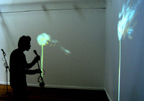
Predictable and Non Predictable Patterns
"TAMPOPO is Japanese for dandelion, and in Japan, as is in New Zealand, dandelions occupy a sphere of folklore. A simple action of blowing creates a space amongst the bustle of human doings, it creates a direct relationship with nature, and it acts as a trigger of memories and nostalgic journeys. Perhaps it triggers memories of wishes made and long since forgotten.
The subject in TAMPOPO is a giant looming dandelion, an interactive digital work that lets you blow on the head of the dandelion and watch its spores gently drift away. Yamada is interested in creativity in computer programming, and how creative code has opened up new possibilities for new worlds. He creates environments using computer-programming techniques, and generates a simulation of the natural environment in a digital realm. Yamada sees programming as a structure that is not the antithesis of nature, but also as a responsive environment in itself. Both the programming environment and the natural environment are full of conditions and variables, of predictable and non predictable patterns."
Posted by jo at 12:07 PM | Comments (0)
November 23, 2005
Viral Counter Attack
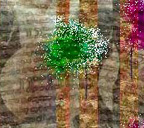
Art Viruses Need Paintings
In Viral Counter Attack--by Joseph Nechvatal and Music2eye--colonies of "art viruses" are slowly destroying digital paintings. They "eat" the images to survive and generate offspring. Players compete or cooperate to control artifial viral colonies. They have to move their bodies to guide the movements of the virus on the screen.
Overhead cameras capture the direction and the intensity of players' movements. The data is automatically translated in real time on the activity of the viruses. Each gamer can control one colony (identified by a colour) and they have to survive as long as possible by guiding the colony towards areas "rich with nutritious resources". But they can also attack other colonies. More images. Video. [blogged by Regine on we-make-money-not]
Posted by jo at 11:13 AM | Comments (0)
Spin

Liquid (tele)vision Mediation
The tv medium's deconstruction is often based on a radical intervention on its essential mechanism: continous and hypnotic entertainment based on frequent light and color changes. TV has the universally acknowledged role of awareness' persuader, through the allurance of senses, obtained with a narcotic bulimia of contents. Now more than ever there are tools and approached that can dismatle and exploit this role as an input for different purposes. Spin by Liz Nofziger is a work that simply add another visual level between the screen and the viewer, beaming the tv contents onto an enormous 'disco ball', endless rotating in the restricted space of a gallery, reflecting the same contents on the walls, and so illuminating them. The above mentioned mechanisms are then liquified in the ball's facets, and the same ball evolves from a funky knick-knacks to a visual mediator, splitting pictures in pieces that are (dis)composed on the wall. Then the stratagems to direct the viewer's attention on the screen are exploited to generate marvellous effects and transform the visual information fluxes in abstract sequences. [via neural.it]
Posted by jo at 10:27 AM | Comments (0)
November 22, 2005
rafael lozano-hemmer
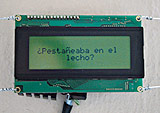
3 Expos
33 QUESTIONS PER MINUTE IN BERLIN: Installation at Postdamer Platz, Berlin, Germany; Presentation: 29 November 15:00 at Postdamer Platz 10; Show: 13 December 2005 to 8 January 2006.
33 QUESTIONS PER MINUTE consists of a computer program which uses grammatical rules to combine words from a dictionary and generate 55 billion unique, fortuitous questions. The automated questions are presented at a rate of 33 per minute --the threshold of legibility-- on 21 tiny LCD screens encrusted on the support columns of the exhibition hall or mounted on a wall. The system will take over 3,000 years to ask all possible questions. A keyboard allows participants to log on to the building and add their own questions to the automatic flow. With the assistance of Will Bauer, Conroy Badger, Ana Parga, María Velarde Torres, Luis Jiménez-Carlés, Luis Parga and Gabriela Raventós. English version with the assistance of Rebecca MacSween.
In the upcoming exhibition, a matrix of 1,800 fluorescent lamps will cover an eleven storey-high building in Berlin, a creation of architects realities:united. On this facade will be displayed 55 billion unique and grammatically correct questions; a new German version of the software "33 Questions per Minute". People will be able to input their own questions by typing them in at an outdoor kiosk.
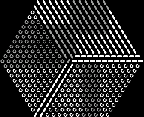
33 Questions per Minute is part of SPOTS LIGHT- AND MEDIA FACADE. For a period of eighteen months, the eleven-storey glazed main facade of Potsdamer Platz 10 in Berlin will host one of the world’s largest media facades. The installation comprises a computer controlled light matrix of 1,800 fluorescent lamps transforming the facade into a communicative membrane displaying works by internationally renowned artists in changing exhibitions. The first exhibition "The City Has Eyes" is being curated by Andreas Broeckmann and will feature art projects by Carsten Nicolai, Rafael Lozano-Hemmer, Jim Campbell and John Dekron in collaboration with realities:united.
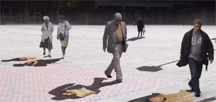
UNDER SCAN: A large-scale public art commission for the East Midlands region in England; 25 November to 4 December 2005: Brayford Campus, Lincoln; niversity; 12 January to 22 January 2006: Humberstone Gate, Leicester; 3 February to 12 February 2006: Market Square, Northampton; 24 February to 5 March 2006: Market Place, Derby; 17 March to 26 March 2006: Canal Side at Castle Wharf, Nottingham--Under Scan is an interactive video installation for public space. In the piece, passers-by are detected by a computer tracking system that activates video-portraits projected within their shadow on the ground. Over one thousand uncensored portraits of local people are activated by the shadows.
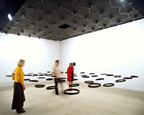
SUBSCULPTURES: Solo exhibition at Galerie Guy Bartschi, Geneva, Switzerland; 5 November 2005 to 14 January 2006--Exhibition featuring kinetic sculptures, video, photography and interactive environments. A catalog is available with texts in English and French. Includes the premiere of "Entanglement", an installation with two neon signs that write emails to each other so that they are both simultaneously on or off. NB: In early December, "Entanglement" will also be shown at Art Basel Miami at OMR Gallery and at the transitio_mx festival in Mexico City.
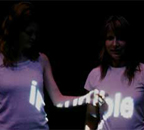
Also: SUBTITLED PUBLIC--Subtitled Public consists of an empty exhibition space where visitors are tracked with a computerized infrared surveillance system. As people enter the installation, texts are projected onto their bodies: these “subtitles” consist of thousands of verbs conjugated in third person and they follow each individual everywhere they go. The only way to get rid of a subtitle is to touch someone else: the words then are exchanged between them. The piece invades the supposed neutrality of the space that museums and galleries set-up for contemplation, underlining the violent and asymmetric character of observation. Subtitled Public also highlights the danger of surveillance systems that typecast and try to detect different ethnic groups or suspicious individuals, as in the latest computer-vision devices that are being deployed in public spaces around the world. Finally, the installation is an ironic commentary on our era of technological personalization, literally branding all spectators and converting them into “thematic individuals”. With the assistance of Conroy Badger, Will Bauer, Ana Parga, Maria Parga, Tara DeSimone and Matthew Marino. Produced by the BBVA-Bancomer Foundation in Mexico City. [video]
Posted by jo at 10:23 AM | Comments (0)
November 15, 2005
Somewhere between here and there
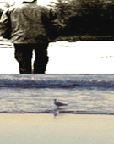
narrativas contadas narrativas vividas
"Storytelling relies on the combined human strengths of memory, imagination, and communication. The forms and methodologies of storytelling allow us to sift through and make sense of happenings in our own lives and in the lives of others. Whether drawn from representations of reality or shaped as fantasy worlds, stories tap into and represent the collective psyche of our culture. For the human being, story-making and story-listening are both a pleasure and a privilege." -- "Desire versus Destiny: the question of payoff in narrative," Glorianna Davenport, Barcelona, Spain, January 29, 2005
somewhere between here and there narrativas contadas narrativas vividas--by Alicia Felberbaum--is an interactive video installation, designed to be shown as a live, presentation in a gallery environment as well as for Internet viewing and interaction.
Somewhere between here and there, narrativas contadas narrativas vividas experiments with aesthetic and theoretical forms assigned to the documentary genre and also focuses on the potential of ’soft-linked’ stories (stories that are linked through software devices) when computers are added to the storytelling process, through algorithms applied to an array of elements [images, audio and video segments] stored in a database.
Different people were interviewed and videoed, their stories were then fragmented and embedded within the interactive work. It features people from diverse contexts, investigating spaces, experiences and struggles surrounding migration and exploring their psychological and physical journeys, and portrays the perception of the migrant experience by migrants themselves as a complex and multidimensional phenomenon. Migrants become the historians of their own lives with their own voice.
As well as documenting stories, the work allows to create associations within those stories and other visual material combined ‘on the fly’, generating a range of alternative frameworks. These frameworks are dynamically generated based on the interaction between the author’s definitions, the choices of the navigator and the matching algorithm embedded in the program. Unlike a traditional documentary, there are deviations in story directions. The author does not solely control “what happens next”; instead, that task is for the machine and the audience to navigate together.
Developed by an interdisciplinary team from London and Buenos Aires; directed, written and produced by Felberbaum [UK] and an Argentinian IT team lead by José Broide in Buenos Aires.
Jose Broide, is an IT project manager who holds a Master in Electronic Engineer from Buenos Aires University Argentina. As an IT project manager he has participated in industrial and educational software projects. He has also has been involved in software developments for art installations designing and directed the development of the software platform for this work.
Biography
Alicia Felberbaum is a new media artist living and working in London, she was born in Buenos Aires, Argentina. In 2001 she was honoured with the prestigious NESTA’s Fellowship. http://www.nesta.org.uk/ During the first two years of the Fellowship she was affiliated to the Goldsmiths Digital Studios, Goldsmiths College, University of London. MA graduate of Goldsmiths College, with honours in 1996, she has exhibited art works internationally; Midlands Art Centre, Birmingham, UK; IMA, Institute of Modern Art, Brisbane, Australia; Piece Hall Art Gallery, Halifax, UK; Pitshanger Manor Gallery and Museum, London; Angel Row Gallery, Nottingham, UK; De Oude Kerk, Amsterdam: Axis, Foundation, Netherlands; transmediale 99 - international media art festival, Berlin, Germany; Conseil des Arts textiles du Québec, Toronto, Québec and Montréal, Canada; 1998, Studio XX's 2nd Annual International Festival of Web Art, Montréal, Canada; Lovebytes Digital Arts Festival, Sheffield, UK; International Triennale of Tapestry, Lodz, Poland; U.C. Davis Design Gallery, California, USA; Camden Arts Centre, London; On Gallery, Poznan, Poland; and earlier in 1997 UNCUT-Interaction, ICA, London. _ She participated in numerous conferences including Viper Basel, 2004, International Festival for Film Video and New Media, Switzerland; 2001 DAC International Digital Arts and Culture Conference Brown University Providence, Rhode Island, USA; CADE 2001 Digital Creativity Glasgow, Scotland and Ordinatrices/Computers-International Conference, 1999, McGill University Montreal, Canada. _ She has received all levels of grants, awards and artist residence to support her work including from Nesta, National Endowment for Science, Technology and the Arts; Award for the Research Exchange Scheme from the Arts and Humanities Research Board in collaboration with Science Communication Group, Imperial College of Science, Technology and Medicine, London; transmediale 99 Award - international media art festival for Internet projects, Berlin, Germany; Awards to Individual Artists, London Arts Board, UK; in 1998 she was commissioned for a collaborative public Internet project, as part of the Photo 98 Public Sightings Program; she was Artist in Residence at Artec, Arts Technology Centre, the first independent centre in the UK dedicated to creative applications of digital technology and in 1997 she was artist in Residence, Camden Arts Centre, London. [via Rhizome]
Posted by jo at 08:15 AM | Comments (0)
November 11, 2005
Under Scan
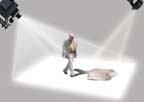
Shadow Video-Portraits
For UNDER SCAN, by Rafael Lozano-Hemmer, thousands of "video-portraits" taken in Derby, Leicester, Lincoln, Northampton and Nottingham (UK) will be projected onto the ground of the main squares and pedestrian thoroughfares of the cities. At first, the portraits will not be visible because the space will be flooded by white light. As people walk around the area, their shadow will be cast on the floor, revealing the video-portraits.
The video sequences begin with the subjects in a still position turned away from the camera. As they appear within pedestrians' shadows, their bodies move and their heads turn to look straight at the pedestrian. When a shadow moves away from a portrait, the portrait likewise reacts by losing interest and looking away.
See it at Lincoln: Nov. 25 to Dec. 4; Leicester: Jan. 13-22, 2006; Northampton: Feb. 3-12, 2006; Derby: Feb. 24 to March 5, 2006 and Nottingham: March 17-26, 2006. [blogged by Regine on we-make-money-not] [Related]
Posted by jo at 10:21 AM | Comments (0)
November 08, 2005
Ultrasound 2005
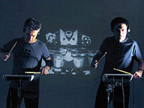
UK | Finnish Partition
Mon 21 - Sat 26 Nov 2005, The Media Centre and Bates Mill, Huddersfield, England. Ultrasound 2005 presents a diverse programme of live performances, installations, workshop and talks by UK and international artists working in new interdisciplinary ways across the interrelated fields of new media, contemporary electronic music, software production, new technologies and audiovisual performance.
We are pleased to announce the 'Finnish Partition' of the festival, programmed in collaboration with Helsinki based artist, organiser and curator Juha Huuskonen. The 'Finnish Partition' represents a cross-section of the new and emerging creative talent practising media arts in Finland today, supported by established names such as Pan Sonic.
The festival takes place at The Media Centre and Bates Mill, two contrasting venues. The Media Centre is home to over 60 creative industries enterprises, while Bates Mill is a traditional Mill complex just outside Huddersfield town centre. The performances at Bates Mill are located in the old 'Blending Shed' a 5,000 sq ft industrial space.
Ultrasound Outline Programme:
Live Performances
Pan Sonic [Finland]
http://www.ultrasound.ws/pan-sonic.html
Grey Zone [Finland]
http://www.ultrasound.ws/greyzone.html
Memnon [Finland]
http://www.ultrasound.ws/memnon.html
Sue Costabile [USA]
http://www.ultrasound.ws/costabile.html
AGF [Germany]
http://www.ultrasound.ws/agf.html
Aymeric Mansoux [France]
http://www.ultrasound.ws/mansoux.html
O Samuli A [Finland]
http://www.ultrasound.ws/oa.html
Marloes de Valk [Holland]
http://www.ultrasound.ws/de-valk.html
Owl Project [UK]
http://www.ultrasound.ws/owl-project.html
Jaap Blonk [Holland]
http://www.ultrasound.ws/blonk.html
Golan Levin [USA]
http://www.ultrasound.ws/levin.html
Zachary Lieberman [USA]
http://www.ultrasound.ws/lieberman.html
The World of PIKU [Finland]
http://www.ultrasound.ws/piku.html
Pardon Kimura [Japan]
http://www.ultrasound.ws/kimura.html
The Sancho Plan [UK]
http://www.ultrasound.ws/sancho-plan.html
Installations
Scrollbars by Jan Robert Leegte and Edo Paulus [Holland]
Kick Ass Kung-Fu by Perttu Hämäläinen, Mikko Lindholm, Ari Nykänen [Finland]
Workshop
Tiletoy: A Modular Electronic Game Prototype by Tuomo Tammenpää & Daniel Blackburn [Finland/UK]
Open software/open hardware: TileToy is an open project. Both the source code and the hardware will be made available via open licenses. The aim of TileToy is not just to create something that we ourselves can use to create interesting games and demos for, but as a platform that anyone can use to create unique content. Making the software open will allow people to create their own applications and games and feed these back into the community to spark further innovation. The open hardware will also allow people to make their own TileToys cheaply without paying a third party potentially leading to new projects that branch off to make new versions of TileToy based on the original hardware.
Further additions to the programme will be announced soon. Please visit the website or sign up to the electronic mailing list.
Contact: Tel: +44 [0]870 990 5007
Email: info[at]ultrasound.ws
Posted by jo at 08:35 AM | Comments (0)
Proximity Lab
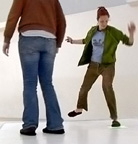
Footprints
Proximity Lab is a participatory installation and experimental interface platform designed to visualize relationships between users and mediated spaces. The 8-foot by 16-foot walkable surface is fitted with RFID technology. Participants wear shoes fitted with RFID tags, enabling the system to track and record their positions in real-time. Images projected directly onto the floor are accompanied by stereo sound as a continuous response to the actions and interactions of participants.
Proximity Lab can discern the individual identities of participants regardless of how or where they move. Conceived as an experimental physical interface system, it allows architects with diverse intentions and aesthetic goals to create repeatable experiments in physical interaction. By Evan Karatzas. [blogged by Regine on we-make-money-not]
Posted by jo at 08:15 AM | Comments (0)
November 04, 2005
The Air Around
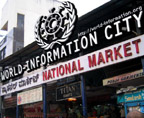
Invitation to Air Your Voice
Rajivan.Ayyappan invites you to contribute to his sound installation--The Air Around--from your geographical location.
"The Air Around is a radio/telephonic installation. It's made of an FM network that receives sounds through telephones—mobile, landline or internet phones—from around the world and integrates them into a soundscape. The installation has a central computer with a list of participants and their phone numbers. It would dial a number, remain open to engage the participant, hang up after a period of time, start another number and so on. These interactions would be transmitted to the The Air Around installation site.
The central theme of The Air Around is this: Access a whole lot of people who are in different locations and time zones through the internet and integrate them, live, into the new context of a synthesized soundscape installation. Our plan is to have a list where as many people are ready to take the call.
Therefore I want you to be in The Air Around's list to receive a call from the installation. What I would like to have from you is a 30 sec to 3 or 4 minutes of sound event that are voiced, played back or performed online by you. There are no rules for what you must do. Strictly no rules. You can just pick up the phone, identify your number or name and behave as if you have a microphone in hand. Your interaction with the call will be one of the sound events in the installation. It will be transmitted at The Air Around site.
The Air Around installation will be active for 3 days, 3:00pm to 6:00pm (India. Standard time zone: UTC/GMT +5:30 hours) starting 14th November and ending on 16th November 2005.
If you are keen tell us the dates & times when it would be possible to call you. The call will be made from the installation, to your land line or mobile. You will not be charged with any phone call rates. It will be paid by The Air Around project. Please mail me for clarifications and planning. I could send you more details regarding the procedure. Love to hear from you." Rajivan.Ayyappan rajivansa[at]hotmail.com
The installation is a part of World-Information City conference, organised by Waag Society (Amsterdam), Institute for New Culture Technologies (Vienna), Sarai CSDS (Delhi), Mahiti and Alternative Law Forum (Bangalore). [Related]
Posted by jo at 10:27 AM | Comments (0)
November 02, 2005
idades

Virtual Ball Game
idades--by Antonio Urquijo de Simón, Carolina Padilla Villarraga, Daniel Desiderio Páez Castillo, Jordi Puig Vilà and Philip Morris--is a communication network of installations placed in transit spaces. In each of them, a spectator can recognize his or her simulated silhouette projected onto a screen and discover that his or her movements effect the trajectory of a virtual ball that bounces as it touches the edges of the silhouette. This triggers a game played by the body of the spectator, along with other passersby who enter the visual field of the camera.
The ball acts as an "interconnection device" which, as it collides virtually with the body of the players, promotes in them a corporal response to keep it in movement. The installation includes a camera used as a sensor, a computer connected to the camera that cuts the image of the people, a projector that displays the game, situated behind the interaction zone, and a screen, displayed in such a way as to ensure the normal circulation of people. Showing at the FILE Festival in São Paulo, through November 20, 2006. [blogged by Regine on we-make-money-not]
Posted by jo at 11:46 AM | Comments (0)
JEFF TALMAN
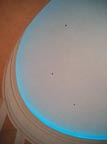
IN TRANSIT
International artist Jeff Talman will mount a new installation--In Transit--in an exhibition that explores the sonic resonance of the InterContinental Hotel atrium. In this site-specific sound work Talman exposes the nuances embedded in the ‘silence’ of the 4-story, dome-capped space.
In Transit features the actual resonant frequencies of the atrium extracted from the room tone or ‘silence’ of the site. Installed in the hotel atrium, the installation feeds the site resonance back into the space. Because the resonance is perfectly tuned to the site it is naturally amplified by the space. The results are a re-resonating sound field in which the inherent sonic ‘presence’ of the atrium itself is brought forward for the listener as intuitive notions of sound and spatial perception are enhanced.
Regarding the title, Talman noted, “We are constantly in transit – moving through spaces – with too many other concerns to spend much time reflecting on where we are, where we have come from, and where we are going. When we do reflect on our surroundings, we acquire the sense of a place largely through visual perception. But our place-sense is also highly dependent on the self-sound of a site, of which we have a much lower consciousness, perhaps only an intuitive grasp. By emphasizing this unique place sound I hope to make available a larger, instinctive sense of site that is fundamental to our perception of the world.”
In the InterContinental Hotel – Chicago, exploring the sound of ‘silence’: NOV. 7 – 13, 2005
Talman’s other new soundspace installation, ‘Absolute Elsewhere,’ which is based on similar properties of site resonance, opens three days later on November 10 in St. James Cathedral, which is near the hotel. The two installations coincide with the Nineteenth Conference of the Society for Literature, Science and the Arts, which is one of the installations’ sponsors along with the University of Illinois-Chicago, and Emerson College, Boston where Talman teaches. He is represented by bitforms in New York City.
Posted by jo at 10:05 AM | Comments (0)
October 31, 2005
A conversation between...
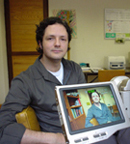
José Luis Barrios and Rafael Lozano-Hemmer
* This is the edited transcription of a teleconference which took place in the Sala de Arte Público Siquieros (SAPS), Mexico City, on the 20th of April 2005, and which was moderated by the director of SAPS, Itala Schmelz. Translation from the Spanish original by Rebecca MacSween.
JLB: The distinguishing factor that defines modernity has to do with self-awareness, or the ability of the subject to both represent and represent self-reflexively his activities and relationships with the world. An important aspect of this is expressed in the Foucaultian concept technologies of the gaze. Throughout the history of art and visual culture various strategies of the gaze have existed. How do you distinguish and conceptualize those strategies that belong to the present and how are they manifested in your work?
RLH: New visual experiments have always been aided, or even initiated, by technological advancements. For example, perspective during the Renaissance, anamorphosis as part of Mannerism, or Eugène Chevreul's color theory for the Impressionists. In this context my contribution is the following: Walter Benjamin spoke with great clarity about the birth of modernism. For him the image is that which can be reproduced mechanically, a condition that eliminates the aural quality from a work of art. Mechanical reproduction democratizes art, popularizes it, and takes away that privileged point of view born of singularity. However, with digital technologies I believe that the aura has returned, and with a vengeance, because what digital technology emphasizes, through interactivity, is the multiple reading, the idea that a piece of art is created by the participation of the user. The idea that a work is not hermetic but something that requires exposure in order to exist is fundamental to understand this "vengeance of the aura".
Today digital art, -actually all art-, has awareness. This has always been true, but we have now become aware of art's awareness. Pieces listen to us, they see us, they sense our presence and wait for us to inspire them, and not the other ay around. It is no coincidence that post-modern art emphasizes the audience. In linguistic theory Saussure would say that it is impossible to have a dialogue without being aware of your interlocutor. Exactly the same thing was said, almost 100 years ago in the art world by Duchamp, for example, when he said, "le regard fait le tableau" (the look makes the painting). What we see happening is that this concept of dependency is reinforced by digital technology. Pieces of art are in a constant state of becoming. It's not that they "are" but that they are "changing into". I think the artist no longer has a monopoly over their work, or an exhaustive or total position over its interpretation or representation. Today, it is a more common idea-an idea that I defend-that the work itself has a life. The work is a platform and yes the platform has an authorship, but it also has its points of entry, its loose ends, its tangents, its empty spaces and its eccentricities. In this sense, artworks tend to be eclectic which for me signifies the liberation of art, the freedom to reaffirm its meaning.
In contrast to the idea of creation through the gaze of the public, the other side of the coin should also be mentioned; the panoptic computerized gaze. Artistic interest in criticizing the predatory gaze of the surveillance camera is nothing new; there is for example the work of Dan Graham, Bruce Nauman or Julia Scher, to mention a few. What is new is the degree of computerization that the new surveillance systems, which invade our public and private spaces, possess. Stemming directly from the American "Patriot Act" is a wide variety of computer-vision techniques that, for example, are intended for identifying suspicious individuals or classifying them based on ethnic traits. It is literally about technologies designed to discriminate based on a series of innate prejudices. This new intensification of surveillance is extremely problematic because, in the words of Manuel DeLanda "it endows the computer with the power of executive decision making". What is also new is the amount of memory that these systems have thanks to ever-smaller storage units and increasingly efficient compression-decompression algorithms (codecs) that allow for the recording and reproduction of events from the distant past. Lastly, the widespread popularization of cameras by reality shows and the penetration into public and private spaces by means of things like web cams should be mentioned. I have no doubt that a new type of art is emerging in order to confront these technologies of the panoptic and post-optic gaze. The Institute for Applied Autonomy, Harun Farocki and the Bureau of Inverse Technology are some examples of this new line of inquiry.
JLB: A fundamental aspect of the connection between technology and language is that which is linked, and this is particularly important in your work, to society. If the machine is language and a space for play, how can we understand its function or connection with social bodies? Let me clarify; in a large part of your work, interventions into the space of the subject are obvious, whether these spaces are public or private. This is interesting because at the same time that you link technology with language (society), you also introduce a type of "principle of intrusion of technology" to both the subject and their space. What imaginary social space do you believe your work opens? Above all I am asking about those pieces that have a direct link to public spaces.
RLH: It depends on the project and how it is received. Often the response to the work is very different from what I had imagined. For example, my installations using giant shadows; the first time I used the projected shadows of pedestrians in a public art piece was when transforming the fa?ade of a military arsenal in the Austrian city of Graz. It happened that in the arsenal there was a painting entitled "The Scourges of God" depicting the three primary fears of the people of Graz in medieval times: a potential Turkish invasion, the Bubonic plague and infestation by locusts. For this installation I invited dozens of artists and thinkers from all over the world to participate in an on-line debate on the transformation of the concept of fear. Perhaps the Turkish threat had been replaced with a fear of an invasion of Yugoslavian war refugees, or instead of Bubonic plague, the current day AIDS epidemic. The debate was projected in real time onto the facade, but I thought I could use the shadows of the pedestrians as a kind of "window" or "scanner" linking the public to the text. I assumed that the shadows would give an expressionistic and lugubrious touch to the piece-I was thinking of Murnau. Also, I wanted the shadows to function as metaphors for fear: for instance fear of the Turkish invasion that never happened but was only a menacing specter. I was totally wrong! As soon as people passed by and noticed the installation they would start to play with their shadows and perform humorous pantomimes. The huge dimension of the shadows allowed, for example, for school children to step on their teachers, or that a man in a wheelchair could roll his twenty-five-meter-high shadow over the others deriving great pleasure from squashing them with his giant wheels. The installation was converted into an ad hoc carnival and nobody thought for one minute about fears, plagues or invasions. This was one of the most entertaining errors of my career. The piece, which was called "Re:Positioning Fear", opened a Bakhtinian carnavalesque space where the environment was artifice and game, an environment that was completely outside of my control, literally and poetically.
My projects with shadows since then have benefited greatly from this lesson. "Body Movies", the piece in which shadows reveal enormous photographic portraits, precisely invites people to play with their representations in a public space and to play at being the "other", like a kind of inverse puppetry. The plastic potential of the shadow is used not as an absence, loss or darkness, but as a window to an artificial reality. We were trying to interrupt convention, routine, the predominant narratives of power that the buildings represented. Cicero said, "We make buildings and buildings make us". Our situation in the globalized city says the opposite: the urban environment no longer represents the citizens, it represents capital. Architects and urban developers build with the priority to optimize cost, and from there to the homogenization of globalization, and from there to the unfortunate reality of contemporary architecture which fetishizes the modular, the formula. It has reached a crisis of representation that carries with it a tremendous avidity of connection. In my work I try to encourage exceptionalism, eccentric reading of the environment, alien memories (meaning, those that don't belong to the site). don't want to develop site-specific installations but rather focus on the new temporal relationships that emerge from the artificial situation, what I call "relationship-specific" art.
JLB: In understanding public space as a carnivalesque space it is also understood why communities developed where-and this also happens with Relational Architecture-there is no subject identified as autonomous and independent. Bakhtin explains in his text on the forms of the carnivalesque in the Middle Ages and the Renaissance that in order for the carnival to succeed there has to be an overflowing beyond the limits of the subject's identity and body. It seems to me that in the examples you provide you reconstitute the carnivalesque condition by means of shadows, not as theatre but as pantomime. What you do is create a carnivalesque space in which the user can intervene and symbolically create a collective body. This is noticeable, for example, in the fact that you intervene facades or the Z?calo Square in Mexico City; by doing so certain symbolic connections to power are deconstructed. In this manner you open a ludic space and deepen the potential of the social body, but you do this via interactive technological supports, reinforcing the imaginary-fantastical aspect of the game. Seen this way, and to delve more deeply into the relationship between the public space and that of the carnivalesque, what place does the orgiastic body have in this game?
RLH: My projects vary so it is difficult to generalize. There are pieces where the body is amplified on an urban scale (Displaced Emperors, Body Movies, Two Origins), others where the body is the canvas (Subtitled Public), and others where it becomes the target of extremely predatory electronic detection (Surface Tension, Standards and Double Standards). There are also others in which the body plays no highlighted role (Amodal Suspension, 33 Questions Per Minute, Vectorial Elevation).
I'd like to make a clarification on a term you used and that is the idea of the collective. I run away from this idea. In the world of electronic art there are two competing trends. On the one hand the unbearable utopian vision of Pierre Levy, amongst others. He proposes a "collective intelligence", virtual communities that form a global village, the idea that we are facing the emancipation of the human race all thanks to inter-connectivity. To me this vision, which is promoted by publications like Wired, is corporative, colonial and naive. I am amongst the ranks of those that reject the notion of community and the collective when it comes to acts of interpretation or perception. I think that we have seen truly disheartening agendas produced in the name of collectivity. In contrast, I really like the concept of the connective -a much less problematic word because it joins realities without a pre-programmed approach. What's interesting is that this concept doesn't convert realities into homogeneity. What Derrick de Kerckhove calls "Connective Intelligence" seems more useful as a concept for linking planes of existence that may be extremely disparate even if they coexist at times. I would even go so far as to define the connective as those tangents that pull us out of the collective.To return to the connection between carnival, body and public space, "Body Movies" is a piece that inspired different behaviors depending on where it was presented. When it was to be shown in Lisbon I thought of the stereotype of the "Latino" who loves to be out on the streets, partying and hugging affectionately so I expected a lot of this type of interaction with the piece. However what we saw was people trying their best not to overlap or interfere with another person's shadow. In contrast, when we presented the piece in England, where I had thought we would see considerable modesty and moderation, people got drunk, took off their clothes and acted out a variety of orgiastic scenes, which was a lot of fun to watch. This anecdote points out the difficulty of making generalizations about the body in a public space, which seems to me like quite a healthy difficulty.
JLB: In your work you make a distinction between "Relational Architecture" and "Subsculptures". Does this distinction correspond to certain connections that you maintain or establish with specific aesthetic systems-architecture or sculpture-or perhaps to formal concepts, for example, scale, or is it more about two arbitrary concepts that allow you to explore diverse issues?
RLH: They are more about arbitrary concepts. They are neologisms designed precisely to avoid being classified with other existing concepts. I first used the term "relational" in 1994 in describing my telepresence installation "The Trace". I found the word in the neurological essays of Maturana and Varela, although I was also aware of pioneering artists like Lygia Clark and Helio Oiticia and their work with relational objects. As well, I was interested in the relational functions of database programs that wove multi-dimensional webs for connecting various fields, a valuable concept when applied to the word "architecture" that for so long has signified solidity and permanence. Lastly, it was a good word in counterpoint to the term "virtual", which emphasizes the dematerialization of experience and asks us to create in simulacra. "Relational" emphasizes the dematerialization of the real environment and asks us to question the dissimulation. Today the term is already dated, partly because of the popularization of the term "relational aesthetics" by Nicolas Bourriaud, which by the way has little to do with my work and was published a number of years after I used the term. For the sake of coherence with my earlier work, I will probably continue to make Relational Architecture pieces maintaining the two grotesque definitions that I gave to the field: "technological actualizations of urban environments with alien memory" (1994) and the newer "anti-monuments for public dissimulation" (2002).
I started the series of Subsculptures in 2003 with the motorized belt piece "Standards and Double Standards". I have already added another three to the series: the kinetic sculpture "Synaptic Caguamas", the interactive screen piece "Glories of Accounting" and the neon piece "Entanglement". It's true that in the majority of cases these are more portable and nomadic pieces than the Relational Architecture installations are, -however I think that at some point I will make huge Subsculptures... so, the scale isn't the difference. I don't yet have a definition of what "Subsculpture" is but I think it has to do with contagion matrices. All of the installations consist of two or more interconnected robotic or virtual entities. The rules of behavior for these entities are relatively simple, but they are dependent on and influenced by the status of neighbouring entities or other inputs, for example the surveillance of the public (my installations almost always "watch the watchers", as Daniel Garcia And?jar would say). In this way, they achieve an unpredictable and emergent global behavior, where turbulence and other phenomena that are products of non-linear processes are found. For example, in "Standards and Double Standards" there are between 10 to 100 buckled belts hung from interconnected robots. A computerized camera system detects a visitor and instructs nearby belts to rotate on their own axis until the belt buckle faces him or her. This local movement then spreads in a process of chain reactions that travel throughout the matrix until the entire field of belts has been affected. If a second visitor enters, then those belts closest to this second presence will be influenced and begin to rotate in the same manner described spreading and influencing the orientation of the entire field. The resulting effect are patterns of interference very similar to those that can be seen, for example, in a tank of water into which various drops fall; some belts remain still, others turn constantly (eddies) and others follow the spectators.
Another aspect of Subsculptures is my interest in Barbara Liskov's "Substitution Principle" that says, in object-oriented programming, that an object of one class can be substituted for another in an inherited class without changing the properties of the program. It's something like the concept of metonymy in psychoanalysis or linguistics and like the categorical syllogism in philosophy called the "minor premise" or "subsumption". Liskov's Substitution Principle is, for me, extremely useful when it comes to making symbolic transferences between disparate or copresent realities. For example in "Standards and Double Standards" the belt substitutes the figure of masculinity, the father, authority. I'll give you other examples: in "Synaptic Caguamas" beer bottles play at being neurons in an algorithmic simulation of cerebral connections; in "Glories of Accounting" the raised hands are both metaphors of the Fascist salute and of the Spanish anti-terrorist gesture of "manos blancas" ("white hands"), -the hands also simultaneously signify distance (as in a "stop" gesture) and inclusion (as in the expression "show of hands"); and a last example, Entanglement, in which the neons connected to the Internet substitute for the photons linked by quantum mechanics.
Contrary to what the Substitution Principle asks for, in my Subsculptures substitution has a formal impact: it leaves a symbolic residue and destabilizes equivalencies. This residue is the strength of the piece, its poetry and its absurdity. For this reason I propose anti-modular strategies for artwork. I like breakdowns, the remainder in a division, and rounding errors. I find modularization boring and homogenizing. Modularization is promoted by:
* Computer science, through object-oriented programming, or plug-ins
* The art world, through the idea of authorship and bienialism
* Capital, as an instrument of control and quantification
* Architecture, using the formula as a solution (see Norman Foster)
* Education, through the modernist idea of specialization
No doubt my work is often quite modular, above all in its fabrication and sale, and it's better to confess it even though it is a contradiction, because one cannot live outside of the zeitgeist.
I think that Relational Architecture, like Subsculpture, can exhibit the anti-modular, symbolic inequalities or develop itself in the matricial space of rules of contagion. So there is no definite line that separates the two series. It is true that the Subsculpture series is slightly more personal; perhaps it is more an investigation of psychological spaces than of urban ones. I have been doing psychotherapy for four years now and maybe that explains that!
JLB: I would like to go back to the problem of non-linear mathematics and its relationship to "Synaptic Caguamas". When information is flow, a multi-perspectival flow that unfolds in various dimensions, it introduces the notion of "possibility" as a form of construction. It's interesting to me that this piece is not built on random relationships but that it is more about variables and vanishing lines configuring the system of representation. Keeping this in mind, I would like you to explain how this flow of information operates aesthetically as a system of self-management and self-configuration.
RLH: Recursive algorithms, chaos theory, cellular automata, digital genetics and other descriptions of complex dynamic processes are fascinating because they appear to be alive, to have life. Some exhibit evolution, others morphogenesis, and still others management and self-control. Mathematics associated to this field originate from various places, one of them being Weiner's postulation of the theory of Cybernetics in Mexico City in 1946, -it's definitely not something new. If during the Renaissance perspective and Fibonacci's series were used as media to legitimize the production of representation, today we can and should make dynamic mathematics our media. The Renaissance subject emerges precisely from the privileged vision of the vanishing point. What might be the equivalent impact as we contemplate, say, a fractal pattern? These mathematics shatter humanism, fortunately. They allow artists to design work that disobeys us (and the critics).
Until these mathematics reached the art world one of the only strategies that the artist had to create unexpected processes, for example a kinetic sculpture or automatic poetry, was chance. The people whom I most admire worked with chance in a very serious way -like John Cage or Marcel Duchamp- but I think that randomness is not that interesting anymore. Not even the greatest computer in the world could generate numbers that are truly random. Today we accept that the occurrence of a hurricane isn't due to bad luck but due to the consequences of a non-linear system of energy distribution (Lorenz's famous "fluttering of the wings of a butterfly on the other side of the planet"). Of course this doesn't mean that there is a destiny or that everything is predictable, it's exactly the opposite. These mathematics show us that uncertainty is inseparable from the system being observed, and artists love to work with uncertainty.
Today it is possible to create art from seeds, which actually is called "seeding the initial conditions" for a process, and then the work unfolds via mathematics in ways that you cannot control. You'll notice that every three minutes the bottles in "Synaptic Caguamas" line-up and reset themselves. This is done to give new initial conditions and to generate a variety of behaviors because on occasion the emerging patterns are boring or the bottles remain locked in what is referred to as "dynamic equilibrium".
Complexity describes processes like neuronal connections, genetic mutations, and the variegation of leaves. There is an infinity of examples of how non-linear mathematics permeate almost all of our natural and social history. Manuel DeLanda writes about how this dynamic flows can be used to understand history in a non-linear way, - -it's not about the selective recording of facts, dates and heroes, but rather it's about understanding history in terms of fields of attraction, of isobars, of influences, which is how non-linear math works. We want to visualize these flows, animate them, and evoke them so that they can help us give shape to our work.
JLB: "Subtitled Public" is a piece that isolates chance. When we were speaking about the piece a while ago, you said that it was a little like Mallarme's roll of the dice. One roll of the dice, as in this piece, puts in motion a mechanism where poetry, theatricality, technology and non-linear mathematics construct a complex space of meaning. A space where language names me and, at the same time, the body is interpreted as a shadow. How do you explain the connection between intrusion and evasion in this piece when it is a metaphor for the society of surveillance? What importance does the interaction of the spectator have with the piece as a sort of "subversion" of the fact that in the contemporary world "I am named"?
RLH: Chance is present in "Subtitled Public": A visitor is detected by a computerized surveillance system and the computer randomly selects a verb, conjugated in the third person, and is then projected onto the visitor's body. The visitor cannot get rid of the word that will follow him or her throughout the entire exhibition space, unless physical contact is made with another visitor, in which case they swap verbs. The use of chance in this piece has an important ironic component. Here we have a display of surveillance technology detecting the public's presence with great precision. The system pretends to have the ability to identify moods, gestures, desires and actions, but in the end it is chance that takes this to an absurd level. It's a comment on identification technologies that I spoke about in the beginning of this interview. I use chance, a throw of the dice, when criticizing the ridiculous systems used for example by the Department of Homeland Security in the USA that are trying to identify suspicious individuals.
Surveillance never tires of taking possession of our words and images. In my recent work I ask what would happen if all the cameras became projectors and gave us words and images rather than take them away from us?
In a piece such as this one I like the public's rejection to "being named". When we enter a piece of art or a public space, we all have certain values that are given to us by what we read, who we know, who we have seen etc. What I want is to shake up those values and create something dysfunctional, a moment of resistance and of rejection of those preconceived mantras. I look for the "special defects" that allow me to activate the imperfections, the disruptions; "to disrupt" seems to be the most precise term for describing what I want to do. The system projected the words "se mea" ("she urinates") onto a friend of mine who came to the opening and the words chased her through the exhibition space until I finally showed her how to rub them onto someone else. For me it's valuable that there is a moment of resistance to the assigned label, that people don't accept the subtitle nor see it as an oracle, that they are always conscious of the lie. I loved the comment of one visitor who said, "I got the word 'inv?lido' (handicapped), and maybe I am handicapped but I don't exactly know in what way" and there was another person who said, "you put on a psychological outfit depending on the word you get".
I think we are not done with exploring the culture of paranoia. I don't feel happy having to make art that works on that level, however I think it is extremely important to do so. What has been happening since September 11th is very, very serious. The authorities believe in the huge fallacy that the solution to terrorism should be technological. I react against that. We must use the distortions of the camera, and underline the innate prejudices of our media, of ourselves. Next time a person stops in front of a surveillance camera they might expect to have words projected on his or her body, and know that it is highly likely that they will not agree with the subtitle assigned to their public body.
Posted by jo at 02:22 PM | Comments (0)
Electrical Walks
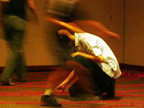
Amplified Currents
Electromagnetic induction is based on the sounds resulting from the mutual interaction of magnetic fields. Audio artist Christina Kubisch developed magnetic headphones with magnetic coils that respond to electrical fields in the environment. At first she tried to filter the hum of the electrical wires out of the headphones. But the increase and spread of "unwanted" electrically-produced sounds inspired Electrical Walks. With special, sensitive headphones, the acoustic perceptibility of aboveground and underground electrical currents is thereby amplified.
The palette of these noises, their timbre and volume vary from site to site. They are ubiquitous. Light systems, transformers, anti-theft security devices, surveillance cameras, cell phones, computers, elevators, antennae, navigation systems, automated teller machines, neon advertising, etc. create electrical fields that are otherwise undetectable.
With the headphones and a map of the area, upon which the especially interesting electrical fields are marked, the visitor can set off for a special kind of stroll in cities. The perception of everyday reality changes when one listens to the electrical fields; what is accustomed appears in a different context. Nothing looks the way it sounds. And nothing sounds the way it looks.
Electric Walks is part of Her Noise, an exhibition featuring 5 installations by artists who use sound as a medium to investigate social relations, inspire action or uncover hidden soundscapes, at the South London Gallery, 10|11|2005 - 18|12|2005. See also the interview of Christina Kubisch in Audiohyperspace. Related: aetherspace, Electroprobes, the Amazing All-Band Radio, etc. [blogged by Regine on we-make-money-not]
Posted by jo at 12:20 PM | Comments (0)
October 29, 2005
Mood Swings
![]()
Inciting Responses to Transmutations
Victoria Vesna's interactive installation, Mood Swings, creates states of emotion and perception by translating the viewer's body into a swarm of moving particles that change "moods" from one extreme to another. As the visitor's image is captured on a live video camera, radical shifts in color and sounds occur in the projection while particles and poetic texts emerge and dissolve in response to the viewer's movement. The seven colors change with audio shifts, moving from irritating and disturbing to peaceful and calming. The use of new technologies in Mood Swings creates an interface between virtual and real worlds and engages the viewer by inciting responses to the audio and visual transmutations.
Media and Medicine for Communities partner Victoria Vesna developed the interactive exhibition "Mood Swings" for the Inside Out Loud exhibit, the first significant survey of contemporary American art to explore critical issues related to women's health.
Posted by jo at 06:38 PM | Comments (0)
October 25, 2005
Morgan Schwartz
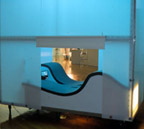
Chance Encounters, Deliberate Interventions
Pursuit of Happiness: Porta-Sky is an urban sanctuary and think tank for two. Periodic trips into the dark relaxation chambers of movie theaters became a routine survival technique for the subjects of modern society. In our post-modern world, where work and leisure have collapsed, the Internet has become a space of convergence. "Porta-Sky" is a physical corollary – a non-space, a hallway from here to there. Providing a personal view of a virtual sky, this video projection space offers alternate imagery to an anxiety-ridden sky. The unit features dual, synchronized DVD video projections, a deployable surveillance blimp and custom designed form-fitting reclining seats.

Situated in the Gallery@Green St (adjacent to the Green St. Subway station on the Orange Line in Boston, MA), Pressure was a site specific installation where computer controlled sensors manipulated the sights and sounds of daily commuting to address issues of accelerated culture and the evolving metaphors for speed and progress. Pressure seeked to explore the psychology and physicality of individuals in the contemporary urban landscape.
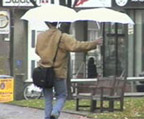
umbrellaSpace is an urban gesture. It is a design solution to a social problem. The intervention adjusts perceptions of boundaries and comfort held by observers on the street. This umbrellaSpace adopts the umbrella as a familiar, recognizable, urban form and recreates it. A permeable space of interaction is transformed from a private, individualized space. An individual in the urban sphere operates this new umbrellaSpace. He or she can choose to invite people on the street into this space. I’m interested in exploring the range of responses this intervention precipitates on the street: sociological, visual, performative. Schwartz is looking for people interested in operating the UmbrellaSpace as well as videographers and photographers interested in documenting the events.
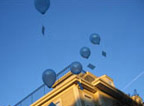
Currently in development at the Berwick Research Institute and on exhibit at Glowlab: Open Lab, Whether/Weather consists of aerial beacons that are dispersed into the weather system. The beacons are helium powered with LED blinkers. Like seeds, these beacons drift with the wind and carry information/stories/memories that hopefully germinate wherever they land. Whether used by an individual or a large organization, the project explores the idea of memory and memorialization through ephemeral and participatory public art. The person who happens upon one of the beacons that has landed, will encounter a message and the option of logging into a website to find out more about where/why the beacon originated. They can contribute their own response at this point and even decide to re-launch the beacon. By logging when/where the beacons are launched and when/where they are found Schwartz is visualizating whether/weather patterns. He hopes that the project will function like a collective 'message in a bottle' and tap into romantic and poetic possibilities of communication and chance discovery.
Posted by jo at 10:02 AM | Comments (0)
October 24, 2005
Point, Line, Surface
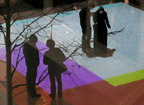
Digital Boogie Woogie
LAb[au]'s Point, Line, Surface computed in seconds will be presented in form of an outdoor urban and interactive installation in the center of Brussels. The installation is presented in the context of Cimatics 05 festival and Maiis # 3 _ ''ville en creation/creatie in de Stad" festival. From October 25 to November 5, 2005, everyday 17:00 - 24:00; opening reception: October 25, 17:00h.
Point, Line, Surface is an interactive installation by LAb[au] which immerses the user in an audiovisual space. The user creates on a touchscreen a sonic and visual composition spatialised through quadraphonic sound and (a 10x10m) floor projection which can be animated through finger-movement. Referencing Mondrian's Boogie Woogie which draws a relation between the rhythmic structure of a jazz-piece, the composition of graphic elements on canvas and the urban grid of New York, the project Point Line Surface extends these relationships to an interactive vocabulary inside the urban and electronic space.
Posted by jo at 10:00 AM | Comments (0)
October 14, 2005
|yt_A [read: li:ta]

Distance Touch Generator
Touch, the most intimate of our five senses is often used as a reality-check; what I can touch is real. It is a proof that our bodies and the world around us remain anchored in the physical reality, that is currently engulfed with the mediated virtual/digital realities. Touch is an ultimately interactive communication method: the one who touches is simultaneously being touched. There is no subject-object relationship, no distance, no control, but a direct dialogue. |yt_A aims at reconnecting these the physical with the digital through touch and the usage of tactile media and haptic technologies.
|yt_A is an artwork, an instrument and a translation medium in one. It is a flexible structure that can transmit haptic information on a distance: when the structure is touched on one site, the touch will be visible and touchable on another.
The installation has two identical but mirrored parts which placed 100 metres from each other on the concourse of Phaeno, the newly developed Science Centre in Wolfsburg, Germany. Placing the two structures in distant locations will encourage the visitors to play with each other by manipulating the structures with their hands and bodies, and learning about each-other's shapes through touch. Furthermore, the visitors' touches will remain as shape-traces in the memory of the installation. In the moments of low activity, the installation will bring the traces back to the surface of the structures. |yt_A's software will use the visitors' traces to create new shapes and body-forms: the traces will be mixed, transformed and grown, as if the visitors' touch has 'fertilized' this anorganic form that became alive and autonomous.
The core team of |yt_A are Joris Bois, Nik Gaffney, Lina Kusaite, Maja Kuzmanovic, Steven Pickles, Todor Todoroff and Yon Visell. The fabrication of the force feedback mechanism is developed in collaboration with Merlin Systems Corp. Ltd. |yt_A is commissioned by Phaeno Science Centre and Stadt Wolfsburg.
Posted by jo at 01:37 PM | Comments (0)
October 11, 2005
Trigger
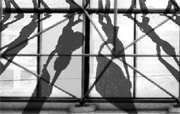
An Exploration in Visual Anthropology
Pace Digital Gallery is pleased to present Trigger by artist in residence Jody Zellen.
"(Trigger) is in a transitional space, a stairwell, where students and visitors walk energetically to the next class or office. People twist and turn as they ascend and descend, encountering new image experiences along the way. The process of navigating in real space, rather than within the space of a computer screen, also adds a playful element. The visitors become performance artists or dancers unintentionally interacting within this encompassing artwork. The outside world is further transformed by large-scale transparencies covering the windows. Instead of ecclesiastical imagery, these “stained glass windows” represent the iconography of the city. The pacing of motion within the space, ambient sound and continuously changing projections become an exploration in visual anthropology – a form of “Kinesics in Context” to use the title of an important text in that field. In the work Jody Zellen has been able to incorporate the spirit of transient experience exemplified by the web into a human space which will force visitors to pause and reflect before returning to their immediate mission. Perhaps during that pause they will give some thought to the larger question about where we are all heading as mediating experiences begin to dominate daily life."
Edward W. Earle, Curator of Digital Media, International Center of Photography, New York
Saccadic Streets: Jody Zellen’s Urban Exploration from the brochure essay
Trigger was produced in residence at Pace Digital Gallery in 2005, with the collaboration of Dr. Francis T. Marchese and Josh Rose, CSIS student, of The Center for Advanced Media at Pace University in New York City.
Jody Zellen is an artist living in Los Angeles, California who works in many media simultaneously making photographs, installations, net art, public art, as well as artists’ books that explore the subject of the urban environment. She employs media-generated representations of contemporary and historic cities as raw material for aesthetic and social investigations. Solo exhibitions include Laguna Art Museum (2004-05); Susanne Vielmetter Los Angeles Projects (2002); Deep River, Los Angeles (2001). Her net art projects have shown world wide since 1997 in festivals and exhibitions such as Arte Nuevo Interactive, Mexico, ACCEA International media festival, Armenia, Prog:me, Rio de Janeiro (2005); File, Brazil, Festival du Noveau Cinema, Montreal, Siggraph, Los Angeles, 404 International Festival of Electronic Art, Argentina, Cosign, Croatia (2004); New Forms Festival, Vancouver, Recontres Internationales, Berlin (2003); Whitney Museum Artport (2002); XXV Bienal de Sao Paulo (2002); Art Future 2000, Taiwan; Net_Condition, ZKM (1999); Film + Arch.3, Graz (1997).
exhibition October 18 - Novenber 8, 2005
Opening reception Tuesday, October 18, 2005, 6-8 pm
Pace Digital Gallery
163 William St, NYC
Tu - Fr, 10 - 6
info digitalgallery[at]pace.edu
details + map + directions
http://www.pace.edu/digitalgallery
directors
Francis T Marchese, CSIS
Jillian Mcdonald, Fine Arts
assistant director
Will Pappenheimer
Posted by jo at 04:46 PM | Comments (0)
October 10, 2005
Found Sound in D.C.
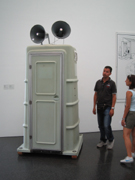
Crisscross a City
[Unrelated photo: a port-a-potty-based public address system at the MACBA, Barcelona, 2005.]
A public art project called FOUND SOUND will be featuring works from artists in sound booths (“reconfigured” Port-a-Potties) on sidewalks in public locations throughout Washington, D.C. from Oct 14-Nov 5. Participating artists include Richard Chartier, Joseph Grigely, Alberto Gaitán, Jennie C. Jones, Helmut Kopetzky, Brandon Morse, Robin Rose, and Alex Van Oss. Actor and part-time New Orleans resident Harry Shearer (The Simpsons, Spinal Tap, HuffPo) is contributing a piece on Hurricane Katrina, and Calvin Trillin has contributed a poem as well. The press release quotes this from an essay by Nora Halpern at Americans for the Arts:
FOUND SOUND entices the listener to crisscross a city to experience fully this collection of work. As one leaves a destination for another—whether by foot, car, bus, or Metro—the heightened audio awareness encouraged by each piece should continue, like a musical riff, through all the spaces in between.
That’s great and all, but in most of the places where these will be, “heightened audio awareness” might not be a good thing. Downtown D.C.’s not known for its street life — but we have plenty of nice, loud traffic and construction. Maybe they should make a podcast available for walking in between. Local galleries including Fusebox, Conner Contemporary Art, the Goethe Institute, and DCAC are collaborating. No map seems to be available yet but we’ll link when it turns up online. No word on whether any of the port-a-potties will be performing their originally intended public service as well, but consider it highly unlikely. [blogged by Tim on shey.net]
Posted by jo at 06:36 PM | Comments (0)
October 07, 2005
CONTAINED

Improvisatory in Nature
Contained--by MIX--is a collaborative and interactive, hybrid work performance/installation that utilizes technology to blur artistic boundaries and challenges notions of presentation/audience. The artists have created a generative, improvising, real-time multimedia environment using both commercial and custom designed software in conjunction with dedicated hardware sensors, motorized robotics and real time processing or text, video, images and sound. Contained is improvisatory in nature, principles of movement improvisation are employed in the creation of the imagery, sound, and movement generated by the system.
October 7, 8, 2005; 7:30pm; Doane Dance Performance Space; Denison University campus, Denison University, Granville, Ohio 43023 USA • 1-800-DENISON; Performance with Artists' Talk to follow.
MIX is:
Sandy Mathern-Smith, dance,
Alexander Mouton, Art,
Micaela de Vivero, Art,
Christian Faur, Art, Digital Technology
Aaron Fuleki, Music, Digital Technology
Marlon Barrios Solano, dance and interactive art
http://www.unstablelandscape.org/
Mary Sykes, Lighting Designer
Posted by jo at 09:40 AM | Comments (0)
October 06, 2005
Virtual Raft Project + Regrets
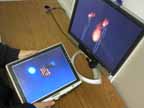
Two from UC DARNet
The Virtual Raft Project is a multidisciplinary undertaking seeking to create communities of believable autonomous characters that inhabit heterogeneous networks of computational devices. In particular, the project is interested in allowing the characters to break the plane of the traditional desktop screen. To this end, we have designed an interactive installation featuring a novel tangible paradigm for interacting with the characters. This paradigm involves the use of a mobile device, such as a Tablet PC or handheld computer, as a “virtual raft” by which a character may be transported among several virtual worlds. By enabling the character on the raft to react in real time to the raft’s motion in real space, this installation encourages participants to become physically engaged with virtual characters. We believe that this physical engagement can lead to an increase in the believability of the characters.
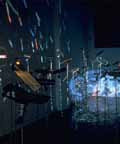
Share the Burden
Regrets consists of six to ten purpose-built mobile computer stations publicly located in and around Cambridge collect anonymously submitted regrets from the public to comprise a sociological database of contemporary remorse. Instant feedback to the individual user based on other contributors' similar concerns is algorithmically generated and calculated to 'share the burden'. Random selections and groupings of the regrets are made public across the city through existing signage and broadcast facilities. By engaging users in revelations of a problematic but constructive nature, we aim to bring specificities of individual lives, in this case personal regrets, into the realm of public debate, shared learning, and community.
About
The UC Digital Arts Research Network (UC DARNet) is an interdisciplinary Multicampus Research Group of University of California faculty who utilize digital media for cultural and theoretical research and in their creative production. As an ad-hoc planning group, UC DARNet has been meeting since 1997 to lay the foundation for a UC-wide program to facilitate collaborative research and teaching within a distributed digital arts and humanities community.
Culture is in the midst of an increasingly rapid shift to computer-mediated forms of creative production, distribution and communication. The role of digital media is fundamental to this shift. Digital Artists create a natural bridge across the traditional disciplinary divide between the humanities and the sciences. Interdisciplinary dialogue geared toward creative production and programmatic development will be facilitated by UC DARNet, providing an opportunity for critical engagement and conceptual dialogue between humanists, scientists, and those in the digital arts. A rotating group of UC digital arts and new media faculty act as principal investigators of UC DARNet and as the group's advisory committee.
GOALS AND OBJECTIVES
UC DARNet will, over a five year period, work to:
Serve to bridge counterproductive gaps between the arts, humanities, and sciences;
Enhance students' educational experience by providing access to faculty across the entire UC system;
Engage in experimentation and prototyping of distributed network environments which will be of value to a range of research interests and educational models; and, finally;
Help to establish UC as a leading institution for developing the new modalities of digital culture. UC DARNet will establish a strong UC presence outside of California through conferences, events, workshops, exhibitions, and ongoing online and offline dialogues. It is also actively planning to have research and development activities facilitate distance learning, and technology access to underprivileged middle school and high school children in the Southern California.
Funded by the University of California's Office of Research, UC DARNet pursues its programs and research activites with matching funding from the participant campuses, partner institutions and organizations, industry sponsors, corporations and foundations.
Posted by jo at 12:06 PM | Comments (0)
September 30, 2005
Here For You
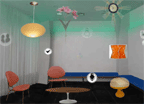
Redirect Surveillance, Control and Distance
Internet participants are invited to participate in a live network performance project opening Friday September 22nd at 7pm online and at the XINDUSTRIA exhibition at CAFKA 05, Kichener, Ontario. Here For You--by Will Pappenheimer--is a prototypical internet controlled space which allows virtual participants to adjust room lighting, see into the space, move objects, time clocks, upload messages and sound from your computer play it for the sound system. The guideline is to redirect surveillance, control and distance into channels of giving for physical visitors in the exhibition space. The exhibition continues through September 30.
This is a large ongoing project with dual physical and virtual levels and the challenges of connectivity and mechanics. It will begin simply develop as the exhibition proceeds.
“Here For You” will create a series of IP controlled conventional and fanciful domestic objects to comprise a network livingspace. Exhibition participants will be invited to relax in a living/domestic space constructed in or modified from available exhibition space. Appliances, both practical and artistic, can be controlled by anyone accessing the Internet from anywhere in the world. . The project hopes to create an environment where telepresence meets presence, remote control meets lifestyle, distance becomes proximity, surveillance becomes community and network becomes living room.
Posted by jo at 09:57 AM | Comments (0)
September 28, 2005
Zhong Shuo
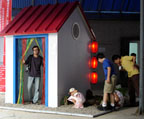
24 Hour Access to China
Zhong Shuo (People Say...) is a sound installation made collaboratively by Australian sound artist Iain Mott, Beijing visual artist Ding Jie and the Chongqing art collective the Li Chuan Group comprising Li Chuan, Li Yong and Ren Qian. The work acts as a system for the collection and telling of stories and focuses on the rapid force of change in China. The exhibition at the Long March Space in the Dashanzi district of Beijing, marks the first stage in what ultimately will be a series of installations connected to each other via the internet. It will consist of up to three individual installations set up in three cities including Beijing, Chongqing and potentially a third location on the route of the Long March.
Stage 1 was launched at the Long March Space, Dashanzi, Chaoyang District, Beijing on 20 August 2005. Stage 2 is currently underway in Chongqing with the Li Chuan Group. The exhibition is to be held in the Chongqing Planning Exhibition Gallery at Chaotianmen Square.
Each installation will pose a question to visitors, asking them to tell a story of their experience of change. In Beijing, Ding Jie's design establishes a gently ironic environment for public interaction. Created in the form of a Chinese garden, a kiosk houses a telephone for contributing stories and an adjoining rock-pool plays host to a small school of goldfish and water-plants. Hidden away in the rocks and shrubs is a loudspeaker, which plays a steady stream of stories that have been automatically recorded and edited by a computer. This sound, in addition to the voices, includes ambient sound recordings collected locally and is edited in the style of radio documentary.
Once the other installations have been established, stories will be shared between sites by way of networking. In this way, visitors will be able to reflect on varying perspectives on change. Each installation will share copies of the stories collected remotely and these will be edited together mixing both dialects and points of view. Additionally, the sounds played by the installations will be streamed to the web as internet radio, giving 24 hour access to Chinese speakers both nationally and internationally. Information on this radio channel will be announced by the Long March Space before the opening.
Posted by jo at 08:48 AM | Comments (0)
Passages
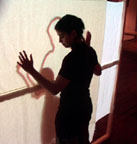
Plato's Cave
Many 'Media spaces' have taken the form of always-on video conferences between selected remote locations. However, users may still perceive a sense of separation because they see each other through wide-angle views captured by cameras mounted at a distance from them. Passages allows passers-by to "touch" the silhouettes of their remote counterparts.
A translucent surface, made of glass and textile is set in two different locations connected with each other via a network. As a passer-by walks in front of this surface, the contour of his/her silhouette is reflected in a style that evokes drawing or sketching.
This silhouette uncovers what is happening at the other location, possibly the silhouette of another person standing there. As the local participant moves, more of the remote scene is exposed.
A specially designed computer vision system enables interaction at a very short distance to the screen surface, to the point that passers-by can actually touch it. This system maintains a near-perfect registration of the participants' bodies to their silhouettes no matter how close they are to the surface. Video. By Joëlle Bitton, Céline Coutrix, Stefan Agamanolis. [blogged by Regine on we-make-money-not]
Posted by jo at 07:35 AM | Comments (0)
Fursicle Safurry

Telecommunications Wilderness
Fursicle Safurry invites people to enter a space of make-belief adventure through the wilderness of telecommunications. Upon calling the fursicle with their cell phones, users will receive a password composed of animal sounds such as gerrrs, wooww, barks, cries, and meaows. They then have to go to the head that is outside the installation. Staying on the phone they tell the password to the head which responds by sending a sound feedback and a blue light. If the head likes the password, the user gets to enter.
The voice on the phone asks users if they want to MATE, KILL, or RUN with the fursicle. According to their choice, users will be guided by instructions from the voice on the phone: they will have to touch and move in various ways with the fursicle, inventing the feedback as they move. While the user is interacting with the fursicle corresponding sounds and projected images are texturing the experience with rich animal sights and languages. By Dana Karwas and Liubo Borissov. [blogged by Regine on we-make-money-not]
Posted by jo at 06:49 AM | Comments (0)
September 24, 2005
SonicWireSculptor

Correlation Between Vision and Sound
At its simplest form SonicWireSculptor is a novel 3D drawing tool and a unique musical instrument, but perhaps most important - its just fun to play with. The project started out as a personal instrument for Pitaru to perform on. During concerts, audience members often inquired whether they could experience the tool first hand. This encouraged Pitaru to transform the software into an immersive public installation. The installation included enhancements to the original work, allowing a wider range of users to intuitively interact with the environment. Gallery visitors would enter a dark room with a surround-sound system, a projection and a unique drawing station. Opening nights for these exhibits would often double as performance and workshop events where the audience and Pitaru explore the tool together. Participants would be encouraged to add their work to a steadily growing collection of beautiful and surprising sonic-sculptures. [Related]
Posted by jo at 03:43 PM | Comments (0)
September 22, 2005
Strainings

Sift, Sort, Stretch, Pull
To see is to choose. To see is to select something and overlook something else. To be seen is to exist. When someone set sights on you, you appear in the other persons world.
Strainings--by MusicalFieldsForever--is about this genesis: to select what you want to keep from that which should be left out. In a physical, personal and cultural sense. Strainings is an interactive sound and light (audiovisual) installation contained in a silo. The many interpretations of the word "strain" embrace all of this: to sift and to sort, as well as to stretch and pull a string. In Strainings the audience decides what should be heard and seen. By pulling strings, they change the mesh of the strainer/ the large web. Light, sounds and images are strained and created.
Strainings consists of 7 light ropes 6 meter long, hanging from the roof and pulled through a web of flexing rubber bands. Interacting with the light ropes changes the structure of the web that cast shadows on to the projected images on the wall. A camera analyses movements in the light ropes and the input is used to change and make variations in the light, the light ropes and the sound. The background sound consists of bell frogs recorded in Baldringe, Sweden, strings and synthesised sounds that change, mix, and filter generatively. The interaction sound consists of trumpet loops with granular synthesis making it possible to play continuously and changing tones when pulling the ropes.
The software is developed in Max/MSP and SoftVNS. [via]
Posted by jo at 07:00 AM | Comments (0)
September 20, 2005
Remain in Light

Netting Ambient Analog Sound Waves
[...] Remain in Light, by Haruki Nishijima, is a visual representation of ambient analog sound waves captured using an "electronic insect-collecting kit." The "collector" carries an insect net that functions as an antenna and is attached to a device designed to capture the waves. Participants walk outside with the net. Through headphones, they can listen to phone conversations, AM radio, taxi drivers’ and police radio communications. A button on the handle allows collectors to record one-second sound bites.
These fragments of analogue information are transmitted to a computer that transforms them into points of light that are then projected onto the exhibition space. Each frequency is represented by a different colour. When visitors enter the space, their presence and movements are detected by sensors. This is how the "electronic insects" are activated, disperse then progressively disappear. Each light source is accompanied by a sound. The installation can be activated on the Internet. Remain in Light was part of the Touch Me festival in Zagreb, Croatia [...] Related: Tools for radio wave hunters [blogged by Regine on we-make-money-not]
Posted by jo at 11:50 AM | Comments (0)
September 19, 2005
Net Worth
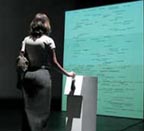
How Great is Your Net Presence?
The Internet is now the primary aggregator, disseminator and communicator of information. Individuals with greater net presence are deemed more significant. Net Worth explores a new value system for our information dependent society.
The visitor is invited to swipe one of their purchase cards in a kiosk with a magnetic card reader that stands in front of a monolith-like structure. The name contained on the magnetic stripe of their payment card is parsed and googled. The number of hits returned from the search is represented by positioning or ranking their name on the projection. Their name appears on the projection among others who have swiped as well as celebrities (whose names were fed into the system not only as a litmus test for the visitors but also as a reflection of our social condition: who has more Google hits Paris Hilton or William Shakespeare?)
The result is full of hits corresponding to people who happen to have the same name, but here the projected name is perceived as a true embodiement of the visitor.
Net Worth explores current conditions where information is given more prominence than the corporeal. The work also examines individuals' narcissism and hubris, much like carnival hammer hit games where physical muscle was tested, Net Worth gives chance for visitors to flex their data bodies.
By Osman Khan (see also one of his other works: Sur la table). Design Distinction in the Concepts Category in I.D. Magazine's 51st Annual Design Review. [blogged by Regine on we-make-money-not] [Related]
Posted by jo at 08:33 AM | Comments (0)
September 16, 2005
The Knitting Map

Knitted Cartography
The Knitting Map is a fabric art and technology project that aims to take the pulse of the city of Cork (Ireland) during 2005 and translate that information into a live knitting map. Above the earth there is a satellite which looks down at Cork (Ireland) and watches the movements of people and cars around the city. Down in the hub, small cameras watch the city in detail and meteorological equipment tastes the weather. All of the data coming needs to be distilled into two simple numbers: one representing stitch (pattern) and the other colour.
There are 25 knitters, so information must be varied slightly between each knitter to give the overall textile a more subtle and complex hue. Knitters work in relay, the strips sewn together to form a single vast document of the city. Before each of them, a small digital screen details the next few lines of knitting and they lean forward to advance the pattern. During the day, people arrive to view the installation. By performance company half/angel. Pictures. Part of Cork 1005, Capital of Culture. [blogged by Regine on we-make-money-not]
Posted by jo at 10:30 AM | Comments (0)
Wind Array Cascade Machine
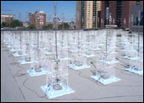
Si(g)n(e)
"Wind Array Cascade Machine (WACM)--by Steve Heimbecker--is a device that captures the wind's direction and movement and then streams the resulting data on the Web and uses them for installation projects. Thanks to the 64 motion sensors forming a grid of 8 units by 8 units, the system "maps" the wind in an outdoor space. Streamed on the Web, the data from the 64 channels are then processed by a computer program and assigned to installations that translate them into another form.(1)
The system has already spawned an installation, Pod, presented at the Mois Multi 2003 in Quebec City, as well as at the Subtle Technologies conference (2003) at the Interaccess centre in Toronto. During these two presentations, the sensing device was placed on the roof of the Méduse complex in Quebec City, and the data transmitted by the network were used to control a series of corresponding light emitting diodes (LEDs) placed on long vertical rods in an exhibition space.
Installed for a full year (2004-2005) on the roof of the Ex-Centris complex in Montreal, WACM powered the August 2004 Pod presentation at the Kiasma Museum of Contemporary Art in Helsinki, Finland, as part of ISEA 2004, as well as its presentation at Oboro in Montreal in November and December of the same year. The resulting luminous installation evoked a windswept field of wheat, thereby creating a visual analogy to express a natural phenomenon that is hard to perceive.
This system is similar to other devices created by artists integrating natural elements (for example, the wind and sun) into kinetic art. Yet Pod differs from this work in that the wind isn't used for its energy potential but rather because it describes a space by occupying and modifying it. Such projects are motivated by a fascination for natural phenomena, a desire to incorporate them into the creative process in order to link us to nature in technological contexts that sometimes exclude us and tend to distance us from our own organic condition.
In addition, Heimbecker is working on the project Si(g)n(e), a sound installation using the same system. To carry out this project, the artist is designing a sine wave generator with 64 channels, which will be controlled by a programming environment linked to a corresponding multi-channel sound system. The technology is being developed within a residency in cybernetic art at Vidéographe thanks to a program funded by the Foundation (2). Si(g)n(e) harks back to the many sound portraits of outdoor spaces produced by Heimbecker in the past." --S.P. © 2004 FDL [via]
Posted by jo at 09:12 AM | Comments (0)
September 15, 2005
Mediate
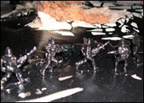
Modern Day Rites and Invigorating Spectacle
Mediate--by Brian Knoth (aka Theta State)--is a spiritually and socio-politically charged thirty-minute multimedia installation intended for alternative art spaces. Utilizing shamanic ritual as a conceptual backbone, a mixture of original music, video, performance art and mixed-media sculpture abstracts the transformational experience.
Original music, in a sometimes cacophonous and contradictory mix of tribal-electro pastiche surrounds... creating a completely immersive experience. Moving image tweaks consciousness in conceptually and viscerally driven image juxtaposition...Progressions through a childhood regression, evoke the modern day rite...In concert, projected word clusters reflect and deflect, visually echoing the critical deflection inculcated in our status quo culture. The piece crescendos in an invigorating spectacle of sound, text, image and light.
Next Exhibition: As part of Arts Central 2005..., Sunday, September 18th 12-6pm @ Cambridge Community Television (CCTV), 675 Mass. Ave., enter on Prospect Street, Cambridge, Massachusetts.
Posted by jo at 10:09 AM | Comments (0)
September 14, 2005
EXIST [CORRESPONDENCE] DIÁRIOS JAPONESES
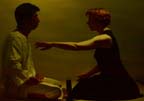
Erotica and Violence in the Space-Time Relations
EXIST [CORRESPONDENCE] DIÁRIOS JAPONESES – NIHON NIKKI – JAPANESE DIARIES ‘ Entre um ser e outro há um abismo’ [Bataille] is an interactive video installation and TELEMATIC performance by Rachel ROSALEN, Brazil; invited artist as LIVE collaborator for the telemátic performance, shin-ya b., Tokyo. This project took place at prog:ME, July 19 to August 28, 2005.
EXIST [CORRESPONDENCE] - DIÁRIOS JAPONESES is a media art project that discusses erotica and violence in the space-time relations lived by bodies-in-flux in the postindustrial metropolis. Built in the creases, this foreign body and in traffic is supported by erroneous roots, approached in the net’s virtuality and lacking bodily presence. This subject who lives in these [anti] territories, draws a diminishing political existence and more technical. Societies of control and contagion, their wounds are evident on the web and symphonized in the urban situations. The body remains as a contaminated act of humanity. These crushed bodies by the failures of the utopias, search on the web and in the difference the love. In this MA*(suspension of space and time), this subject acts through the contemporary versions of masks: avatars, fiction bodies launched in simulated adventures. The relations of proximity and distance are always imaginary. Disterritorialised and lonely, they ask themselves: does Correspondence exist?
EXIST [CORRESPONDENCE] - DIÁRIOS JAPONESES creates many approximation strategies in this everyday impact with the ‘abysm between one being and another’ of which Bataille tells us about. Its this abysm, this black hole, this vertigo that lyes on the skin of the image that reveals in the installation. There are various layers in space and time that are overlapped: the Japanese diaries create a direct counterpoint for the plain net image. If these images (from the diaries) gives us the body-to-body, the confrontation and the denudation before the other, the web gives us dissimulation, the fragmentation and the “superficiality” of a correspondence that is marked by absence.
EXIST [CORRESPONDENCE] - DIÁRIOS JAPONESES is a procedural work built by layers. The images of the diaries form a loop where this suspension is pierced by images used on LIVE. This tension between time and intensity, duration and fragility, proximity and distance, design the rhythm of this correspondence. First layer: video loop of Japanese diaries. Second layer: a telematic correspondence performed in real time using video streaming, performed between two artists between Japan and Brazil gives continuity to the idea of diaries. Third layer: these images of the loop are available into keyboards, connected to two projectors. A program in director links the images used on LIVE to the letter keys of the keyboard. Through them, each user may (re)construct this “situation” of correspondence, in the attempt of building “a bridge between one being and another” throughout the recognition of this abysm of which speaks Bataille.
* MA: Japanese concept, which means space-time suspension, the interval between the inside and the outside in architecture, the retention of the arrow on the bow before it, is launched.
EXIST [CORRESPONDENCE] – Japanese Diaries
Structure:
Telematic live performance
Hardware:
G4 dual 1.4 GHz
Pentium IV 256 GHz
Software
Darwin
QuickTime Player PRO
I Chat
Interactive Installation
Hardware:
2 Pentium IV 256 GHz
Software
QuickTime Player PRO
Director 8.5
Other equipments:
Two projectors de 1500 ansilumens
4 speakers
Space: dark room 7 X 5 mts2.
Techinical assistance: André SHEIK - Programming in Director: Marcos FONSECA, Performance in the Diários Japoneses: Youichirou Osawa, Rachel Rosalen special thanks to: Kabum, Brígida Baltar, Higure 17-15 CAS, IKKA studio.
Rachel Rosalen Visual Artist, graduated in ARCHITECTURE AND URBANISM, with a master degree in MULTIMEDIA ART from UNICAMP, BRAZIL. The artist’s career path has three fundamental axes that get together: the body, the image and the city. With a route specially punctuated by research on the body as a media, the result of which are performances, site specifics and video-installations. Invited professor at SENAC post graduation course, São Paulo. Live and work in between São Paulo, Tokyo and Italy. In 2003 got the Artist in Residence fellowship from Japan Foundation to make an interactive video installation in Tokyo.
shin-ya b.
Born 1967. Lives in Tokyo. Earned M.F.A. from Tyler School of Art, Philadelphia, USA shin-ya b. has been working in different dynamics of fields ranged from film festivals / museum to personal web site / street performances. His works have been shown in many different film festivals including onedotzero and ResFest. He is currently collaborating with toru yamanaka - one of the original sound creators of dumb type, YEN (Yutaka Fukuoka - YEN calling), Kyota Takahashi, and 3KG. Most of his works deal with "accidental panorama - inevitable happenings within accidental cause and pattern recognition" which usually visuals are drawn from his daily personal visions that processed thru digital medium. His show highlights includes Modern Art Museum Kobe, Asahi Art Festival, Tokyo Designers Block and Gallery Art Space (Aoyama, Tokyo).
Posted by jo at 09:42 AM | Comments (0)
**// Code_UP
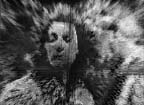
Interrogating the Role of Code on the Construction of Sense
**// Code_UP--by Giselle Beiguelman--is a project about digital image that interrogates the role of code on the construction of sense. We work here, in dialogue with “Blow up” (1966), by Michelangelo Antonioni, one of the most profound discussions ever made about nature and the place of image and about the ways in which we deal with the visible and the invisible.
In **// Code_UP, the public photographs themselves with cell phones and sends their images by bluetooth to the big screen. The images are manipulated by a specially developed for the program and transform into mobile interactive matrixes. The project entered Life Goes Mobile, in September, in its first stage. In October, another version has been released at ZKM (in Germany) at the Algorithmic Revolution exhibition which marks the opening of the most important museum and art and media center of the world. And in December, it participated on FILE in São Paulo and in February, participated on the share.it, in Torino in Italy. An updated and unpublished version will be presented in Rio de Janeiro on Prog:ME, from July 19th to September 20th.
Giselle Beiguelman is the author of the award winning O Livro depois do Livro (1999) and egoscópio (2002). Develops works envolving mobile communication dispositives since 2001, when she created Wop Art, complimented by national and international press, including The Guardian (England) and Neural (Italy), and art that envolves public access and electronic panels such as via internet, SMS and MMS, like Leste o Leste? Egoscópio (2002) , reported by the New York Times, Poétrica (2003) and esc for escape (2004). Her work appears in important anthologies and work references devoted to online digital arts like the Yale University Library Research Guide for Mass Media and Information Arts: Intersections of Art, Science, and Technology (S. Wilson, MIT Press, 2001). Participates of major events on the area, in museums and new media centers like ZKM, Fundación Telefonica, Smart Project Space and MECAD amongst other congresses and international symposiums. She teaches at postgraduation in Comunicação e Semiótica at PUC-SP, is editor of the new world section of the electronic magazine Trópico, colaboration with Leonardo Electronic Alaman, Iowa Web Review and Cybertext and is responsible for the project site Arte/Cidade, coordinated by Nelson Brissac. She was the only brasilian listed in the selection The 50 Best, performed by international/media/art/award 2003, promoted by ZKM, for the project Paisagem0, developed by invitation of SESC in partnership with Marcus Bastos and Rafael Marchetti.
Posted by jo at 09:38 AM | Comments (0)
Dustbunnies
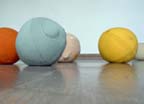
Tread Softly or Else
Dustbunnies, by Stijn Schiffeleers and Hendrik Leper from Boutique Vizique, is a colony of seven shapes that contain two kinds of sensors, a RF-communication system, two microcontrollers, a big battery, speakers and a motor. When there's no human around, they collect dust, hair, flakes of skin and dirt and murmur to each other in a mysterious language. But if you walk into their territory, they become quiet and pretend to be dead.
The only way to observe them in that first state is to be motionless yourself. Touching a dustbunny will cause different reactions. If they like the way you treat them they will make an amusing sound according to the movement you cause. But the Dustbunnies can also become angry. If you mistreat one of them, all dustbunnies will start screaming. The whole group will show their dislike.
For those interested in dirt and art, the dustbunnies will be at the UCI Beal Center (University of California, Irvine) from Oct. 4 till Dec. 10. [blogged by Regine on we-make-money-not]
Posted by jo at 08:25 AM | Comments (0)
September 13, 2005
0kn0
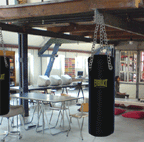
Looking Glass
0kn0.org is a new interdisciplinary media center for art and technology in Brussels. 0kn0 supports the research, development, creation and presentation of new forms of innovative cultural production, and is dedicated to exposing broad and diverse audiences to new technologies and media arts through a programme of concerts, interactive installations, performances, workshops and lectures.
OKNO presents BO-KU-SHI-N-GU BA-GU [Electronic Boxing Bag Melody Making Machine], an interactive installation by SWUMMOQ.NET [Heerko van der Kooij/nl and Niels Wolf/de in collaboration with Travis Robertson/ca]. Punching the Bokushingu Bagu the visitor generates and composes melodies from a selection of various sounds depending on the power and area of the punch. The visitor applies great effort only to be hindered by the outcome of his intensity.
Opening performance by swummoq.net: friday 16 september 8pm-10pm or try it yourself on: Saturday 17 September 2pm-6pm; Sunday 18 September 2pm-6pm; Entrance free.
radio_okno is online now! click: http://qt.okno.be:8000/mix.m3u to open the livestream in your mediaplayer.
Masterclass on Synthetic Speech and Machinic Sound Poetry. Participants can still apply. The masterclass is scheduled from October 17-21 and is part of the x-med-k-2005/series, commissioned by the VAF [Vlaams Audiovisueel Fonds].
OKNO: koolmijnenkaai 30/34 quai aux charbonnages | brussels 1080 | belgium
tram 18 [walvis] | Metro Graaf van Vlaanderen - Comte de Flandres
okno is supported by the Ministry of the Flemisch Community and the VGC.
Posted by jo at 11:41 AM | Comments (0)
September 09, 2005
PAUSE

Sonic Hammocks
The sound installation PAUSE is made of 5 hammocks connected to each other at the center by a system of springs. Any movement caused by the presence of a visitor is transmitted to the other hammocks.
When a visitor sit in a hammock or leave it, s/he causes rocking movements which are detected by sensors. The information influences in real time the audio-tactile events transmitted by 9 loudspeakers distributed in the hammocks. The sounds become really audible only for spectators who lie in the hammock and press the hands on their ears. The mechanical vibrations resulting from the transmission of the sounds in the loudspeakers become perceptible on the body itself and the sounds are retransmitted in the inner ear by bone conduction. Each loudspeaker has its own channel so that the sounds, and the vibrations they cause, can move on the body from one source to another. The spectator is thus confronted with different types of movements: the swinging of the hammocks, the vibration of the loudspeakers and the movement of the sounds and their vibrations from one speaker to another.
By Lynn Pook (see also A Fleur de Peau). Pause is part of the Festival Emergences, in La Vilette (close to Paris), Sept. 24 - Oct. 2. Related: Hammock of electricity. [blogged by Regine on we-make-money-not]
Posted by jo at 05:41 PM | Comments (0)
September 07, 2005
Sonification/Listening Up:
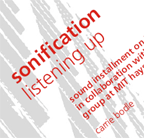
Research Made Audible
Sonification/Listening Up--by Carrie Bodle in collaboration with MIT Haystack Observatory--is a multi-speaker site-specific sound installation on I.M. Pei's iconic Building 54 at MIT. The speakers broadcast audio representations of sound waves embedded in the Earth's charged upper atmosphere, or ionosphere, a region under active radar study by the Atmospheric Sciences Group at MIT's Haystack Observatory. This project utilizes sound as a representation of research at MIT, extending to the public what is normally invisible.
The speaker arrangement on the Building 54's façade recalls an downwards-sloping graph. This is representative of the spectral frequency distribution of the sounds, which vary both by time and in altitude. The broadcast sounds are in fact frequency-scaled versions of ion-acoustic pressure waves within the hot ionospheric gas, which changes state in a complex interaction with the Sun's varying output. Seven different altitude levels in the ionosphere have been used to construct ion-acoustic sounds that will broadcast from seven layers of speakers on the facade of the building.
Time: Daily 12:00-1:00 pm
Dates: Sept 9-16 2005
Location: South facade Building 54, MIT campus [map]
Sound Off (closing event): Sept 16th 5-7 pm
Sonification / Listening Up is done in collaboration with Dr. Phil Erickson of the Atmospheric Sciences Division at MIT Haystack Observatory. Sponsored by the National Science Foundation, MIT Haystack is currently the only observatory located in the Continental United States that uses this powerful ground-based sensing technique to map changes in the makeup of the ionosphere. Such changes, especially during disturbed periods, can affect the precision of GPS technology and other man-made long distance and satellite transmissions. Knowing and predicting the constitution of the ionosphere has become an integral goal for commercial interests as well as a driver of the national Space Weather effort funded by the National Science Foundation, and this project puts a spotlight on nearly five decades of study by the Haystack research group at MIT.
Funded by: MIT Office of the Provost , MIT Vice President for Research and Associate Provost, MIT Associate Provost for the Arts, MIT Department of Architecture, MIT Visual Arts Program, and Council for the Arts at MIT.
Posted by jo at 01:41 PM | Comments (0)
September 06, 2005
Public Anemone
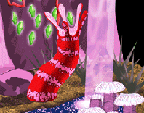
Robot Theatre
Inspired by primitive life, Public Anemone is a robotic creature with an organic appearance and natural quality of movement. By day, Public Anemone is awake and interacts with the waterfall, pond, and other aspects of its surroundings. It interacts with the audience by orienting to their movements using a stereo machine vision system. But if you get too close, it recoils like a rattlesnake.
The anemone starts each day's cycle with a high confidence level and a desire to complete various tasks (such as watering the nearby plants, drinking from the pond, or bathing in the waterfall). It chooses to either continue its tasks or interact with a participant based on their behavior and how much progress it has made with its tasks. If a participant wins the robot's attention, it will respond by orienting toward that person and following their movement.
If a participant gets too close or makes a threatening movement, the anemone may become frightened and recoil from the crowd until it regains its confidence. See Movie (.mov file, 5770 KB). Because the robot makes decisions based on its internal drives and audience interaction, each day is different from the next but follows a coherent theme.
Public Anemone is a collaboration between the Robotic Life and Synthetic Characters research groups at the Media Lab as well as MIT's Artificial Intelligence Lab.
Posted by jo at 10:19 AM | Comments (0)
Ars Electronica
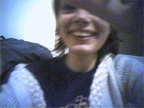
Regine Blogs Ars
TEMPEST is based on the surveillance technology known as Van Eck Phreaking - computer screen content can be reconstructed remotely by picking up the emitted EM-field of the screen. TEMPEST utilizes this technique to transform purely generative graphic into a composition of noise which again is fed back into the image generating process. Several AM receivers are tuned into different frequencies of a screen and plugged into an audio mixer for further sound processing. The graphics on the screen become a means of producing sound and it is only the graphics which determine the different timbres and rhythms. By Erich Berger.
Interface Culture at the Linz University of Art was founded last year by Christa Sommerer and Laurent Mignonneau. The programme deals with human-machine interaction to develop innovative interfaces. Went to see their works yesterday.
SoundToy, by Christina Heidecker, Harald Moser and Timm Oliver Wilks, is a 3D environment you navigate as if you were a racing car driver. During the ride you use the steering wheel to create and compose 3D sounds. You place in the space sound objects assigned to electronic beats. The speed, pitch and volume can be individually adjusted using the steering wheel and the accelerating pedal. The composition is generated by the movement and position of the sound objects with respect to one another but also by the route you select.
Recipe Table, by Istvan Lorincz, Hanna Perner-Wilson, Thomas Wagner and Andreas Zingerle, is an interactive workplace built into a kitchen countertop that enable users to intuitively search for recipes. You place the tins and bottle, vegetable and other ingredients and in return the system makes you recipe suggestions. These culinary suggestions are also depicted graphically as finished dishes on the workplace.
Blow, by Taife Smetschka, is a breath-controlled video installation. There's a microphone and a projection of a clip from Billy Wilder’s film *The Seven Year Itch*, the scene in which Marilyn Monroe stands on the grate above the subway ventilation shaft. At first she is stationary, smiling at viewers from the screen. She doesn’t begin moving until she feels a cool breeze. In *blow!* the breeze has to be provided by the installation visitors who must blow as hard as they can into the microphone. Marilyn’s skirt flutters in the breeze as long as the visitor blows into the microphone.
Mika Satomi's Gutsie is a cyber android filled with “guts.” Peeping into its interior through its eye-like hole, you can observe its intestines in motion. It will show you the places you want to see by tracking your eye gaze, but at the same time, your gaze may infect it. The interior of our body is something very private, often disgusting, and thus prohibited to be seen or to be shown. In media, visual images of our insides are often used to induce feelings of violence or disgust. Ironically, this is something that is stuffed inside everyone’s body without exception.
The G-Player (Global player), by German artist Jens Brand, works like a CD-player. But instead of playing CDs, it plays the globe. The device knows the postion of more than a thousand satellites and enables you, by the use if a virtual 3D planetary model, to listen to an imaginary trace of a selected flying object. Like a needle on a record, the satellite follows the Earth's surface. The G-Player transforms the different elevations units course directly into sound. The simple display shows the selected satellite's name, type, altitude and position over the planet (thus the latitude and longitude). Topographic data are interpreted as audio data. "Noise sounds" result from the high density of the data. Pictures.
[via we-make-money-not]
Posted by jo at 08:45 AM | Comments (0)
September 02, 2005
Olafur Eliasson
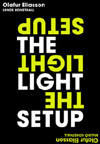
Partners in Image Generation
The light setup, the autumn show at Lund Konsthall, will present a wide spectrum of works by Olafur Eliasson from the years 1997-2005. Some 40 pieces – light installations, objects, models and photographs – interact to create a strikingly intense atmosphere.
Throughout his artistic practice, Olafur Eliasson has worked with natural phenomena like light, water and temperature. By inserting these into artificial surroundings Eliasson challenges us to sharpen our senses and to reflect on our relationship with and our understanding of the physical environment that we occupy in our everyday lives.
At Lund Konsthall various experiments employing ingenious technical solutions will turn the exhibition space into something reminiscent of a laboratory or artist’s studio where visitors can not only study the techniques involved but even experiment themselves. Presenting the constructions as an important aspect of the works is a way of deliberately demystifying the phenomena that the visitor encounters and helps to break down their seemingly sensational aspects. Eliasson thus invites visitors to be aware of their own vision and to take an active part in creating and experiencing the works. We become partners in creating the images that are generated.
Olafur Eliasson’s artistic practice is characterized by the serious study that underlies it. In this regard his approach is similar to other types of research illustrated in various ways through the series of photographs, models and light experiments that will be on display at Lund Konsthall. In the manner of a visual inventory the series of photographs document phenomena like melting ice flows, deep pools and horizons. They are grouped according to subject types and presented in accordance with a strict grid pattern. However, in a work like Room for one colour the careful examination of the wavelengths of light is given a playful framework which results in all the colours in the room being subordinated to the yellow nuance and being seen as a scale consisting of shades of black and white. This playful inventiveness is highly characteristic of Eliasson’s art.
The two exhibitions featuring Olafur Eliasson to be shown this autumn are being jointly organized by Lund Konsthall and Malmö Konsthall. They can be seen as a single entity offering a unique opportunity to engage with Olafur Eliasson’s wide-ranging oeuvre. The Lund exhibition illustrates the breadth of Eliasson’s artistic investigations, while at Malmö Konsthall the experiment has been enlarged into a giant format which shifts the focus from the experimental aspect to how we experience the results of the experiment. Examination of the light is a central aspect of the new work that fills Malmö Konsthall. The two exhibitions complement and enrich each other and point to the complexity underlying all of Olafur Eliasson’s work; the interplay between experiment, experience, a work of art and “reality”.
Olafur Eliasson was born in 1967. He is currently based both in Berlin and Copenhagen. Among his recent exhibitions and projects we may mention: Minding the world at the ARoS Kunstmuseum in Århus, 2004, Your lighthouse at the Kunstmuseum Wolfsburg 2004, The weather project at Tate Modern in London 2003, The blind pavilion, the Danish pavilion at the Venice Biennial 2003, as well as public commissions in Denmark and Sweden including a candelabra for Copenhagen’s new opera house 2004 and Movement meter for Lernacken by the new bridge in Malmö 2000.
Welcome to the opening!
Lund Konsthall Friday 9 September 5-7 pm
Malmö Konsthall Friday 9 September 7-9 pm
Posted by jo at 03:35 PM | Comments (0)
Bondage
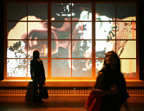
Bound by Pixels
Bondage creates music using pictures of Japanese women made by Japanese photographer, Nobuyoshi Araki. The photo was scanned and projected onto a shoji – the traditional Japanese rice paper wall with sliding doors. The photographs are fed into an image-synthesizing program, scanned and analyzed to become the harmonic spectrum of the sound to be arranged and mixed. Visitors reveal hidden layers of photographs that are projected onto a paper surface. With their movements in front of the installation, they scan the image and modify it, which simultaneously activate the installation’s sound environment. Created by Atau Tanaka. Metasynth processing by Eric Wenger. [blogged by Regine on we-make-money-not]
Posted by jo at 08:42 AM | Comments (0)
URBANtells
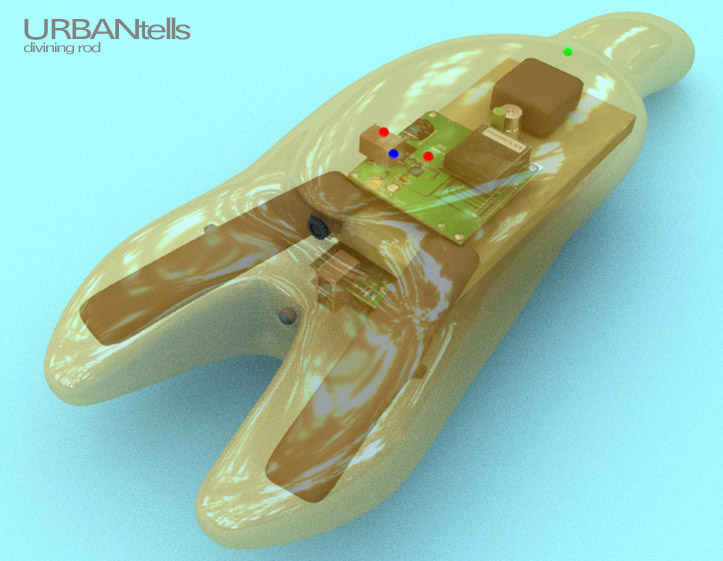
Exploring the City with Digi-Diviner
URBANtells is a mobile sound installation in which the user explores a neighborhood on foot, "data-diving" with a handheld device called digi-diviner. Participants will provide their cell phone and email address to an attendant at a kiosk. In return, they will be given a digi-diviner to walk and explore the neighborhood. A minute or so after they go outside a real time mix of sound art and verbal information triggered by their location will start to play through an earbud attached to the diviner. The information is a mix of recordings of residents and historians, text-to-speech synthesis, recitations, musique, and other processed sound. The information will address the complex layers of personal and collective histories and experience in urban environments, and the degrees to which these acoustic "tells" influence behavior and development within a community similarly to traditional, physical structures.
Users will be able to upload sounds, text, and still images they capture with the diviner en route. This information will be available to other users. Upon returning to the kiosk, participants will receive an interactive Google map of their specific walk via email, containing buttons to play sounds and view images they may have uploaded during their trip. Urbantells, a project by James Rouvelle, Joe Reinsel and Steve Bradley, opens June 2, ‘06 at Art Interactive, Cambridge, MA. [blogged by Regine on we-make-money-not]
Posted by jo at 08:30 AM | Comments (0)
September 01, 2005
Jumping Rope
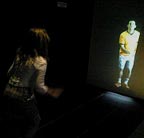
Action Driven Narrative
Jumping Rope is the classic children's game of jump rope transferred into the digital world. Your skill at jumping an invisible rope determines the course of a film narrative. You have to stand between two projection surfaces that each display a different figure holding a jumping rope. You can see on the screen how they are turning the rope but you have to mentally see the rope in order to jump on time. Your talent at jumping is evaluated by a video camera equipped with motion-tracking technology.
If you're good at it, the characters are encouraging and play with you. There are three different scenarios played by three different couples. The installation offers a simulated life situation in which you, as an adult, suddenly realise that your behaviour is pruned through a haunting invisible rope by the people around you (your parents, colleagues, boss, etc.), that you might be "trapped" between two characters or still be dancing to someone else's tune.
In Jumping Rope, the participant becomes a part of the cinematic situation and their jumping enables the scenario to progress and the plot to develop. A work by Portugaly Orna, Talithman Daphna, Younger Sharon (who also made Heartbeats). Video. [blogged by Regine on we-make-money-not]
Posted by jo at 06:00 PM | Comments (0)
August 30, 2005
Screen-Wall
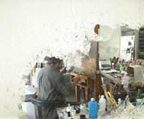
When Bricks Become Pixels
"When bricks become pixels, the tectonics of architecture becomes informational"- Marcos Novak: Screen-Wall--by Ruth Ron--challenges the conventions of public and private spaces in a museum. The 'service' or 'private' parts of the museum, such as the archives, offices or the guard booth, which are traditionally closed to the public, become the subject of the display, reversing the relationship of 'watching' and 'being watched'. Influenced by the expending presence of surveillance in our daily life, we appropriate the panoptic gaze onto concealed parts of the museum to become the content of the exhibition display.
The opaque solidity of physical architecture is challenged by multiple layers of the screen, the image of the wall and the transition to live video feed. The distance between remote spaces in the museum collapses, and digital and visual continuity is created. The network portal extends beyond the properties of the flat digital screen to become a reactive 'window' to unexpected places.
System: Parts of the gallery walls are replaced by small flat monitors. At first, the screens perform as mute, still images of their supporting walls. Once an observer draws near, the image transforms into a live video feed of a remote 'service' location of the museum, streaming via the internet. [via]
Posted by jo at 11:43 AM | Comments (0)
Hard Drive Orchestra
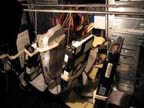
Radio Taking Place Between the Ears and Behind the Eyes
Hard Drive Orchestra--by Fundamental Radio (August Black and Markus Seidl)--is a sculpture and instrument that can be programmed to run autonomously as a stand-alone installation or played live and intuitively in a performance taking control commands via OSC, midi, or some other input protocol.
The hardware component consists of a mobile computer containing 8-16 IDE and SCSI hard drives of various ages of computing history and therefore of various sonic properties. The mechanical sounds of the drives are recorded live with 8-16 separate contact microphones, cleaned by a noisegate, and amplified over loudspeakers.
The software component consists of two objects written in C for PureData. One object performs very specific read-write operations on the various hard disks in order to force the disk's head to move from the innermost part of a drive's platter to the outermost part and back again. This results in an audible grinding click. The second object reads the data being written on each disk and blits it to the video screen. Essentially, the first object allows one to control the sonic activity of each drive while the second object simply displays the data to screen.
With the Hard Drive Orchestra, Fundamental Radio can analyze and present the physical, mechanical, and most importantly, the aesthetic properties of stored information. The HDO has premiered with "The Physical Mechanism of Forgetting" at the Freud Museum in St. Petersburg [Bolshoi Prospekt, Petrogradskaya Storona, 18a] as part of Traumlandshaften festival from October 7-10, 2003. There, the successive versions of the ****soft operating system have been deleted, slowly, over a week cumulating into a live performance of found and submitted data.
Posted by jo at 09:08 AM | Comments (0)
August 28, 2005
Improbable Orchestra + Burning Man
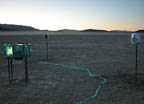
Tribal Knob Twiddling in the Desert
The Improbable Orchestra (IO) is an interactive audio installation designed to make digital music accessible to anyone. It consists of a central control unit surrounded by four speakers designed for up to four users to each control a sound sample using manual controls (knobs and buttons).
This sound installation was designed by our team to accomplish the following goals: 1. to create a tool to allow any user to experiment with working and designing music; 2. to create a visually appealing structure that creates a musical space; and 3. to create a musical tool that allows interaction between different players while they experiment with music.

Burning Man: Laser Harps, Improbable Orchestra Knob Boxes
For some of the most bizarre and unusual music-sound installation art, look no further than Burning Man [Related 1, 2, 3]. Burning, indeed: this desert-based event has in the past featured Eric Singer's Max/MSP-controlled pyrophone, a propane-powered flaming sound organ. (And, incidentally, that installation is making a repeat appearance this year.)
And what better activity when in the middle of the desert than tweaking knobs and producing strange electronic grooves? That's the idea behind improbable orchestra, an interactive table full o' knobs for collaborative soundmaking. Build one yourself: check out the copious design notes. Basic specs: the free Pure Data graphical multimedia development environment is running sounds, gutted Pentium PC with custom power supply, custom circuit board connecting the knobs and fiddly bits thorough a Parallax basic stamp board. (Lots more specs on their site, missing only details of the Pd patch.)
"But," says you, "I hate knobs. Give me lasers, man." Sure! You obviously want the interactive Aeolian laser harp, which suspends a series of laser beams through which you can walk to trigger sound. It's the creation of former NYU ITP faculty member Jen Lewin, now based in Colorado and doing interactive sculpture full-time. She has other fantastic projects like interactive butterflies. [blogged by Peter Kirn on Related.
Posted by jo at 10:22 AM | Comments (0)
August 27, 2005
wave_scan

Allegorical Mapping of the Liminal
wave_scan, by Brad Todd, is composed of an ELF (extremely low frequency) sensor, an antenna and a projection of a video database of water filmed over the past 15 years in different countries.
The system is centred around the ELF sensor. In paranormal research these electric and magnetic fields are also monitored by people searching for ghosts and other inexplicable phenomena: "cold spots" and other signs of paranormal activity reported by persons who think they are seeing phantoms are in fact closely tied to these EMF fields.
The ELF sensor is attached to an old TV antenna and is transmitting to a computer. Any detection of weak fluctuations of frequencies near the antenna results in the direct manipulation of a soundscape which is generated using a sine wave and white noise to create synthetic oceanic sounds. Any readings are also translated as clicks and pops, thereby creating a minimialist audio environment which gives audible evidence of a "presence" in the space.
Besides, the image slowly works itself from full chroma to blank, depending on the number of "hits" in the space. This sense of effacing the work and rendering the image into a ghostly and finally invisible screen closes a circuit or cycle of the works "life", in an allegorical mapping of our anxiety concerning the unseen or liminal... [blogged by Regine on we-make-money-not]
Posted by jo at 09:15 AM | Comments (0)
August 26, 2005
Residual Data-Cloud
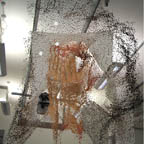
Residual Memory Immersed, Materialized in a Real Environment
The Residual Data-Cloud--by Diogo Terroso--is an application that loads images from a networked source and generates a data-driven three-dimensional form. Images are collected via a digital camera, or a mobile phone, by the author and participants during presentation. The resulting shape, which resembles a cloud of dust, is a metaphor of residual memory immersed and somehow materialized in a real environment.
Digital appears here as a parallel dimension, in which user’s perception is subjected to layers of abstraction and figuration. Its behaviour in the real space, captured by a tracking device, affects data display by revealing different properties of the cloud. Recognizable shapes appear and disappear through interaction. Movie.
Posted by jo at 10:26 AM | Comments (0)
August 24, 2005
Appendix2
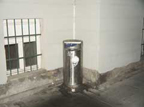
Activated by Passers-by
Appendix2--by Tanja Vujinovic and Zvonka Simcic--features an alternative state of urban landscape. The multimedia exhibition consists of short video works and interactive, computer based works displayed in the Kresija Gallery (Ljubljana, Slovenia) and interventions in the soundscape of the center of Ljubljana.
Small scale mechanisms (automata), made of sensors react to movement and small broadcasting units are hidden at several locations in the center of the city. Sounds are activated by passers-by and intervene into the structure of the town soundscape.
The sensors are attached to the garbage bins and passers-by are then blessed with sounds of Chinese market and rickshaw drivers, laundry machine and parody ads for perfume. Well, I should write "the sensors WERE atached" as they've just been stolen. Fortunately, the rest of the exhibition is still up and running till August 28. [blogged by Regine on we-make-money-not]
Posted by jo at 10:30 AM | Comments (0)
Career Moves
Players Can Create Their Own Semantic Systems
Career Moves--by Mary Flanagan--explores the contradictory world of women in corporate America through an interactive, computer controlled board game. Work is a troubling condition internationally for all women. Women represent 50 per cent of the world adult population and one-third of the official labour force, but they perform nearly two-thirds of all work hours, receive one-tenth of the world income and own less than 1 per cent of the world's property...
This commercial style is intended as a critique of the historical sequence to which the popular board game belongs: many games have traditionally supported social "norms," including heterosexuality, consumerism, and especially non-liberatory positions for women. However, as players progress down the board, it becomes clear that it is they themselves who are determining the rules of the game, and the collective and individual goals become apparent...
To participate in Day of the Figurines, the player must first visit a physical place. Here, they find a large scale model of an imaginary town at table height. The model is 1:100 and extends for several metres in all directions. The image is a mix of computer graphics and photographic collage.
The town has identifiable buildings such as the YMCA, the Big Chef, Video Zone, the XXX Cinema and the Battle of Trafalgar Square. There are other features such as a Cemetery, a Gasometer, a canal, a Level Crossing and an Underpass.
To play the game the visitor selects from a display of one hundred plastic figurines. They give the figurine a name, answer a few questions about him or her and then watch as she or he is placed at a random location into the model town. As they leave the space the player is given a small map of the town and a set of rules for the game.
An hour or so later the player will receive their first text message from the game, asking where their figurine would like to go. By replying to the message with the name of a place in the town the player’s figurine is set on the path towards that destination. Each hour a turn is executed and the invigilator moves each figure a small distance towards their destination. There are 10 turns a day for 24 days.
Intermittently each player receives text messages to alert them to nearby figurines in the model city, to their figurine’s arrival at a destination or to other events in the town. Each destination has a short description. For example, if you arrive at the The One Club you receive the SMS: “Home of the 2 Fs. The lock ins are legendary, the fire escape stairs have seen it all.” The goal of the game is “to help others”. Texting messages to other players may provide opportunities to do this.
The project is deliberately targeting low-end phones: it is playable on any phone that is able to receive SMS. Instead the technological focus is on orchestration and management tools. During the long-term test period, 8 players have been given phones that log Cell ID and upload this information to a server. We aim to use this data to assess when players are engaged, when they are most likely to play and how the game fits into their daily activity pattern. We will also carry out phone interviews with selected players at key moments, to study the interaction between game play and daily life.
Posted by jo at 10:12 AM | Comments (0)
160 Characters
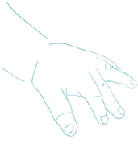
U Pt Yr Rt Ft In...
"How did you learn your first rhyming games? From other kids, right? As children we entertained ourselves by combining words, rhythm, and rhyme. Now we're big kids with grown-up toys, and Anita Bacic has built a new playground for us. 160 Characters is an exhibition of nursery rhymes, songs, and games gathered from all over the world, via mobile phones. People can contribute to her archive by text messaging lyrics and stanzas to a centralized phone number. The collected messages will form part of a multimedia installation, with a selection chosen for viewing with a retro slide viewer. Contemporary text messaging abbreviations and multi-lingual submissions are encouraged, thus opening the lid on a whole new toybox of ideas for those linguists and cultural studies buffs who like to play with notions of digital storytelling in the global village, the hybridization of culture through technology, or the role of mobile communication in creating new diasporas. So come on out and play--after all, isn't the 'Hokey Pokey' really what it's all about?" - Peggy MacKinnon, Net Art News, August 24, 2005, Rhizome.
Posted by jo at 09:27 AM | Comments (0)
August 22, 2005
Masaki Fujihata
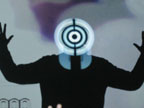
Innovative Public-Led Expedition
bodydataspace (b>d>s) have created a Multi-Media Design Studio with 3-D Exhibition Space for the newly renovated Jaywick Martello Tower. The premiere exhibition for the inaugural opening will be Mersea Circles by Masaki Fujihata. It is a 3-D interactive installation that emerged from an innovative public-led documentation process in August 2003. Taking place on Mersea Island, just off the Essex coast, some 150 people participated all using DV cameras and GPS. As they explored the terrain and its people they captured, with position data, their discoveries and experiences of the landscape, talks and interviews. From the myriad of data gathered, internationally renowned artist, Masaki Fujihata created his latest work.
In addition to the above exhibition, the event on Saturday, 17th September will include a live performance of Soft Ices by artist Mark Storor and composer Jules Maxwell at 3pm. There will also be a site-specific exhibition from the photographer John Kippin.
[b>d>s] is a design unit that delivers artist-led projects into architectural applications and uses interactive technologies to enable people to learn, develop and extend within intelligent data spaces, ultimately enabling the public to have a direct impact on the content of the space they inhabit. It combines the specialist knowledge and creative direction of its founders Ghislaine Boddington (body technology artist) and Armand Terruli (architect/video artist) in a unique collaboration that explores the artistic and technical opportunities present in the fusion of body, data, and space.
Masaki Fujihata / Mersea Circles / COAST: Masaki Fujihata is one of nine artists who have produced artworks for COAST, Essex County County’s ambitious art project celebrating the Essex coast. Mersea Circles is housed permanently at the Jaywick Martello Tower as well as the Ars Electronica Museum in Linz.
Saturday, 17th September 2005
12.30-3pm (invite only)
3-6pm (open to public)
Jaywick Martello Tower, Jaywick,
Clacton-On-Sea, Essex CO15 2LF
Entrance is FREE
Jaywick Martello Tower is the latest digital arts venue to open in the UK and one of the most unusual. This heritage project has transformed the Napoleonic tower’s first floor into a state-of-the-art environment where b>d>s have created a multi-media studio for exhibitions, events and workshops. It includes a floor to ceiling curved projection screen for immersive three-dimensional and audio-visual installations. This unique tower will act as a national resource for commissioning and presenting digital art from regional, national and well-known international artists.
The venue is the accomplished result of a 3-year collaborative venture between Essex Council, Bishops Park College and bodydataspace bringing together the arts, community and education. The Jaywick Martello Tower is managed by Bishops Park College, one of the brand new pioneering schools built under the Labour Government.
DIGITAL ARTS VENUE OPENS
Saturday, 17th September 2005
12.30-3pm (invite only)
3-6pm (open to public)
Jaywick Martello Tower, Jaywick,
Clacton-On-Sea, Essex CO15 2LF
bodydataspace (b>d>s) have created a Multi-Media Design Studio with 3-D Exhibition Space for the newly renovated Jaywick Martello Tower, featuring the work of international Japanese artist Masaki Fujihata.
Jaywick Martello Tower is the latest digital arts venue to open in the UK and one of the most unusual. This heritage project has transformed the Napoleonic tower’s first floor into a state-of-the-art environment where b>d>s have created a multi-media studio for exhibitions, events and workshops. It includes a floor to ceiling curved projection screen for immersive three-dimensional and audio-visual installations. This unique tower will act as a national resource for commissioning and presenting digital art from regional, national and well-known international artists.
The venue is the accomplished result of a 3-year collaborative venture between Essex Council, Bishops Park College and bodydataspace bringing together the arts, community and education. The Jaywick Martello Tower is managed by Bishops Park College, one of the brand new pioneering schools built under the Labour Government.
The premiere exhibition for the inaugural opening will be Mersea Circles by Masaki Fujihata. It is a 3-D interactive installation that emerged from an innovative public-led documentation process in August 2003. Taking place on Mersea Island, just off the Essex coast, some 150 people participated all using DV cameras and GPS. As they explored the terrain and its people they captured, with position data, their discoveries and experiences of the landscape, talks and interviews. From the myriad of data gathered, internationally renowned artist, Masaki Fujihata created his latest work.
In addition to the above exhibition, the event on Saturday, 17th September will include a live performance of Soft Ices by artist Mark Storor and composer Jules Maxwell at 3pm. There will also be a site-specific exhibition from the photographer John Kippin.
Entrance is FREE.
For b>d>s Press Invites, additional INFO and IMAGES contact Jamie McLaren:
Tel: 07949 111 871 or 020 7357 0823 / Email: jamie@bodydataspace.net
Partners of the renovation project include Essex County Council, the Heritage Lottery Fund, European Union through the Intereg IIIB programme, English Heritage, the Essex Rural Renaissance Fund, Essex Environment Trust, Park Resorts, EEDA and Tendering District Council.
NOTES TO EDITORS:
bodydataspace
b>d>s is a design unit that delivers artist-led projects into architectural applications and uses interactive technologies to enable people to learn, develop and extend within intelligent data spaces, ultimately enabling the public to have a direct impact on the content of the space they inhabit.
b>d>s combines the specialist knowledge and creative direction of its founders Ghislaine Boddington (body technology artist) and Armand Terruli (architect / video artist) in a unique collaboration that explores the artistic and technical opportunities present in the fusion of body, data, and space.
Masaki Fujihata / Mersea Circles / COAST
Masaki Fujihata is one of nine artists who have produced artworks for ‘COAST’, Essex County County’s ambitious art project celebrating the Essex coast. To find out more about the COAST project go to http://www.coastart.org
Mersea Circles is housed permanently at the Jaywick Martello Tower as well as the Ars Electronica Museum in Linz.
Managed by the local secondary school, Bishops Park College, it is planned that the Jaywick Martello Tower will be a catalyst for change, developing digital vocational skills. It will provide inspiration for the local community and attract interest and visitors from around the country and overseas to this unique location.
The site provides public access during the summer for environmental and historical groups, schools, tourists, walkers and visitors from overseas.
A permanent on the ground floor for a series of specially-commissioned permanent artworks by artist John Kippin on the theme of Essex coastal landscapes and the history of its military installations, linked with sites abroad.
A base for community arts projects with links to local schools.
Observation facilities on the on the roof, including a purpose-built look-out station, to be used by the National Coastwatch Institute (NCI). Visitors will also be able to use this facility.
The National Coastwatch Institute is a charity run by volunteers (principally retired people), who provide a visual watch to back up HM Coastguard.
European Interreg is a trans-European body which supports and finances international cross-border projects to achieve balanced regional development.
For information on the centre including the performance event Soft Ices and the work of John Kippin, contact: Keith Watson, Digital Arts Development Officer (c/o Bishops Park College):
Tel: 07802 748 484 / Email: mailto:keith@deluxe-arts.org.uk
Bishops Park College is not so much a school in the community but the community in a school with public library, family support day centre, cyber café, early year’s office and a purpose built neighbourhood nursery. The idea of community was a guiding principle in the overall design of the school, funded by the Private Finance Initiative.
The Head Teacher is Mike Davies.
LINK to Guardian Unlimited Feature on Bishops Park College: http://education.guardian.co.uk/egweekly/story/0,5500,1510479,00.html
Posted by jo at 09:14 AM | Comments (0)
August 19, 2005
A Measure of Anacoustic Reason
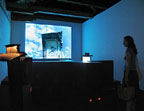
Turning a Deaf Ear
A Measure of Anacoustic Reason--by Raqs Media Collective--is an installation that registers a process of thinking about forms of reasoning that insulate themselves from listening. The installation sees the act of 'turning a deaf ear', as the unwillingness or inability to listen to the voices that refuse to be accommodated into the master narratives of progress, of instrumental reason and the domestication of space through the geomancy of corporations and nation-states. The visitor is invited to undertake his/her own audit of anacoustic reasoning through a meditation on a series of dialogues and rebuses that encrypt a set of paradoxes about the grandiose follies of seeking to rule the world by not listening to it.
A Measure of Anacoustic Reason is an installation consisitng of 1 projector, 4 screens, 4 dialogues, 4 lecterns and a lightbox. It was shown at ICon: India Contemporary at Venice Biennale 2005 (14 June-31 July, 2005)
Raqs Media Collective is produced at the Sarai Media Lab, Delhi and
at Montalvo Arts Center, Saratoga.
Additional Credits
Sound Editing: Iram Ghufran
Print Design: Mrityunjay Chatterjee
Production: Ashish Mahajan
For images of the installation please see
http://www.raqsmediacollective.net/anacoustic.html
http://www.universes-in-universe.de/car/venezia/bien51/eng/ind/img-
02.htm
Posted by jo at 09:02 AM | Comments (0)
I-F-E-A-R
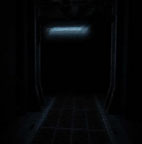
Linked Experiences
I-F-E-A-R (infrasound fear emotion audio reverb) is a project by Jodie Hancock, part of the CoEDD graduate exhibition. "This project is an exploration of emotion as a physical force and how that force can define an environment, often with more intensity than is defined by the senses. Fear is a dark and physical emotion which lends itself perfectly to conscious spatial composition."
Jo is using infrasound to see if specific emotions can be triggered. Just like walking down a dark corridor in a game can envoke fear, an installation was built for the exhibition which consists of a corridor. Outside the game Doom 3 is played by another participant. The two event are linked, as the player is controlling the infrasound played to the person in the dark corridor. As Doom is played, the video signal is sent to Max/MSP. The level of light as you walk around the game is monitored by Jitter video. Each time the player shoots in the game, the frequency of the infrasound is changed based on the darkness of the game, creating a linked experience. project website / development blog. [blogged by Chris on pixelsumo]
Posted by jo at 08:24 AM | Comments (0)
Lucid Touch
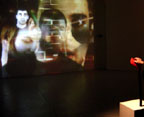
Emotion-Inducing Sculpture
Lucid Touch--by Lynne Sanderson--is a bioreactive sculpture that induces emotion using an affective feedback loop to control the flow of a dream. Through the sense of touch, bio-electrical arousal levels from the human body are altering the stream of a dream experience. The participant controls the mood of a simulated dream and the digital dreamer controls the participant's emotional state.
When a participant touches the interface with the hand, her/his biological data is detected through skin conductance response, heart rate and body temperature. The information is presented to the participant in the form of a dream, simulated using images, animation, digital video and sound. The dream is influenced and controlled by the participant whose psychophysiological state modifies the mood of the dream. His/her emotional / electrical energy controls video effects and sound. Which will in turn potentially have a direct influence on the participant's mood. Hence, the feedback loop.
A secondary feedback is that the interface physically alternates between warmth/cold and vibration. This will provide the participant with an eerie experience of something alive in the machine. An entity with the ability to sense emotion. The more excited you become, the more the entity "warms" to you.
The participant can learn how to "play" Lucid Touch with their bio-state. Once the participant is aware of this, she/he can learn to control their own emotional state by lowering stress levels or relieving boredom by raising arousal levels. [blogged by Regine on we-make-money-not]
Posted by jo at 07:21 AM | Comments (0)
August 17, 2005
R&Sie(n)’s Dandy & Mutant A-life Architecture

I’ve heard about…©
R&Sie(n)’s Dandy & Mutant A-life Architecture by Joseph Nechvatal: R&Sie(n)’s exhibition “I’ve heard about…©” opened on the 6th of July at the Musee d’Art Moderne de la Ville de Paris‘s temporary space at the Couvent des Cordeliers - and I think it is one of the most relevant exhibitions to what is going on in art today that is of importance. R&Sie(n) is an investigational architectural firm consisting of François Roche, Stéphanie Lavaux, and Jean Navarro; working here with Benoît Durandin. Together, they utilize generative heterogeneous mutations in the creation of proposed utopian city spaces. In fact what they propose at the Musee d’Art Moderne is the artificial growing of extruded urban housing (generative & robotic) - where new cities are constructed via robotic processes by feeding off the carcasses of older dying cities. Very viral. Envisioned is an approach to city planning based on growth scripts and open algorithmic procedures. Towards these ends the show itself includes some subtle audio tracts, model-sculptures, a fully immersive hypnosis chamber with video monitors, booking services, 3D movies and robotic drawings/plans that reveal the source code of the generative program at the heart of their work.
There is a definite tangled and intertwined approach to the city vector that reminds me of the dithyrambic visual hyper-logic which has manifested in all modes of decadent artistic periods; from the Hellenistic and Flamboyant Gothic, to the Mannerist, Rococo, and Fin-de-Siècle - as they all opposed dogmatically imposed ocular paradigms with hyper-engendering strategies of form. The multiplicity of its interwoven experiences challenges the now bogus idea of simplicity – a modernist-minimalist idea which has taken on the intensity of a righteous injunction in many cities where the implied equation between simplicity, surveillance and goodness obscures a less evident function: that of cognitive constraint. Such constraint runs counter to what Georges Bataille considered to be the non-hypocritical human condition, which he took as being roused non-productive expenditure (threshold excess) entangled with exhilaration. For the finest comprehensive overview of Bataille's thought in this regard, see his book Eroticism - but also Denis Hollier's book on Bataille's general postulates, Against Architecture.
Given the organic-like, biomorphic architectural forms R&Sie(n) spawn by their generative program, I could not avoid thinking about the Palais Idéal of Ferdinand Cheval (1836-1924) - which to my eyes appeared to be one huge budding edifice when I visited it a few years ago - as if the stupendous mannerist grotto-façade at villa Borromeo had been left to grow untrimmed and run amok. However, the Palais Idéal was constructed by the postman Cheval alone and by hand in the Hauterives (Drôme) (near Lyon) between the years 1879 and 1912; the result of 93,000 man hours of hard labour. R&Sie(n) rightly prefers the work to be accomplished through a computer programmed emergence via artificial intelligence which directs robotic execution. Why should humans physically work when we might better be playing and dreaming?
The other inescapable reference for R&Sie(n)’s work is the visionary city-planning put forth by the Situationists. One thinks immediately of Guy Debord’s essay On Wild Architecture, for example. Like the Situationists, for R&Sie(n), the urban form no longer depends on the arbitrary decisions or control over its emergence exercised by the elite few. Ultimately R&Sie(n) leads us towards juicy Situationist-like complexities and engagements by way of immersion into an open-ended multiplex conceivable as a virtual environment: the Virtual Reality experience.
As R&Sie(n) say themselves, “Many different stimuli have contributed to the emergence of “I’ve heard about…©” and they are continually reloaded. Its existence is inextricably linked to the end of the grand narratives, the objective recognition of climatic changes, a suspicion of all morality (even ecological), to the vibration of social phenomena and the urgent need to renew the democratic mechanisms. Fiction is its reality principle…” Ahhhhh, the domain of decadent art, VR and artifice. Against Nature.
What has been somewhat poorly determined however is the degree a dweller feels totally immersed in an optically excessive space. And this depends to a large extent on personal psychological need and adaptability in accord with the proposed spatial depth cues. Cognitive-aesthetic space has to be coordinated phenomenologically with the proprioceptive space of the eye - and R&Sie(n)’s only failure is in maintaining the evident structural seams of the immersive faux-hypnotic chamber (the only enterable structure and the highlight of the show) because what the entire show is proposing is a seamless immersion into generative totality, and the visual seams take us out of that exquisite fantasy. So they are denied the loveliest of triumphs.
A pity, as one might otherwise imagine oneself totally immersed there somewhat like a 21st Century dandy. As at the birth of the 20th Century, this new hyper-dandy constantly might affirm his or her originality down to the decorative details of the home. In that the robots are doing the algorithmic planning and building, this work definitely proposes a new form of dandyism - if dandyism’s defining characteristic is remembered to be the making of one’s person a work of art while extolling laziness and displaying contempt for work. Evident here are the Baudelairean/Duchampian dandy ideals of impassivity, nonchalance elegance, and inscrutability. What matters are the triumphs of a radical contempt for one’s “hand”.
Indeed one can say that “I’ve heard about…©” favorably extolled artificiality, indifference, impassiveness - the reign of an ironic causality and knotted ambivalence, while staying open to all transactions. Most importantly, a-life forms are embedded within it and its growth is artificial and synthetic. So R&Sie(n) maintains a version of transcendental phenomenological idealism, but they do not disavow the extant actuality of the material sphere. Instead they seek to elucidate the sense of the world-as-is today - that is viractualized – by stressing the embodied nature of human and artificial consciousness and bodily existence as the original and originating material premise of sense and signification.
All told, the show is well done – as proposition. However this proposition inevitably turns the mind to the actualized imposing suavity of Antoni Gaudí’s fully realized wavy architectural shapes in Catalonia. Although he did not travel about Europe, Gaudí was aquatinted with fin-de-siècle Belgium/French avant-garde movements because of the intimate relationship between Barcelona and France and with the pre-modernistic movements of Arts and Crafts, Gothic Revival, and Impressionism which were discussed in the intellectual proto-modernist circle which he frequented. But it was Victor Horta's Art Nouveau movement that influenced Gaudí the most, stimulating him to experiment with new materials and new fluid shapes that appear grown. Gaudí's version of Art Nouveau is characterized by an overwhelming proclivity for the organic nature of women, beasts, and plants which he translated into immersive utility.
Antoni Gaudí is a chief exponent of R&Sie(n)-type open algorithmic building procedures precisely with his 1906 building Casa Batlló located at 43, Passeig de Gràcia, Barcelona - noticeable for its organic tactility of bones and shells within, and its external cocked surf façade and chimerical roof. With Casa Batlló, Gaudí accomplished an astute transformation of an existing building, transforming it into an enchanting immersive gesamtkunstwerk as Gaudí thoroughly undertook the design of every single element of the building, from the extravagantly protuberant façade to all aspects of the interior, including the gracefully gnarled furniture. On the exterior Gaudí was able to combine a flamboyantly surging façade (in an ingeniously cool-color orchestration) while maintaining a dialogue with the neighboring Casa Ametller (1900), built by Josep Puig i Cadafalch (1869-1956) four years earlier. Powerful pillars which resemble the substantiality of mammoth elephant legs accost the visitor at street level, protruding into the sidewalk, nigh tripping up an unaware pedestrian. These legs are bordered by a craggy vertebrae-like tier and the wavy façade extends upward between these two biologically evoking forms, culminating at the roof in a gargoylesque humping crescendo. The façade itself, coated in a layer of Montjuïc stone, shimmers seductively under the sun in multifarious chameleon-like colors; fraught with a scattering of small roundish plates resembling fish or reptilian scales. Affixed to this seething mass of swelling construction are a number of small, elegantly curved balconies with oval shaped portholes.
The entire structure feels unsharpened, flowing and smooth in opposition to the street itself on which the arrangement sits, with the exception of a few square windows up top. Even the walls are gently rounded in strained undulation and contraction, as if they too have entered into the oceanic female throws of a fluttering uteral orgasm. The walls appear to be made of a soft, smooth, supple, leathery material and this illusion of softness is carried through by the roundness of the inside forms of the building where one has the feeling of being pleasantly encased in an expanse of hardened dripped honey. Turning, lunging stair railings are met, engulfed and supplemented by softly heaving honey-colored walls and wooden biomorphicly shaped carved doors and irregularly shaped windows. There are no right angled corners or straight lines, which offers an impression of being wrapped up in one continuous fluid wave motion, complimentary with the exterior. By comparison, R&Sie(n) still has a ways to go in achieving a like sensuality of its avant-garde stance. But one only hopes for them an immediate success in doing so.
Credits:
R&Sie(n) = François Roche, Stéphanie Lavaux, and Jean Navarro with Benoît Durandin
With the production and authorship of :
-Berokh Khoshnevis (Contour Crafting Process, USC, LA)
-Francois Roustang (Hypnosis specialist, Paris)
-Chris Delaporte (Film director, 3D effect, Paris)
-Christophe Berdaguer & Marie Pejus (Artist, Marseille)
-Mathieu Lehanneur (Designer, Paris)
-Laurent Genefort (Science Fiction writer, Paris)
-CNRS Grenoble, Laboratoire de Spectrometrie (Nano Particules)
-M/M (Graphic designer, Paris)
-Gilles Schaeffer (mathematicien, Paris)
-Michel Boulcourt (Landscape architect, Paris)
-Alexandra Midal (Author, Paris)
-Matthieu Kavyrchine (Video artist, Paris)
-Sebastien Szczyrk (Sound designer, Paris)
-Alexandre Merlet (Video producer, Paris)
-Stephan Henrich (Architect, Germany)
-Providence (Singer)
Prototype / installation / publishing
-Ufacto, David Toppani (prototype scale 1)
-One Star Press (neighbourhood protocole publishing)
-Christian Hubert Delisle (prototype)
-Thibaut Boyer (installation)
-Jean-Michel Castagné (electronic driver)
Sponsors, partnership
MAM Paris-Musée (F), MUDAM (L), De SINGEL (B), USC (USA), KANAZAWA 21st century museum (J), CNC / Dicream, (F), LAFARGE (F), Materialise (B), Next Limit Technologies (SP), DAPA (F), University of Architecture Innsbruck (OST), New-Territories (F)
Show closes the 9th of October. Musee d’Art Moderne de la Ville de Paris / Couvent des Cordeliers / 15 Rue de l'ecole de Medecine / 75006 / Phone : 0156813321
Images and more info available at: www.mam.paris.fr
Even more info available at: www.new-territories.com
Posted by jo at 08:06 AM | Comments (0)
August 16, 2005
Dance Dance Immolation
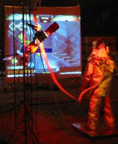
Lighting up the Burning Man Festival
So, what’s better than video games? According to the good people at Interpretive Arson, video games with fire, of course. If you don’t risk your life enough by slipping on dance pads (or by embarrassing everyone you love who’s watching you), then this Dance Dance Revolution hack, called Dance Dance Immolation, might be just the thing for you. What happens in DDI is that you dance like in any iteration of DDR, but when you do poorly, instead of simply losing points or possibly failing a level, you get blasted in the face with flamethrowers while in the protective suit you see here. (Though, to tell the truth, they’re using a DDR PC “simulator” to actually run the game.)
If you’re ready to step to the beat, and step into a full aluminized proximity suit (like the ones used to fight fires at airports), then stop by the 2005 Burning Man festival in Nevada, scheduled for the week leading up to and including Labor Day weekend (August 29-September 5), and give this hot twist on an already niche genre a spin. And if the author of the got-next.com article (linked below) which interviews the DDI Project Leader is to be believed, then you may be able to catch the crew as they’re testing in West Oakland each weekend prior to their big Burning Man debut. The original test run was held at the Crucible’s Fire Arts Festival in Oakland back in July.
Disclaimer: I try not to bother my downstairs neighbors by dancing furiously above them, but please (for the love of God), don’t try this mod at home. If DDR doesn’t get you hot enough under the collar already, just wait till the fire department has to clean up after you. Don’t say I didn’t warn you. [posted Dan Choi on joystiq]
Posted by jo at 09:49 AM | Comments (0)
August 15, 2005
SUIRIN:
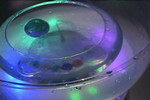
Computer-Augmented Healing
SUIRIN, by Satou Tokuhisa and Masa Inagake, is an installation that in a sense demonstrates how Augmented Reality technology could help people relieve stress. The device looks relatively simple at a glance – a container with water and floating glass balls called “ukidama.” Just play with the water and the balls, then you'll be rewarded by calming, ambient light, sound and smoke. You might eventually get immersed in the feedback-control loop that may make you forget about your stressful day.
The key of this installation is the sophisticated sound augmentation mechanism using four microphones, FFT-based sound processing, and four surround speakers. What you hear from the speakers is something similar to suzumushi (bell-ring cricket)'s sound. This auditory experience is enhanced by the lighting, smoke and tactual sensation.
This is what I would call an Iyashi-kei installation. Iyashi-kei is a Japanese word meaning “a genre related to healing.” This word is relatively new but now very popular and used to describe everything including music, films, things, places, and people. Electroplankton is an Iyashi-kei game, Jennifer Aniston is an Iyashi-kei actress, and so on.
Anyway, I shouldn't forget to mention that this installation was shown at SIGGRAPH2005! [blogged by manekineko on we-make-money-not]
Posted by jo at 12:30 PM | Comments (0)
Eavesdripping
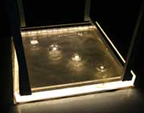
Rendering Communication Visible and Experienceable
Eavesdripping, by Sascha Pohflepp, uses water as medium and display to render invisible communication visible and experienceable. A matrix of magnetic nozzles opens a valve when current is applied. To add some controllability to the setup, a computer running MAX-MSP/Jitter processes information and connects to two relay-boards which are controlling the individual nozzles.
To increase the visibility of the splashes on the ground, the water surface sits in a container made of clear acrylic. From one side, light is being pumped in by an array of super-bright LEDs. Since the acrylic and also the surface of the water is subject to the effect of total reflection, the water stays perfectly black. However, when a drop of water breaks the surface, the light brightly lights up the spot.
Because the way of displaying is physically so present, it would be best to initially use it to visualize something and make it sensually experienceable which is equally present, but not perceptible. The metaphor of the installation would be to wash something from the air and make it visible on the ground in front of you. The idea of visualizing internet wireless conversations emerged. For achieving this, the packages were successfully "sniffed" from the air, parsed to readable text, processed for being output in the form of drops and then displayed on the ground for everyone to read. Video. See also Erez Kikin-Gil's Water Play. [blogged by Regine on we-make-money-not]
Posted by jo at 12:24 PM | Comments (0)
August 12, 2005
HINGES ON
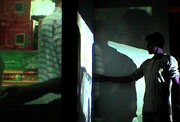
Adaptation, Access, Regulation, Open Source
HINGES ON is an interactive film installation on the informal and formal economies of India's "ICT capital", Bangalore. Visitors enter through a sparsly lit sound tunnel, where they are exposed to an audio experience of failed efforts to retrieve information. (The sound works can be downloaded from the site.) Finally, one is released into the room hosting the video installation. Multiple door-shaped screens in the centre of the space serve as projection surfaces for the four simultanous projections. The screens are on hinges and invite the visitors to turn them into the angel required to catch the projection they wish to watch. (You can find information on the themes and issues in the backdrop section). A switch board provides the interface to the speakers featured on video. (In depth documentation of the process including a list of interviewees and the 'making of switch board, doors and software patches is accessible here!'
HINGES ON at Ars Electronica, opening September 1, 2005, 15:30, Campus / Kunstuniversität Linz. The work was realized by ambientTV.NET during the Tactical Media Lab at Srishti School of Art, Design and Technology, Bangalore, India; with Thomas Abraham, Salam Hidish Singh, Ishan Ghosh, Nishita Kavadia, Siddharth Muthyala, K.T.Thomas, Pratima Kalmadi, Divya Viswanathan, Umang Razdan Bhattacharrya, Ramyah Gowrishankar, and Priyanka Dilip. Lab led by Manu Luksch and Mukul Patel.
Posted by jo at 09:19 AM | Comments (0)
Orchestra of Anxiety

The Concept of Security
In Orchestra of Anxiety, London-based artists Manu Luksch and Mukul Patel expand their ongoing explorations of the concept of security. While 'security' can be seen as desire, as ideology, as illusion but never as a guaranteed status quo, socio-political measures of control, ... have been implemented in the name of security. The security industry is one of the fastest growing sectors this decade, and is worth hundreds of billions of dollars annually. A participative installation piece--to be shown at Watermans Gallery--Orchestra of Anxiety deploys security and surveillance technologies in an unusual and playful context, prompting visitors to reflect on their personal sense of security and their relationship with public fears (of petty crime, terrorism, etc.).
The central focus of the installation at Watermans is a harp, traditionally regarded as a sacred or metaphysical instrument associated with tranquillity, love and goodness. However ambientTV.net’s harp differs from standard harps as it is strung with razor wire, requiring the harpist to wear protective gloves while playing. The protective gloves complete data circuits when a string is touched, triggering multiple projections and sound sources in the gallery. Before playing, the harpist must first overcome the instinctive anxiety the instrument provokes.
Orchestra of Anxiety is produced by inter-disciplinary arts production company ambientTV.NET. ambientTV.NET highlights models of networked and collaborative practice. Techniques and effects of data transmission provide theme, medium and performative space for works spanning installation, performance, documentary, dance, gastronomy, and live sound and video art. Much of the film and music production is freely disseminated through the website.
Posted by jo at 08:45 AM | Comments (0)
August 09, 2005
SMS Chatwall
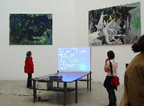
A Sculpture Replies
For this year's diploma exhibition of the Hochschule für Bildende Künste Dresden (Dresden's High School of art), Matthias Haase has presented a project using a special version of the SMS Chatwall event software. Haase installed the GSM-module, a computer and beamer equipment on a table with a projection screen, calling the installation "Bote" (messenger). Exhibition visitors can send short messages to the number shown on the screen. As a take-away gift for the visitor, the sculpture replies with an artist's "thank you" SMS, mentioning the art exhibition at the HfBK 2005.
People who want to take part, but can't attend the exhibition can send an SMS to +4915204912748. Thanks a lot Alex! More here if you speak german. [blogged by Regine on textually.org]
Posted by jo at 08:36 AM | Comments (0)
August 08, 2005
Shadow

Merged Shadows: 1/2+1/2=1
Shadow, by Adam Frank in collaboration with Zack Booth Simpson, projects a disembodied, autonomous, human shadow on the ground. This "living" shadow attempts to merge itself with the viewer's real shadow. If you run away, the shadows will follow. If you move towards the shadows, they will retreat. But if you stay relatively still, the shadows will slowly approach. The shadows will then position their feet directly on top of yours. This act merges your own shadows with the invisible figure. Once merged, the virtual shadows disappear.
Our shadows are with us constantly yet we pay little attention to them. These shadows are the absence of light due to our presence. Shadow merges viewer and artwork, the real and the virtual, into one entity. The feeling of both the presence and absence of another human being is visceral and ghostly. In a sense, this piece functions as a quiet, interactive, anonymous memorial. Video. Check also Lumen, a stainless steel shadow projector. Related: Tool's life, Lies, all lies, 3 minutes2. [blogged by Regine on we-make-money-not]
Posted by jo at 10:12 AM | Comments (0)
August 07, 2005
Two from nARCHITECTS
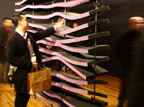
Vital Signs + Party Wall
Vital Signs, by nARCHITECTS, is an interactive installation project designed to disseminate breaking news about science to visitors in the Liberty Science Centre (NJ). A continuous moebius strip of LEDs interspersed with projections would allow visitors to view streaming information from all sides of the atrium. A ladder-rung structure consists of an outer aluminum edge rail joined together by intermittent rungs. Plexi ribs supporting the LED’s and translucent plexi projection surfaces span between the edge rails. Visitors can dynamically select topics or upload information from various points along the mezanine handrails.
Recently, nARCHITECTS had also created the Party Wall for the SoHo gallery Artists Space. The installation created a variable boundary in the gallery, dividing visitors into different sides of the room. The 5 cm-thick foam panels connect to servo motors, proximity sensors as well as pulleys and cables that react when the sensors detect motion nearby. The motors exert pression on the pulleys, lifting, depressing, expanding or compressing the foam into waves visitors can interact with. Future versions of Party Wall could respond to light, heat or sound, and correspondingly modulate optical, thermal or acoustic attributes of a wall. Movie. [blogged by Regine on we-make-money-not]
Posted by jo at 09:18 AM | Comments (0)
m@terials:
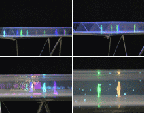
3D Theater on a Table
m@terials, developed by Jitsuro Mase, use an off-the-shelf LCD projector to display a "3D theater" on a table. A video clip available on the Digital Stadium website. It's amazing that this actually works because the hardware device looks deceptively simple. On the table top are transparent plastic strips standing diagonally at 45 degrees. The plastic strips make images stand up. The virtual people can be projected on to a strip closer to you or the ones further away from you.
Digital contents that can be effectively displayed on this device should conform to specific rules, however, "it is not so difficult" according to the creator of this device. This device could be used for many different kinds of things besides the "3D theater" especially if it could be made larger (possibly as big as a computer displays or a building floor?) with hi-fidelity realistic images. [blogged by manekineko on we-make-money-not]
Posted by jo at 07:05 AM | Comments (0)
August 06, 2005
+336+
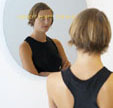
SMS Controlled Spy-Mirror
The +336+, designed by Robert Stadler, is a mirror able to receive SMS sent from a mobile phone. The messages appear as luminous text, running on the mirrors’ surface when one gets close to the mirror. [via textually.org]
Posted by jo at 07:01 AM | Comments (0)
August 05, 2005
Printball
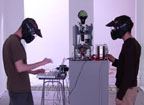
Recyclism, aka Benjamin Gaulon
"I urge you all to go and check out the work of Recyclism, aka Benjamin Gaulon, fantastic stuff. Here are two projects that I want to post separately. The first is Printball. Imagine an inkjet printer, but instead use a paintball gun and shoot dots at a wall to print the image. Created using Max/MSP and an Atmel board. There is a good 32mb mpeg4 to download (in the projects section). I (also) introduce you to The Res® (Recycling Entertainment System). 6 NES controllers, midi signals and Max/MSP allow players to jam together. There are 4 videos in the project section of the Recyclism site. [via]. Digital Recycling was Spotlighted on Turbulence in 2004.
Posted by jo at 08:58 AM | Comments (0)
August 04, 2005
EA's m/M
Six Hour Continuous INSTALLATION-PERFORMANCE
EA's m/M: [1] As computers keep offering us the ability to play with numbers in increasingly complex ways, our perception of proportional relationships is being exponentially challenged. We begin to realize our involvement in a ubiquitous hyper-game where reality fades into its own representation. [2] Even time is no longer regarded as an absolute parameter to which safely anchor ourselves. With the realization of these, ever-shifting dynamics comes the desire to take on an active role and to start interacting with the idea of relative magnitude, and with the way in which we perceive proportions. Microphones and amplifiers, optical lenses and projectors are some of the instruments that make it possible for us to monitor, analyze and redefine ourselves within our environment. Such technical tools, as well as philosophical hypotheses, are abundant and allow us a wide range of exploratory possibilities.
This exploration is the scope of m/M, EA's installation/performance in Williamsburg's Galeria Galou and its surroundings. During six hours, sounds and images will be collected from near and far, processed and re-presented in our first attempt to formally engage with the fluctuating interface that lies between the micro-bound and the macro-bound. An empirical test bench equipped with various electronic devices will be installed inside the snug space of the gallery. Its function will be to collect and process the sensorial information and to send it back to the outside world - the gallery's bare industrial surroundings and further on, eventually reaching EA member Andre Goncalves who will participate to the event via Internet connection from Lisbon, Portugal. Guest sound artist Brendan Murray, visiting from Boston, will provide yet another "outside perspective" to be internalized in the performance. Rather than a specific sound or an image, EA's piece will be constituted by the whole machine/environment. m/M is the whole functional apparatus designed to create dimensional loops and to attempt a short-circuiting of the conceptual extremities of inward and outward subjective planes. Passers-by will be attracted to the core of the performance space, and encouraged to participate in this empirical and expansive process.
EA is Gill Arno, Richard Garet, Andy Graydon, Andre Goncalves (performing from Portugal via internet), Brendan Murray (special guest from Boston) and Gil Sanson.
Galeria Galou: 237 Kent Ave. (bet. North 1st and Grand), Williamsburg, Brooklyn, NY 11211. Take the L train to Bedford - about 5 minutes walk from the train. Tel: 718-486-3730
Posted by jo at 12:14 PM | Comments (0)
Hyperfabric
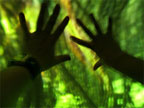
Haptic Magical Mystery Tour
The Hyperfabric fabric-based interface lets you reach beyond the screen. This "touchable" touchscreen, made out of an elastic latex-like fabric warps like rubber, and can sense how hard your press it, where you press it, even when several people use it at once. It feels like you are going "through" the screen.
You can press, grab, twist, punch and play with the screen. It can even support your full bodyweight. The Hyperfabric screen is specially designed to communicate with a computer to generate interactive computer graphics, in realtime.
Adam Montandon and the team at HMC MediaLab created a 7 feet high Hyperfabric installation for the Artytechs parlour this summer at the Port Eliot literature festival. Taking place in a hidden dungeon underneath the stately home, visitors had the chance to come face to face with the magical and mysterious interactions. [blogged by Regine on we-make-money-not]
Posted by jo at 08:28 AM | Comments (0)
August 02, 2005
Mirror
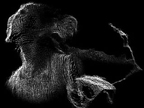
Interact with Your Own History
The excellent United Visual Artists have recently created their first gallery installation titled Mirror, showing at the Kemistry Gallery in London 2nd - 30th August. "UVA's first gallery installation, Mirror inhabits an area between portraiture, sculpture, and the motion studies of pioneers such as Eadweard Muybridge. A stereo camera pair creates a moving three-dimensional image of the viewer, projected in real time into the space.
Snapshots of the space are combined to create a fluid history of all movement in the space. A viewer can therefore interact with their own history, creating new spatial forms as if painting with their body. The scene is rendered from a shifting viewpoint, allowing the viewer to see themselves from unusual angles. At the same time, the stereo process introduces unexpected errors and distortions, forcing us to consider that the machine has its own way of seeing, and thereby foregrounding the limitations of our own perception". [blogged by Chris on pixelsumo]
Posted by jo at 10:42 AM | Comments (0)
August 01, 2005
R*Emote Mirror
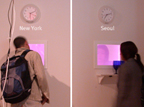
Hole in Space Update
R*Emote Mirror--by Yeonju Shim--is a pair of networked interactive lighting installations that creates communication between isolated people in urban cities and their loved ones who live far away. The telepresence installation re-creates feelings of togetherness and physically connected interaction between distances and spaces, allowing each person to interact through the expression of his or her movement. r*Emote Mirror has two functions: one is a mirror, and the other is interactive color lighting. Each r*Emote Mirror will have an initialized color representing the user, and trigger the movement of the person with different colors. When two persons stand at the same position in front of their installations, r*Emote mirror makes them see color changing and blending of their individual colors.
If you are living in Seoul and are close to the mirror, you can see your own shape on the panel in red light. At the same time, your friend living in new york can see your red color on his or her panel at home. if your friend is close to the panel, s/he can see his or her own body shape as blue light. If you are both in front of each mirror, the overlapping of color will hopefully evoke feeling of togetherness. For instance, if red overlaps with blue, it makes purple. [blogged by Regine on we-make-money-not]
Posted by jo at 11:35 AM | Comments (0)
July 29, 2005
Ecce Homology
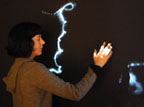
Can artistic approaches and aesthetic experience nurture discovery in the sciences?
Ecce Homology is an interactive installation that bridges art and science through the use of dynamic media, computer vision and computer graphics. Named after Friedrich Nietzsche’s Ecce Homo, a meditation on how one becomes what one is, the project explores human evolution by examining similarities – known as “homology” – between genes from human beings and a target organism, in this case the rice plant.
Experience Ecce Homology during SIGGRAPH 2005, July 31 - August 4, 2005 at the Los Angeles Convention Center. Five projectors present Ecce Homology’s calligraphic forms across a 40-foot wide wall. A novel computer-vision interface allows multiple participants, through their movement in the installation space, to draw their own calligraphic characters and select genes from the human genome for visualizing the Basic Local Alignment Search Tool (BLAST), a primary data-mining tool used worldwide in comparative genomics. Results are presented as two superimposed pictograms. Ecce Homology asks: Can artistic approaches and aesthetic experience nurture discovery in the sciences? Read an article.
Posted by jo at 09:53 AM | Comments (0)
July 22, 2005
Golden Numbers
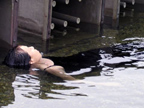
with Red Symbol
Golden Numbers--by Park Lee Chang Shik--is a sound installation that uses the gigantic speakers that were formerly used at the DMZ (demilitarized zone on the border between North and South Korea) for broadcasting propaganda. In this installation, the numbers from 0 to 36525 are read out. This number represents the number of days in the hundred years from August 15, 1945 to August 15, 2045. Further, recordings of old radio broadcasts and sounds produced in real-time from encoded signals are heard intermittently, and the audience can also use a microphone to broadcast their own voices through the speakers.
All these sounds mingle slowly around a circle, resembling the movement of a clock's hand or the orbit of a celestial body, and allude to the passage of time and history. The voices recorded into the microphone show that everyone lives within the flow of time, and contributes to history in some way. [via]
Posted by jo at 09:44 AM | Comments (0)
July 15, 2005
Tactile Photography
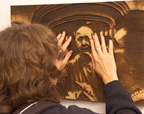
Worn by Touch
In collaboration with Mariliana Arvelo, James Patten created tactile photographic prints as part of a project about the deafblind community in Boston. The Tactile Photography pieces are produced through a CNC laser etching process that removes the top portion of the wood. The darker the image is a point, the more wood is removed by the laser. The result is a photographic relief that can be touched as well as seen.
As people touch the images, the surface of the wood continues to wear, and people's experience of the work becomes part of the work itself. No computers nor sophisticated mechanical wizzardy but that doesn´t make these works less "interactive". These images are on display until July 31, 2005 at The Gallery at the Piano Factory, Boston, MA 02118 [blogged by Regine on we-make-money-not]
Posted by jo at 08:23 AM | Comments (0)
July 08, 2005
Where are you?

Re-Enchanting the World
Enter the Panoscope 360° to be fully immersed in a 3D world. A 3-axis joystick will let you and your friends (up to 8) fly through the space as in dreams. The immersive display uses a PC and a hemispheric projector to project in real time a rendering of your entire horizon onto the screen.
In Where are you?--by Luc Courchesne--visitors are invited to fly, as in dreams, through a world of many dimensions, using a joystick to move in the X, Y and Z axis of a space where scale matters.
At scale 0, the world looks like a simple XYZ grid defining the experience of the navigable space. At scale +1, the world turns into an archive of pictures, sounds, texts and objects. Zooming out at scale +2, elements of this archive become particles in a "molecular" world of self-organizing clouds of lights. Zooming yet further out at scale +3 reveals a landscape of mountains and valleys.
At any moment in the Where are you? world, visitors may come upon other beings: live ones through telepresence links, pre-recorded subjects in video windows and themselves when cameras transmit their own image in this constructed world. In Where are you? the visitor controls his/her position, the path and speed of his/her journey and the scale at which he/she is prepared to "exist". Video demo. [blogged by Regine on we-make-money-not]
Posted by jo at 01:58 PM | Comments (0)
July 05, 2005
a_mirror

Continuous Portraiture
a_mirror--by Limiteazero--is an installation comprised of a glass mirror, which reflects both in a physical and virtual way. It explores the present at different reading levels, including a continuous flow from present to past. Standing in front of the mirror, an image gets physically reflected in it; then a graphically modified image softly appears as a second level of reality, a sort of interpretation of the real image. The piece is wirelessly connected to the internet: lightly touching the small metal disc in the center of the mirror, the current image on the screen is grabbed and uploaded on a specific url on the internet.
Posted by jo at 09:59 AM | Comments (0)
June 28, 2005
Step + Repeat: Pittsburgh Cycle
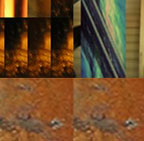
Shifting Technologies and Economies
Step + Repeat: Pittsburgh Cycle--by Carlos Rosas and Robert Dansby--Call for Participation: Submit your images of Pittsburgh. Your images will be entered into the image database and be included in the participatory tile sequence projected in the Palmer Museum and viewable on the Internet via live webcast. For more information on this project, to submit images and to view the live broadcast visit the project web site.
Abstract: A live audio and video based piece using networked media. Based on digital “step and repeat” cycles: a loose metaphor, the Pittsburgh iteration uses video and audio samples recorded in Pittsburgh, PA, and the surrounding western Pennsylvania area –with touchpoints including Primanti’s, the Strip, the Southside, East Liberty, the Northside, Beaver Falls, Jones & McLaughlin, the Monongahela Incline and Pittsburgh’s three rivers.
Divided into into six primary segments and a seventh segment including material contributed by viewers to be filtered through a digital randomizer, step and repeat: Pittsburgh cycle maps entrance into an urban environment via incline railway, transit through the city, reflections of the community’s industrial past, particularly steel, and the transformation of city and countryside as the industrial economic base shifts and nature again takes hold of old worksites. In the last two segments the viewer leaves the city, again on incline railway, and watches as the evening paints the city as a visually appealing study of water and reflection.
Concept and Development:
With a nod toward Allen Sekula’s work: specifically “Fish Story.” This piece chronicles (in a documentary fashion) the ironies, displacements, shifting values, economies and systems: the transformation of an American city as an industrial and economic center shifting from steel to telecom, and the reclamation of areas of the city and countryside dedicated to old economies/technology by both nature and the population at large - a population with new needs but retaining a core identity.
The “Step and Repeat” cycles are variable and highly dynamic works performed live with laptops or in automated modules prepared for web or installation on site. The media resources are mixed, filtered, and emitted via live performance software…deriving image, video, qtvr, audio, and net streams from databases and databanks resident on local and networked laptops and servers.
Posted by jo at 12:21 PM | Comments (0)
Tune Me
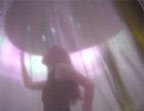
Multi Sensorial Radio
Tune Me is an immersive conceptual radio based upon tactile features. The sound and the visual are triggered by "touchy" interfaces. The visitors enter the ellipse-shaped space, immersing themselves in a new world where to listen to the radio waves.
As well as the sound, each channel provides light features as well as vibrating and pulsing experience. When choosing the different FM stations, the overall space changes, defining different moods upon the nature of the different content. News, sport, classical music and international pop. Each of them triggers a different visual experiences, the space vibrates, pulses and interacts with the visitors.
Developed by Line Ulrika Christiansen, Stefano Mirti and Stefano Testa (with Daniele Mancini and Francesca Sassaroli). More pictures by Stefano and Simone. Also part of Touch Me at The Victoria & Albert Museum (London) till August 29th 2005. [blogged by Regine on we-make-money-not]
Posted by jo at 08:18 AM | Comments (0)
June 23, 2005
TIME TRANSLATIONS
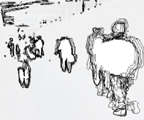
Pedestrian's Dance
Time Translations--an interactive installation by Nell Breyer-- transforms the World Financial Center's southern pedestrian bridge from a temporary structure to an animated performance space through the projected movements of passers-by. Cameras capture the constant movements along the bridge in real time, which are then processed by computer, and projected into the space as beautiful, ephemeral drawings on the walls fo the bridge. The daily activity of walking to work is visualized as a kind of dance in which pedestrians become performers. [Schedule]
Nell Breyer is currently a Research Affiliate at the Massachusetts Institute of Technology's Center for Advanced Visual Studies. She was a fellow at the Artist Resource and Media Laboratory (ARM) at Dance Theater Workshop in 2003. From 2000-2002, Breyer conducted research on digital video technologies at The Media Laboratory for Arts & Sciences at MIT. She holds an M.Sc. in Cognitive Neuroscience from Oxford University and an M.S. in Media Arts & Sciences from MIT.
Posted by jo at 10:30 AM | Comments (0)
June 13, 2005
Luminance
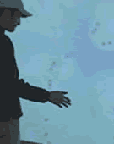
Illusion, Interactivity, and Imagination
Luminance is a live, playful, interactive art installation in which participants use their own physical body movements to create and influence digital content on a 10' X 7.5' screen. Participants are completely untethered. Their gestures, dancing, leaping and stillness can create image elements on the screen that move with the user and/or move digital content already on the screen.
The connection between man and machine has evolved since the invention of the wheel. Our digital age offers increased opportunity to explore the mechanisms by which people in physical realities interact with the world of bits and bytes. These richer, technically sophisticated interactions are gravitating towards humans’ inherently natural movements. With each additional technical innovation, the tethers between man and machine become smaller and less obtrusive, eventually erasing the physical connections altogether. Such innovation allows for creative and artistic exploration as well practical implementation.
A participant in the Luminance installation does not use an input device such as a mouse, keyboard, virtual reality goggles, or any other augmented device. Within the installation space, the user’s image is captured by a video camera. A computer analyzes the user’s image and converts his/her postures into a set of point coordinates.
These coordinates are transmitted to a second computer projecting digital content onto the back of a screen. The point coordinate data from the participant’s movements is used by the second computer to manipulate the projected graphics and sounds. The user plays an integral part in this feedback loop, responding physically to the projections. In some scenes, this movement changes the content and in other scenes it actually creates the content.
Luminance’s technical foundation provides an opportunity to explore the “Three I’s” – Illusion, Interactivity, and Imagination. The illusion of content is combined with interactive movement, providing a multimedia experience which provokes the imagination of Luminance participants, resulting in another level of content. Participation and interactivity are as much a part of the storyline as the visuals projected on the screen and the sound playing in the background. The variety of content provides a number of unique experiences for the participant and increases the potential for inner narrative. [via Rhizome]
Posted by jo at 09:28 AM | Comments (0)
June 07, 2005
Heartbeats
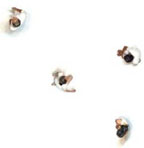
Trapped Between
"The first work that caught my eyes at WRO 05 was an interactive installation called Heartbeats by Orna Portugaly, Daphna Talithman and Sharon Younger (2004). Heartbeats is an installation in which, by letting yourself interact with a machine, your own interaction with other human-beings comes into focus. In the centre of the installation is a round table onto which four beautifully filmed video figures, captured from above against a totally white background, are projected. As four touch screen stations surround the round table, a visitor, when placing his/her fingers on one of the touch screens, becomes assigned with one of the video figures. Awaken, the video figure starts engaging in repetitive movements. The pace of the movement is controlled by the heartbeat of the participant, captured by ECG via the touch screen, and the figure is caught in its own repetition until it meets another video figure..." From Between Art and Technology by Sachiko Hayashi at HZ Journal.
Posted by jo at 02:40 PM | Comments (0)
June 06, 2005
Database of Virtual Art
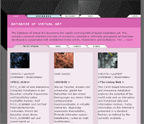
Thesaurus of the Database
We are pleased to announce the release of the extended Database of Virtual Art. It now provides an enlarged set of features and research opportunities: The major novelty is the freshly implemented Thesaurus featuring a variety of categories and keywords. The Database offers an extensive search tree that permits a targeted set search: e.g. genre: interactive art or theme: body.
The Thesaurus of the Database constitutes a new approach to systemize the field of Digital Art and the terms and concepts connected to it and will grow over the next few months. We encourage your remarks and suggestions! As a pioneer in the field, the Database of Virtual Art has been documenting the rapidly evolving field of digital installation art since 1999. It is supported by the German Research Foundation and various other institutions.
Our research-oriented, complex overview of immersive, interactive, telematic and genetic art has been developed in cooperation with renowned media artists, researchers and institutions. The database is based on open-source-technologies and allows individuals to post material themselves. Currently it contains hundreds of work descriptions including several thousand digital documents, technical data, institutions and bio-bibliographical information about the artists. As one of the richest resources available online, the database responds to the demands of the field.
Video is especially able to document the processual nature of interactive works. Therefore we have strategically integrated this medium into our concept since 2002. Over time the interlinked layers of data will also serve as a predecessor for the crucial systematic preservation of this art.
Director: Prof. Dr. Oliver Grau,
Oliver.Grau[at]culture.hu-berlin.de
Technical Lead: Christian Berndt, M.A.
berndt[at]kulturtechniker.de
Main Editor and Development Manager: Anna Paterok, M.A.
vkunst01[at]cms.hu-berlin.de
Video Documentation: Robert Loessl
robert.loessl[at]channel-unit.de
Institution Coordination: Wendy Jo Coones, M.A.
wendy[at]coones.net
http://virtualart.hu-berlin.de
Address:
Kunstgeschichtliches Seminar
Humboldt-University Berlin
Dorotheenstrasse 28
10117 Berlin, Germany
http://www2.hu-berlin.de/grau
Posted by jo at 05:13 PM | Comments (0)
Intimate Transactions
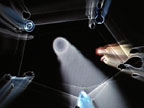
Sensory Intimacy Across Time and Space
Intimate Transactions--by The Transmute Collective--is a new type of interactive installation that allows two people located in separate spaces to interact simultaneously using only their bodies. Each participant uses a physical interface called a ‘Bodyshelf’. By gently moving their bodies on this ‘smart furniture’ they instigate ‘Intimate Transactions’, which influence an evolving ‘world’ created from digital imagery, multichannel sound and tactile feedback. This shared experience allows each participant to gradually develop a form of sensory intimacy with the other, despite the fact that they are geographically separated and cannot physically see or hear each other. As this highly immersive experience evolves, each participant begins to sense their part in a complex web of relations that connect them, and everything else within the work. In this way a subtle, indirect form of collaboration develops via an increasing sense of intimacy between sites.
Participants may choose to act in different ways as they begin to understand how their actions affect everything within the environment AND the other Participant. Hence the work focuses participants upon understanding influences and relationships within the work's ecologies.
Intimate Transactions was awarded an Honorary Mention in the 2005 Prix Ars Electronica Competition. It will next be shown in Sept 2005 at the Ars Electronic Festival, Austria and in October 2005 at the Institute of Contemporary Arts, London.
Posted by jo at 11:03 AM | Comments (0)
June 03, 2005
Significant Sites - a Summer Solstice Dérive
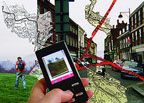
An Invitation to Participate
Significant Sites-a Summer Solstice Dérive is inspired by the Situationist practice of dérive. John and Cathy Rogers set out to chart the layers of place that make up High Wycombe as it undergoes a period of transition and redevelopment. After conducting and initial period of investigation through a series of dérives and interventions they intend to stage a grand psychogeographical event on June 18, 2005 during the Summer Solstice.
A Walker will embark on a ritualistic perambulation to link up the significant sites, or Nodules of Energy that surround the town. He will use the town's matrix of ancient footpaths to achieve this circuit. Using a videophone he will send moving images to a base station in a prominent position in the town centre where they will be projected onto a screen where spectators will be able to watch the walk as it happens.
The relayed image of the walker is presented alongside a montage of archive film and present day photographs of the town together with a simulated image of the town. In addition to the video clips the walker will send reports from his location via voice and text messages.
Spectators will be able to interact with the walker giving him directions to places they consider to be significant sites and furnish him with information and folklore about the areas he walks through.
People will be encouraged to set out on their own dérives and send back images and text to the base station for projection and relay to the audience.
Posted by jo at 02:14 PM | Comments (0)
June 02, 2005
Mirror_Space

Data Portraits
The mirror provides us with phenomenal images of our appearance according to physical laws. Mirror_Space is a system of reflections of a type which involves not only optical appearances but also forces which act on us and which we cannot control affecting our phenomenal image. The person is viewed as a node which is networked with the whole of existence. Effects which can be grasped by our perception are presented in this system as dynamic data and converted into three-dimensional objects. This process also involves the compilation of a virtual image, but the filter is the calculation on the part of the computer, which not only processes our extended characteristics but also data supplied simultaneously from the world.
Users can experience their 'transformed image', which corresponds to the information supplied via a data network. The mirror image reflects the users' internal state (through image-based mood analysis) & their external affiliations (through information streams from the internet at the corresponding time, such as satellite photographs, live cam images, weather data, stock exchange data & traffic data). [via information aesthetics]
Posted by jo at 07:26 AM | Comments (0)
June 01, 2005
Gong-tormented Sea
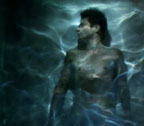
Water, Memory and Death
You are cordaily invited to join us at the opening of Gong-tormented Sea, an interactive video installation/site-specific music theatre performance by Christopher Lau & Kar Fai Samson Young. Gong-tormented Sea draws its inspiration from W.B.Yeat's middle period epic, Byzantium, a collage of classical Greek philosophical references and historical imaginations, conjuring up a tapestry of death and memory, pointing to an golden age of human civilization passed.
Gong is essentially an experimental project that depicts the elements of water, memories and death to express the above sentiment: the paradox of those who exist between the physical world's burden of living memories, and the liberty of a distant realm that is out of mere mortal's reach.
Having worked together since 2003, our interests has been to explore the fusing of traditional art form (namely performing art) with new media art and technology in various forms. The combination of music, moving images, sensor device, interactive programming, and live performances creates infinite possibilities for art expression, yet our focus has been to experiment on the use of these technologies to produce an artwork that is somewhat more poetic and closer to human nature.
Posted by jo at 08:06 AM | Comments (0)
May 31, 2005
Trace

Whispers in the Maze
Since May 6, visitors to the oldest maze in the world, Hampton Court Palace Maze can hear cymbals, a dog barking, a child laughing, the rustle of silk skirts, a tune from a music box, and the murmurs and sighs of three centuries of chatter at the palace. The sounds float around the maze so subtly that it is hard to distinguish them from real-life ones. Besides, quotes from staff discussing the facts and figures behind the attraction are interspersed in the sound effects.
The maze has been filled with sensors that trigger hidden speakers, which emit a variety of strange sounds and voices, waiting to be triggered by a footfall. The sounds are part of Greyworld's last installation, Trace. The centre has been replanted with hornbeam and features touch-sensitive benches that create subtle sounds as visitors sit to relax. There are thousands of permutations of the sounds triggered from 20 speakers, so no visitors will ever hear exactly the same. [blogged by Regine on near near future]
Posted by jo at 07:25 AM | Comments (0)
May 30, 2005
PulsArt: IT, Salt and Water for Family Awareness
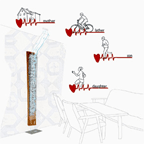
Say it with Salt
"PulsArt [PDF]--by Jonas Fritsch, Maiken Hillerup Fogtmann, and Henrik Sommer Pouslon--is a physical and digital installation designed for the home to represent different family members’ level of activity by water running down blocks of salt based on a real-time reading of the individual family member’s pulse. We describe how pulsArt explores novel ways of looking at the interaction between the physical, the social and the digital and how it acts as a context-aware artefact, amplifying the domestic setting to provide a new kind of awareness in the family. In doing so, we seek to develop new perspectives on designing interactive and context-aware systems for the home and what values they might support." [Related] [via angermann]
Posted by jo at 01:19 PM | Comments (0)
Parsons School of Design: Design & Technology Thesis Exhibition
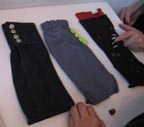
DT Saved My Soul
This past Wednesday was the opening for the Design & Technology Thesis Exhibition at the Parsons School of Design in New York City. The exhibit featured amazing thesis projects from both the MFA and BFA students in the department. It provides a chance to check out work and artists that have been mentioned elsewhere, such as Lina Fenequito’s Swap-O-Matic and fi5e’s Graffiti Analysis.
However it also provides an opportunity to check out new brilliant projects of those less known to the blog sphere media circuit. Discreet Interfaces, by Kaho Abe, explores the idea of wearable technology. By imbedding switches in the sleeves and hiding them with simple buttons or tags, the user can navigate the controls of a portable electronic device discretely without drawing any attention to themselves (well… other than that of someone who fidgets incessantly). Continue reading >> [blogged by Carol T. Chung on cool hunting]
Posted by jo at 12:37 PM | Comments (0)
beta_space

art> technology> experiment> discovery
The name beta refers to a new piece of software or hardware that needs testing and feedback from its users to help the project team to eliminate design and engineering errors.
The Powerhouse Museum and Creativity and Cognition Studios (CCS), University of Technology, Sydney are collaborating to create beta_space an experimental environment where the public can engage with the latest research in art and technology.
beta_space will show interactive artworks in development by CCS researchers and collaborators. The works may be at different stages, from early prototype to end product. In all cases engagement with the public will provide critical information for further iterations of the art work or of the research.
beta_space will give visitors to the Powerhouse Museum the chance to experience collaboration between art and technology. Information displays will contextualize the role of CCS and beta_space in this international field.
beta_space will be a working environment a laboratory - yielding valuable research outcomes. It will give people the opportunity to be creatively involved in the development of new forms of artistic expression, and it will give an insight into the creative process of artists and technologists.
Benefiting from the joint technical expertise of the Powerhouse Museum in Sydney, Australia's premier presenter of interactive exhibits, and CCS, a leading research group in creative interaction at the University of Technology Sydney, beta_space will show experimental content with high standards of production and presentation within the cultural precinct developing in the inner city district of Ultimo.
Posted by michelle at 12:30 PM | Comments (0)
May 29, 2005
I am a (kaleido)scope
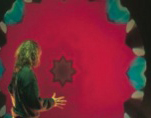
Iamascope
Exploring embodiment between people and machines Sidney Fels Iamascope uses a video camera as the eye of a kaleidoscope that projects the observer into the kaleidoscopic image where they become a performer within the work.
Once inside the Iamascope, participants can gesture, dance, sing and speak to control and choreograph the imagery and music in real-time. Both the audience and the performer experience a rich aesthetic interactive experience."
Technical description: The Iamascope currently uses a firewire camera attached to an Apple G5 Computer running the Iamascope code. The code is written in a combination of C and Tcl/Tk using OpenGL. As well, the music synthesizer used here is based on SimpleSynth and the video capture code for the Mac is based on open source code called SeeSaw. The video data is placed in texture memory where it is mapped using mirror reflections onto the geometry.
About Sidney Fels: "I have been exploring intimacy and embodiment between people and people, and people and machines for the last 10 years. This work uses a special type of mirror (a kaleidoscope) to explore the rich interaction aesthetics inherent in self reflective interactive works. As one of the original interactive artworks I created, it formed the basis for understanding interaction aesthetics deriving from response, control, self-reflection and belonging."
Posted by michelle at 10:30 PM | Comments (0)
May 27, 2005
INTERCHANGE 3
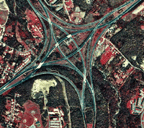
Featuring Audience Interactivity
INTERCHANGE 3: An Evening of Interactive Music/Art/Video Performance & Installation; Saturday, June 4, 2005: This is the third "Interchange" event in what has become a recurring series. An evening of interactive music/art/sound/ video performances and installations, this show challenges the notion that art and performance are things to be merely watched by an audience. Instead, the audience plays a vital role in the event. Each work engages the audience to interact, participate or contribute to the creation and experience of the art.
Performances & Installations by: __Doug Goodwin __D. Jean Hester __Michele Jaquis __Liam Mooney __James Orsher __Albert Ortega __Adam Overton __Rise Industries __Louisa Van Leer; Curated by D. Jean Hester.
Doors open at 7:30; Performances begin at 8:00; Installations can be viewed before and after the performances, and during intermission.
// Tickets: //
$5 for G825 Members and Students with valid Student ID / $10
General Admission Tickets available at the door.
// Where://
Gallery 825
825 N. La Cienega Blvd, Los Angeles
Between Melrose and Santa Monica Blvd.
Map
Street Parking available, nearby restaurants offer Valet Parking
// For More Info: //
Contact the Curator: D. Jean Hester - interchange[at]divestudio.org
http://www.divestudio.org/interchange3/index.php
-- D. Jean Hester
http://www.divestudio.org
Posted by jo at 09:27 AM | Comments (0)
May 26, 2005
Neuromirror
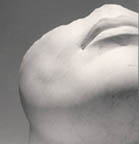
Facial Glitches
Neuromirror is an EEG enhanced interactive installation by Iman Moradi. It consists of a computer vision and processing augmented mirror that distorts participants' faces based on their own realtime brainwave readings. Its primary visual effects use the medium of the fake Digital Glitch or Glitchalike.
Neuromirror reflects how we mask our internal anxieties and fears behind our perfectly framed public image. It is about mimicking a facet of imperfect technology to reflect those internal struggles and imperfections. You can download Moradi's dissertation Glitch Aesthetics here.
Posted by jo at 12:59 PM | Comments (0)
May 25, 2005
FLOAT
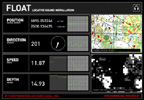
Listening to Place
In FLOAT--by Tuomo Tammenpää and Tamas Szakal--the ship is the play-head and the route is the track. Depth, direction, speed and surrounding islands build the score of the sound installation. The ship plays the track as it moves across the Baltic Sea. On the surface, there are shapes of islands and the coastline, drawn on the sea. The multitude of ship routes and passages that connect countries and cities together weave a vast invisible network of paths.
The sea, especially the deep unknown, holds its mysterious nature in the era of extreme traveling. There is a fascination for the dimensions of waterbodies and the secrets it possesses. The power of a storm, the long horizon and the incomprehensible raises respect among most of us.
Crossing the various locations, the voyage, provides a lots of information, which can't be seen or heard. Taking a ferry on the Baltic Sea is usually just transportation or entertainment on board. In both cases, the sea itself is insignificant. This sound installation makes some of the invisible dimensions and the silent layers of data, audible. The ferry travels through a map moving high above the bottom of the sea floor, sometimes shallow, sometimes deep. The passage in time generates various data. All these data streams: the GPS coordinates, distance to islands, depth, direction and speed are translated to sounds. The result is a slowly developing soundscape that invites the traveler to listen to the place in time. [originally posted by inf* from information aesthetics, ReBlogged by marisa on eyebeam reblog]
Posted by jo at 10:44 AM | Comments (0)
May 24, 2005
Life Support Systems
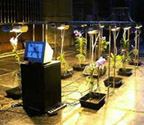
Vanda Hybrid Orchids
Life Support Systems--by Mateusz Herczka--deals with the possibility of enabling life to continue after death in the form of information. Electronically recording all of a creature’s memories and reactions would theoretically make life extension in virtual space possible.
The installation collects data generated by the tiny shifts in electrical current produced by the metabolic processes of vanda hybrida orchids. Then, computers running artificial intelligence software reproduce these physical states, as a virtual model, which continues to generate similar signals long after the original orchids are gone. The flowers' language and behaviour model is stored in a hacked Microsoft Xbox, its future container.
"Besides turning a scientific experiment into an aesthetic construct, the work tangents questions of consciousness, longevity, and new lifeforms through computing." vanda_full_text.pdf [blogged by Regine on near near future]
Posted by jo at 10:51 AM | Comments (0)
May 20, 2005
GORI.Node Garden
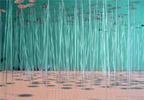
Cultivating Networks
GORmeans an open hook in Korean and it is often used to represent human relationships. GORI.Node Garden--by Jee Hyun OH--explores the node of privatized networks and expresses the image of fastening or loosening the relationship to your will. The biggest difference between Privatized Network and Social Network is the maintenance of relationships, how one maintains whom one takes care of. In GORI, the garden represents the social network you belong to and the flowers symbolize your privatized network nodes -GORIs- which you are growing.
As a gardener, you decide which GORI from your mobile contact list you will plant and grow. It could be somebody from either your phone list or somewhere else. A flower planted at the edge of the garden, starts to grow when you exchange messages and it moves towards the centre. When it moves, it vibrates. The growth speed and location of each GORI is set by the frequency and duration of the calls. The growth speed and planted location determine the value of the scale and pitch of music that plays when gardeners water the gardens. [blogged by Regine on near near future]
Posted by jo at 09:42 AM | Comments (0)
May 19, 2005
Recycled TV

Balance and Fair Use
Ben Hanbury has created Recycled TV, a wicked video installation that remarks on ever changing copyright laws and Creative Commons.
"The concept behind this piece then is to take two groups of video clips, one group which is licenced under the Creative Commons and one group which is copyrighted but is old enough that it would be in the public domain by now if the terms of copyright had not been extended so many times. The videos will then be broken down into very short clips (milliseconds) which will then be used to form beats in various audio tracks. The user will then be able to use a retro tv interface to mix between tracks thereby forming a new creative product out of old ones, however the user will also have to make choices of balance and fair use between public domain and copyrighted material."
View a video and more work by Ben on Free Culture. He has now finished his degree and will soon been looking at job offers, so get in touch if you are interested. Nice one. [blogged by Chris on pixelsumo]
Posted by jo at 10:42 AM | Comments (0)
May 11, 2005
Natural Interfaces
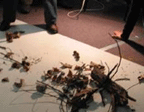
Users Transform Real Into Virtual
Diogo Terroso’s Natural Interfaces uses objects from nature to create a physical interface for controlling the emergence of a virtual terrain. Real objects such as tree branches, leafs and sand, function as an interface between the visitors and the art piece. By moving and repositioning the physical objects in space, the visitors initiate the real-time transformation of a digital landscape, in which mountains emerge, clouds move in the sky and trees grow. Evolutionary processes are inter-connected with the interaction, making the visitors pro-active in the development of the virtual environment. The concept departs from the idea of opening a dialogue between the real and the virtual by the interaction with physical objects. [via]
Posted by jo at 11:23 AM | Comments (0)
Collective Subconscious
![collectivesubconscious[1].gif](http://www.turbulence.org/blog/images/collectivesubconscious[1].gif)
Reverberating Thoughts
Collective Subconscious--by Zehao Chang--is an installation that imprints reverberating thoughts on a public space as people move through it. Traces of one's thoughts are left behind in the gallery and "collaged" with other people's thoughts. New messages are prominently placed while older messages slowly fade away. Words that are repeated by many people will become larger and brighter. As such the display becomes a visual representation of people's state of being.
Each person has a unique RFID tag that has a personal message associated with it; the message can be modified at any time through a web page. When a visitor places the tag near the RFID sensor, the data is sent to a computer and the new message is added to the collage with a short highlight. If a word in the new message is already present in the collage, each instance of that word would highlight and reverberate, echoing in unison the idea they are trying to convey. The message would then slowly fade into the background, waiting for repetition of its words. The collage generated is then projected onto a wall. [via]
Posted by jo at 11:08 AM | Comments (0)
Wireless
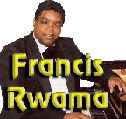
Interactive Sound and Tactile Environment
Francis Rwama presents his latest work Wireless, an interactive audio installation based on the sound and touch world of visually impaired people. Using sounds specially recorded in Uganda, West Africa and London, Francis has created an environment that reflects the orientation of his world without sight - the magic, the frustrations, the cautions and the subtleties.
Wireless invites the audience to explore the darkness, to question their relationships with sound and asks, how do we navigate and respond to everyday sounds, space and proximity without a visual landscape of confirmation? Tactile pieces designed by collaborator Diane Pungartnik create a boundary mapping of the space, adding a textural layer coupled with often humorous relationships to order in this experience of sensory deprivation and enhancement.
16 May – 27 May 2005
Stoke Newington Gallery
Stoke Newington Library
Stoke Newington Church Street
London N16 0JS
Enquiries and group bookings: 020 8806 5401
Exhibition times:
Mon 16 May: Launch 6pm-8pm, Mon 23 May: 10am-8pm, Tues/Thurs/Fri: 10am-8pm, Wed: 10am-6pm, Sat 10am-5pm, Sunday closed
Admission Free
Wheelchair Accessible
Alternative format materials will be available
Guide dogs are welcome
Guidance will be available for VI visitors if required
Posted by jo at 10:11 AM | Comments (0)
May 09, 2005
De-Grammatical: Rhythm and Language Transformation

Art of Noises
Next at HTTP// [House of Technologically Termed Praxis]: De-Grammatical: Rhythm and Language Transformation by Elisabeth Penker: For the opening--Tuesday 10 May 2005 7-9pm--Penker will perform live to the composition "Die Bildhauerin."
At the turn of the last century the Futurists introduced sounds of motors and vocals as instruments for orchestras, which consequently influenced Dada and Fluxus movements that pioneered the early days of electronic music. The Dadaists phonetically experimented with grammatical structures. Penker combines these different approaches to rhythm and language transformations. Die Bildhauerin breaks up the grammatical structure of the word "DIE-BILD-HAU-ER-IN" into minimal units which are called morphemes. The composition is arranged with the sound of two stone masons, chiselling this broken grammatical structure into a wall.
The morphemes build the base rhythms of the composition. The performance is supported by a sonic structure constructed of wood and various industrial floor materials which are amplified and function as instrument and interactive sound sculpture during the exhibition. The audience can play on the sonic structure, and this is combined structurally with the conceptual logic of Luigi Russolo’s (1913) Manifesto, The Art of Noises and the technical methodology of Jack Foley’s recordings for films.
Exhibition: 10 May - 5 June 2005, Friday - Sunday 12-5pm
HTTP gallery is pleased to present Austrian artist Elisabeth Penker's first solo exhibition in the UK. In her work Elisabeth Penker is questioning visual structures in relation to language. By decoding visual systems and displacing rhythm and language into a non-linear structure, Penker is showing the commonality of Modern Art and First Nation Art. It is of particular interest how polysynthetic languages which are common in First Nation Languages (i.e. there is no clear distinction between a word and a sentence), compare to Indo-European languages and how visual languages relate to grammar and syntax.
Elisabeth Penker, born 1974 lives and works in Vienna recent exhibitions include:
2005 "The Red Thread" Howard House Contemporary, Seattle
2004 "Sound Studio" Gallery Priestor for Contemporary Arts, Bratislava,
SK "Born to be a Star" Künstlerhaus, Vienna
2003 "Sound System", Salzbuger Kunstverein, Salzburg, A ; Liste 03 with
Galerie Michael Hall, Vienna (solo), "Selected Sound Sculptures",
Galerie 5020 Salzburg /A (solo)
2002 "Butterfly reached the sound-barrier", Kibla New Media Center,
Maribor, SL; "Waiting for the Ice Age"(curated by Michael Hall), Galerie
Georg Kargl, Vienna; "hear the art", Kunsthalle Exnergasse, Vienna
2001 Kunstbüro, Vienna (solo) "First Story-Women Building", Galerie do
Palacio Cristal, Porto (curated by Ute Meta Bauer) and "(untitled)
654321", Kunsthallen Brandts Klaedefabrik, DK (curated by Jacob
Fabricius & Tommy Lund)
"De-Grammatical: Rhythm and Language Transformation" is supported by the Austrian Cultural Forum.
Unit A2, Arena Business Centre,
71 Ashfield Rd, London N4 1NY
Tube: Manor House, Buses: 341, 141,
Car: free parking facilities
HTTP:// is a non-profit organisation run by artists and curators of
Furtherfield.org & Dosensos.
for further information contact: info[at]http.uk.net
tel: +44 (0) 208-8022827
Posted by jo at 07:31 AM | Comments (0)
May 07, 2005
Sonicforms
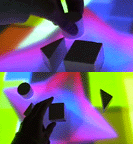
First Open Source Interactive Table
More from Cybersonica. Chris O'Shea presented another table to add to the list of musical tables. This one has a peculiarity though: it's the first to be open source. Sonicforms is an open source research platform developed to improve the research on tangible interfaces for audio visual environments by creating a community knowledge base and open tools for production.
Sonicforms is a repository for others to learn how to make their own interfaces and share their experiences; a set of tools for extending open source software to create these projects and of course it's also a physical installation. Video. SonicForms will be presented at OFFF in Barcelona, on May 13, 5.30pm. Open Room. The first showing of the installation will be at Submerge, 29th June - 1st July, Bristol UK. [blogged by Regine on near near future]
Posted by jo at 11:56 AM | Comments (0)
iFloor
![iFloor2[1].gif](http://www.turbulence.org/blog/images/iFloor2[1].gif)
Communication Facilitator
iFloor, developed by Interactive Spaces, University of Aarhus (Denmark), is an interactive floor aiming at encouraging users to communicate with each other. They can ask and answer questions through SMS or email and have them shown in a public space. The messages are registered by a server and displayed on the floor. Each question is marked with an ID reference number that is used when responding to the specific question. If someone answers a question the answer is both displayed on the floor and sent to the person who asked the question.
A remote server handles the questions and answers and a projector mounted on the ceiling connected to a local computer displays the messages on the floor. The floor works on the basis of a video tracking system observing the rim of the interface by means of a web cam mounted on the ceiling. The recordings of people’s position and movement are translated into magnetic forces attracting the cursor. [blogged by Regine on near near future]
Posted by jo at 11:44 AM | Comments (0)
May 04, 2005
TouchMe
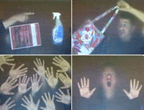
Make Your Mark
TouchMe is an interactive installation that allows people to create and add a personal image to a public space. Simply press a part of your body or objects against the frosted glass surface, and you'll leave a kind of imprint for you and others to see, as the results remain a part of the piece and are displayed when no interactions occurs for a given time.
TouchMe is intended for one of those modern public spaces that seem designed to withstand large flows of people without any impact, while passerbys would be glad to be able/allowed to physically interact with- and leave marks in their environment. Author: Dutch interaction design group Blendid. Quicktime video. The work will be shown at Digifest, at the Ontario Science Centre, on May 12-15. [blogged by Regine on near near future]
Posted by jo at 09:46 AM | Comments (0)
April 26, 2005
Taken
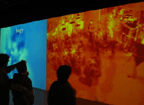
Tracing Memory
"A small enclosed gallery off of (Williams College Museum of Art's) historic rotunda, Media Field is the museum’s sacred space for video and new media work. The Toronto based artist, David Rokeby has inhabited it with his video installation Taken, specifically reformatted for the space. The work establishes a surveillance environment that monitors the room with a three-channel video projection, tracing the memory of the gallery, so to speak. Rokeby’s software responds to every visitor by focusing and recording their movements in a looped video format on three walls, leaving the center of the gallery light up and empty in wait for a performance.
That performance is your blurred image within a stream of transparent bodies flowing through the room [the day’s palimpsest of visitors] featured in the main projection. Once a new presence is detected the crowd vanishes and the new visitor is isolated in the space. Walking into the room gets you noticed – quickly- and just as quickly, you are stitched into the quilt of the gallery’s daily memory." From David Rokeby @ WCMA by Dina Deitsch, Big Red & Shiny #21.
Posted by jo at 09:28 AM | Comments (0)
April 22, 2005
Subtitled Public
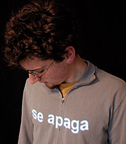
Words Exchange
Subtitled Public, by Rafael Lozano-Hemmer, consists of an empty exhibition space where visitors are tracked with a computerized infrared surveillance system. As people enter the installation, texts are projected onto their bodies: these "subtitles" consist of thousands of verbs conjugated in third person and they follow each individual everywhere they go. The only way to get rid of a subtitle is to touch someone else: the words then are exchanged between them.
Subtitled Public invades the supposed neutrality of the space that museums and galleries set-up for contemplation, underlining the violent and asymmetric character of observation. The piece reveals the danger of surveillance systems that typecast and try to detect different ethnic groups or suspicious individuals, as in the latest computer-vision devices that are being deployed in public spaces around the world. The installation is also an ironic commentary on this era of technological personalization, literally "theming" and "branding" each spectator.
Electronic artist Rafael Lozano-Hemmer (Mexico City, 1967) will be showing his latest interactive installation at "El Cubo" at the Sala de Arte P ublico Siqueiros in Mexico City from April 7th through May 22nd, 2005.
Lozano-Hemmer uses technology explicitly as a way of understanding and criticizing from within some of the paradoxes of our mediated culture, creating intersubjectively binding reference systems. The artist refers to his work as relationship-specific, rather than site-specific, aiming to establish environments where a performative experience can develop, a critical and a connective experience, a kind of communion: communion understood as the acknowledgement of complicity.
For the past fifteen years Lozano-Hemmer has been developing art works that explore the intersection between architecture, interactivity and performance art. His "Relational Architecture" series of large-scale interventions in public space employs custom-made technologies to transform urban environments. Among his most notable works is the transformation of the Zocalo Square in Mexico City with searchlights controlled by participants over the Internet. This piece, Vectorial Elevation, has also been staged in Spain, France and Ireland, drawing massive participation to the project website at www.alzado.net. His works in photography, video and installation are present in important international collections and have been shown at the Istanbul, Havana, Liverpool and Shanghai Biennials among other exhibitions. Currently he is artist in residence at the Institute for Research in Construction of the Canadian National Research Council. Videos, texts and images of his works can be found at www.lozano-hemmer.com.
Posted by jo at 08:59 AM | Comments (0)
April 20, 2005
9PIN

Mapping the SCAN Community
In summer 2003, a call for artists was sent out for the project 9PIN. The call asked artists to respond to the (then) 9 geographical locations occupied by the consortium members of SCAN. Proposals were submitted for a series of residencies and commissions looking at the possibilities for networking and mapping in the SCAN community. James Coupe, Hedley Roberts and Rob Saunders, Hywel Davies, Armin Medosch and Ivan Pope were chosen because of their range of inventive approaches to the SCAN network.
From Armin Medosch’s data visualisation research starting with a comparison between real and virtual ports through to Hywel Davies’ compilation of a sound database, gathered from each of the consortium venues, for the composition of new material by both himself and other musicians and composers, each of the artists involved in 9PIN makes a significant contribution to their own areas of practice and dissemination of content, whilst helping SCAN to cohere a very disparate group of organisations brought together by their desire to collaborate on high quality experimental work.
Ivan Pope brings his sketches and ideas using GPS, to enhance his interest in psychogeography, to his workshops, while James Coupe and Hedley Roberts take on the difficult task of examining and building an intelligent system which reflects activity (data drawn from sensors installed at SCAN’s member organisations) at each venue in the SCAN network.
The 9PIN project is premised on research and development and brings together artists and makers who are at the forefront of their field. This is a flagship project for SCAN and sets a precedent for the organisation’s aspiration to facilitate an environment for practitioners to develop their process outside of other areas of institutional research whilst working towards high quality outputs for the SCAN network.
SCAN is the innovative new media arts agency in the south of England. As a network of organisations, SCAN is committed to the delivery and facilitation of collaborative works.
"SCAN presents a unique model of networking across a number of diverse arts organisations in the south of England. We commissioned the 9PIN project to explore the network and build a model for SCAN as a whole. We invited artists with an interest in data analysis and mapping to produce a body of high quality work. They have come up with some extremely creative interpretations of the commonalities and differences across the organisations in the network"- Helen Sloan, Director of SCAN
The aim of 9PIN was that each artist should make a significant contribution to their own area of practice, whilst helping SCAN to make connections between the disparate group of organisations that constitute the SCAN network. 9PIN is a flagship project for SCAN and sets a precedent for the organisation’s aspiration to facilitate an environment for practitioners to develop their process outside of other areas of institutional research whilst providing high quality outputs for the SCAN network.
Posted by jo at 09:50 AM | Comments (0)
Transmission
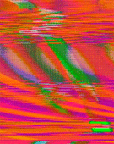
You Can Feel It in the Air
"At some point in our lives, we notice ourselves lugging around an overload of ideas and information. How is it that we continually play the role of unwitting receiver to a barrage of loaded transmissions? Transmission is a series of exhibitions presented by the New Museum of Contemporary Art, which profiles artists and scholars exploring the concept of 'transmission' in and through new media, radio, sound and broadcast media. 'Airborne,' the second show in the series, takes on the 'aesthetic, sonic and socio-political' aspects of these cunningly concealed wireless transmissions.
Curated by Anne Barlow and Defne Ayas, in collaboration with www.free103point9.com, the exhibition features seven works by New York-based artists that aim to give substance to intangible electronic signals and to the interests they power. Take Paul Davies 'Prayer Antenna,' which wittingly transforms viewers into supplicants as they kneel to insert their head into an ordained helmet covered with antennas; or Mendi and Keith Obadike's '4-1-9,' which invites one to compose an individualized email money transfer scam. Airborne will be at the New Museum until June 4, with performances on May 4 at 6:30PM." - Ophra Wolf, Net Art News, Rhizome, 04.20.05
Posted by jo at 09:31 AM | Comments (0)
InterPlay: Loose Minds in a Box
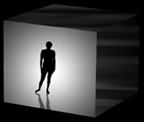
Six by Six
InterPlay: Loose Minds in a Box is a collaborative work that explores the basic concept of the "box". The box is a metaphor for the physical, social, political or psychological constraints that we and/or others place upon us. The box also represents a sense of place in the realm of the virtual as well as in our sub-conscience. InterPlay is a multi-faceted telematic event that consists of six simultaneous performances that occur in six states throughout North America. The performances incorporate theater, text, music, performance art, virtual reality, and motion capture and are concurrently captured, mixed, digitized, encoded and streamed onto the network.
Posted by jo at 08:42 AM | Comments (0)
April 19, 2005
NANO
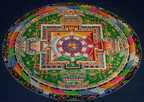
Immersed in Radical Shifts
Two UCLA professors--media and net artist Victoria Vesna and nanoscience pioneer James Gimzewski--are at the forefront of the intersection of art and science. Their groundbreaking project, NANO presents the world of nanoscience through a participatory aesthetic experience.
The project seeks to provide a greater understanding of how art, science, culture and technology influence each other. Modular, experiential spaces using embedded computing technologies engage all of the senses to provoke a broader understanding of nanoscience and its cultural ramifications. The various components of "nano" are designed to of scale and sensory modes that characterize nanoscience, which works on the scale of a billionth of a meter. Participants can feel what it is like to manipulate atoms one by one and experience nano-scale structures by engaging in art-making activities.
Posted by jo at 10:00 AM | Comments (0)
April 18, 2005
Afterwords
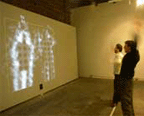
Experience Another's Memories
Afterwords--by Randy Moss and Michael Evan--examines personal identity, labels and the ephemera of the digital age. As people walk into the installation, they become a part of the display projected on the gallery wall in front of them. The display presents a stylized image of each person that follows their movements. A line of text floats above each person's head and follows them as they move through the space. People can touch the text to change it, run away from it, or stand still, allowing the text/image relationship to be distilled. Afterwords is part of the group show Help Wanted: Collaborations in Art at the Center on Contemporary Art in Seattle and runs ftill April 23, 2005. [blogged by Regine on near near future]
Posted by jo at 02:11 PM | Comments (0)
April 13, 2005
Organum Performance
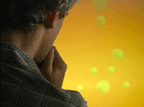
Voices as Game Controls
Organum is an interactive week of programs exploring the human voice through sound, image and technology. A week-long installation premieres Organum: The Game (2005), a video game by digital media artists Greg Niemeyer, Dan Perkel and Ryan Shaw, in which gamers navigate through the human voice box using their own voices as game controls. Also on view are glass etchings by Niemeyer and continuous screenings of Organum the short animated film (2003).
Organum: The Game is a collaborative video game in which three or more players sing into different microphones to control the three axes of movement (x, y, and z) on the game screen. Together, the players represent a grey sphere “character,” which they must navigate through an increasingly complicated path, hitting a series of targets as they travel through a luminous digital representation of the inside of the voice box.
New Langton Arts
Tuesday, 19 Apr 2005 to Saturday, 23 Apr 2005
12-6 pm, Admission Free
Reception: Saturday April 23, 6-8 pm
Organum culminates in a day of activities on Saturday April 23, from noon to midnight. An informal brown bag lunch with the artist/programmers is planned from noon to 3 pm, and the public is invited to an evening reception celebration from 6 to 8 pm. The finale, The Human Voice Explored, is a performance showcasing the vast potential of the human voice with Seth Augustus, Aurora Josephson, and Kid Beyond, at 8 pm. The space remains open until midnight for after-hours video game play. Organum is part of NetWork, Langton’s ongoing digital and net art exhibition program. [Related]
Posted by jo at 11:32 AM | Comments (0)
Mocean
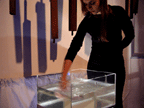
Sensory Relationships Between Natural Media
Mocean is a musical immersive environment that invites people to touch, stir and play with water in a tank. The movement of the water is translated into movement of air in the organ pipes suspended above the water. The sound of the pipes envelops the person, its movement echoing the waves and ripples in the tank.
The organ pipes are connected to blowers via a tubing structure. A video camera, placed below the tank, sends images to a computer, which analyzes the movement of the waves and sends commands to a microchip board, which turns the blowers on and off. The air from the blowers is routed to the organ pipes. The spatial arrangement of the pipes reflects the physical dimensions of the tank, thus it is possible to create the sensation of moving sound around by moving water in a particular direction. [blogged by Regine on near near future]
Posted by jo at 11:16 AM | Comments (0)
April 07, 2005
cell.SPACE
![cellFREE[1].gif](http://www.turbulence.org/blog/images/cellFREE[1].gif)
freeSTYLE
Dana Karwas' cell.SPACE application allows users to make a short live music video using SMS as lyrics and camera phone pictures as graphics. Users can send text and picture messages from their mobile phone to the freeSTYLE and have their written text messages show up on the screen with a voice accompanying the text. Simultaneously a hip hop instrumental is creating and guiding the voice and graphics so the text becomes the lyrics and the pictures from the phones form the graphics.
The application has 21 different voices to choose from including male, female, creature, robot, and even human laughter. Instead of just being read back to the user, the voice is controlled by the beat of the music. [Video] The work will be at the Interactive Multimedia Culture Expo, on April 14th - 23rd, at the Chelsea Art Museum, in New York. [blogged by Regine on near near future]
Posted by jo at 05:43 PM | Comments (0)
April 05, 2005
Blowhard
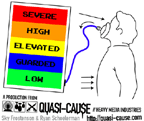
Investigating the Rhetoric of Fear Culture
Blowhard is a game, created by Ryan Schoelerman and Sky Frostenson, in which two players compete by breathing into a CPR mask, where a breath sensor translates cumulative respiration into the player's current level of anxiety, shown on a screen in the same color-coded system used by the Department of Homeland Security's Threat Advisory System.
Players must increase their anxiety gradually, moving up one stage at a time. Upon completion of a level the display provides feedback via audio-video USA fear culture propaganda from the 1950s to the present. The first player to reach the top, wins.
The respiration game controller masks are designed using a CPR resuscitation mask, TGS-822 organic vapor sensor and connect via ethernet cables to a game console. The console consists of programmed PIC micro-controllers, on-board LED display graphs, an audio sample processor, and speaker amplifier system. All hardware is housed inside a Playstation2 case.
The software screen display of BLOWHARD is designed using Max/MSP/Jitter.
The game is part of the Hybrid Vigor exhibition, at the Beall Center for Art + Technology on April 6 - 16, 2005.
Via Interactive Media Division.
Related: Homeland Insecurity Advisory System project.
[Blogged by Regine on near near future]
Posted by jo at 09:25 AM | Comments (0)
April 04, 2005
TAXI MADRID
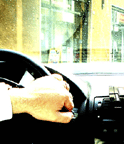
Another Taxi Installation
TAXI MADRID is a mobile public art intervention by artists Anne Lorenz & Rebekka Reich addressing issues of perception and the logic of memory. Equipped with installations, 12 taxis will operate in Madrid throughout the duration of Madrid Abierto, transporting their passengers into someone else's mind and memories of Madrid, those of an ex-patriot.
By interviewing former inhabitants of Madrid, who now live spread all over the world, artists Anne Lorenz and Rebekka Reich seek to find intriguing personal memories related to the city. From this material they devised sound-collages to become part of more complex installations, consisting of objects and other memorabilia, fitted into the taxis.
Regular taxi-users are caught off guard in the confined space of a car, abducted for a short amount of time from their everyday business. The artists seek to surprise and entertain the passenger by confronting him or her with an insight into the memory of a stranger, provoking a memory lapse. Due to the geographical distance of the interviewees an overlay of two pictures occurs: The out of date view of the ex-patriot merges with the current situation on site, and the meeting of the two lives on in the memory of the passenger.
To experience TAXI MADRID call Teletaxi: 91 371 21 31 / 902 501 130 and ask for a taxi from MADRID ABIERTO. Conditions are the same as usual.
Posted by jo at 09:15 AM | Comments (0)
Ondulation

Seeing Sounds + Hearing Images
Presented as a "temporal sculpture," Ondulation (2002) is a composition for water, sound and light created by Thomas McIntosh in collaboration with Emmanuel Madan and Mikko Hynnimen. They continued with Ondulation the exploration launched in finale, the final work in the Silophone project, pursuing their interest in synesthesia, where a visual sensation is experienced through its analogy with an auditory perception. The work is presented as both an installation and a performance piece. [via langlois]
"Among artistic precedents that share the concepts and forms of Ondulation are Mud Muse (1971) by Robert Rauschenberg and Mediations (towards a remake of Soundings) (1979/86) by Gary Hill. Mud Muse was the result of a collaborative effort between Rauschenberg and various engineers as part of the Art and Technology exhibition, which was organized by Maurice Tuchman and presented at the Los Angeles County Museum in May 1971." Read more >>
Posted by jo at 08:58 AM | Comments (0)
List of Music Tables
![reacTable3[1].gif](http://www.turbulence.org/blog/images/reacTable3[1].gif)
Tangible Musical Interfaces
"This is overview on tangible musical interfaces is focussing on table-top controllers, such as music tables and audio building blocks, mostly chosen for their relation to the reacTable* project. It also includes few additional projects, which we think are somewhat closer to the concept of tangible interfaces rather than simple musical controllers." [via near near future]
Posted by jo at 08:10 AM | Comments (0)
Telephony
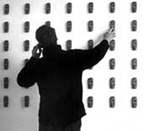
Nokiatunes
Telephony--by Thomson & Craighead--allows gallery visitors to dial into a wall based grid of 42 Siemens mobile telephones, which in turn begin to call each other and create a piece of 'music.' Each phone has been individually programmed with a different ringtone, which played en-masse, create various harmonic layers all of which are based in some way on the popular and prevalent, NokiaTune. The more people who dial into the work (whether inside or beyond the gallery walls) the more complex and layered the audio becomes. A piece of anodyne 'elevator' musac also plays into the space as a kind of background layer, and is also an improvisation on Nokiatune. [via neural.it]
Posted by jo at 08:01 AM | Comments (0)
March 29, 2005
DIALTONE

Teleinteractive Net Audio Experiment
DIALTONE is a net audio installation exposing the physical and virtual space of the internet and attempting to open this hybrid space for sounds, noises and words by using simple telecommunication instruments like telephones and answering machines. This audio interface between telephone network and internet explores how interaction and compression changes audio in a network. The installation connects the venue to our telecommunication network through sound and vision.
Posted by jo at 03:01 PM | Comments (0)
March 24, 2005
HyPod
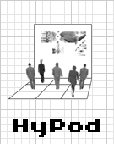
Body as Interface
HyPod is an interactive multimedia installation that invites the public to use their bodies as an interface and, coordinating their movements with other people in the same dark room, navigate a hyperdimensional world of images and sounds created by dozens of artists around the world. HyPod is based on a Web-based project called HyGrid.
HyGrid is a digital art piece currently undergoing collaborative creation by many different artists around the globe in a continued visual dialogue. With HyPod, a group of people gathered in the same physical location can navigate together through HyGrid. Using their bodies as an interface, they can experience how it feels to collaborate and interact with other participants in the process of viewing the work. Beside the images created by Sito Electronic Arts collective, HyPod also features original sound integrated with the interactive installation.
Lenara Verle is an artist and researcher in the field on Net art and collaborative art. Participates since 1994 in the award-winning group Sito Electronic Arts (www.sito.org - receiver of the Prix Ars Electronica in 1996 for the collaborative project HyGrid). Summer 2000 UNESCO-ASCHBERG resident artist at the art and technology research center CAiiA+STAR, England (www.caiia-star.net).
CAPES/APARTES Young Artist Grant laureate 2001 at the New School, New York. Participated in collaborative art exhibits in Rome, Italy; Porto Alegre, Brazil; Montreal, Canada; New York and Los Angeles, USA. [via Rhizome]
Posted by jo at 11:27 AM | Comments (0)
March 20, 2005
Translator II: Grower
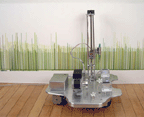
A Cross-Metabolic Relationship
Translator II: Grower, by Sabrina Raaf, is a small 'rover' vehicle which navigates around the periphery of a room. It hugs the room’s walls and responds to the carbon dioxide levels in the air by actually drawing varying heights of 'grass' on the walls in green ink. The Grower robot senses the carbon dioxide (CO2) level in the air via a small digital CO2 sensor. This sensor is mounted high on a wall of the exhibition space and sends data wirelessly to the robot. [via worldchanging]
The number of people in an exhibit space breathing in oxygen and exhaling CO2 has an immediate effect on the sensor. My robot takes a reading of the CO2 level every few seconds and in response it draws a vertical line in green ink on the wall. The line height pertains directly to the level of CO2 (and therefore also the people traffic) in the space. The more CO2, the higher the line is drawn - the maximum height being 1ft. Once Grower completes a line, it moves forward several millimeters and repeats the process. By the end of an exhibition, the bases of all the walls in the space are covered with fine green lines which together resemble a cross-section of a field of grass.
The metaphoric relation is that grass needs CO2 in nature to grow. Here, my simulated grass needs the breath of human visitors in order to thrive. The height of the 'grass' directly reflects on the human activity or traffic in the space. The more people that visit that space, the more amenable that space is to my machine’s ability to create. The relationship between Translator II: Grower, the space, and the public becomes a cross-metabolic one. This piece makes visible how art institutions depend on their visitors to make them 'healthy' spaces for new art to evolve and flourish within.
My machine’s grass growing is a dynamic, emergent behavior in which humans participate involuntarily. This behavior allows the Grower to ‘nest’ the space – meaning, make the space into one where you find evidence of natural, organic change. The drawings of grass may not be organic in a strict sense, but they may be read cognitively the way we read plants or gardens outside. Is the grass thriving? Has there been much activity? Watching the artistic output of a machine that is so sensitive to its environment makes the people in the space more sensitive their environment and its conditions. The grower also provides a memory, through it’s drawings, of those conditions.
My research as an artist focuses on making explicit the interdependent relationships of human to machine as vital entity to vital entity. Grower offers a model where both machines and humans effect each other by their involuntary cooperation. It is a model where human and machine behavior interact in a mutually informative and dynamic manner. [Related]
Posted by jo at 02:28 PM | Comments (0)
March 11, 2005
SEED
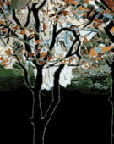
Art and Environmental Activism Converge
The Canadian Film Centre’s Habitat New Media Lab in collaboration with the SEED Collective will unveil an innovative interactive art installation, SEED, during the –scopeNew York Art Fair, March 11th to 14th at Flatotel, 135 West 52nd in New York City. This public interactive art installation invites participants to use their cell phones to plant "seeds" to grow a virtual forest.
"SEED is the first cell-phone driven interactive installation whose purpose is to effect environmental change in the real world. The ultimate goal of this evolving project is to buy a virtual tree seedling to plant in this installation; your cell phone provider will bill you, and the proceeds will be used to reforest certain endangered portions of our planet," said Napoleon Brousseau, artist and founding member of the SEED Collective.
"It is rare to see interactive art projects that have such a direct impact on the health and well-being of the environment. Habitat is thrilled to be co-producing SEED and sees this version as just the beginning of a much larger project – one that will include software tools being developed, formal collaborations with other institutions and the creation of a new type of art collective dedicated to environmental interventions," said Ana Serrano, Director, Canadian Film Centre’s Habitat New Media Lab.
SEED explores the convergence of rich media and wireless technology in the creation of a collaborative and evolving work of art. Through sound and imagery users create and populate a forest together. By dialing a particular number, each audience member will be given a “seed” to grow using the keypads of their cell phones. With each punch of the keypad, audiences have the ability to grow their seeds, choose the type of trees they want to plant, and change their texture and colour. After the three days at the scopeNew York Art Fair, the end effect is that all trees created by audience members will reveal a virtual forest.
Founded in 1988, by Academy Award winning director Norman Jewison, the Canadian Film Centre is Canada’s foremost film, television and new media institution dedicated to advancing Canadian creative talent, content and values worldwide through training, production, promotion and investment. Visit our website at www.cdnfilmcentre.com.
The Seed Collective is comprised of a group of artists, and producers, including founding member artist Napoleon Brousseau, Gabe Sawhney, and Galen Scorer; and producers Caitlin O’Donovan and Ana Serrano. More information can be found at http://www.seedcollective.ca
Posted by jo at 09:29 AM | Comments (0)
March 07, 2005
Smart Space
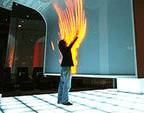
Responsive Architecture
At Bloomberg, one is confronted with a space that reacts in real time - "smart space" as it is called today in the new language of architecture. What is means is a constructed object that is sensitive, continually processes information and engages in a form of dialogue. Beneath the surfaces, processors are at work which process and convert the input received from a large number of electronic sensors.
Bloomberg, the international information agency, has created a small but fascinating showroom for its Tokyo business branch: 'Bloomberg ICE'. The name is its official title and stands for 'interactive communicative experience'. The result is a public, electronic-cum-architectural playground, a media folly as it were. [blogged by Martin Rieser on Mobile Audience]
The basic idea underlying the project is simple: the aesthetic and playful use of information. The intention is to translate stock-exchange data into formats that anyone can handle without any difficulty. Here, direct experience is intended to play a major role - information processing that can be experienced physically. In a country where toilets are computerized right up to the seat, where technology has no particular aura and grandmother is not afraid of automatic computer screens, such a concept can work.
For this idea, Klein Dytham and Toshio Iwai found a captivating metaphor: a greenish-white icicle ("ICE"), which is suspended freely from the ceiling in the middle of the showroom and acts as a data collector. The information whirring about in the (data) space condensates on the icicle, is compressed and finally ends up in a kind of "data showcase" at eye level. The swinging icicle, which swings overhead like a baldachin, turns out to be an object that can be experienced and manipulated: a room-sized glass display unit (5.0m x 3.5m), that provides some surprises when touched.
In stand-by mode, the icicle initially appears to be a normal data ticker. Without interruption, columns of numbers march over the surface. Depending on the current share prices, they climb upwards and expand on the LED display or they gradually shrink and disappear from sight altogether. Everyone can understand this: the ups and downs of Wall Street, yet another large investor bites the dust.
The real fun begins when the visitor approaches the glass wall. Infrared sensors underneath the surface detect the presence of the visitor and ask him to participate. "Touch here!" commands the wall but it also reacts without anyone directly touching it. The sensors are activated when the visitor comes within a distance of half a meter. The columns of numbers begin to flutter and fluctuate; a menu appears and offers various games - electronic volleyball, a wave generator or a digital harp, for example. The icicle can be used to play music synesthetically in that the sounds played are replicated on it in the form of brightly lit, colorful tree branches.
Artist:Toshio Iwai
Architects: Klein Dytham architecture
Client: Bloomberg
Completion date: October 2002
Location: 2-4-1 Marunouchi, Chiyoda-Ku, Tokyo
Posted by jo at 07:48 AM | Comments (0)
March 04, 2005
Imaging Place
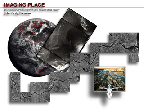
A Model Strategy for Collaboration
"Imaging Place--by John (Craig) Freeman--is a documentary virtual reality method, which uses a combination of panoramic photography and digital video to investigate place. Although the method borrows freely from the traditions of documentary still photography and filmmaking, the Imaging Place method departs from those traditions by using the emerging nonlinear narrative structures made possible by new interactive technologies and telecommunication apparatuses. It is exhibited primarily in alternative art exhibition spaces, museums and over the Internet. The work is projected up to nine by twelve feet in a darkened space with a podium and a mouse placed in the center of the space, which allows the audience to navigate throughout the project. When it is activated by the click of a mouse, the project leads the user from global satellite and vertical aerial perspectives to virtual reality scenes on the ground.
The user can then navigate throughout an immersive virtual digital video space. Rather than the linear structures of the novel or cinema, this new form allows the story to unfold in a meandering labyrinth of discovery and associations. The goal of the Imaging Place method is to document sites of cultural significance, which for political, social, economic or environmental reasons are under duress, at risk of destruction or undergoing substantial changes. This includes historic sites as well as sites of living culture which are being displaced by globalization and the collapse of industrial modernism.
Imaging Place is designed to accommodate interdisciplinary collaboration conducted across institutions and over distances. It uses new technology to bring disparate bodies of knowledge together through the investigation and documentation of place. The method attempts to bridge the gaps in understanding that exist between esoteric disciplines that have developed as a result of academic and industrial specialization. The technological tools are now available for bringing the work of experts together without sacrificing the depth and dimension of specialized knowledge and to connect the abstraction of highly specialized thinking with the visceral experiences of people on the ground. In addition to providing a form for the generation, dissemination and accumulation of interdisciplinary research and artistic production, the Imaging Place method provides a model strategy for collaboration."
Posted by jo at 08:10 AM | Comments (0)
February 24, 2005
Ku:iyashikei-net

Tear 2 Tear [T2T]
Ku:iyashikei-net by Urico Fujii and Ann Poochareon is a networked crying sculpture that allows people to communicate through the interface of tears, a physical output of human emotional expression that has been overlooked, and never made exchangeable with current communication devices. Two sides, installed at different locations, communicate over the Internet. On Side A, Tear Well allows a sad person to express his/her feeling by pumping a traditional water pump, the water representing her/his tears. The tears are sent over to Side B over the Internet, where teardrop sculptures called KU act as networked surrogates.
As soon as Side B receives the crying signal, KUs start to cry. When a viewer on Side B wipes KUs’ tears, KUs stop crying. At the same time comforting response is sent to the sad person to cheer them up. Read PDF [blogged by regine on near near future]
Posted by jo at 11:36 AM | Comments (0)
February 21, 2005
Jetsam
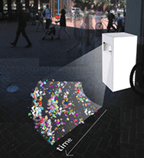
Material Worlds
While not a big fan of Intel's Jabberwocky project (the background research on familiar strangers was much more interesting to me), Jetsam - part of their Urban Probes research programme - completely fascinates me.
"Just as an archeologist excavates layers of debris from past civilizations to inform histories of ancient civilizations, so too can the discarded artifacts of today’s urban inhabitants be used to create the rich milieu of everyday stories of urban life. In fact, we can observe these patterns by extracting the secondary traces that are left behind by the flows of urban inhabitants – the archaeology of public urban trash... Our Urban Probe, Jetsam, explores urban public trash, its meaning, patterns, and usage, as it manifests itself in cities. Through this probe we hope to uncover new opportunities for technology to emerge across urban landscapes and further connect with our emotional experiences of living in cities." [blogged by Anne Galloway]
Using observations, interventions and interviews to glean information about how people interact with and interpret garbage in public spaces, they produced an augmented trash can which "exposes city dwellers to the pattern of trash interactions". The trash can records the objects thrown into it, and projects an image onto the ground of the collected artefacts. Over time, images disappear from the projection - just as artefacts disappear from the archaeological record. (Watch QuickTime movie of the can in action.)
Explorations in pervasive urban computing seem to be tending towards either gaming or narrative approaches to interacting with or understanding the city, and this project certainly falls under the story-telling category. But it's particularly refreshing to see our understanding of narrative engage a material perspective. After all, I've never heard a story that didn't involve people and things -- and surely we can do better than another city of bits.
For more on the urban probes methodology and the Jetsam project:
Urban Probes: Encountering our Emerging Urban Atmospheres (pdf) by Eric Paulos and Tom Jenkins.
And while I don't have time to get into it now, I still find it curious that Situationism is being mobilised to defend non-traditional or playful research practices -- rather than as a way of critiquing the politics and practices of technological use in everyday life. Plus, if they'd only brought in some relevant material culture studies instead of just using Lynch's image of the city...
Related:
The Garbage Project & "The Archaeology of Us" by William Rathje
Posted by jo at 07:48 AM | Comments (0)
February 17, 2005
THE A - Z OF INTERACTIVE ARTS
![]()
From Double Gaze to Telenoia
Double Gazing: Just as we see, hear, and feel in ways unknown directly to biological man, we also now live in an environment which increasingly hears, sees and feels us. With computer laser tracking of our retina, the artist's gaze is returned. The walls will indeed have ears, and buildings will speak volumes.
Interactivity: Trivial and non-trivial. The first is a closed system with a finite set of elements. The second is open ended and infinite in its capacity to accommodate new variables.
Telematic Imperative: When there's no more geographical boundaries, territorial aggression is as irrelevant as polarised politics. The only imperative is to connect. Nowadays even the self is permeable.
Telenoia: Computer-mediated, distributed mind-at-large: asynchronous global connectivity. In celebrating telenoia we reject the individualism of the old industrial culture- solitary, anxious, alienated, neurotically private. Telenoia replaces paranoia in the telematic culture.
From THE A - Z OF INTERACTIVE ARTS by Roy Ascott, Leonardo Electronic Almanac, Volume 3, No. 11, November 1995
Posted by jo at 08:35 AM | Comments (0)
From A to D and back again:
![]()
The Emerging Aesthetics of Interactive Art
"...Screen-based 'hypertextual works', 'instrumented physical spaces' and 'mapped virtual and real environments' are three new genres. Another 'dimension' can be added to each of these by the inclusion of fast, wide bandwidth digital communications technologies. We might call this tele-interactivity. There are identifiable sub-genres, in which the interaction is: between people geographically separated; between a person and a machine, geographically separated; or between people geographically separated at a virtual site.
The first we might call 'teleconferencing art'. Paul Sermon has produced provocative works in this vein, such as Telematic Dreaming...A second sub-genre utilises the idea of teleoperation. Eduardo Kac and Ed Bennett's Ornithorinco allows a user to teleoperate a robot (over phone lines) to explore an environment.
More provocatively, Stelarc's recent Fractal Flesh project allows his body to be teleoperated over the net. In both these works some aspect of the user (vision, volition) is extruded over the communication network to 'be' in another place. A third sub-genre (exemplified by Agnes Hegedus' Fruit Machine) allows multiple remote users to cooperate in tasks in a shared virtual environment.
The sudden explosion of networked multimedia (via the World Wide Web) has finally realised the dreams of the pioneer network artist of the mid eighties, (though this realisation has a decidedly commercial cast to it). A recent network project by the Berlin based Art+Com group, T-Vision is on the one hand chillingly panoptical, on the other it demonstrates coordinated global data retrieval in a way that the WWW only hints at. "T-Vision" offers a radical new paradigm of computation. In this work, a user rolls a beach-ball sized trackball, and a globe of the world presented on the screen, rolls correspondingly. This image is made up of a patchwork of satellite and aerial photos. This world can be zoomed. In some cases one can zoom from the entire globe down to a city street in one smooth swoop. In one case, one can zoom into the Art+Com office, and look through a video camera pointing out the window, and see real time video action! "T-Vision" can utilise the entire internet, drawing on dispersed databases for its images, so that the globe is continually updated, even to the extent of real time video, if available..."
From From A to D and back again: the emerging aesthetics of interactive art by Simon Penny, Leonardo Electronic Almanac, Volume 4, No. 4, April 1996.
Posted by jo at 08:30 AM | Comments (0)
February 16, 2005
3 minutes2
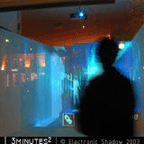
When Rooms Respond, 2
3 minutes2, by French art collective Electronic Shadow, recreates an extremely reduced living unit that can extend beyond its physical borders via the image. The space permanently reconfigures itself according to its inhabitant’s activities and also defines itself in time. The scenario presents in a few minutes the compression of most activities and functions taking place in the habitat and corresponding to its inhabitant daily life, eating, sleeping, working, etc.
The inhabitant himself is represented in the image as a silhouette and habitat is building itself around her/him as a cocoon. 3 minutes2 tries to draw the shape of a daily life modified by technologies and the presence of the virtual. Hybridization of real and virtual is fictively acquired and becomes the ground for the proposition of a habitat which anticipates the technological and social modifications making it possible.
No screens, no visible interfaces, the two characters touch the walls, make movements, the habitation responds to them. The technology has become totally invisible and the effect of technologic becomes then magic. [blogged by Regine on near near future]
Posted by jo at 09:16 AM | Comments (0)
The Living Room
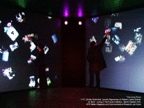
When Rooms Respond
The Living Room, by Christa Sommerer and Laurent Mignonneau, is an intelligent, interactive image, sound and voice environment. It becomes "alive" and starts to "sense" when users enter and interact with this room.
Like in a perfect surveillance system all sounds, voices, gestures and motions of the users are detected through state-of-the-art camera tracking as well as sound and voice recognition systems. When the various users start to interact and communicate with each other within this room, they will also start to communicate with The Living Room.
As if it were an intelligent organism, The Living Room will react back to the user by interpreting the collected position and speech data in form of images and image elements displayed on the room's four large projection walls. All images and image elements are directly derived from the Internet, they are The Living Room's interpretation of the users' interactions and conversations.
Since the users' position, movement and voice data are constantly changing, the images streamed from the Internet are changing constantly as well. Due to the almost unlimited amount of image data available on the Internet, the users will become completely engulfed in this virtual image space of the Internet, displayed as life-streams on the four projection walls. Besides interpreting the users' interactions and conversations visually, The Living Room also uses these data to generate and broadcast its own sound and voice output.
Conceptually The Living Room thus metaphorically plays with ideas of surveillance, detection, intelligence, interpretation, miss-interpretation and communication. To the users it provide a feeling of immersion into a constantly changing and dynamic data space, full of unpredictable images, sounds and voices.
Posted by jo at 08:10 AM | Comments (0)
February 10, 2005
Dziga Vertov Performance Group
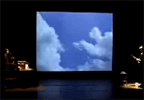
Performance Hybrids
Founded by artist/director Douglas Rosenberg in 1991, Dziga Vertov Performance Group's purpose is to create works bridging numerous disciplines including dance, performance and the visual and media arts. It takes its name from the Russian filmmaker of the early 1900's. DVPG's fundamental mission is to create new and challenging works of art based in the language of performance, dance and media that often combines voice, text, video and projected images. The work of DVPG is concerned with both content and form. The purpose of the work is to engage the audience, other artists and community groups in a dialogue that reaches beyond the usual performer/spectator relationship. In order to do this, we have set out to create a hybrid form of performance that is intended to both engage and challenge, using concepts and images that speak to contemporary and historical issues of human existence.
One of DVPG's many projects is ADaPT, an interdisciplinary association of artists, technologists and scholars from five educational institutions dedicated to research and critical dialogue on performance and media in telematic space.
ADaPT comprises five dance studios in five universities in the USA.:
1. Arizona State University
2. Ohio State University
3. University of California-Irvine
4. University of Utah
5. University of Wisconsin
In Wisconsin, the ADaPT team consists of Douglas Rosenberg (principal investigator), Chris Dowling (telematic technologist) and Jeffrey Gray Miller (technical director).
The objectives of ADaPT are to:
* create a site for telematic collaborative inquiry for the purpose of developing new models of practice and training techniques for the creation of networked dance and performance
* explore embodiment and somatic intelligence through reconceptualization of spirit, body and machine in Internet 2 culture- develop a shared mediated space for investigating performance and creative collaboration through a distributed environment across time zones
* situate research within a larger cultural and political context that acknowledges how mediated performances both frame and are framed by issues such identity, privilege, and access.
Posted by jo at 11:48 AM | Comments (0)
February 04, 2005
Ghosts

Preserving Fragments of Thought
Ghosts is a digital sculpture that plays with the notion of 'instant' communication, such as email, web chat and text messages. The projected sculpture is created from the messages visitors contribute through text on a keyboard or mobile phone messages. These words, ideas and fragments of thought are preserved and given a longer-term existence, shaping a continuously evolving digital sculpture for others' future experience out of the messages you leave behind. Ghosts prompts visitors to question and interact. Where do all our text messages go? Are throwaway ideas worth keeping? Visit Ghosts and let your message form the art-work and make a mark on another's experience.
The installation was recently exhibited at the Montreal Festival of New Cinema and has been created by Squidsoup, a group of interactive designers, artists and musicians whose aim is to expand current thought within interactive art and design. Squidsoup's work has won awards and accolades within the new media industry, including a BAFTA nomination and entry into the British Design & Art Direction (D&AD) Awards Year Book.
Posted by jo at 04:24 PM | Comments (0)
Breathe On Me
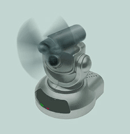
Breath as a Fundamental Form of Communication
Breathe On Me is an installation/internet work consisting of a three-walled space with a number of hybrid fan/webcam devices affixed to the walls. The fan/webcam devices are modified netcams such that Internet users can control the direction of a fan from the remote webcam view combined with pan and tilt controls. Internet users can choose one of the devices in the space, log onto the "FanCam," visually locate visitors in the physical space and then turn on the fan and "breathe" towards the person. Visitors in the physical space are invited to enter a space where they will be remotely seen and will not know who is telepresent. Once seen by internet participants, they will receive an offer of fan "breath" as a fundamental form of communication. Visitors who enter the space are asking to receive a telepresent stranger’s glance and touch in the form of wind. Internet users reach out to physical visitors in the simple offer of moving air.
To visit in telepresence: Links will to the live performance will be available at the live site within 24hrs. Opening Telepresently and in Situ: Friday, February 4, 2005; 8.00-9.30 PM, Pacific Standard Time, Continuing live through February 6; INTERACTIVE FUTURES 05: Technology in the Life World, Victoria, BC @ Open Space Artist-Run Centre
Posted by jo at 09:35 AM | Comments (1)
February 02, 2005
Database of Virtual Art

A Research-Oriented Overview
The Database of Virtual Art documents the rapidly evolving field of digital installation art. This complex, research-oriented overview of immersive, interactive, telematic and genetic art has been developed in cooperation with established media artists, researchers and institutions. The web-based, cost-free instrument - appropriate to the needs of process art - allows individuals to post material themselves. Compiling video documentation, technical data, interfaces, displays, and literature offers a unique answer to the needs of the field. All works can be linked with exhibiting institutions, events and bibliographical references. Over time the richly interlinked data will also serve as a predesessor for the crucial systematic preservation of this art.
Posted by jo at 12:43 PM | Comments (0)
January 31, 2005
RAW
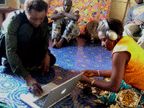
Capturing and Archiving Personal Artefacts
RAW--a project of the Human Connectedness group of the now defunct MediaLab Europe-- is a set of tools and processes for capturing, in an unconventional way, everyday subjective experience of a place, a culture, a people. RAW is named for the raw data gathered that purposefully remain unedited throughout the processes. The combined characteristics of RAW (including an emphasis on context of use, non-edition, and data presentation) make this concept a novel approach to authorship, to cultural exchanges, to audiovisual language, and to documentation.
At its core, RAW is an audiovisual recording device that combines a digital camera and audio recorder. Taking a picture triggers the recording of the sound a minute before and a minute after it. The relationship created between sound and image forms a disjoint flow and opens a new field of audiovisual expression. These previously uncaptured moments in time can be kept as personal artefacts and archived for human studies. The collected, unedited data will also be explored in a daring way within public interactive installations.
While RAW can address different intentions, its primary application is to be at the disposal of individuals in a series of social and cultural contexts. Specifically, its use in the African country of Mali has driven the research and development of the project.
Posted by jo at 12:20 PM | Comments (0)
January 27, 2005
East by West
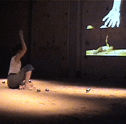
Fictional Geographies and Mediated Presences
"The concept of networked, translocal spaces allows investigation of the nature of real-time sound synthesis and how extended physical space can be shared by people when they play with fictional geographies, strange or familiar objects, and their mediated presences. Telepresence restructures and enlarges the environment with its projection (window) of mediated and combined presences in action. Linking a "local" site with a "remote" site raises particular challenges for our understanding of new artistic paradigms in telepresence, distributed and "navigational" art. The social orientation toward sensual environments and "hyperplasticity" is not directed at euphoric assumptions about virtual reality (VR) but at concrete, synaesthetic processes of cognition. East by West addresses the visitors' playful fantasy and tactile exploration of the environment; the interface becomes useful. If such play recognizes how parallel reality-systems can converge or affect each other, how we integrate other realities into our social experience."
Posted by jo at 09:44 AM | Comments (0)
January 25, 2005
In Conversation
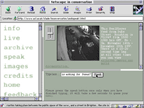
From Street to Chatroom
When live and located, In Conversation provided the means for individuals in the street and on the Internet to engage in a live dialogue with each other. This work by British artist Susan Collins aimed to examine the boundaries and social customs of distinctly different kinds of public spaces - the street and the Internet/chatroom-each with its own established rules of engagement.
Passers-by encountered an animated mouth projected onto the pavement and, through loudspeakers, could hear voices triggered by internet users trying to strike up a conversation. When the pedestrians responded, a concealed microphone and surveillance camera transmitted the responses to the website via a live video stream (webcast). Through the website, online visitors could view the surveillance video and hear the people on the street. They could type messages and send them 'live' to the installation where they were converted into speech and broadcast to the street through loudspeakers.
Posted by jo at 09:08 AM | Comments (0)
January 20, 2005
Tele-tap

Transparent Borders
"Where are the borders between public and private? Between art and life? Between urbanity and individual? - The project Tele-tap by the Amsterdam women artist group CUT-n-PASTE connected its listeners with a number of personalities active in Amsterdam's nightlife: a member of the Salvation Army, a harbour worker, a musician, a woman strolling through the pubs. Each of these personalities went into his urban environment, in his auditory-communicative hunting ground, lived there his life, played his role, provoked encounters. This was transmitted live by the permanent open mike of their mobile phones. Each of them could be wiretapped by the audience via radio, Internet or at the performance venue. Tele-tap showed how undefinable the borders can become between intimate and public space in a mobile communicating society. The technical »heart« of the project is the Internet, where the mobile phone sound inputs were converted into live audio streams and were audible all over the world. These streams also went on air as radio signals, and were accessible by headphones and loudspeakers at the performance venue itsself. The last time Tele-tap was live aired and live performed was on August 31 and September 1, 2001 on the Dutch radio channel VPRO and at »De Balie«, an Amsterdam cultural center. New technologically and dramaturgically extended versions of the project are in preparation. [via AudioHyperspace]
Posted by jo at 03:19 PM | Comments (0)
January 19, 2005
F2T (Free to Talk?)

SMS Rapper Slang
F2T is an interactive musical installation about "argot" and its different contemporary applications. F2T, a creation by artists Frank Plant (United States) and Thomas Charveriat (France), combines sculpture, robotics, hip hop, and SMS messaging to explore the ways technology shapes the development of language, particularly new forms of slang. Viewers interact directly with the artwork by sending it a short text message from their mobile. Once received, the SMS is scanned for frequently used words and, when a match is found, the four elements are activated. The main piece, "Rapper" begins to twist and wave his hand while mouthing a rap based on the message sent, the new lyrics culled from more than 130 different hip hop phrases written by Amsterdam-based lyricist and composer Jim Barnard. The rest of the piece is simultaneously set into motion: "Boom Box" starts flashing and blasting out the song while "Joy Ride" a bouncing low-rider, and "Shake Ass" (looks like it sounds) begins to move, triggered by ambient sound sensors. When the song is finished, a thermal printer spits out a souvenir with the original SMS and the words of the "Rapper." (via Rhizome)
Posted by jo at 02:50 PM | Comments (0)
January 14, 2005
Kododama

Solid conversations
To represent the sensation that spoken words are somewhat tactile and occupy a certain space, Japanese artist Hisako Kroiden Yamakawa created Kododama, an installation of interactive voice containers. Objects made of polyester and rubber float in the exhibition space, their shape inspired by the voice bubbles of comics.
When a visitor picks up a stethoscope and touches the voice bubble object, s/he can listen to messages which have previously been stored inside the bubble by others. To record a message into the bubble the user touches the nozzle of the voice bubble and speaks into the microphone integrated, while a small light indicates the recording process. The recording also triggers the voice bubble to inflate through integrated compressors and pump. But the bubble gradually deflates when users listen to the messages through the stethoscope.
Related: planting sounds in the city, communication via urban audio tags. Blogged by Regine on near near future.
Posted by jo at 10:02 AM | Comments (0)
800-178968

...I'll Call You
800-178968--by Luca Bertini--was a toll-free number that attempted to establish an obsessive and addictive relationship with individuals. It called people back, even after a few weeks, and pleaded with them to come back.
800-178968 was invasive, insinuating itself into the homes and mobile phones of people, violating their privacy, and becoming part of their daily lives. The advertisements for it--which began three months before the start of the service--were hidden among information channels (by adopting their language, codes and instruments), thus were able to reach an unaware, vulnerable audience. The project ended on July 2003 with over 10.000 people contacted. [via Rhizome]
Posted by jo at 09:30 AM | Comments (0)
January 13, 2005
database

Present Time Always Passing By
database is an electronic reading device that deals with the inversed functionality of three electronic devices: a printer, a video camera and a database. Consequently, it raises issues about the erasure of text, the act of reading in real time (i.e., listening to a printed text), and physical databases. Through the opposition between presence vs. absence, recording vs. erasure, memory vs. forgetfulness, present vs. continuous time and reading vs. listening, we challenge the idea of the database as a non-linear and digital structure, and the printer as an output device as well as an information recorder. Critical for the connection of all these concepts is the idea of present time as a time that is always passing by.
Posted by jo at 08:33 AM | Comments (0)
Gravity and Resistance

Gravity as an interface of perception
Artist Mikami Seiko and architect Ichikawa Sota see gravity as an interface of perception, claiming "the interface itself exists inside us."
Their installation Gravity and Resistance presents the dynamic processes of the interactions between gravity and resistance: a dialogue between the body and space.
Each participant becomes "an observation point," and another participant joins to make "plural moving observation points." The number of participants at a time is not limited.
Sensors detect instantly and continuously the changing position, weight, and speed. Based on the relations among participants' dynamics, GPS in the sky above the site, and changes in the space, another space is created by light, sound, and images.
Implicit in the resistance of gravity is the social dynamic/collaboration among the participants as active agents creating the gravitational traces. See more detail on their site.
Posted by michelle at 03:45 AM | Comments (0)
January 12, 2005
HopStory
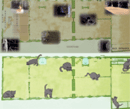
Interactive, Location-based Narrative Distributed in Space and Time
"As computing and communications technologies evolve, there is the potential for new forms of digitally orchestrated interactive narratives to emerge. In this process, balanced attention has to be paid to audience experience, creative constraints, and presence and role of the enabling technology. This paper describes the implementation of HopStory, an interactive, location-based narrative distributed in space and time, which was designed with this balance in mind. In HopStory, cinematic media is housed within wireless sculptures distributed throughout a building. The audience, through physical contact with a sculpture, collects scenes for later viewing. Inspired by the history of the installation space the narrative relates a day in the life of four characters. By binding the story to local time and space and inviting the audience to wander, we amplify the meaning and impact of the HopStory content and introduce an innovative approach to a day-in-the-life story structure." Abstract for Hopstory: an Interactive, Location-based Narrative Distributed in Space and Time by Valentina Nisi, Alison Wood, Glorianna Davenport and Ian Oakley [PDF]
Posted by jo at 02:57 PM | Comments (0)
January 10, 2005
Stereotactic
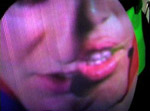
Video mixing as analogy
Stereotactic is a performance project by Michelle Kasprzak and Michelle Teran that was first performed in 2001.
A series of internet searches is conducted, using the five performance parameters as search terms. These searches are the visual research that the performance gestures and set design is based on.
Performance parameters/Search terms:
1. two performers
2. live video mixing
3. the projection
4. the screen
5. the DJ
Each performer creates a performance environment in front of a video camera, and each performance is being projected in the space, with the projectors pointed at each other.
Guests are invited to wear portable screens, and step between the two video projector beams. The movement of the guests creates a constantly evolving image. View an extract of the performance documentation. View the website with the visual research.
Posted by at 01:39 PM | Comments (0)
txOom
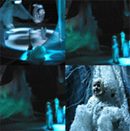
A PlaySpace made of wearable architectural elements
txOom is a responsive PlaySpace, where the participants are invited to actively take part in transforming the environment; shaping the sound, playing with visuals, tangling in textiles, and thereby influencing the audio and visual environment around them by the way they move and interact with the space. The txOom environments "adopt" the properties of living skins. Fabrics, garments and objects in these spaces are shapeable interfaces. [via near near future]
The PlaySpace is composed of several wearable architectural elements including wall-shirts, swing-dresses and floor-skirts. By wearing these garments, the participants literally wear the txOom space, causing the physical environment to be reshaped by their activity in it. This activity influences the shape of the physical environment as a whole, simultaneously inciting growth and mutation in the media worlds. Each player is sensed by the PlaySpace using motion sensors and vision tracking systems incorporated into the space. Gradually, the social interaction between the participants, and the responsive sound and visuals projected throughout the PlaySpace, will change and evolve as they begin to play together.
Posted by jo at 12:00 PM | Comments (0)
Nullpointer

Warped Experiences
CCTEX is based on the expanding cultural practice of game modification and the increasing presence of cctv and mass observation technologies. In CCTEX a level from 'Counter Strike' (a popular counter-terrorism mod) is re-mapped to offer the user an warped experience of covert surveillance.
The environment that the user experiences is coated in imagery drawn from a set of webcams that are positioned strategically around the installation space. Streaming video of the audience and gallery space are translated into textures that paint the modified game architecture. The textures are manipulated during this process to create a semi-abstract reflection of the users' space outside the machine. The viewer is confronted with a distorted vision of themselves and their environment as they interact with the work. [via neural.it]
In a previous work I focussed on the ubiquitous nature of cctv and digital media streams. (Peacekeeper took as its content the already glitched news web broadcasts with their nightvison camera shots and digital artefacts). With CCTEX the data source is drawn directly from the users behaviour and the physical space outside the machine. The increase of covert surveilance (both public and private) is a familiar trend but rarely is the audience of such observation permitted to see their performance onscreen. Not only does CCTEX present the user with their own captured image but it also demonstrates how such data can be distorted and manipulated.

PeaceKeeper: A networked, digital art installation for the Radiator Festival (1-11 May 03). Shown at the Surface Gallery, Nottingham (Commissioned by NOW & Trampolene).
For this project the software application that gamers use will be modified to warp the viewers experience of a frenzied online space. The digital arenas of an online FPS (First Person Shoooter) will be reprocessed into abstract architectural forms, time becomes compressed into a visceral texture.
Within this environment two computer controlled adversaries (Bots) are locked in an endless cycle of killing. Each Bot has only one objective, to eliminate the other, but with each victory the players are reborn to start the process again. The commanding logic behind this loop is inhuman and seemingly irreversable. However the viewer is invited to step within the cycle and intervene in the process. Each Bot will be represented by a large scale projection of its current view, from its own first person perspective. The two projections face each other across the installation space, as if allowing the opposing players to witness their deaths through their enemy's eyes.
Final Score
The installation ran for 10 days (24 hours a day) during the festival. The final score was 4408 v 2204. Bots were initially evenly matched but over an extended period small differences in their behaviour effected the final outcome.
Posted by jo at 10:24 AM | Comments (0)
January 09, 2005
Three by Thomas Charveriat

Animatronic Installations
The Machine Manifesto is an interactive musical performance that reflects upon the relationship between human beings and machines. It is composed of a series of mechanical musical instruments or automatons, and directed by an orchestral conductor. The instruments--programmed to perform independent tasks--follow the commands sent by the conductor via image recognition software. Machine Manifesto reflects the existing asymmetry between humans and machines (conductor and instruments), and provides an ironic look on the privileged position of machines in our society.
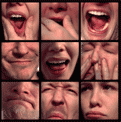
Light Activated Faces: A torch flashed at a square panel standing vertically on the floor, produces the sound of human onomatopoeias which vary depending on the area onto which the light is projected. Nine different grimaces are depicted on this photographic panel. Each facial expression becomes visible by means of a light box mechanism, whenever the flashlight points at it. A corresponding onomatopoeia is then produced by a sound sampler. The effect is a large human chorus conducted by the action of a flashlight.
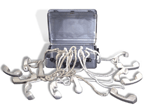
Telephones: Artificial intelligence is a rapidly developing area of scientific research. Many jobs formerly held by humans are now being done by computers, often by "bots" (computer generated intelligent entities that present themselves as human in order to perform tasks for others). One field where this has become common is automated phone service. This piece illustrates the computer's potential by replacing live person on a sex phone line with voices created by a computer. In it, twelve different computer-generated personalities have intimate conversations.
Thomas Charveriat (Paris, 1974) lives and works in Barcelona, Spain. Studied photography at the School of Visual Arts(SVA)and afterwards obtained a master degree in sculpture from Columbia University. Both schools are located in New York City. After finishing his studies in New York, he moved to Barcelona, where he obtained a master degree in digital arts at the Pompeu Fabra University. He has won a number of scholarships and prizes. He has participated in collective art exhibitions in New York, Paris and Barcelona since 1998. At the moment, Thomas Charveriat creates animatronic installations with GPS, SMS, video, sound, electronic data and humor that interact with the viewer in a peculiar environment, where the complexity and elegance are combined to create sensorial ambiguity associated with an atmosphere of vulnerability and apprehension.
Posted by jo at 11:59 AM
January 06, 2005
Special Treatment
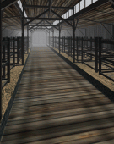
Memory as Malleable Substance
Special Treatment advances the audience from passive viewing to active experience by smoothly moving from present to past and back again. Special Treatment creates a landscape where glimpses and fragments of Birkenau establish a narrative framework where the events of the past continue to shape and be shaped by contemporary interpretations of those events. The full history and lesson of a place such as the death camp at Birkenau is seen not only in the records of those who survived or passed on their memories to us in the present, but in how those events are remembered and shaped by the people of today. The stories of these people grow with each new experience of Special Treatment, and the solidity of that space and the substance of those events becomes more concrete with each new visitor. The immersive experience allows each participant to inhabit the scene of these events, and as they leave the evidence of their own actions and memories, Special Treatment is continually transformed into a new potential memory. [via Rhizome]
At its most basic level, memory is a perceived arrangement of events. Applied Interactives is concerned with how memory is a malleable substance, and Special Treatment's poignancy is highlighted by a world where global and mass communications instantaneously influence impressions of events, so that people have incomplete or greatly divergent ideas about the same occurrences. Even if we tried to faithfully recreate the past, the interpretation of those events would vary from one day to the next.
Although Special Treatment uses the holocaust as a context, the project creates an experience beyond time by focusing on the larger issues of persistence and memory. Events other than the holocaust could have been used as the basis for Special Treatment. However, any occurrence that exhibits the tragedy of 'history repeating itself' provides a powerful framework for taking a critical look at how and what people remember, how they change their thoughts over time and how cultural biases influence personal recollection.
Not a "virtual reality" but an interpreted reality, Applied Interactives has specifically selected our medium to fully engross participants in the experience by allowing them to create their own personal narrative. Special Treatment is more than observation - the piece is interactive as well as reactive; visceral and emotional as well as intellectual. The term virtual reality, as a cliché of futurist propaganda, has been overstated by the media and is widely considered to be an attainable technology. We are critical of this belief and the entertainment industry's portrayal of interactive storytelling. We find that they more commonly wish to construct their stories with products and brands rather than use the medium in the creation of a meaningful experience. Other meda are bound to formulaic standards that utilize obvious narrative arcs that don't allow for the same degree of individual ownership of the experience. With Special Treatment we hope to break down the conceptual barriers that have been placed around artwork employing these cutting-edge technologies.
Applied Interactives is an artist-based 501(c)(3) non-profit organization founded in Chicago in 2001. Its primary mission is to propagate virtual reality technologies and art into the exhibition spaces of galleries and contemporary art museums as well as into the hands of individual artists. AI is composed of students, faculty, and alumni of the University of Illinois at Chicago (UIC), Columbia College Chicago and The School of the Art Institute of Chicago (SAIC).
Posted by jo at 10:46 AM | Comments (0)
Some time of available human brain
![dtdchd1[1].jpg](http://www.turbulence.org/blog/images/dtdchd1[1].jpg)
Internet installation for television channel
and computer assisted actor
"Some time of available human brain" is a ten to fifteen minute performance conceived by Christophe Bruno.
An actor lies on a psychoanalyst's couch, with a television that broadcasts a TV channel live behind his back. Behind the couch, a person types in key words in relation with what the TV set shows. These key words are sent on a server and thanks to a search engine, a program extracts the textual flood relating to the chosen key words in real-time.
The text is then read by a voice synthetizer and sent to the headset of the actor who says it as soon as he hears it.
The result is a two-voice performance: the voice of television--the spectacle provider--and the voice of the Web, where a fallacious freedom masks the success of the society of control. (Posted by Régine Debatty)
Posted by Regine at 03:57 AM | Comments (0)
January 05, 2005
Habitgram

Cloaked in Space
Habitgram, by Montreal-based artist Beewoo, is a surveillance coat that the visitor is invited to wear. Inside the coat, several wireless mini-cameras pick up the environment of the wearer. The images are multiplied through video projections on the space walls. While wearing the Habitgram, the participant actually "wears" the space in which (s)he is standing.
As the cameras are positioned so as to rotate the captured images, either vertically, horizontally or at a 90° angle, some participants tried to restore the images to their original position and many others reported experiencing sensations of vertigo while wearing it.
"The user in command of this mediated image flow finds himself submerged in it in a discomforting way. Would the media image be so untamable? Drowning in this immersive environment, the viewer constantly attempts to understand its structure and source. Meanwhile, (s)he discovers new ways of exploring the physical architectural space in relation to its multiplied video mirror. Here, being immersed does not prevent the viewer from taking a critical distance towards the artwork. On the contrary, it is the immersion itself that triggers critical observation." [from near near future]
Posted by jo at 10:33 AM | Comments (0)
January 04, 2005
Dry Translator
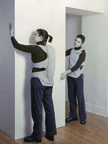
Walls as Touch Messaging Devices
Dry Translator, a sculptural installation piece by Sabrina Raaf, is built in response to new trends in 'smart architecture.' Smart technology is being created for enhanced human interaction and control of one’s urban building and home environments. Interestingly what excites many is not the necessarily the enhancement of control, but really more the idea of intelligent responsiveness and heightened personal connection with the rooms they inhabit.
Dry Translator is taking this idea of responsiveness to an exaggerated degree. The idea is to create an environment so sensitive to human presence that a touch to its walls sends resonant vibrations throughout the bodies of its occupants. Whereas normally people acknowledge the presence of walls in a building as merely types of boundaries or surfaces, this piece allows them to engage with walls in newly intimate ways such as touching, beating, and even 'playing' the walls as instruments. And, it also allows them to use the walls as sorts of touch messaging devices.
The piece includes two custom designed audio vests (which gallery visitors are invited to put on) and an interactive wall. Essentially what occurs with this piece is that when a participant touches the wall in the gallery, they hear the sound of their touch not locally where their fingers hit the wall, but actually on their own torso (via the vest). Inside of the wall there are several wired tentacles that act like stethoscopes which are able to pick up the slightest vibrations within the drywall material. Sounds from participants touching the wall are greatly amplified and transmitted wirelessly to the vests. The wall becomes a skin-like extension of the participant’s own body. In touching the wall, they touch their self. Participants may also record a series of touches or gestures on the wall via an interactive consol and thereby leave a message for the next participant to play back on the vest.
Posted by jo at 08:01 AM | Comments (0)
Alter Ego
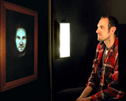
A mirror that frowns back at you
Alf Linney, a specialist in facial reconstruction, and artist Alexa Wright have designed Alter Ego which allows people to interact with a ‘mirror’ that takes on a life of its own.
Sitting in front of it, the viewer is captured on video and the dimensions of their face are mapped onto a generic model (with a simplified version of the technology Linney uses for surgery). After some 30 seconds, the ‘reflection’ begins to react to the person's facial expressions. "We can make the model do whatever the person in front of it is doing – smile or laugh – or we can give it an alter ego, a sort of a mind of its own", explains Linney.
The mirror won’t do what the user necessarily expects. For example, the mirror can shock smiling people by suddenly frowning back at them.
More mirrors: persuasive mirror, MirrorSpace. [blogged by Regine on near near future]
Posted by jo at 07:55 AM | Comments (0)
Saturday
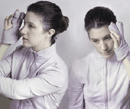
Sounds Mixed in the Bones of the Listener
"With the overuse of radio frequency bands for wireless communications, there comes the increased occurrence of crossed lines where a private conversation becomes accidentally shared. To create this interactive sound piece, Saturday, [Sabrina Raaf] used walkie talkies, CB radios, and various other forms of consumer spy (or ‘security’) technology in order to actively harvest such communication leaks. Saturday forms a uniquely intimate portrait of the community of Humboldt Park, Chicago through a composite presentation of conversations stolen on Saturdays in the park. Saturday is a sound based artwork that participants experience through a custom designed glove interface. [via near near future]
When I began working with wireless sound technology, I was startled by the sheer quantity of non-phone, low tech, radio transmissions that were constantly being sent around my neighborhood. Humboldt Park is a lower income, racially mixed neighborhood of Chicago. The transmissions included communications between gang members on street corners nearby and group conversations between friends talking about changes in the neighborhood and their families. There were raw, intimate conversations and often even late night sex talk between potential lovers. There is a furtive quality to most of these conversations and also a particular daringness in their tone. During the series of Saturdays, I also recorded the sounds of my neighborhood – the women singing out their windows to their radios, the young men in their low rider cars circling the block, the children, the ice cream carts, etc. These are the sounds that are mixed in the piece. And, these are the sounds that literally drip from participant’s fingertips in Saturday.
Saturday is presented in the form of an interactive glove. In order to hear the audio, participants magically just press their fingertips to their forehead and they hear the sound without the use of their ears. The glove is outfitted with leading edge audio electronic devices called “bone transducers” which make this possible. These transducers transmit sound in a very unusual fashion. They translate sound into vibration patterns which resonate through bone. This is the same process as the natural hammer and anvil system inside our inner ears which allows us to perceive sound. Since the bone transducer does all this work artificially, it allows you to hear crisp audio without it being played out loud or through headphones. So, even if a user covered their ears and then placed their fingers to their temples, they still ‘hear’ the sound. No sound at all is heard by anyone but the participant at any time. This piece permits a new way of listening. The user places their fingers to their forehead – in a gesture akin to Rodin’s The Thinker or of a clairvoyant – in order to tap into the lives of strangers. Pressing different combinations of fingers to the temple yield plural viewpoints and group conversations. These sounds are literally mixed in the bones of the listener."
Posted by jo at 07:50 AM | Comments (0)
January 01, 2005
Biofeedback for Two

A co-operative experience
Pas de Deux by Mary Lucking is a performative installation for two people. The participants wear biofeedback devices and must co-operate by regulating their breathing to create patterns and align projected circles on the gallery wall.
When we think of performance, we tend to think of disciplines that are directly related - theatre, dance, etc. Pas de Deux reminds us that even very fundamental actions, such as breathing, can be measured in a performative sense, and that in many ways, we are all performers. (Posted by Michelle Kasprzak)
Posted by at 04:13 PM | Comments (0)
December 28, 2004
almost certified (grade A noise for non-discerning consumers)

precarious egg-tapping robots
almost certified (grade A noise for non-discerning consumers) is a mechanical sound installation and informative publication by k.cain and b.crabtree. It is being presented by Machine Gallery until January 3rd 2005.
The piece consists of a distributed network of precarious egg-tapping robots. Each unit, individually amplified, features a select unconventional egg. calculated sequences emerge, conducted by beautifully rendered software on a resurrected mainframe (a sweet mac LC3). The result: a peculiar acoustic
spatial drum machine.
"we seek and impart knowledge, addressing alarming practices and trends in the egg industry. by promoting social consciousness we can live better through decentralization." [video]
Posted by jo at 07:54 AM | Comments (0)
December 27, 2004
netzwissenschaft
![]()
Emerging Infrastructures of All (Inter)net Research
Dr. Reinhold Grether's network research | netzwissenschaft site maps the "emerging infrastructures of all (inter)net research endeavours. net.science as an anthropology of connectivity is trying to overcome the constraints of specialist method transfers on net matters. the protuberance of technical networks necessitates a professionalization of human net knowledge. neither the isolation of concepts as in basic research nor the encapsulation of processes as in applied sciences will ever be able to adequately describe the complex autopoiesis of networks. net.science is undoubtedly developing into a scienza nuova of its own right."
Check out his Mobile Art and Virtual Performance research areas.
Posted by jo at 04:45 PM | Comments (0)
December 25, 2004
Mother, Child
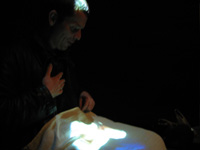
Virtual motherhood
"Mother, Child", by Finnish artist Heidi Tikka, is an interactive video installation that intends to recreate the astonishment a mother feels when holding her baby.
The projection of a nursing child is projected on a piece of white fabric held by the exhibition visitor. The point of view from which the child is being seen is the mother´s. Mediated by camera sensors and algorithms, the image of the baby responds to the movements of the "mother" and the people surrounding the space. If there is a lot of movement or if the place is too crowdy, the child becomes restless and starts to cry. The person holding the fabric can gently rock the baby back to sleep.
The work addresses the challenge that the contemporary interactive technology posits on subjective experience and its representation. It also raises the issue of the social dimension of care. (Posted by Régine Debatty)
Posted by Regine at 07:24 AM | Comments (0)
December 24, 2004
Power to the People
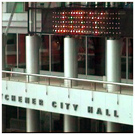
Public Play
"P2P" by Matt, Susan, and Robert Gorbet, is a performative installation consisting of a marquee of light bulbs installed on the face of a public building and a switch panel on a nearby sidewalk. Each switch controls one corresponding bulb on the marquee.
The switch panel is an open invitation of expression extended to the general public, and each time it is installed it creates a new social experiment. Some members of the public engage in competitive games with each other, "chasing" each other around the marquee; others choose to write their name, or word slogans ("Peace," "H", "F U", "Weed", etc.), or draw small pictures. Some messages are indecipherable or benign, others cause a few raised eyebrows.
This installation is fun to interact with, and it is just as fun to watch others interacting with it, which is a rare experience indeed. Past installations of P2P include one on the face of Kitchener City Hall, in Kitchener, Canada, and on the face of the Drake Hotel, in Toronto, Canada. Check out more work by the Gorbet Design collective at their website. (Posted by Michelle Kasprzak)
Posted by at 11:02 AM | Comments (0)
White Square
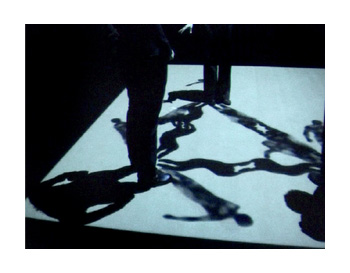
Interactive shadows
When a person steps in the White Square of light, shadows appear circling around him/her. These interactive shadows projected around the feet make contact with other shadows in the square. People can play together with collaborative visual structures created by shadows reaching and grabbing onto each other. The shadow world creates a reflecting surface of positions and movements done by people in the square.
The human shadow is transformed into an interactive medium. The installation, created by Helsinki-based artist Hanna Haaslahti, illuminates the network of connections between people sharing the same limited space. White Square tries to break the control and command-relationship people have with technology into a more intuitive and physical one. This kind of public playground aims to stimulate a new awareness of ourselves as a physical being. White Square can also be seen as a media architectural space, which enchants people to move and express themselves, subtly using their body as a tool of interaction. (Posted by Régine Debatty)
Posted by Regine at 09:51 AM | Comments (0)
Autopoiesis
![atp04[1].jpg](http://www.turbulence.org/blog/images/atp04[1].jpg)
Artificial life robotic sculpture installation
Ken Rinaldo's Autopoiesis consists of fifteen robotic sound sculptures that interact with the public and modify their behaviors over time. These behaviors change based on feedback from infrared sensors, the presence of viewers in the exhibition and the communication between each sculpture.
The robotic sculptures talk with each other through a computer network and audible telephone tones. The interactivity engages the viewer/participant who in turn, effects the system's evolution and emergence. This creates a system evolution as well as an overall group sculptural aesthetic.
The robotic sculptures communicate with a musical language that gives the viewer a sense of the emotional state of the robots as they interact. Higher and more rapid tones are associated with fear and the lower, more deliberate tonal sequences with relaxation and play. Other tones give the impression of the sculptures whistling to themselves. (Posted by Régine Debatty)
Posted by Regine at 01:09 AM | Comments (0)
December 22, 2004
Mimetic Starfish
![brown[1].jpg](http://www.turbulence.org/blog/images/brown[1].jpg)
Neural Net Sea Creature
Mimetic Starfish's Mimetic Starfish projects the image of a starfish onto a table, its tentacles extending to viewers' hands, if they move too quickly the tentacle suddenly retracts in a fluid but alarming manner.
Stroking a tentacle causes neural net activity to be displayed by muscular contractions and colour changes of the skin. The Starfish through illusion and mimicry fools us into thinking that it is aware of our presence. Its movements are organic and convey a sense of aliveness. It is an example of Artificial Life that encapsulates ideas of magic and technology, art and science, philosophy and cognition. (Posted by Régine Debatty)
Posted by Regine at 02:49 AM | Comments (0)
December 21, 2004
Remote Furniture
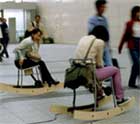
Computer controlled chair objects
The Remote Furniture , by Noriyuki Fujimura (J), are two chairs that have a tilt sensor and a linear motor, and are connected to a PC running control software.
When someone rocks one of the chairs, the tilt sensor detects the inclination and transmits the data to the other chair through the PC. The motor in the other chair than causes it to rock. The aim of "Remote Furniture" is to create direct and tactile touch. When exhibited in public spaces, the artwork seemed to help remove people's shyness and triggered new funny and tactile ways to communicate. (Posted by Régine Debatty)
Posted by Regine at 02:45 AM | Comments (0)
Healing Series
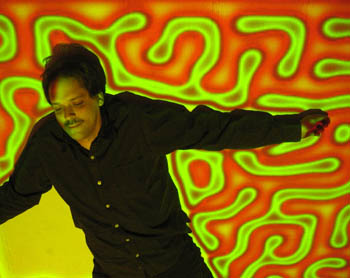
Encounters that leave scars
Brian Knep's Healing Series are interactive floor pieces that change in response to visitors. When a piece encounters a foreign body, such as a gallery visitor or an object, the pattern pulls away, creating a wound. When the foreign body leaves, the pattern heals itself and the wound closes, but each piece heals itself in a different way.
In Healing #1 the sides of the wound never actually touch, a scar forms, like a memory of the meeting of the visitor with the mat. Healing #2 has the mat oozing over the wound caused by the interaction. The mat heals itself until only the essence of each scar is left. Eventually this essence also disappears, leaving a glowing mat. In Healing #3 the reaction is more violent, with the pattern pulsating and quickly reforming over the wounds.
The pieces ties to illustrate the changes that happen when things or people interface with each other. The contact causes changes in all participants, and so has a destructive quality, but change forces growth too, and so has a regenerative quality.
The work is part of the Intimachine exhibition that runs at Art Interactive (Cambridge, MA) till Jan 30. (Posted by Régine Debatty)
Posted by Regine at 02:42 AM | Comments (0)
December 18, 2004
The Living Room

A narrative installation puzzle
"The Living Room", by American artist Victoria Fang, is a narrative puzzle installation. Players enter a space containing 3 rolling units with screens in them and 21 clues painted on the floor. They have to move panels with LCD monitors to solve a whodunit murder mystery. Correctly positioning the units triggers filmed scenes that play back across the three separate panels, and these scenes give the player new clues to trigger the next scene. Players get a different spatialized experience with each scene, as the scenes are constantly changing position, thus working as a giant physical puzzle that houses a narrative puzzle.
This project is designed as an entertainment experience that focuses on the cathartic release of built-up emotional tension, through the use of mobile and wireless technology.
"The Living Room" has received a nomination for Transmediale award 2005.
(PDF of the project) (Posted by Régine Debatty)
Posted by Regine at 12:31 PM | Comments (0)
December 17, 2004
Cathartic User Interface
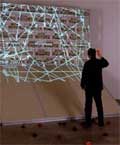
Computer frustration
Perry Hoberman 's Cathartic User Interface (CUI) allows people to express their emotions toward modern technology, by throwing mouse-like rubber balls at a wall filled with obsolete PC keyboards, which in turn triggers projections and sounds that are modified versions of the typical computer error messages.
The balls roll down a ramp at the base of the keyboards and return to the user. Effectively channeling the thoughts one feels when encountering a “file not found” or “web page has expired” message into physical action, CUI comments upon the growing love-hate relationship with technology and the inevitable "glitches" that occur, even as computers increase in speed and complexity. (Posted by Régine Debatty)
Posted by Regine at 03:07 PM | Comments (0)
The Table: Childhood
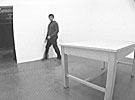
Relationship with a table
The Table: Childhood 1984-2001, by Max Dean and Raffaello D’ Andrea, is a robotic table that selectively interacts with persons who enter the room, but it will choose only one viewer among them. As long as that visitor stays, he or she will be the object of the table’s attention.
The table monitors the visitor’s physical reactions. If that person is unresponsive, Table tries harder: it might initiate an action enticing the viewer to copy it or turn on its axis with a pirouette; it might decide to chase – or even to flee. Once some kind of relationship is established, the table determines how to handle the situation, whether lyrically or aggressively.
The Table switches the roles of viewer and object. The artwork and not the viewer is in the position of choice. This in turn focuses the attention of other viewers on one particular visitors, making that person the "object" of attention.
(video) (Posted by Régine Debatty)
Posted by Regine at 11:22 AM | Comments (0)
December 16, 2004
Drift
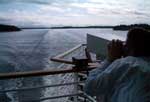
Elastic time and space telescope
drift , by Australian digital media artist Alex Davies (in collaboration with with Daniel Heckenberg), is a sightseeing telescope allowing the viewer to elastically manipulate time and space. This site specific installation was presented on a cruise boat for ISEA 2004.
The telescope features a realtime 180 degree panorama of the scene. Looking through the telescope to the front of the craft provided a real-time depiction of the scene. But as the telescope was panned around towards the rear, time stretched and slowed enabling the user to examine the environment with considerable detail. Panning further towards the rear, time not only slows, but reverses, drifting back over the previous journey.
Just as our own memory is not completely under our control, the telescopic views became smeared and distorted as the dimensions of time and space interfered. (Posted by Régine Debatty)
Posted by Regine at 04:36 AM | Comments (0)
A fleur de peau
![lynn1[1].jpg](http://www.turbulence.org/blog/images/lynn1[1].jpg)
The body as a sound installation
In her sound installation called "A fleur de peau", German artist Lynn Pia Pook invites the recipient to an individual experience of sound transmission.
The participant is equipped with ribbons around head, torso and limbs as well as hands and feet. In these ribbons are 16 speakers without a membrane.
A composition is played that is almost inaudible without the sound suit.
Through the speaker system attached on the body, sounds and their vibrations become sensible. This way, a transforming sound sculpture is composed on and in the body of the recipient.
The sounds move along the body from speaker to speaker and are transmitted only through the bones to the ear and can thus be heard “inside” the body.
During the installation of the work, musicians and composers are invited to test the installation as an instrument and interface and to develop together with the artist the possibilities of her sound suit (more images.) (Posted by Régine Debatty)
Posted by Regine at 01:58 AM
December 15, 2004
Spatial Sounds
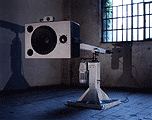
Just don't get too close!
Spatial Sounds (100dB bei 100km/h), by Dutch artists Marnix de Nijs and Edwin van der Heide, is an engine-powered installation with a speaker mounted onto a several meters long rotating arm.
The loudspeaker holds sensors and constantly scans for the public in the room like a radar. This information is processed by a computer that sends sound effects back to the loudspeaker, and in turn these sound effects react to the presence and movements of the watchers. The more the public plays with the installation, the more active it becomes. But if the public interacts in excess with the system, the system goes wild and begins to rotate at a speed that can reach 100 km/h. A deafening sound and the airflow created by the centrifugal movement of the loudspeaker make the public step away.
"Spatial Sounds" reminds us of the engaging attraction we feel towards our technologies and how physically and emotionally vulnerable we are to those powerful devices that are everywhere and have been created by us. (Posted by Régine Debatty)
Posted by Regine at 10:43 AM | Comments (0)
Gravicells
![wait[1].jpg](http://www.turbulence.org/blog/images/wait[1].jpg)
Experiencing gravity
Japanese artists Seiko Mikami and Sota Ichikawa's work, Gravity and Resistance - Gravicells , makes our bodies aware of the interactions between gravity and resistance.
Moving inside the installation space, participants can feel gravity on their bodies and its resisting force. They can also sense the forces that other participants cause.
In the center is a 6m x 6m floor with a built-in sensor. All movements and changes made by participating visitors are transformed into the movements of sound, light (LED) and geometrical images through the sensors, so that the whole space develops or changes in this interactive installation. The installation is surveyed by GPS satellites, so it has the observatory point outside the earth. (Posted by Régine Debatty)
Posted by Regine at 03:35 AM | Comments (0)
December 14, 2004
Biophilia
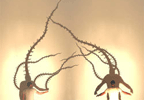
Connections
Mark Cypher's Biophilia* installation enables participants to interact with and generate organic forms based upon the distortion of their own shadow. The shadow resembles the participant and represents the relationship s/he has with the screen. At once reduced to a 2 dimensional image which menacingly begins to merge with other organisms in the same screen space without consent nor care for the sovereignty of the users concept of self and space. Have a look at the impressive video. The work will be shown at the John Curtin Gallery in February 2005 as part of the Perth International Arts Festival (Australia).
*The word biophilia refers to the need of living things to connect with others – even those of different species. [Originally blogged by Regine on near near future]
Posted by jo at 03:10 PM | Comments (0)
The Bench that Became Confused
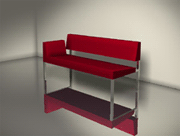
Restless Piece of Furniture
With this installation, Finnish artist Lotta Partanen wanted to study the possibilities of interaction between the physical presence of a human being and a rigid piece of furniture.
When we meet new people, it is sometimes hard to predict how they will turn out to be in the long run. Partanen has tried to replicate the same kind of behavior in an looking bench. As an unsuspecting person seats himself on the bench, an audio starts with the voice of a man telling about his life and the story goes on uninterrupted until the end, if the participant sits passively. But if the one seated moves or if the number of sitters varies, it reflects to the flow of the story and the man starts to become confused. The more activity there is in the use of the bench, the more the man's story is in contradiction with itself.
Posted by Regine at 12:06 AM | Comments (0)
December 13, 2004
Unconscious Flow
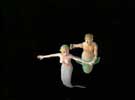
Virtual Mermaids Capturing Our Emotions
In face-to-face communication and to abide by social norms, we sometimes have to lie: put a big smile on our faces instead of bursting into tears or greet visitors warmly when we are in a bad mood. But, the signs that our bodies express as communication (body language) can betray us.
Unconscious Flow, by Japanese artist Naoko Tosa, tries to capture human emotions and use them as an element in a machinic interaction. The work measures the heartbeat of the "honest" body and uses other technologies to reveal a new code of non-verbal communication from a hidden dimension in society. It's what Tosa calls "techno-healing art."
Two computer-generated mermaids function as individual agents for two viewers. Each mermaid moves in sync with the heart rate detected by an electrode attached to the collarbone of its viewer. Then, using a system that calculates the mutual heart rate, both mermaids express hidden non-verbal communication.
Thanks to a camera that picks up hand gestures and a personal computer that analyzes the images, the synchronization interaction model is applied to determine the mermaid's behavior. For a high degree of synchronism, the agents mimic the hand gestures of their subjects, but for a low degree of synchronism, the agents run away.
If one mermaid agent touches the other, a pseudo-touch can be felt through the use of a vibration device. As for background sound, the heart sound of the subjects are picked up by an electronic stethoscope and processed for output on a personal computer.
Posted by Regine at 01:15 PM | Comments (0)
Instant City
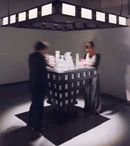
Music-Building-Kit
Instant City is an installation--developed by Sibylle Hauert, Daniel Reichmuth, and Volker Böhm--that allows players at a table to create architecture using semi-transparent building blocks and in the process make different modular compositions audible.
A spotlight hangs over the table and under the glass game board are light sensors. Each arrangement of the building blocks establishes a filter dimming down the intensity of the spotlight. The resulting variations are registered by the sensor field under the glass plate. Each of these gray scale values corresponds to a particular parameter of the selected "instant city" composition. However, what is heard depends upon where the building blocks are placed, how high they are, how many are on the table, and the sequence in which they are used.
So far, eight musicians have produced special compositions which serve as the basic music building kits of instant city. Since the game doesn't have an aim or goal which one can follow, every action becomes a demonstration of the playing personality. With every block that the player plays, he betrays something about himself: some feel overwhelmed by the limitless possibilities; mathematically oriented players will try to proceed strategically while esthetes might want to build elegant constructions, etc. [originally blogged by Regine on near near future]
Posted by jo at 11:14 AM | Comments (0)
Astro Black Morphologies
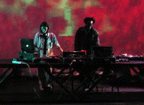
Sounds of Science
Flow Motion's Astro Black Morphologies is a multimedia installation and sound-art performance based in a dialogue between contemporary astronomy, digital art and electronic music. The installation takes as its starting point the announcement by scientists Ian McHardy and Phil Uttley at Southampton University in 2002 that data readings of x-ray detritus from black hole Cygnus X1 were implicitly musical in structure.
In 2003 Flow Motion (artists and musicians Eddie George and Anna Piva) began Sounds of Science, a research project on cosmic music and music of the cosmos, commissioned by the Arts Catalyst and funded by the Arts Council of England - London. Dr Uttley gave Flow Motion access to his research data from Cygnus-X1. They then collaborated with astrophysicist Tim O'Brien at Jodrell Bank Observatory, converting this data from text to audible phenomena.
The converted X-ray data of Cygnus-X1 will be immersed in the transformative technologies of dub production by Flow Motion and generative design by Adrian Ward at Signwave for a real and sonic time based sound-art which utilises the sound-structured detritus of a black hole and the detritus-producing technologies of electronic music and digital imagery. Astro Black Morphologies is the first of a three-part multimedia, cross disciplinary project, 'Music & Science Lovers'.
Posted by jo at 09:10 AM | Comments (0)
Astro Black Morphologies

Sounds of Science
Flow Motion's Astro Black Morphologies is a multimedia installation and sound-art performance based in a dialogue between contemporary astronomy, digital art and electronic music. The installation takes as its starting point the announcement by scientists Ian McHardy and Phil Uttley at Southampton University in 2002 that data readings of x-ray detritus from black hole Cygnus X1 were implicitly musical in structure.
In 2003 Flow Motion (artists and musicians Eddie George and Anna Piva) began Sounds of Science, a research project on cosmic music and music of the cosmos, commissioned by the Arts Catalyst and funded by the Arts Council of England - London. Dr Uttley gave Flow Motion access to his research data from Cygnus-X1. They then collaborated with astrophysicist Tim O'Brien at Jodrell Bank Observatory, converting this data from text to audible phenomena.
The converted X-ray data of Cygnus-X1 will be immersed in the transformative technologies of dub production by Flow Motion and generative design by Adrian Ward at Signwave for a real and sonic time based sound-art which utilises the sound-structured detritus of a black hole and the detritus-producing technologies of electronic music and digital imagery. Astro Black Morphologies is the first of a three-part multimedia, cross disciplinary project, 'Music & Science Lovers'.
Posted by jo at 09:10 AM | Comments (0)
December 09, 2004
Summoned Voices
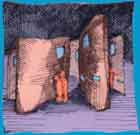
Interactionfields
Summoned Voices--by Iain Mott and Marc Raszewski--acts as a living memory of people and place. It consists of a series of door installations each with an intercom, sound system and a computer that is networked to a central file and database server. The design metaphor of the door presents a familiar scenario, that of announcing oneself at a doorway and waiting for a response from persons unknown. Signage instructs the public to speak, make sounds or sing into the intercom. Their voice is stored and interpreted, and results in local playback composed of the individual's voice with those that have gone before. Summoned Voices acts as an interpreter of sound, a message board and an imprint of a community - a place for expression, reflection and surprise.
Summoned Voices is one of the 22 projects catalogued by Mirjam Struppek for her thesis Interactionfield - Public Space in the Digital Age (2002): "The public space is a field, which is created and becomes alive through various forms of interaction.
Thus interactive art with its life proximity, communicative issues and reflection of the power of the modern technologies is well suited to be linked with the urban public space. This information platform presents detailed some selected interactive media projects, which went consciously into the urban public space. The analysis, categorization and questionaire with the producers of these 22 examples show how new media can be alternatively used, in order to contribute to the rediscovery and reactivation of the urban space and to lead to new interaction qualities. In the open expandable list further projects are collected. With the time an archive can develop, with examples, that show new ways in dealing with the public space. The links section presents various conferences, research projects, articles and specialized artists that related to this topic."
Posted by jo at 06:36 PM | Comments (0)
msdm
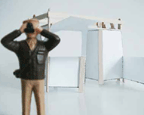
researching mobile strategies of display & mediation
msdm [mobile strategies of display & mediation] is an imaginary organisation founded in 1998 by paula roush to research mobile strategies of display & mediation. A hybrid of artistic, curatorial, experimental practice operating in the interstices of institutions and social systems, the organisation aims to propose participatory alliances for transversal, critical, cultural and aesthetic outputs. The collaborations have extended into the domains of open source software, publishing, para-architecture, public signage, radio streaming and mobile media platforms. They have been shown in galleries, museums, non governmental organisations and independent spaces, including Space Studios, Coleman Project Space, The South London Gallery, the Institute of International Visual Arts, the Bauhaus Foundation, Gesellschaft fur Aktuelle Kunst and the Living Art Museum.
Projects include:

geneticSilence: Public intervention and installation at the Living Art Museum in Reykjavik for the project Polyphony. A bus tour -the ’genetic noise tour’- was organised connecting the gallery with the street. The initial proposal was to have it to collect tourists in the city centre and take them on a tour of the high security genetic labs in the surroundings of Reykjavik. Because the right bus could not be found, the project took another shape and the tour was done in a small VW van, with the tech crew streaming the sound and images to the museum. The accompanying wall catalogue and public newspaper boards showed an archive of the links between art, genetics and architecture. The word ‘art’ -privatised by a genetics research company- was ‘corrected’ in the museum signage with the corresponding patent number.

bowville: bow wireless/ space studios/ london; locative media performance, 2004. Marion Manesta Forrester was electronically tagged. She had 3 days to earn her right to become a citizen of Bowville. People had to vote for her to stay or to go by phone, online or in person by visiting the Bowville Investigation Bureau. Download Bowville Booklet, 9 pages (pdf, 656k) or individual pages at higher resolution : page 1 | page 2 | page 3 | page 4 | page 5 | page 6 | page 7 | page 8 | page 9 |

SOS:OK: A work generated in response to Biscuit Town, the name given to the area surrounding Peek Freans biscuit factory. Biscuit Town was a marker in both organisational and representational forms of labour. It was the first mass producer of biscuits and commissioned the first documentary film shot on location (A Visit to Peek Freans, 1906, BFI Archive). At its core there is an artistic intervention that crosses a gallery installation with a public art intervention. The aim is to produce an emergency biscuit in response to the history of the site (Peek Freans was the first factory to manufacture an emergency biscuit ration to feed the starving population of Paris during the Franco-German war 1870-71) and the current international state of emergency. The launch and the time based performance at Coleman Project Space is inserted into a wider public campaign which includes billboards.
Posted by jo at 05:44 PM | Comments (0)
December 08, 2004
Infrasense
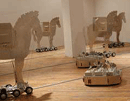
Trojan Horses and Bugs
Worms, back doors, Trojan horses and bugs are some of the better-known terms and metaphors for viral activities on the Internet, on desktops, laptops and in digital research and development labs around the world. The Infrasense project uses the idea of the 'Trojan Horse' and the 'Bug' as two digitally bound elements, which are subsequently produced as physical entities and in turn are partially controlled from the Internet again. The idea is to take concepts from the digital world, render them as physical objects and then return the control of the physical back to the digital landscape of the Internet.
Using 3D figures of bugs and Trojan horses to represent computer viruses, the artists turn the gallery into an interactive game space. Movement of the visitors influences the movement of the bugs and horses but so too does user input from the project website. As the visitor tries to interact with the system in order to access hidden information, questions of control, coordination, and location are raised through the installation. [via near near future]
Posted by jo at 01:25 PM | Comments (0)
December 07, 2004
Robotlab
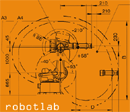
Warming Up to Robots
Robotlab works with industrial robots in public spaces. It explores the relationship between man and machine by means of experimental labs, performances and installations. They try to create experimental forums in which the public has the opportunity to interact with robots and respond to their massive scale, movements, and mechanical sounds. ["Second Career for Old Robot: Art" in today's Wired]
For example, in the installation juke_bots two robot arms act like a DJ. Each machine is surrounded by records which they can select and pick up. In front of each arm a record player is positioned in a way that the robot can thread the records under its needle. Without taking off the record the robot can play and scratch, forward as well as reverse, speed up or slow down the music, and thus generate new sounds with their own characteristics. 'juke_bots' operates as an autonomous performance and as an interactive installation. On a panel the auditor can request certain records or scratch-styles from the machine-artist. By throwing money in a slot the robots play their own compositions.
Another example is motion_interchange: a visitor enters a space and stands across from a robot arm. As the person moves, the robot observes and simulates those movements himself. As this happens, a communicative exchange arises between man and machine that is simultaneously performance and interaction.
Their mutual referencing lies in their reciprocal observation: human eyes on the one side, video eyes on the other. Perceiving the movements of the person or machine opposite directly influences further behavior.
The machine can adopt several characteristics. Both the user and the machine have geometrical objects in their enviroment symbolizing various modes of behavior. If the person takes an object, then the robot takes the respective object as well, and through this exchange, further possibilities develop.
If the visitor adapts his body motion to that of the machine, then the robot can imitate the human gesture. The robot's abilities, however, cannot accomodate more complicated positions or faster movements. Depending on the exemplified behavior, the machine can either respond to the situation or break with his previous logic and find alternative means of expression. The results are never predictible; they depend on the performative behavior of the user.
Posted by jo at 10:29 AM | Comments (0)
December 06, 2004
Standards and Double Standards

Watchful Belts
Rafael Lozano-Hemmer's Standards and Double Standards installation consists of 4 surveillance cameras, a tracking system and fifty fastened belts suspended from servo motors on the ceiling.
Controlled by a computerized tracking system, the belts rotate to follow the public, turning their buckles slowly to face people. When several visitors are in the room their presence creates chaotic patterns of interference. Non-linear behaviours emerge such as turbulence, eddies and relatively quiet regions.
With this piece, the artist wants to visualize complex dynamics, turning a condition of pure surveillance into an unpredictable connective system. Standards and Double Standards creates an "absent crowd" using a fetish of paternal authority: the belt. [Quicktime Video] [from near near future]
Posted by jo at 10:30 AM | Comments (0)
Ghost in the Cave
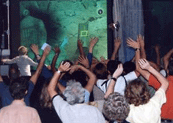
An interactive collaborative game using non-verbal communication
Ghost in the Cave is a collaborative game in which two teams of players use the voice or body gestures for input control. Players not directly involved in controlling the avatars are participating by influencing the music through movements. The task is to navigate in the 3D world and to find three caves. Within each cave the players do an "emotional" task.
The aim was to test the applicability and intelligibility of expressive gesture in a new setting. First, could expressive gesture, e.g. music and dance, be used as a basis for (audience) collaboration and participation? And second, could it be used as an input control / means of communication in an interactive game environment? [Example of movement navigation and music control avi file (4.7M)]
Main Features
Non-verbal communication:
-Both interaction between the computer and between team and players
-Expression in vocal sounds and body movements
Collaboration:
-Team work and audience participation
The game involves participants in an activity using non-verbal emotional expressions. Two teams use expressive gestures in either voice or body movements to compete. Each team has an avatar controlled either by singing into a microphone or by moving in front of a video camera. Players control their avatars by using acoustical or motion cues. The avatar is navigated / moving around in a 3D distributed virtual environment using the Octagon server and player system. The voice input is processed using a musical cue analysis module yielding performance variables such as tempo, sound level and articulation as well as an emotional prediction. Similarly, movements captured from the video camera are analysed in terms of different movement cues.
Ghost in the Cave is a collaboration including four partners within the MEGA project: Speech, Music and Hearing, KTH, Stockholm; Octaga/ Telenor, Oslo; DIST InfoMus Lab, University of Genoa; DEI, University of Padua; and with CID, KTH, Stockholm.
EPS - an interactive collaborative game using non-verbal communication. [PDF]
Posted by jo at 10:08 AM | Comments (0)
SoundSlam

Highly Responsive Punching Bag
"A DJ's life is hard and spoiling. Deejaying all night in overcrowded clubs and producing trax in the studio causes not only fame but also bad temper. DJs most frequently suffer from muscular atrophy and heart disease. SoundSlam is a high end controller built from a punching bag provided with 12 sensors, which are sensitive to pressure, a global acceleration sensor and a soundprocessor unit. Slamming the punching bag at the right spots allows you to control audiofiles and create song structures through your own physical input. Regular use of the SoundSlam lets your muscles grow like grass after a refreshing summer rain. All the girls will not only be delighted by your sophisticated sound but will also love your strengthened body. Other Fur projects.
Posted by jo at 09:24 AM | Comments (0)
December 03, 2004
Spinne
![spinne_electro1[1].gif](http://www.turbulence.org/blog/images/spinne_electro1[1].gif)
Touching of the spider-web
Spinne, by Laura Beloff and Erich Berger (the duo from the Seven Mile Boots), is a networked audio installation of four sculptures made of plastic spheres, loudspeakers and metallic leg constructions. They correspond to four software programs, little search engines known as web-spiders that are sent out into the internet to chase some words or phrases. For example the word "women" can be searched from informational, religious, entertainment, and shopping sites.
Everytime a websurfer is accessing the website, the physical installation is reacting to it by shaking of the cables ("touching of the spider-web"), vibrating the speakers and modifying the soundscape. Little spider replicas are also placed on top of each loudspeaker membrane and the amount of the chased words can be heard and make the glass spiders dance on the membrane. Video.
Originally blogged on near near future
Posted by jo at 02:02 PM | Comments (0)
December 02, 2004
Trajets
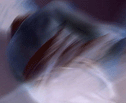
between the subject and the object is the trajectory (Paul Virilio)
Trajets is a movement based installation directed by Susan Kozel & Gretchen Schiller and produced by an interdisciplinary group. The research is based on generating kinaesthetic responses to the movement of the images and screens. Suspended screens move in response to visitors' pathways in a 10 x 10 meter space. A set of movement parameters are attributed to the screens causing some screens to appear sensitive, some not so sensitive, some to follow visitors, some to be repelled by visitors, some to spin, etc. Each screen is driven witha step motor plate attached to the ceiling. Two cameras, vision-sensing software "Eyes" and Cycling 74's Max are used to locate the positions and patterns of visitors walking in the installation. The 'forcefield' software field' software simulates the magnetic interaction between the people and the screens. Images from two video projectors cross onto the screens. These images range from moving bodies to kinaesthetic patterns. A map of the visitors trajectories are projected in a remote location allowing them to see peoples' pathways while in the installation.
Posted by jo at 11:14 AM | Comments (0)
Energie_Passagen
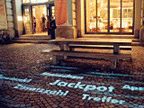
Public Voices Thrown Into the Flow
From Audiohyperspace: "Emergie_Passagen: Reading and (De)Scribing the City" - so the subtitle of this interactive audiovisual installation, which [could] be experienced until November 29th on Munich's Salvator Place. The installation understands a city's public speech - its inhabitants' chatting, the language of politics and media - as diverse streams of energy, from which an architecture is taking shape. The latter is made audible and visible by the art work. Every evening between 6 and 10 p.m. the square in Munich's city center is becoming a place, where a mediated, up-to-date intellectual-political milieu is emerging. The installation is mainly dealing with the interactive generation of semantic connections. A process, which can be initiated by every single passer-by and whose principles can be followed very well online.
Starting point for "Energie_Passagen" are texts taken from a mass medium, the daily newspaper. An automated computer process analyses the German newspaper "Süddeutsche Zeitung" and reduces it to catchwords. The terms which are filtered in this process are then projected as the "information flow" on the square "Salvatorplatz" in Munich.
As a visitor, you can choose between terms and "throw" your choice into the flow. Thus, movements of text are initiated and links between the terms become apparent. The resulting networks of terms create contextual links and new meanings which differ from the original linear texts. Computer voices immediately react to your "input" and accompany you in an echo of many voices.
In addition, a world map visualizes the path through the geographic landscape of news which the visitor takes based upon her/his choice. A developing linear illustration emphasizes the links between local location and global events.
The visible result of this interactive process is the "Living Newspaper". Its dynamically generated texts are projected on the square's "information cube". Newspaper texts are fragmented and transformed, creating new sense or non-sense. - A model maybe, how texts become catchwords, catchwords become arbitrary language patterns. It shows, how not content is the object of mental appropriation, but selections of terms and words are based on association and deliberate playfulness. By this, an intellectual is emerging, coined by the concert of terms and catchwords.
A livestream, accessible via the project's index page, makes the process audible via Internet.
Posted by jo at 10:21 AM | Comments (1)
December 01, 2004
Twilight

Breathing Life Into Architecture
Twilight is an interactive light installation that materialises a light weight, three dimensional, transparent, floating screen. By blowing on one of the paper windmills, the spectator triggers a movement of light and sound. The installation breathes, and this notion is embodied in the gesture of the spectator, the interface, the response of the installation and its effect on the space itself. When interacting with the installation the spectator becomes both audience and performer, both watching the installation and controlling it from under the spotlight. Additional hehe projects can be found here.
Posted by jo at 12:02 PM | Comments (1)
Deep Walls
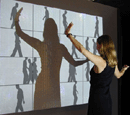
Loops
Deep Walls, by Scott Snibbe, creates a projected cabinet of cinematic memories. Within each of 16 rectangles, the movements of different viewers within the space are projected, played back over-and-over, and reduced into the space of a small cupboard. Initially, when a viewer or viewers move into the larger rectangle of the entire projection, their shadows begin to be invisibly recorded, and one box within the projection (the eventual destination of the current movements) is cleared out. When all of these viewers leave the larger frame, their shadows are re-played within that smaller, single box, looping indefinitely. Thus the work presents records of the space, organized and collected into a flat cinematic projection. By collecting the viewers’ own shadows, the piece reveals how individual objects gain in symbolic meaning, while losing literal meaning, through organization, repetition and display. Quicktime video
Rhythmically, the work presents a complex temporal relationship between cinematic loops. Each smaller collected shadow-film has the precise duration of its recording. A single item in the collection might anywhere from a few seconds to several hours. The temporal, musical relationship between the sixteen frames becomes extremely complex, like Brian Eno’s tape loop experiments, always looping individual recordings, yet presenting a unique whole – the repetition period for the entire work can be on the order of days or even months.
Deep Walls is particularly inspired by the surrealist films of Jan Svankmajer and the Quay Brothers and the sculpture of Joseph Cornell. In their films and sculptures, small bodies and obsessive organization of objects into drawers and cabinets symbolically represent interior, psychological and spiritual states. The rational process of organization only serves to bring out an unconscious irrationality. The name of the piece is a design pattern from architect Christopher Alexander’s “Pattern Language”. His admonition to architects is to build the walls of homes thick, so that cabinets, drawers and windows can perforate the interior space, providing areas to store, display, slice through and ultimately provide more meaning within the home. In the spirit of Alexander, this work gradually absorbs the contents of its environment onto its surface.
Posted by jo at 11:04 AM | Comments (0)
Paragraphie
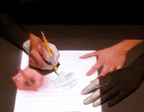
Virtual Hands Traced in Sound
The Paragraphie installation, by Manon De Pauw, has a very low-tech appearance: a chair, a table with used paper and pencils. You can write, draw, scribble, tear, rub, tap...Microphones inserted in the table pick up the sounds generated and turn them into video loops that are projected onto the table. Virtual hands appear on the writing surface, suggesting actions and leaving traces that are superimposed on those of the participant. This situation explores physical and mental attitudes that often accompany the writing process: a place of frustration and pleasure, communication and withdrawal into oneself.
From near near future
Posted by jo at 08:49 AM | Comments (0)
November 30, 2004
Sensuous Geographies
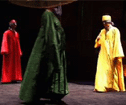
Sonification of Performative Space
Sensuous Geographies is a responsive sound and video environment. It is a space of ritual, a liminal space intended to draw attention both to the intricate inter-weaving pathways of sensation in the body, and to the equally intricate pathways of subtle group behaviour.
The installation comprises a collection of polyphonic electroacoustic sound worlds which are created as the actions of visitors to the installation generate and influence both individual musical layers and the overall texture of the sound environment. Shadowy virtual counterparts of the visitors are projected onto banners, intermittently brought to presence by the motion of those engaging with in the installation. The members of the public who become active participants in this responsive environment immediately become an integral part of the installation itself, as they don richly coloured costumes before entering the active space in order that they can be identified as distinct individuals by the motion tracking which drives the interactive system. The visitors' engagement with and immersion in the sound environment results in a continually evolving world of sound, image, light and colour which visitors can alternately observe from without and experience from within.
Sensuous Geographies is intended primarily to be a space for interaction, for contemplation, even for play. It is in a very real sense a performative space, for the users both generate and become an integral part of the environment as they engage with it. When activated the piece exists simultaneously as a durational 'performance' and an immersive installation environment.
Sensuous Geographies comprises an enclosed space which is hung with banners, some translucent, some opaque. The space is also articulated by the speakers from which the sound emanates. These are placed around the responsive, or performative, space and around the perimeter of the space in which the installation is mounted. The sound is spatialised by the behaviour of the visitors, creating a mobile sound world in which visitors are fully immersed. Projected video imagery which offers a shadowy reflection of the costumes worn by visitors to the space appears and disappears on the banners, which are placed both within and outside of the performative space. The responsive area is defined by a textured floor cloth which gives an implicit geography and shape to the installation environment. [Quicktime video]
Posted by jo at 07:24 AM | Comments (0)
November 29, 2004
Perversely Interactive System
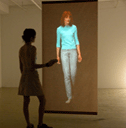
Muted Response Reaps Reward
Perversely Interactive System, by Lynn Hughes and Simon Laroche, puts the spectator into relation with a virtual other whose image (s)he controls through a biofeedback device.
The system is made of a large scale video projection and a wireless "biofeedback handset that monitors galvanic skin resistance (variation in sweat gland activity that measures the level of stress).
The video projection begins with the image of a woman with her back turned. As the participant learns to reduce his or her stress/sweat level, the woman on the screen gradually turns around, and advances towards the participant.
So in this piece, excitation or effort hinders, rather than promotes, successful interaction. If the participant’s tension level rises (often due to the excitement of success) then the woman stops.
Till December 12 at the FILE festival in Sao Paulo. Originally blogged by Regine on near near future.
Posted by jo at 05:46 PM | Comments (0)
LiveForm:Telekinetics

Intertwined Networks
The Waag Society for Old and New Media has in 2004 commissioned Canadian artists Jeff Mann and Michelle Teran to produce and present the second iteration of the LiveForm:Telekinetics Project. LF:TK involves the creation of a series of site-specific installation/performance works connecting hybrid physical/virtual spaces using streaming media and networked kinetic objects. The commission is part of the Connected! project of Waag Society, a two-year programme of performances, lectures, workshops, installations, and emergent events exploring collaborative networked media and live art.
The LiveForm:Telekinetics project is envisioned as a laboratory that examines the intertwining of social networks and social spaces with their technological counterparts. As a work of art, it challenges and expands the notion of performance, the relationship of the artist and audience, production and exhibition, and ideas of locale and presence. The project creates hybrid installation/performative works, augmented with electronic devices and network systems, to create shared spaces and live social situations. Two-way streaming media such as video, sound, and graphics, are used to connect together physical sites via the Internet. Everyday physical objects within the environments become kinetic communications interfaces, animated with embedded sensors and actuators. In LiveForm:Telekinetics, mediating technologies are human-scale, built into architecture, furniture, decorations, utensils, toys, and the bric-a-brac that we surround ourselves with. Read more.
Posted by jo at 10:22 AM | Comments (1)
November 28, 2004
Todd Winkler

Motion, Mapping, and Music
Todd Winkler is a composer and multimedia artist on the faculty at Brown University, where he is Director of MacColl Studio for Electronic Music and Chair of the Music Department. His work explores ways in which human actions can affect sound and images produced by computers in dance productions, interactive video installations, and concert pieces for computers and instruments. He is the author of Composing Interactive Music, a book and CD-ROM about the theory and technology of interactive music and performance, published by MIT Press. Winkler has also authored numerous papers.
His recent work uses motion sensing devices to allow dancers creative input into computer music and digital video systems. These dance productions include: Dark Around the Edges, with Walter Ferrero, presented at Carriage House Theater, Providence, Rhode Island; Songs for the Body Electric, with Gerry Girouard, presented in Minneapolis at Intermedia Arts, and at the International Dance and Technology Conference in Tempe, Arizona; Hitch's Bitches, with Cindy Cummings, at the Project Theatre in Dublin, Ireland and the Yale University Multimedia Festival; and Falling Up, with Cindy Cummings, a commission from the Dublin Fringe Festival.
Posted by jo at 11:28 AM | Comments (0)
November 26, 2004
Karakuri
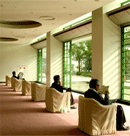
Karakuri: Shadows Working on the World
Presented by Even Eidsten Westvang at VSMM
"Abstract: Within the context of artistic practice as a methodological resource I have built an augmented reality system that allows unencumbered interaction with a structured physics system. The resulting installation artwork is cast as an experimental design laboratory. The 'laboratory' is set wihtin a clearly delineated sub domain of interaction where a rich set of embodied knowledge can inform performativity on the part of users. This allows its further application to a setting of unscripted performance where an anticipatory design process seeks to structure interaction. This paper outlines the components of such an anticipatory design process, theories it can be informed by and within which domains of embodied knowledge it can function. Details of the interdisciplinary and developmental piece Karakuri are presented and analysed. Directions for future research are suggested." [PDF] [Quicktime video]
Posted by jo at 06:02 PM | Comments (0)
November 25, 2004
laptop_orchestra
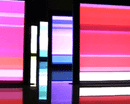
Conducting Synaesthetic Intruments
laptop_orchestra is an interactive synaesthetic instrument designed for performances of audio visual compositions in real time. Fifteen laptops are arranged in rows similar to the formation of an orchestra. Algorithms activate sounds and abstract visual shapes based on the color spectrum; each laptop has its own sound and instructions for the construction of a shape.
Interacting from the orchestra conductor podium by lightly touching metal stems, it is possible to activate or deactivate each laptop, permitting the generation of an endless number of different compositions. Compared to the software of elementary audio and visual compositions, this installation puts the interaction in a defined and public space dimension, drawing a reactive environment in the contour of its physical dimension. Software made with Processing. Download pde file and sound sample.
Limiteazero is an architecture, media design and media art studio based in Milan, Italy.
Limiteazero’s areas of expertise include: network installations design, set design, exhibition design, media in architecture and public space, interaction design, digital identity design, sound design, creative-network-software design.
Limiteazero's experimental activity is concerning the exploration of alternative relations between man, machine and environment, bridging the physical and the digital. It tries to establish an emotional approach using interface systems, instead of a logical/deductive one.
The work around form is mainly focussed on investigating forms and images generated by mathematical processing and through random evolution processes. The "random" sequence is our most used coding expression.
Posted by jo at 12:07 PM | Comments (0)
November 24, 2004
Mulholland Drive
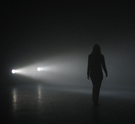
cinema sans image
In Mulholland Drive by D. Scott Hessels, three artists drove Los Angeles' famous Mulholland Drive with five types of sensors—measuring tilt, altitude, direction, speed, and engine sound. The captured data was used computationally to control two robotic lights in a dark room filled with fog. Two beams of light and the processed sound of the engine recreated the topology of the road as a new form of visual experience and sculpture—cinema without image.
Mulholland Drive is a light installation that translates the movement across a topology as two beams of light. Instead of direct human interaction, the work takes the sensed data (tilt, sound, and GPS) of traversing an environment and recreates the drive through angles, light, and sound. A passive interactive experience, the artwork emphasizes the spatial quality of light—it is cinema without image. Like cinema, direct data is captured, then edited, and shaped. However, here the environment directly defines the experience, using the geography computationally. In a sense, “Mulholland Drive” is a new media Earthwork and demonstrates how suddenly the rhythms, patterns, and random chance of the environment can be sensed through new media technologies and used to create new forms of visual experience.
Producing under the name Damaged Californians, Scott Hessels has released experimental art and commercial projects in several different media including film, video, web, music, broadcast, print, and performance for the last decade. His work has shown in international film and new media festivals, on television, and in contemporary art galleries. He recently completed a commission of three interactive films and six online movies for Australia and was honored with a career retrospective at the Melbourne International Film Festival. As a media artist, his installations have shown at CiberArt in Bilbao, the Hammer Museum in Los Angeles, and the Japan Media Arts Festival. Professionally, as Director of Information Technology for Fox Television, he was responsible for the systems, software, communications, and security for two television stations and two cable networks…a career he followed for 25 years. He currently teaches digital video at UCLA in the Design | Media Arts Department and is studying for his graduate degree in that field.
Posted by jo at 01:00 PM | Comments (0)
November 23, 2004
The Gambit
![]()
The Narrative Abilities of Flowers
The Gambit is a portable interactive animation sited in the lobby of the Westin-Bonaventure Hotel (John Portman, 1977). The medium of the project is a digital compass attached to a PDA ("personal digital assistant") with a two and a quarter inch by three and a quarter inch color screen and headphones. This apparatus worn by the viewer displays images of spaces normally inaccessible to the viewer's vision from within the Westin's lobby, in other words, as if you're seeing through walls with a kind of periscope.
The "seeing through the walls" has a shape, like Gordon Matta Clark's cuts through buildings. The shape is configured by animated still images and sound. The still images and sound tell a story. The story is of a hotel flower arranger, and of a parallel world where flower arrangements have archival and narrative abilities. The Gambit is a project of Kati Rubinyi.
Posted by jo at 09:45 AM | Comments (0)
November 19, 2004
not yet it's difficult
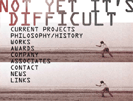
BLOWBACK
not yet it's difficult has a unique presence in Australia's contemporary performing arts culture as a research unit, a producer of industry development programs and a contemporary events maker.
Established in 1995, not yet it's difficult is an ideas-based group of artists who collaborate on the production of public performance events and cross-media projects under the artistic direction of david pledger. not yet it's difficult has produced original theatrical works through its Performance Series, public space projects, play productions, video-installation, new media, television, and, in association with other performance companies, workshop, forum, research and development programs. not yet it's difficult's philosophy is to make work cumulatively and collaboratively. Development practice links research and performance to presentation and analysis. not yet it's difficult's mission is to make critically engaged artworks of high artistic and discursive quality.
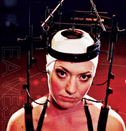
Current projects include: Eavesdrop, 2004, interactive cinema. David Pledger, Artistic Director of not yet it’s difficult and Jeffrey Shaw, world-renowned pioneer of interactive cinema, push the cinematic and the theatrical imaginary in this extraordinary new work. Part game, part real-time film-making, part spectator sport, part magical realism, Eavesdrop opens up the user and the viewer to new ways of looking at old forms, progressive pathways to interactivity and an alternative mode of visual discourse.
Blowback, 2004, theatre: BLOWBACK is an inter-disciplinary theatrical work crossing film, text and dance. Coined by America’s intelligence services, the term blowback describes the situation in which an agent of American foreign policy retracts their support. Using the body and video as double agents, BLOWBACK will be a kind of gestural, agit-prop, horror movie, part science fiction, part documentary, part absurdist metaphor. BLOWBACK will premiere at Memorial Hall, rear St Kilda Army & Navy Club, 88 Acland Street, St.Kilda, Melbourne on 27 November and 4 December 2004 (Previews November 25 and 26).
Posted by jo at 05:10 PM | Comments (0)
November 18, 2004
Digital Quilt
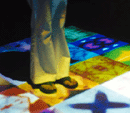
Present and Future Selves
Digital Quilt [silent], by Daniel Peltz, explores possibilities of intimacy within a large group. This installation is made of 414 digitally composed, abstract "self-portraits" projected onto a floor dusted with white chalk. A small camera functions as a sensor, tracking changes in the projected image. When someone steps on the quilt, s/he becomes a part of the image; the camera detects this "change" in the image and sends the information to the program. This data triggers the program to begin a transition from one layer of the quilt to the next.
The portraits are those of students who were asked to create two "self-portraits": one representing how they saw themselves in the present and the other how they saw themselves evolving in the future. Videos of the installation.
Digital Quilt is part of the Intimachine exhibition which presents artworks exploring intimacy, behavior and expectations through machine-mediated interactive experiences (among the work is Haptic Opposition that Max enjoyed so much at Transmediale). At Art Interactive, Cambridge, Mass. from Nov 20, 2004 through Jan 30, 2005.
Originally blogged by Regine at near near future.
Posted by jo at 10:43 AM | Comments (0)
November 11, 2004
David Rokeby
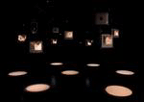
n-Cha(n)t
The title of David Rokeby's award-winning installation n-Cha(n)t is a pun on the verbs enchant, chat, chant, and on the mathematical symbol n, which signifies an unknown value. N-Cha(n)t shows how the power of the spoken word creates community, a sense of togetherness and belonging, and how that very system of sociability goes awry when interrupted by a strange voice. In this particular case the linguistic community consists of a set of cha(n)t(t)ing computers.
The visitor enters the space, where a number (n) of computers and monitors are suspended from the ceiling, intercommunicating (chanting) with each other. Every computer has its own voice, speaking grammatically correct English sentences. In addition, each entity is equipped with a highly focused microphone and voice recognition software. When a visitor speaks into one of the microphones, these words from the outside "distract" that system, stimulating a shift in that entity's 'state of mind'.
As a result, that individual (i.e. that particular computer) falls away from the chant. As it begins communicating this new input to its nearest neighbours, the community chanting loses its coherence, with the chanting veering towards a party-like chaos of voices. In the absence of further disruptions, the intercommunications reinforce the similarities and draw the community back to the chant.
The ears visible on the computer monitors show the state of receptivity of each system. When the system is ready to listen, a listening ear is shown on the screen. If the system hears a sound, it cups its ear to concentrate. When 'thinking', a finger is pressed into the ear. If the system feels over-stimulated, it covers its ear with a hand to indicate its unwillingness to listen. As a system processes speech, the incoming words are displayed in the ear on the monitor.
It is hard not to read the project through a political lens. The computers communicate and interact with each other, and seem to make up a perfectly closed and harmonious communal system. They could go on chanting forever, yet in comes the human visitor/intrudor and disturbs the voice of unison. However, this process is not an abrupt coup détat-style intervention, it is gradual and subtle and almost attributes viral qualities to language. By corollary, there is no instant gratification for the visitor. In this sense n-cha(n)t differs from most interactive pieces where immediate feedback is a marker of responsiveness. Here becoming intimate with the system is not so clear-cut; any community - whether machinic or human - has its defence mechanisms ready to fend off a threat to the consensus or status quo. Concurrently, every system in equilibrium holds the promise of becoming imbalanced by having its defences punctured.
Read an interview about this work at Audiohyperspace.
Posted by jo at 10:06 AM | Comments (0)
Bitmirror
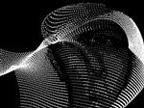
ASCII Shadows
When the visitor enters the Bitmirror space, she sees herself reflected on a big projection screen. A webcam and microphones register movement and sound in the space. A special ImageToASCII generator subsequently renders these data in ASCII form. According to algorithms derived from the laws of nature (gravity, wave motions), the graphic representation on the projection screen is animated into flowing images constructed from letters, digits and punctuation marks. The installation forms a graphic and acoustic shadow world in which abstract particles and signs swarm over the screen.
ASCII is one of the oldest and most elegant stylistic device in computer graphics. The letters stand for American Standard Code for Information Interchange. Computers can only understand numbers, so an ASCII code is the numerical representation of a character such as "v," "V" or "?" or an action of some sort. Seven bits are used for each ASCII character. Bitmirror uses ASCII to graphically represent facial expressions and physical interactions between people. The installation animates visitors' movements in abstract form and reproduces them in a sound synthesis.
Posted by jo at 10:02 AM
November 10, 2004
tejp

Personal Traces on Urban Spaces
tejp "explores various possibilities for overlaying personal traces and information on public spaces through different mediums and behavior patterns. it is our hope that {tejp} will transform spectators into players and encourage playful ways to personalize territory in the public realm. we also hope to connect local communities by providing a space and sounding board for existing social relationships. ['tejp' is swedish for 'tape' and is pronounced {tape}]."
{ tejp | : prototype 1 : audio tags : | glitch }
: principle : audio tags are left at hidden places in public spaces. personal messages that have been previously recorded are whispered to by-passers as they lean towards it. :description of prototype : small boxes covered by designed tejp stickers and fixed on wall and other structures in urban environment. contain a sampler microchip, a small microphone, a speaker membrane, a GP2D15 digital proximity sensor connected to a transistor, and a recording button. hacked gadget. low tech.
Posted by jo at 10:50 AM | Comments (0)
November 09, 2004
Messa di voce

Can't stop the fun with those walls
At this year's Ars Electronica, I tested the amazing Messa di voce by Golan Levin, Zach Lieberman, Jaap Blonk and Joan La Barbara.
A computer equipped with a video camera tracks the position of visitors’ heads and analyzes the sounds they make. As a reaction to it, various graphic compositions are projected onto a screen. With the help of a tracking system, these visualizations can be shown in a way that makes them seem to be emanating from the mouths of the people themselves. (via inspired by angermann)
More recently, I heard about two other creations that allow people to play with walls:
Greg Roberts' PlayMotion! combines computer vision algorithms and videogame graphics techniques to turn ordinary walls, floors, and ceilings into virtual playgrounds.
Thanks to Bill Read for the tip.

Bloomberg ICE space in Tokyo observes the visitors and continually computes its appearance in accordance with their behaviour. In stand-by mode, the icicle displays columns of numbers. Depending on the current share prices, they expand on the LED display or they shrink and disappear altogether.
But when a visitor approaches the glass wall, infrared sensors detect her/his presence and ask her/him to participate. The columns of numbers begin to flutter and fluctuate; a menu appears and offers various games - electronic volleyball, a wave generator or a digital harp, for example. The icicle can be used to play music synesthetically in that the sounds played are replicated on it in the form of brightly lit, colorful tree branches.
Posted by jo at 01:08 PM | Comments (0)
November 08, 2004
Run Motherfucker Run

Action Art
Run Motherfucker Run is a trip through nocturnal Rotterdam in installation form. The visitor's running rhythm determines the speed of the treadmill, and this drives up the speed of the pictures. After every film fragment, one can choose between two more short films by turning left or right. In Run Motherfucker Run one is seized by an oppressive feeling. Running through the deserted nocturnal panoramas, one has the feeling one is being chased. While one thinks one has a certain control over one's running speed and the selection of the images, one ultimately realizes that one is being controlled by the machine.
Through an opening in the projection screen, a laser scanner determines the runner's position relative to the screen. When the runner changes position, the speed of the treadmill and the pictures is adapted. For example, if one runs faster, one moves further forward, and this is immediately registered by the computer. A signal is then sent to the treadmill to go faster, and to the pictures to move in faster succession. The sensor can also distinguish whether someone is walking to the left or right within the field of the treadmill. There are two beamers that project a life-sized picture in which the user is incorporated into the stream of images of streets, metro stations, roadways and railway tracks.
Marnix de Nijs demands the audience get involved in his art. Passively standing to the side is not an option in his interactive installations. In particular, he seeks to examine the power relations between humans and machines. De Nijs says, "I'm only offering the steering and the control to the audience to make them more involved, to let them ultimately find out that there is nothing else possible except what the machine dictates, thus actually what I want." The loss of control is something which is experienced as threatening. A feeling of fear is involved in many of De Nijs's installations, increasing the feeling in viewers that they have lost control of the situation.
Credits:
In collaboration with Reinier van Brummelen, Noud Heerkens and Boris Debackere
Co-production: Productiehuis Rotterdam/Rotterdamse Schouwburg, V2_Lab, ZKM
Posted by jo at 12:06 PM | Comments (0)
November 07, 2004
Sensing Space

sponge at V2 DEAF Rotterdam, 9-20 November 2004
Membrane is a set of large translucent screens suspended throughout DEAF04's Van Nelle exhibition hall. Approaching a Membrane, passersby see people on the opposite side re-projected onto the translucent material. A sweep of the hand reshapes, swirls, thickens and thins what one sees through the membrane via dynamics of water, smoke, shockwaves or particles. The system's visual and acoustic responses evolve according to the activity of the visitors with the passage of time. The interplay between the Membrane's calligraphic media and the visitors' moving bodies generates vortices that entangle the Van Nelle factory site's present visitors and past ghosts.
Posted by michelle at 07:06 PM | Comments (0)
November 01, 2004
audio shaker
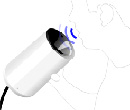
Sound Martinis
The audio shaker --by Tom Jenkins with Mark Hauenstein--explores our perceptual understanding of sound. Anything sung, spoken, clapped, whistled or played near it is trapped inside, where it takes on an imagined yet tangible physicality. Sounds caught in this void are transformed, given weight and permanance, reacting directly to the shaker's movements, subtle or violent. Shaken sounds have to settle down before becoming still and silent, behaving more like fluid than transient energy.
The linear timescale of sound is broken, a conversation is split into words and mixed up in the shaker, and can be poured out separately, tipped out in a simultaneous splash or added to and shaken up further. Put simply, it is a tactile container to capture, shake up and pour out sounds. Creating a rich, intuitive experience that is purposefully open to interpretation and imagination. Quicktime video.
Via near near future
Posted by jo at 11:07 AM | Comments (1)
October 30, 2004
Greyworld

"first aid for urban spaces"
Andrem Shoban founded Greyworld in 1993 in Paris, then 2 years later they went back to London where they still have their studio. They do interactive urban art for the "people who buy cans of beans," not for the elite. Their installations try to involve the public as much as possible. In 2002, they created the ColourStops installation for five bus stops in Bradford, UK: in the bus stop shelters, Greyworld concealed color-recognition cameras that create sounds according to the colours they detect. The work tries to reflect back the variety of differences in people, Bradford being a very multi-ethnic city.
Three years ago, on the Millennium Footbridge in Dublin, they inserted sensors in the carpet covering the bridge to detect the size of feet, and the speed of your walk; according to these data, different sounds are generated so that you can walk to the sound of music or hear the sound of crunchy leaves or snow or the flop flop of water.
See also The Source that opens and closes the London Stock Exchange since April 2004.
The group is now working on Bins and Benches (flash presentation) to be installed in The Junction (London). This urban furniture is able to roam free in the Piazza area.
The benches love to be sat on, and they often take up position in new spaces to make themselves more attractive to potential human sitters. Sometimes, when it rains, they move themselves to drier, shadier areas of the square. To attract potential human sitting folk, they like to form patterns - the benches moving in to shapes in the centre of the piazza.
The bins are a little more solitary. It's a tough life being a bin, and they like to contemplate their humble lot on their own.
When the mood takes them, the surniture like to burst in to song. Sometimes, small clusters gather together and sing a tight six-part harmony, and occasionally, though much more rarely due to their shyness, the bins join in with their sweet soprano voices.
Each bench drifts slowly around the square, no faster than a strolling human, and is equipped with sensors that detect the presence of objects in its immediate vicinity, coming to a complete halt when any object is coming close. Via near near future
Posted by jo at 11:47 AM | Comments (2)
October 26, 2004
Ken Feingold

The Interactive Art Gambit
"Going back even farther in time, looking for cultural formations which are now familiar aspects of interactive art, I was struck early on by the essentially interactive nature of shrines, and other somehow consecrated public places. What differs here from the contemporary interactive artwork which relies on, as Crichton said, temptations and sources of curiosity--here the encounter is ritualized and made into theater. It is performative, highly prescribed and passed on from generation to generation. In the ritualized encounter, there is quite often an actual physical exchange which is also a symbolic exchange. One leaves something, in a certain way, and takes something away--usually as a mark upon the body. It is generally performed by simultaneous actions of touching and looking, but here, very importantly, and in most cases completely absent in interactive art, the voice of the participant plays an important role."
Read "The Interactive Art Gambit" ("Do not run! We are your friends!") by Ken Feingold, Technology in the 90s presentation, The Museum of Modern Art, NY, April 7, 1997.
Also from Ken Feingold's web site:
The History of the Interface in Interactive Art, Söke Dinkla, 1994
Seeking Deeper Contact: Interactive Art as Metacommentary, Erkki Huhtamo
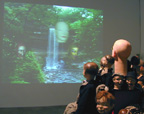
Self Portrait as the Center of the Universe takes up and extends the themes of Séance Box No. 1 (1998-99). The self-portrait animatronic head has open-ended, improvisational conversations with its alter ego, a virtual head that appears as the central figure in the projection. Like If/Then, the conversations between these two figures do not include the audience; rather, they interact only with each other. Their conversations are generated in real time, utilizing speech recognition, natural language processing, conversation/ personality algorithms, and text-to-speech software. The physical side of the conversation is performed by an animatronic figure (a speaking silicone cast of my head) and the central subjects of their conversations revolve around, on one side - generalization and distance; and on the other - questions and memories of himself. These conversations, bridging real and virtual spaces, are within video-like digital scenes that recompose themselves based on the nature of the conversation between the two main characters. The subject of the conversation, as determined by the artificial actor, controls the landscape which is seen, so these change as the conversations go along, and other figures appear and disappear. The scenes are also populated by figures - autonomous "software agents" in the form of realtime 3d computer animation - which appear in the projected image-world that fills his vision.
Posted by jo at 08:51 AM | Comments (0)
October 21, 2004
Come Closer

The Edges of Personal Space
Continuing squidsoup’s explorations into immersive intuitive media and the boundaries between virtual and physical space, Come Closer uses wearable technology, wireless networking and stereo vision to explore and expand on our sense of personal space and proximity to others. The closer two people get to each other, the more acutely aware of each other’s presence they become. This sensation may be comforting or disquieting, but participants are encouraged to transcend the normal barriers of personal space and explore the meaning of closeness in both virtual and physical terms. The space between people is filled with sound that is affected by their movement and position. With more people in a room, complex harmonies begin to appear and disappear, allowing scope for cooperation and confrontation, intimacy and rejection.
Posted by jo at 05:45 PM | Comments (0)
October 19, 2004
step inside
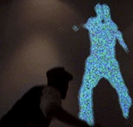
I swing, therefore I am
step inside, by Nathaniel Stern, is an immersive, multi-sensory environment that provokes us to re-think our selves as "collage[s] in motion," and challenges Cartesian notions of consciousness. step inside implies multiplicity and movement as intrinsic to our being; it asks viewers to explore the noise and stillness attendant on the performance of self. "I swing, therefore I am" (Elizabeth Ermarth, Sequel to History).
When 'stepping inside' the 3 x 3 x 3 meter interaction space, viewer-participants are immediately confronted with an amplified and echoed trail of noise. This, they'll soon discover, is the sound of each footstep they take, of all the footwork in the room. A video camera, opposite them and connected to the step inside software, reads their bodies, and separates them out from the background. However, instead of a video mirror, they see only a profile, and are disallowed a frontal reflection. This left-hand 'projection' fills their 2-D forms with white noise. The amplitude of the echoed footsteps controls the video's opacity. The 'result' becomes a variable wave of embodied noise. step inside is part of Stern's non-aggressive narrative.
Posted by jo at 10:44 AM
October 15, 2004
Love One Day

Time, Space, Love
'love one day' was a real one-off action through time and space, presented live online and later as a cinematic video installation. Two people from two distant parts of the UK started a long journey to London. They met in a hotel bedroom and within 24 hours of starting their journey, they left. 'love one day' explored the communication between two people whose anticipation of love was heightened by the unique circumstances of their journey. It documented the emotions, thoughts, observations and behaviour of two 'matched' individuals as they traveled towards each other and met one day. 'love one day' investigated psychological motivations, how we communicate and interact with others and how we are affected by our environment, space and time.
A unique 'love one day' dating website was created. This allowed people to submit their personal profile and browse/chat amongst other candidates looking for the perfect match during one month. The website took on a similar format to that used by online dating agencies with specific questions designed to recruit two protagonists for a journey to meet in London. 'love one day' was publicised and promoted through online listings, press and 'satellite venues' (public spaces and institutions supporting the project) as well as the website's established visitors and target audience.
Two people from a selection of 'matched' couples via the 'dating website', were interviewed and chosen to become the main protagonists of this experience. People prepared to accept the role of protagonist by embarking on an emotional and physical journey to meet someone they have never met in a hotel bedroom were sought. They were chosen on the basis that they made a good love match.
The two selected protagonists were each given a mobile phone to continue their communication by phone, in text and images so they could get to know one each other a little more before their journey started. No direct contact was allowed until they met for the first time in the hotel during filming. The entire journey was filmed and the telecommunications were documented live on the love one day website. The protagonists later met with a relationship psychologist to feedback about their experience.
'love one day' is a project of completely naked.
Posted by jo at 01:01 AM | Comments (0)
October 14, 2004
iCinema

Immersive and Interactive Narrative
The iCinema Centre for Interactive Cinema Research, established in 2001, is a joint venture of the College of Fine Arts and the School of Computer Science and Engineering at the University of New South Wales, Sydney. It brings together researchers and postgraduate students in new media, digital cinema, digital aesthetics, film theory, multimedia design, computer science, artificial intelligence and software/hardware engineering.
The iCinema research program focuses on the research and development of a digitally expanded cinema. This includes all forms of the moving image, made visible on any type of screen or in any sort of immersive environment, whose structure is constituted by various methods of narrative coherence. The project is directed by Jeffrey Shaw and Dennis Del Favero.
The Centre has four principal research domains:
Immersive Visualization Systems: The exploration of immersive environments which provide for the collection, integration and display of visual, audio and kinesthetic data.
Distributed Interface Systems: The integration of interface systems with the experience of distributed spatial visualization environments.
Interactive Narrative Systems: The exploration of interactive narrative systems which provide the viewer with the ability to select and edit interaction with a set of visual narrative streams.
Theories of Interactive Digital Narrative Systems: The inquiry into theories of narrative and the organization of units of meaning and experience within the digital domain.
Posted by jo at 12:55 PM | Comments (0)
October 10, 2004
The (in)security Camera
![insecurity_image[1].gif](http://www.turbulence.org/blog/images/insecurity_image[1].gif)
Watching Me Watching You
The (in)security camera is an installation created last year by Benjamin Chang, Silvia Ruzanka and Dmitry Strakovsky. The robotic surveillance camera relies on an advanced computer-vision software to track, zoom, and follow subjects walking through its field of view. Deploying sophisticated AI algorithms used by the security forces, it can assess threat levels in real time and respond accordingly.
However, the camera is, in fact, a little insecure. Easily startled by sudden movements, it is shy around strangers and tends to avoid direct eye contact. This reversal of the relationship between the surveillance system and its subjects gives the machine an element of human personality and fallibility that is by turns endearing, tragic, and slightly disturbing.
Originally from Linkfilter; reblogged by Regine at near near future
Posted by jo at 06:36 PM | Comments (0)
October 09, 2004
Distance Focale (Focal Distance)

Making the Virtual Real
Focal Distance is a performance cycle device where users are invited to move avatars on a grid. These actions are reproduced in a physical space by a human operator moving objects on a table. Global input provided by participants is considered a material feeding sub-device that produces various media streams. There is an ongoing discussion (in english) about this concept and some resources (images + texts mostly in french) at www.x-arn.org.
Posted by jo at 01:41 PM | Comments (0)
Warehouse Operation - v.beta.

Actions Reseaux Numeriques
Combining human and technical possibilities, the hypermedia project Warehouse Operation (GDS) by Actions Reseaux Numeriques focused on building a warehouse of various objects and materials. The technical and human possibilities, consisting of a link to a website and a warehouse established in a concrete physical space, provided the opportunity to 'enter the warehouse--with the help of the link--and see the objects it contained.
The communication mechanism was based on the circulation of commands and responses between the users and operators. Users communicated with operators--who were physically located in the warehouse--on the internet. Users sent in their orders and the operators performed responses, thereby transforming the link.
The process consisted of a sequence of specific actions, whose beginning and order the user indicates to the operator in the warehouse:
* selecting objects and taking them out of the warehouse
* transferring them to a separate zone and creating an identification document
* exhibiting and general identification
* placing them back to the warehouse.
In a separate zone a document representing the object, generally accessible with the help of the link, is presented. Any user can attribute to the observed object a meaning that he considers the most appropriate, or can present rational or imagination-based assessments and in this way create the general memory of the warehouse objects.
In this way a link between the digital and physical reality is established. The developing relation between these two forms of being makes one to take a new look at the mutual relations of humans/machines and the perception of the net-generated reality.
# Laurent Neyssensas: implementation of the project
# Yann Le Guennec: modelling/programming
# Sylvie Bourguet: project manager responsible for the conception
For more info on this project, see http://www.x-arn.org/y/wakka.php?wiki=GestionDesStocks (in French).
Posted by jo at 01:21 PM | Comments (0)
October 06, 2004
Untitled 2002 (he promised)
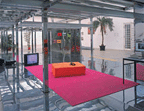
Permeability of Domestic Space
Rirkrit Tiravanija's Untitled 2002 (he promised), is a platform for improvisation and interaction. Rendered in highly reflective stainless steel and chrome, its structure was inspired by R. M. Schindler's residence in West Hollywood (1921–22), which exemplifies the architect's interest in the permeability of domestic space and how it is enlivened by its surrounding context. First exhibited at the Vienna Secession for a period of two months (July 1–September 5, 2002), this large-scale installation was conceived as an arena, a nexus for a series of artistic, public, and private activities—effectively blurring the boundaries that customarily separate them. From the barbecue on opening night to Thai massages, DJ sessions, film programs, and panel discussions, Untitled 2002 (he promised) embodied the experiential nature of Tiravanija's art, which requires the active participation of the viewer in order to be fully realized. Tiravanija is a catalyst and a gracious host, inviting the public to enter into and literally engage with his work. He provides the parameters but never dictates the outcome. The extended run of the show in Vienna allowed the work to become a central, albeit temporary, part of the community, where the ebb and flow of the social could occur. Art and life intersected in a milieu of pleasure and provocation. Four days at the Guggenheim: October 8-11, 2004.
Posted by jo at 03:16 PM | Comments (0)
September 26, 2004
(T)ERROR
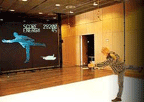
Full Body Engagement
Whom would you like to play to get the world back into right shape? George W. Bush, Osama Bin Laden, or rather Tony Blair? Starting the computer game (T)ERROR, the player is spoilt for choice. A camera tracks the player’s movements and a projector throws the players outlines in original size on a white wall in front of him, all in realtime. When the player kicks, his shadow will kick. When the player ducks or jumps to avoid bumping into an enemy jet, his shadowy avatar will do exactly the same in real time. Watch videos.
Posted by jo at 03:20 PM | Comments (0)
September 20, 2004
Two Works by Zachary Booth Simpson
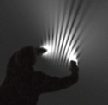
Mine-Control
"(O)ur goal is to use our experience in game development to explore the art of interactivity in contexts other than traditional video games. Our works are both immersive and highly interactive - converting viewers into participants."
Interference: As participants place their hands on the canvas, light emanates in the direction their hand is facing. When a second hand is placed, the light beams interfere with one another creating brilliant and beautiful interference patterns. The simulation is actually an accurate scientific visualization of radio-frequency interferometry, and by the time one has played with it for a few minutes one can't help but intuit the meaning and beauty of Euler's equation even if one has never heard of it! [Download video]
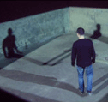 Shadow with Adam Frank, Eyebeam Artists in Residence, New York: A disembodied shadow wanders around alone in a corner. When the participant enters, the figure reacts by running away. Aggressively chasing the figure leads only to his fear and escape. When the participants stay still the figure gains trust and steps closer, finally engaging in an embrace. [Download video]
Shadow with Adam Frank, Eyebeam Artists in Residence, New York: A disembodied shadow wanders around alone in a corner. When the participant enters, the figure reacts by running away. Aggressively chasing the figure leads only to his fear and escape. When the participants stay still the figure gains trust and steps closer, finally engaging in an embrace. [Download video]
Posted by jo at 12:03 PM | Comments (0)
September 19, 2004
Hubbub
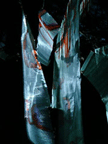
Speech-painting public places
Hubbub is an investigation of how accidental and non-accidental conversations can by catalyzed in urban spaces by means of speech projected onto public surfaces. Hubbub installations may be built into a bench, in a bus stop, a bar, a cafe, a school courtyard, a plaza, a park. As you walk by a Hubbub installation, some of the words you speak will dance in projection across the surfaces according to the energy and prosody of your voice. Read PDF>>
Posted by jo at 07:49 AM | Comments (0)
September 18, 2004
The web is a living organism project
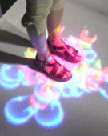
symbiotic relationships
the web is a living organsim project is a net.art installation in both hyper and physical space. It is trying to examine the relationship between internet users, information and the internet itself in the same way we look at the relationship between blood cells, Oxygen and the body itself. By this equation comes a great opportunity of discovering a new model for politics- based on the idea of Symbiotic Relationships. The interactive composition is an examination of microscopic activity inside an internet tissue.
The participants/users are invited to take part in the installation's game system. [1] Each participant/user types in a search string he would like to discuss. [2] When stepping into the interactive stage, he is joined by a microbe. The microbe is a digitally-crafted animated avatar based on the aesthetics of microbiology. Each microbe projects a unique sound and has a unique style of movement. The microbe is powered by a search engine (at this stage we have integrated Google, Altavista and Lycos). [3] In physical space, the interactive stage serves as a screen for a projector that beams from its top. The Microbe is projected upon the user and follows his movements. The search string is projected on the floor right after being submitted. [4] Stepping on text on the floor with the microbe sends the text to the microbe's search engine and returns the title of the first search result. The new text replaces the old ones and become new triggers for a search. The composition creates a conversation between users using search engines combined with a live interactive music score. [5] The work will be available online (controlled by the users mouse&keyboard) constantly like any other net art work but will reach it's full potential in the form of realspace installation that interacts both online users, activating their microbes through the use of the mouse, and physical participants, moving their microbes by the movement of their bodies.
[see online interactive demo for a better grasp of the composition]
The project deals with issues within the discourse of net-ethics, but tries to use the artistic method to create an experience which is theoretically challenging on one hand and pure fun on the other. It is using a physical computed tracking system conjunct with live internet search-engine activity, interactive visuals and sounds and a game system to deliver the concept.
Posted by jo at 08:00 AM
Re:action
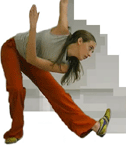
questions of authorship
Re:action is a website and audio visual installation which uses contemporary dance to infuse new media art with the qualities of performance. What first appears to be a dance film in a continuous loop, over time shifts and changes. Unlike a conventional film, the scenes that make up Re:action are not always shown in the same order or from the same viewpoints. Re:action is being re-edited as the viewer watches. However, this re-editing process is controlled not by the artists but by the active participation of the website audience. Simultaneously, the spatial soundscape overlaps in constantly different ways as the viewer moves through the exhibition.
Each journey through the website is recorded and then fed through to the installation, resulting in an outcome which exists only in the moment. The work is constantly remade as each new website user interacts with it in a different way. The control the artists have over the outcome is diminished, emphasising the questions of authorship that arise through collaboration, by extending the collaboration to include the audience.
Re:action is a collaboration between Ed Holroyd, interdisciplinary arts company Eshoda Arts, and filmmakers from Suited and Booted Studios.
Posted by jo at 07:49 AM | Comments (0)
September 16, 2004
Extensions Online Journal

for Embodied Technology
The editors of Extensions: The Online Journal for Embodied Technology are pleased to announce the launch of Volume One. Included are six provocative essays by authors concerned with the many new points of contact between our bodies, digital technologies, and aesthetics; and six artworks engaging themes of memory, identity, perception, and performance.
EXTENSIONS is produced by the UCLA Dance and New Media Project. The Project brings together graduate students and faculty from the departments of World Arts and Cultures, Design Media Arts, and Film/TV to explore new intersections between dance and emerging technologies and how virtual space affects our sense of the body, place, culture, and collaboration. Founded in 2002 by Norah Zuniga Shaw, the Dance and New Media Project produces EXTENSIONS and presents annual dance on camera screenings for new work by UCLA students and faculty.
Posted by jo at 09:46 AM | Comments (0)
September 15, 2004
Water Gongs-performance art bot
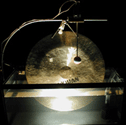
Waterways as Networks
the water gong bot, by David Birchfield is a dynamic, autonomous, robotic installation that is comprised of a network of seven water gongs that resonante at fluctuating pitches as the water levels rise and fall. As the gongs resonante, the surface of the water in the tanks ripple; and as the solenoid actuators alter their pulse rates, and the illuminating lamps dim and rise, the visual ripples and shadows change intensity and character.
The rise and fall of water in each water gong tank references tidal cycles. Water serves as the means of communication between nodes in the network, and this anachronistic method references the use of waterways as the traditional vehicle for communication and transportation. The network of water gongs also share a limited resource of water, and its constantly shifting allocation between the members of the system models the shifts of natural, cultural, and intellectual resources throughout the networks of our local and global communities. The sonic and visual aspects of the piece represent the states and shifts of the network as it passes through moments of stability and instability.
Posted by jo at 08:05 AM | Comments (0)
September 07, 2004
Weather Report
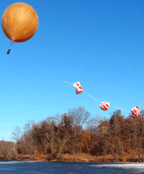
Drifting Voicemail, Found Sounds Stories
"A simple but clever installation in Tallinn, "Weather Report" by Janek Schaeffer, consisted of helium balloons and an MP3 player/cell phone. Recordings gathered by starting a cell phone call and then sending the phone up into the atmosphere attached to a weather balloon while recording the call on voicemail are remixed with other weather noises, to be played back on the cell phone in the installation." from ISEA 2004: Art Report by scott @ 10:10 pm, 09.05.04.
From Schaeffer's web site: "The weather balloons were used in 3 main ways. Firstly one icy winters morning I attached a mobile phone to receive and send low resolution sound, letting it float away from the surface of a frozen lake. Secondly using a digitaldictaphone I made time lapse recordings of the sky by floating it 500ft above my lush metropolitan neighbourhood. Lastly a few all American friends and I set out to shootthe balloon down late one June afternoon leaving the sound to parachute back to earth. I let the recordings speak for themselves, no effects, no eq, just straight cut & splice collage where you can hear the edges of time. Some other sounds collected include: underwater ice skaters; flapping; old meteorological kit; leaf blowers; repairing weather damage; various 60's archive audio; melting ice, ski across snow, Minnesota forecasts on radio, in the car and on TV; Tornado chasing & test equipment; snow flakes landing on mic; squeaky tree; National Weather Service balloon launch; walkie talkie tones from my Science Museum workshop etc. Oh, and all temperatures in Farenheight...
The result is a highly compressed Found Sound story, heard as a drifting voicemail message from the weather balloon. A hybrid documentary collected and edited outdoors, where it is designed to be heard walking with headphones... so.. go find a Walkman!"
Posted by jo at 10:25 AM | Comments (1)
September 05, 2004
Work by Usman Haque
Usman Haque designs interactive architecture systems and researches how people relate to each other and their spaces. "The domain of architecture has been transformed by developments in interaction research, wearable computing, mobile connectivity, people-centered design, contextual awareness, RFID systems and ubiquitous computing. These technologies alter our understanding of space and change the way we relate to each other. We no longer think of architecture as static and immutable; instead we see it as dynamic, responsive and conversant. Our projects explore some of this territory." Performative works include:
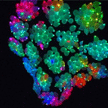 Sky Ear, 2004: This non-rigid "cloud", made up of several hundred glowing helium balloons will be embedded with mobile phones. As visitors to the event call into the cloud to listen to the distant electromagnetic sounds of the sky (including whistlers and spherics), their mobile phone calls will change the local hertzian topography; these disturbances in the electromagnetic fields inside the cloud will alter the glow intensity of that part of the balloon cloud. Quicktime video: 19 MB
Sky Ear, 2004: This non-rigid "cloud", made up of several hundred glowing helium balloons will be embedded with mobile phones. As visitors to the event call into the cloud to listen to the distant electromagnetic sounds of the sky (including whistlers and spherics), their mobile phone calls will change the local hertzian topography; these disturbances in the electromagnetic fields inside the cloud will alter the glow intensity of that part of the balloon cloud. Quicktime video: 19 MB
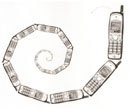 Japanese Whispers, Tokyo (2000): Similar to the children's game known as "Chinese Whispers" or "The Telephone Game," this project looks at how a message is changed by being passed from one mechanism to another--in this case the cellphone.
Japanese Whispers, Tokyo (2000): Similar to the children's game known as "Chinese Whispers" or "The Telephone Game," this project looks at how a message is changed by being passed from one mechanism to another--in this case the cellphone.
Cellphones are laid in a circle and calls are initiated from one phone to another in a variety of patterns with differing results. The sound degrades at each step as it is transformed from analog to digital and back again, emphasising the circular nature of communication. The iterative process of the feedback loop amplifies miscommunications inherent in the transmitting of information. Quicktime video: 9.2 MB
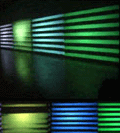 Infinitum Ad Nauseam, Tokyo (2000): The project is a video/audio performance installation which requires the explicit participation of the audience. Essentially, the system uses video and audio feedback to create sounds (from images and movements) and images (from sounds and movements). 4 video cameras, 4 video projectors, 2 video mixers and an audio mixer are used to initiate a massive feedback loop of video-video, video-audio, audio-video and audio to audio. This creates dynamic real-time images and sounds in "conversation" with the visitors or performers. There are no pre-recorded images and no computerised images used in the installation. Videos>>
Infinitum Ad Nauseam, Tokyo (2000): The project is a video/audio performance installation which requires the explicit participation of the audience. Essentially, the system uses video and audio feedback to create sounds (from images and movements) and images (from sounds and movements). 4 video cameras, 4 video projectors, 2 video mixers and an audio mixer are used to initiate a massive feedback loop of video-video, video-audio, audio-video and audio to audio. This creates dynamic real-time images and sounds in "conversation" with the visitors or performers. There are no pre-recorded images and no computerised images used in the installation. Videos>>
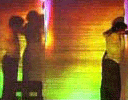 Changing Faces of Gesture, Tokyo (2000) with Charlotte Boye-Christensen (Choreographer/Dancer): The performance consists of one person and 2 to 4 large video projections. Using a simple video feedback system (where a video camera is pointed towards the screen upon which its image is being projected) coupled with an audio feedback system, complex images are created in realtime which are manipulated by the performer's movements. Images created resemble reflections in a puddle; these can be coloured using filters on both the cameras and the video-projectors. Furthermore each projector can be separately controlled to multiply the effects and simulate everything from a solitary dancing figure to a bustling crowd of people. Videos>>
Changing Faces of Gesture, Tokyo (2000) with Charlotte Boye-Christensen (Choreographer/Dancer): The performance consists of one person and 2 to 4 large video projections. Using a simple video feedback system (where a video camera is pointed towards the screen upon which its image is being projected) coupled with an audio feedback system, complex images are created in realtime which are manipulated by the performer's movements. Images created resemble reflections in a puddle; these can be coloured using filters on both the cameras and the video-projectors. Furthermore each projector can be separately controlled to multiply the effects and simulate everything from a solitary dancing figure to a bustling crowd of people. Videos>>
Posted by jo at 11:42 AM | Comments (2)
September 04, 2004
Work by Don Ritter
Physical Aesthetics
"Unlike art from previous times, interactive art considers the viewer’s body as an integral component of the experience; the quality of this experience is measured by the term physical aesthetics, being the pleasantness or unpleasantness of the physical experience involved with the control of an interactive experience. The involvement of a viewer in an artwork could be viewed as being more democratic than the autocratic experiences presented by older art forms." Read the full interview.
![]()
Vox Populi endows anyone with leadership, regardless of their personal wealth, family origins, or political connections. A video projected crowd chants "speech, speech" and encourages visitors to speak from a lectern. When a visitor speaks through the microphone, the voice is amplified and political speeches begin scrolling on a teleprompter located within the lectern. In response to a speaker’s voice, the crowd reacts with varying degrees of support and repulsion.
Other works by Don Ritter (Real movies available on site):
The Technophobe and the Madman: Internet-2 distributed musical
telecommunications video-music performance, 2001; 12 channels audio and 6 channels full screen video connection between Frederick Loewe Theatre, New York City and iEAR Studio, Troy, New York; collaborative performance: performers share audio and video between 2 cities.
Performance Telematique: Interactive telecommunications performance between two cities, 1993; PictureTel system, two channels full screen video and two channels audio Obscure, Quebec City, and McLuhan Program, University of Toronto, Canada (500 miles, 800 km).
Nervous Orpheus: Interactive telecommunications performance between two cities, 1994; PictureTel system, two channels full screen video and two channels audio; Vancouver and Toronto, Canada (2800 miles, 4500 km).
Posted by jo at 11:34 AM | Comments (0)
September 03, 2004
oldies but goodies
Three from 1995
Thanks to Katherine Moriwaki for personaldebris… for all of life’s detritus and the documentation that leads back to the wonderful 1995 exhibition at Galerie La Centrale, Montréal, Québec. Canadian artists, by the way, have played a major role in networked art from very early on. I’ll be mentioning a number of them in my hopefully upcoming and definitely idiosyncratic history.
The Galerie La Centrale, Montréal show included works by Barbara Layne and Ingrid Bachmann, David Rokeby, and Paul Sermon.
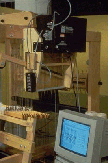
Fault Lines (1995) by Barbara Layne and Ingrid Bachmann, was described in Katherine’s blog. It was a work in which computer-assisted looms were programmed to translate recorded daily seismographic information between two locales: Montreal and Santa Monica, CA. Increments of cloth were then woven each day by individual handweavers at each of the sites. The tectonic movements of the earth were thus recorded through one of the earliest and one of the most recent technologies.
Very Nervous System (1986-1990) by David Rokeby was a non-visual interactive sound installation that made use of video cameras, image processors, computers, synthesizers and a sound system to create a space in which the movements of one’s body created sound/music. Upon entering a room, the viewer became aware that his/her simple displacement of air caused a reaction of sound within the environment., altering the otherwise seemingly empty site. As Wired said of this work: "David Rokeby's Very Nervous System does a number of things. But mostly it does this: it watches you. This piece of art tracks the slightest movement of the human body. Rokeby wires up a space the size of a dance floor, and whatever moves through it is sucked into the artwork. Very Nervous System makes something out of you. It turns you into a symphony. Or a jazz song. Or a samba."

And Paul Sermon's Telematic Dreaming (1992) - we described in an earlier blog. But here it is again. A bed was set up within the gallery space onto which an image of a person in another bed was projected in real-time. The viewer was then able to interact with this telepresence producing what one reviewer called “an uncanny exchange.”
The basic technical system consisted of a camera situated above a queen-size bed. The camera received an overhead view of the bed. The image of the bed and someone lying on it, was sent via ISDN lines and teleconferencing systems to a video projector situated above another bed in a geographically distant location. The live image was projected down on to the bed, and with it the live, life-size image of the person. Another video camera situated next to the video projector sent an image of the projection and the second person lying on the bed under the projection, back to the first bed.
You can google all three works for more information. What strikes me at the moment is that while they are all “installations” and exhibited in a gallery, they are also “performances” and either involve performers (handweavers in Fault Lines) or audience members who do something (perform) to create the work. And that all three deal with the physical or material and the virtual, challenging the notion, prevalent at the time (remember William Gibson?), that these two realms were separate.
Posted by newradio at 10:17 AM | Comments (0)
August 02, 2004
Mesh Performance Practices
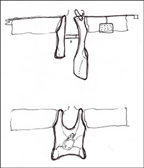
Exiles, Ghosts and Astronauts Physical interventions in the critique of virtual culture
Aura: Film Studies Journal, Volume IV, Issue 1, 1998, Susan Kozel
Exiles, Ghosts and Astronauts was a performance experiment occurring simultaneously between Riverside Studios and The Place Theatre in London (England). The videoconference link was made by Macintosh computers and basic internet videoconferencing software (CU-SeeMe). Performers in each location were projected into the other for a physical exploration of intimacy, weightlessness and altered materiality. It was part of Digital Dancing 1997, the London Dance Umbrella platform for dance and technology collaboration.
As physical exploration is undertaken, with telepresence and other forms of digital intervention in performance, the physical and philosophical vocabularies that emerge are mutually shaped and critical of one another. This article charts a course through philosophical debate and performance practice. Many voices and perspectives unfold across three sections: dialogue with Paul Virilio, devising process, and performance.
Continue reading at Mesh Performance Practices
whisper is a real-time interactive media installation based on small wearable devices, wireless computer communication, and handheld technologies embedded in evocative and playful garments worn by the participants. whisper intervenes aesthetically and critically in the evolution of our human environment by transforming the physical practices and technological interfaces that mediate our physical and emotional interchange. whisper is about creating new physical, technological, kinesthetic & affective vocabularies. whisper is a collaborative project involving artists (dance, sculpture, music), designers (of visuals, objects & textiles), computer scientists, and hardware/software engineers.
Posted by jo at 03:14 PM | Comments (0)
Agora Phobia (digitalis)
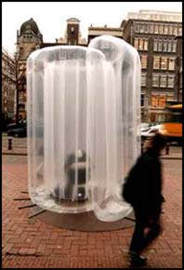
Agora Phobia (digitalis)
by Karen Lancel
Eyebeam presented the U.S. premiere of Agora Phobia (digitalis), a physical and online art project that questions mental images of being (un)safe and isolated. The physical component was installed on the street in front of Eyebeam's Chelsea facility in 2000. Created by Dutch artist Karen Lancel, Agora Phobia Digitalis invites the audience into a semi-transparent, inflatable Isolation Pillar which contains an online computer. Only large enough for one person to enter at a time, participants can feel the crowd outside but can only vaguely see shapes and figures around them. Inside one feels very safe within an intimate space, and at the same time, lacking contact with the outside. Viewers inside the pillar may participate in an internet-dialogue with people living in isolation elsewhere: a prisoner, a nun, a digipersona, a prisoner of war (POW), someone suffering from agoraphobia. The resulting dialogue is published on www.agora-phobia-digitalis.org and is part of an archive of chatsheets, performances, and installations. Agora Phobia Digitalis examines fluctuating notions of security in private and public spaces both physical and virtual.
Posted by michelle at 12:16 PM | Comments (0)
July 31, 2004
More Distributed Cinema
Lev Manovich's Soft Cinema
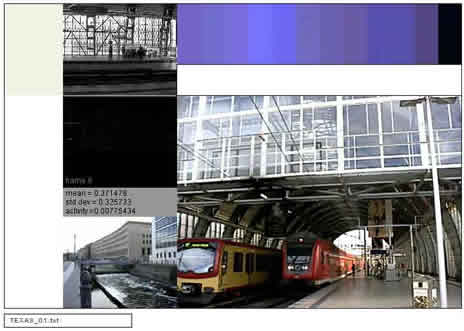
Soft(ware) Cinema is a dynamic computer-driven media installation. The viewers are presented with an infinite series of narrative films constructed on the fly by the custom software. Using the systems of rules defined by the author, the software decides what appears on the screen, where, and in which sequence; it also chooses music tracks. The elements are chosen from a media database which at present contains 4 hours of video and animation, 3 hours of voice over narration, and 5 hours of music.
Affective
Cinema
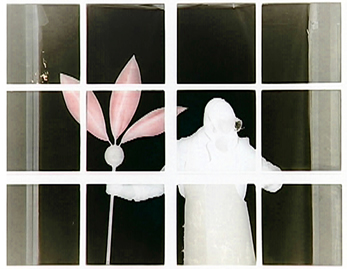
Affective Cinema is an interactive video installation. The order and parameters of image and sound shown on the video are influenced according to the visitor’s measured emotional response to displayed video clips. Players see more important video scenes; the stronger they react, the more they understand of a secret system, where abstract characters and objects tell a situation of social dependencies and connections. There is an abstract spatial situation: only elements like windows, doors, cars, etc. are placed in a wide unlimited white space – no walls or environmental elements. The sound has the important function to create that space in the human mind and to cause additional emotional reactions.
Posted by michelle at 07:16 PM
Sensing Ubiquitous Computing
Chris Salter's current work presented at the Subtle Technologies Symposium, University of Toronto, Canada, reminds me that we become savvy to knowing that at the ATM, on the roadways and sidewalks, in shops, in elevators, we are being recorded, monitored. We have grown accustomed to speaking publicly in everyday distributed conversations that are publicly private. Yet we ride the subways not seeing each other, cultivating not looking.
Are we so comfortable with the pervasive camera that we would automatically turn away if we didn't wish to have a particular action captured? Can we maintain that awareness in a invisibly sensing environment? How does coming to live comfortably with this change us? Are we aware, or is it just our environment that's aware?
The Edges of Experience-Suspension/Threshold: Sentient Space and Inhabitant-Environment Interaction in the Realm of Ubiquitous Computing by Chris Salter:
"Much recent theorizing concerning bodily extension through technology has largely seen the physical body as a site for machinic intervention. Through prosthetic devices, mechanical, electrical or (more recently), computational implants, theorists have speculated on the blurring of traditional notions of identity as the physical body is mutated, intensified or transformed by technological instruments. Yet, increasingly through ubiquitous/pervasive/ ambient computing paradigms and wireless sensing, artifacts, objects and physical space itself are also being charged with properties traditionally associated with living bodies: tactility, "hapticity" and "skin," sentience, "awareness," and memory. The trajectory towards context-aware computing environments and ambient/responsive media spaces is resulting in two markedly important shifts: a move away from the accepted model of human-computer interaction towards one of environment-inhabitant interaction and an overall rethinking of the cyborg paradigm.
While ubiquitous/ambient/pervasive computing is viewed as the future, the socio-technical repercussions of technologies are rarely focused on. What constitutes a body when space itself becomes "aware" and sentient? What happens to our notions of identity and embodiment when we interact with digital systems; with what Bruno Latour calls "non-human" systems? Who is the subject and who is the object of such interactions or do such traditional notions of fixed identity no longer suffice in computationally-augmented physical environments?
This presentation will concentrate on these issues by focusing on a large scale performance/installation/research project (working title Suspension/Threshold) currently in development. Focusing on the theme of thresholds or bardo (in between) states, the viewers/audience physically move through three different media spaces over the course of a single evening: (1), time-based audio/visual composition, (2) performance for single actor inside a ubiquitous/ambient computing environment driven by a complex wireless sensor network and, (3) responsive environment that lies barely on the threshold of human perception and is interacted with through the aggregate breathing patterns of the collective audience/participants.
Suspension/Threshold both challenges standard notions of body, subject, object, performer and audience as well as poses serious issues for the technical and experiential design of such pervasive or ambient computational spaces within the context of the stage; a stage inhabited by performers and audience members alike."
Also with Sponge.
Posted by michelle at 03:09 PM


